BELOW ARE STORIES FROM PAST ISSUES OF VERMILION VIEWS AND THE VERMILION PHOTOJOURNAL
I Call It “Sunday Harbor”
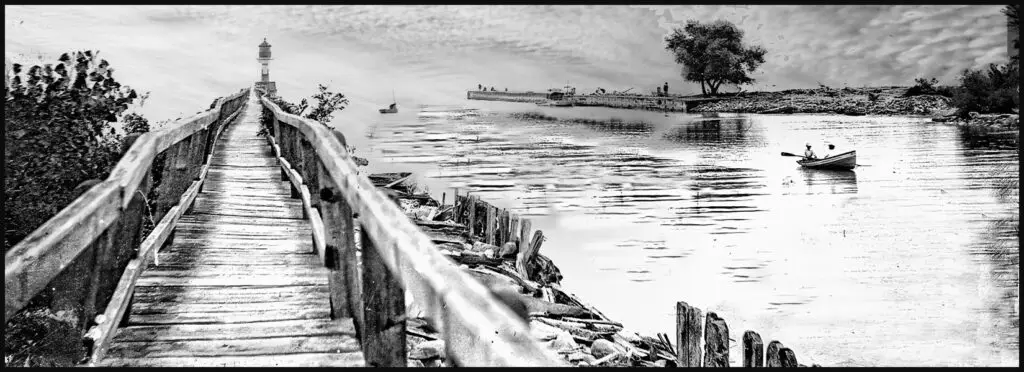
As I said in last week’s column “Lately I’ve been meandering through the cache of photographs available to me”. What I didn’t say is that I’ve actively been collecting photographs pertaining to Vermilion (or places nearby) for over two decades. The unofficial count (unofficial because the count is not finished) is 8,482. At least that’s what my computer is saying. But I don’t want to mislead anyone. Some are duplicates. Yet, if even half are doubles – there are lots.
Not all of them by any means were generated by my grandfather, Pearl Roscoe. He did take a good number of photos. While most are of Vermilion and Vermilion subjects, he also captured scenes in nearby Lorain and Milan – his home town. Some are wonderful; classic compositions that look like paintings. But overall, he was just a “good” photographer like me and millions of others who happen to own a camera. Fortunately, Vermilion currently has several very talented photographers shooting up the town and elsewhere. Vermilionites Scott Dommin and Igmar Svala are among the best.
In the yesteryear Vermilion had several above average photographers in town. Rudy Moc is probably the best known. Although he was from Lorain, he essentially got his professional start on Grand Street in a small building that once sat on the site now occupied by “The Jail” bed and breakfast. He called it the “Sunset Studio”. Initially, all the photographs were in black and white, so extremely good composition and darkroom skills were paramount to his success. Years previous to Moc there had been other professionals in town. A fella whose name was E.S. Miller was among them. I have one photo captured by Miller of the Vermilion Volunteer Firemen c. 1900 – but, unfortunately, none from the others.
Other local photographers of note are Jake Abell (1838-1934), Paul Ludlow (1916-1973), Dick Koontz (1920-1981), Roy Kneisel (1921-2006) and Harry Enlow (1950). Of this group two, Abell and Kneisel, were strictly amateur photogs. Mr. Abell was a barber and Mr. Kneisel worked for the U.S. Postal Service. But all are responsible for some of the best and most memorable 19th and 20th century pictorial recordings of our town and our people. [Incidentally and coincidentally, Mr. Enlow currently lives in the home where Mr. Abell once lived on Washington Street.]
Now about the photo accompanying this essay. In its raw form it is, by itself, historically relevant. Technically, however, it is rather unremarkable. While I am without the talent demonstrated by any and all of the aforementioned photographers, what I can do, with the help of various types of digital software, is improve the mundane. And that is precisely what I have done with this photo.
There’s no big reason to venture into the details describing precisely the “how” of it. You will just have to take me for my word: It is a big improvement over the original. In brief, it’s as if someone wiped the morning dew from a cloudy window. While I did eradicate a rowboat that was irreversibly out-of-focus in the foreground, and I added a skyline that was absent in the original; the main thing accomplished was to accentuate / sharpen details in this still. It is, if nothing else, an agreeable image.
It makes one wish things were still pretty much the same – the catwalk above the breakwater – the light at the entrance to the harbor. It’s not ideal. But tis “idealistic”. I don’t know what the person who captured this moment in time thought about it – or called it; but I call it “Sunday Harbor” – Vermilion, Ohio 1906. Because that, very simply put, is what it is.
© RNT March 24, 2024
![]()
SAM AND ALBERT'S DREAM
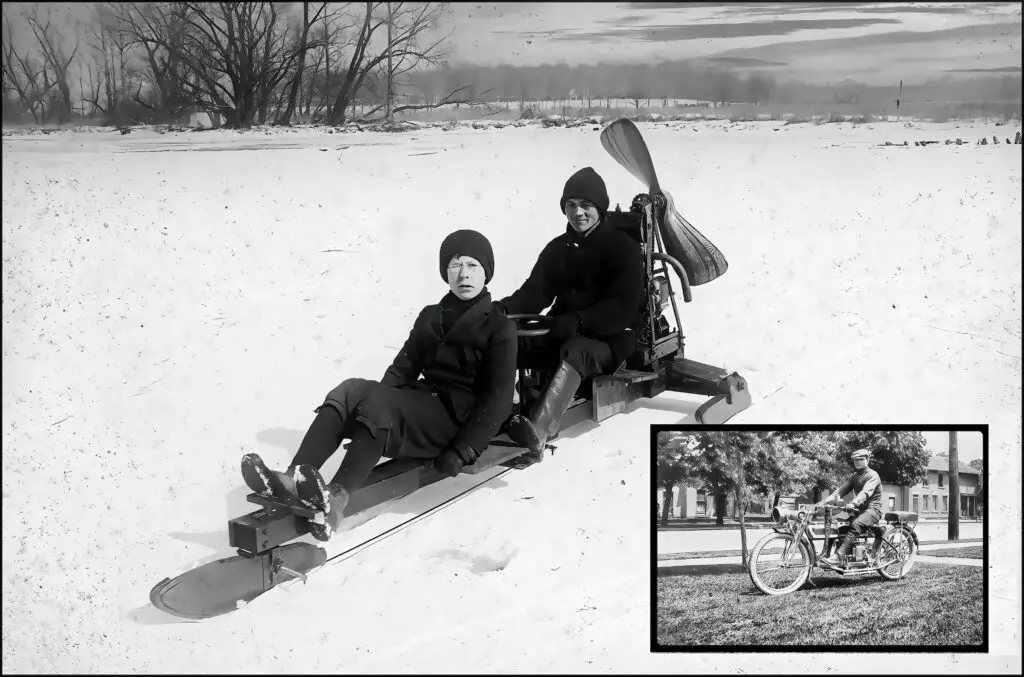
If you were one of the lucky kids, you had at least one friend in your neighborhood like the Lingelbach brothers Sam and Albert. In my day (I never seriously envisioned a time when I’d be using the phrase) – we had Robbie Farrell. Rob was, in the eyes of all the kids in the neighborhood, not only a genius he was ingenious. One time he fashioned a multi-story rocket ship in his backyard out of discarded appliance crates, and all us baby-faced gangsters were, as a consequence, the first to land on the moon (years before Neil Armstrong); and we also visited Mars. Rob also built the first go-cart I’d ever seen in town using an old lawnmower and some orange crates. Every day around Rob was a new adventure. Eventually he earned a doctorate in Engineering and after retiring from private industry worked as Professor of Engineering at Penn State and also wrote several science fiction books. Anyway, Rob was our neighborhood’s “Lingelbach brothers”.
Samuel and Albert were the sons of Henry and Sarah Goetz Lingelbach. Both were born in Vermilion: Sam in 1888, and Albert in 1891. They also had a sister, Clara, who was born in 1893. When the accompanying photograph was taken during the winter of 1916 the family lived somewhere on Ohio Street between Washington and Grand Streets.
The brothers – especially Albert – appear younger than they actually were at the time. But believe it or not, Sam had already had some experience on the Great Lakes, and Albert had worked as a bank cashier. At the time these shadows were captured, however, both had taken employment at Vermilion’s F.W. Wakefield’s Brass Works. Albert was a press operator, and Sam was a polisher and buffer. Those were, of course, their day jobs; the means by which they acquired funds to help finance their other interests. Among those interests were motorcycles, and the gasoline engines that powered them. But what does one do in the winter? Well, the Lingelbach boys had an idea.
An article headlined, “Build Motor Ice Boat” that appeared on the front page of the February 24, 1916 edition of The Vermilion News told everyone what the Lingelbach brothers decided to do that winter: “Albert and Sam Linglebach have put their motor cycle engine to good use.”
“They have put in all their spare time building a motor sled. It is rather novel, being propelled similar to an areoplane, the propeller being operated with the motorcycle engine. The boys tried out their new venture Sunday on the river and lake and quite a number took rides. It has so far proved a decided success and with a few alterations about the runners and other parts will likely cut some capers on the ice hereabouts.”
In truth, their motor sled was not unique in the sense that the brothers invented the concept. For years young people in the area had built, sailed, and raced ice sailboats on the frozen lake. And many persons across the country had designed and built similar motorized sleds. This sled was unique because it was the first one in town, and also because the Lingelbach brothers had engineered, and built it themselves.
Late French poet, journalist, and novelist Anatole France wrote that, “To accomplish great things, we must not only act, but also dream; not only plan, but also believe.” The brothers Lingelbach did all of those things. And though they did not shake the world, it was enough to make some smile – even now.
Ref: Buell Family Photo Archives; U.S. Census Data from Ancestry.com; NewspaperArchive.com.
© RNT February 25, 2023
![]()
EVERYTHING'S UP TO DAY IN VERMILION
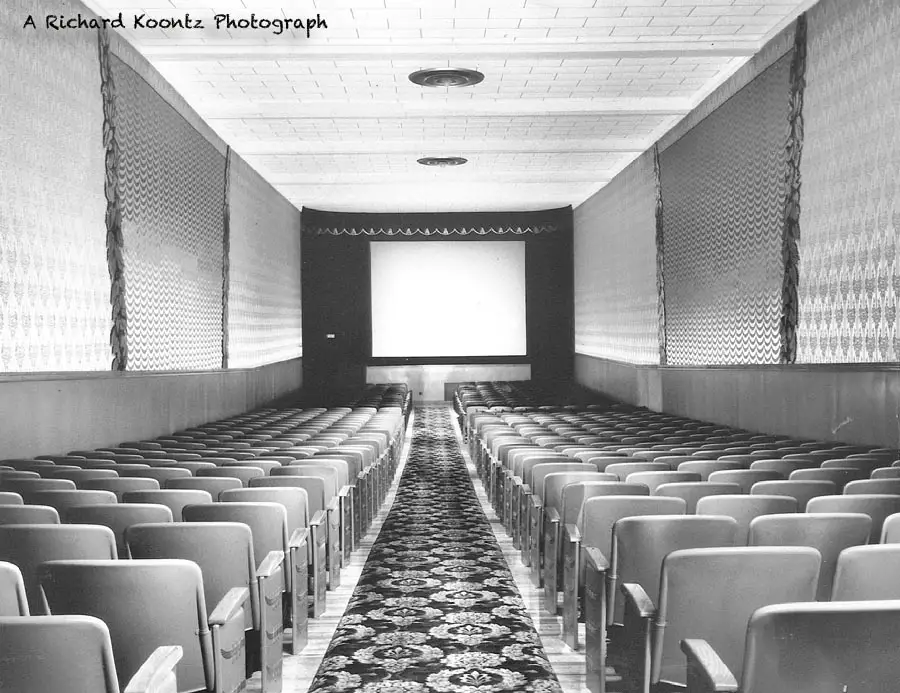
“Everything’s up to date in…(Vermilion, O.)/They’ve gone about as fer as they can go/They got a big theatre they call a burleque/For fifty cents you could see a dandy show!”
With the exception of the price of admission this passage, from a tune in the 1943 Rogers and Hammerstein musical “Oklahoma”, could have very well been describing the 1921 opening of Vermilion’s Liberty Theatre. A report on the front page of The Vermilion News on June 9th of that year called it “one of the most complete and up-to-date movie theatres for its size, in this section of the State, if not in the Nation”.
Now that is an awe-inspiring presentment of fact if there ever was one. If nothing else, it certainly seems to corroborate Mr. Einstein’s theory that E=MC2. Everything is, indeed, relative. But seriously, it really was – as is obvious in the concomitant photographs – a rather remarkable edifice for a town of roughly 2000 souls.
Once upon a time the building, which The News described as being “practically fireproof”, was the home of Henry Delker’s (VPJ 5-25-06) and later Lewis Englebry’s (VPJ 7-13-06) haberdashery. It may be that it was considered to be immune from fire because it had easily survived a large-scale fire that had consumed most of the buildings in the block west of Division / Main, and South of Liberty Street(s) in December of 1903.
The new theatre featured a 30 x 60 foot auditorium with a seating capacity of nearly 300. The 9 x 12 foot projection screen is described in the aforementioned news article as being “a beeded [sic] screen, which enables those in front or at the side to see the pictures just as clearly and distinctly as those elsewhere in the house.” Beneath the screen was a small stage.
The Howard Ratcliffe Company of Toledo, Ohio designed the interior. The walls were decorated with pastel shades of pink, blue, and green fabric set on light tan panels bordered in gold. The carpet was a dark crimson. The woodwork, although quite sparse, was Italian Mahogany. Four large dome lights hung from the ceiling, and dark bronze wall fixtures hung from the walls – all furnished with various colored bulbs. Over the years the decor would, of course, change. But all in all, the accouterments in the theatre always generated a rather magical effect for moviegoers.
A canopy fastened with two large chains hung over the sidewalk entrance to the building. Frosted light bulbs spaced at intervals under its front and two sides illuminated the walk during operational hours. On the right was the ticket booth, a drinking fountain, and the ladies room. On the left was the men’s room. An outside entrance, also on the left, opened to a flight of stairs leading to the projector room equipped with two large state-of-the-art movie projectors.
The movie featured in another photograph is a 1935 film called “Riff Raff” starring Jean Harlow and Spencer Tracy. The above photo o shows the theatre as it looked some years later – as I remember it.
Ah, but the theater was the site of many of my boyhood dreams: Riding the range with Roy and Dale Rodgers; having a good ol’ time with “Our Gang” and the Three Stooges; falling in love with Betty Grable, Doris Day, and, of course, Marilyn. And although those days and times are long gone – they will never ever be forgotten.
© Rich Tarrant – 2024

A CROWN FOR HARRY
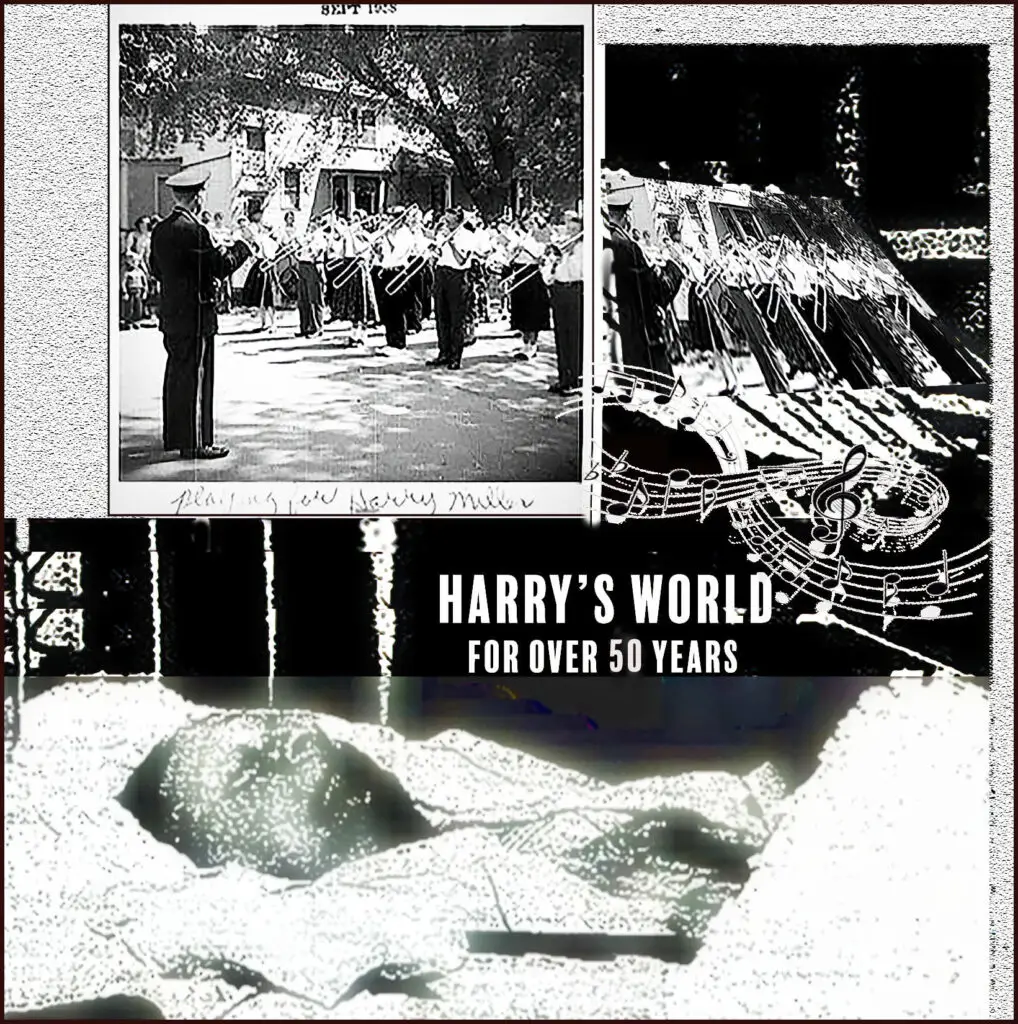
What happened to Harry Miller could have happened to any 12-year-old boy during the summer of 1900. Life is an adventure. Jumping aboard the ice wagon as it made its rounds about Vermilion must have been a natural thing to do for a boy his age. And on a sweltering summer day there was probably nothing better than helping deliver blocks of ice to his friend’s and neighbor’s homes. One great benefit of the task was undoubtedly that of being able to pop a chunk of ice into his mouth and let it slowly melt as the horse team towed the ice wagon slowly about the village. But then, little things happen as they are wont to do, and sometimes those little things become big things.
For Harry it was a simple matter of slipping on a stray bit of ice and falling from the wagon onto a rear wheel. Without missing a beat, he tried to bounce back up into the wagon. But the horse drawing the vehicle lurched forward and caused him to be pitched to the ground head first.
Unconscious, they carried him home. For the next week the pain he experienced from his fall was excruciating. But it gradually subsided. Although partially crippled from the accident he carried on with his life. For a time, he tended to the coal oil street lamps at Linwood Park and did some light farm work during season. Then while working as a shipping clerk for a firm in Cleveland he suffered another injury. This time it was to his right arm. Arthritis set in, then gradually paralysis enveloped his entire body. And by age 21 he found himself completely bedfast.
For the remainder of his life Harry would be unable to move his head or sit upright. His activities were essentially confined to those of reading, hearing, and speaking. A man of lesser mettle might have quickly succumbed to this debilitating condition. But Harry was a person with a deep and abiding faith in God. After his mother, best friend, and caretaker was killed in her 89th year on the Division/Main Street rail crossing in 1949 Harry would say, “I have only trusted in God and kept my faith with him. I know that whatever way he moves is the best way for me.”
That unrelentless attitude and stirring faith made him one of the best known and most loved citizens of the Village of Vermilion. Until his eyesight faded, he spent his days reading the Bible, numerous other books, newspapers, and magazines. Above his bed in the living room of the family home on South Street he kept his reading material in a book rack suspended from the ceiling. Attached to the rack was a very large rear-view mirror from an automobile that afforded him a reflective view of the street in front of his house. Local citizens and folks from all over the country who had heard of his trials, tribulations and strong faith would visit him over the passing years.
During those same years Harry developed a great love for music. Because of this Vermilion’s High School and Junior High School bands frequently stopped and performed in front of his home during parades. During the Christmas season carolers seldom missed stopping at his house to sing. His fondness of music induced Vermilion’s Band Boosters to arrange with Vermilion’s Fisher Funeral Home to take him to hear the U.S. Marine Corps Band when it was visiting the city of Lorain in 1957.
In addition to this he was a big Cleveland Indians baseball fan. Because of this his friends made it possible for him to attend several games. Perhaps (this is only my thought) he had an opportunity to see the American League winning Indians team of 1954 play ball.
Harry also had opportunities to be transported to Beulah Beach (a local year-round Christian camp and conference center) to hear some nationally recognized ministers preach. A classmate of mine, Steve Armstrong, then a young resident of the camp, told me that Harry always insisted that he be able to take along a set of clean clothes when he made those pilgrimages. He reportedly told folks something to the affect that, “If God would allow me to stand and meet him, I’d better have some proper clothing to wear.”
The photograph accompanying this article records Vermilion’s Junior High School Band playing for Harry on Memorial Day in 1958. The Band Director at the time was Vermilionite Bill Burt. Some of the students playing in the front row are Bob Risdon, Steve Armstrong, June Horton (now Katherine Rand), and my good friend Bill Ream. This was the very last time anyone played for Harry. He died the following September shortly after the accompanying photos were taken.
Some years ago, a gentleman by the name of Edward Chapin wrote that “The brightest crowns that are worn in heaven have been tried, and ©smelted, and polished, and glorified through the furnace of tribulation.” If there be any truth to that thought Harry D. Miller must certainly be wearing one most brilliant.
Ref: Lorain Journal; 10-17-49; Elyria Chronicle Telegram, by Vermilionite Dayle Rodgers; 3-15-58; 10-4-58; Ancestry.com; and Special Thanks to Steve Armstrong; VPJ 03/20/2O22; Rev. 01/21/2024.
© RNT January 21, 2024

.
VERMILION KIDS
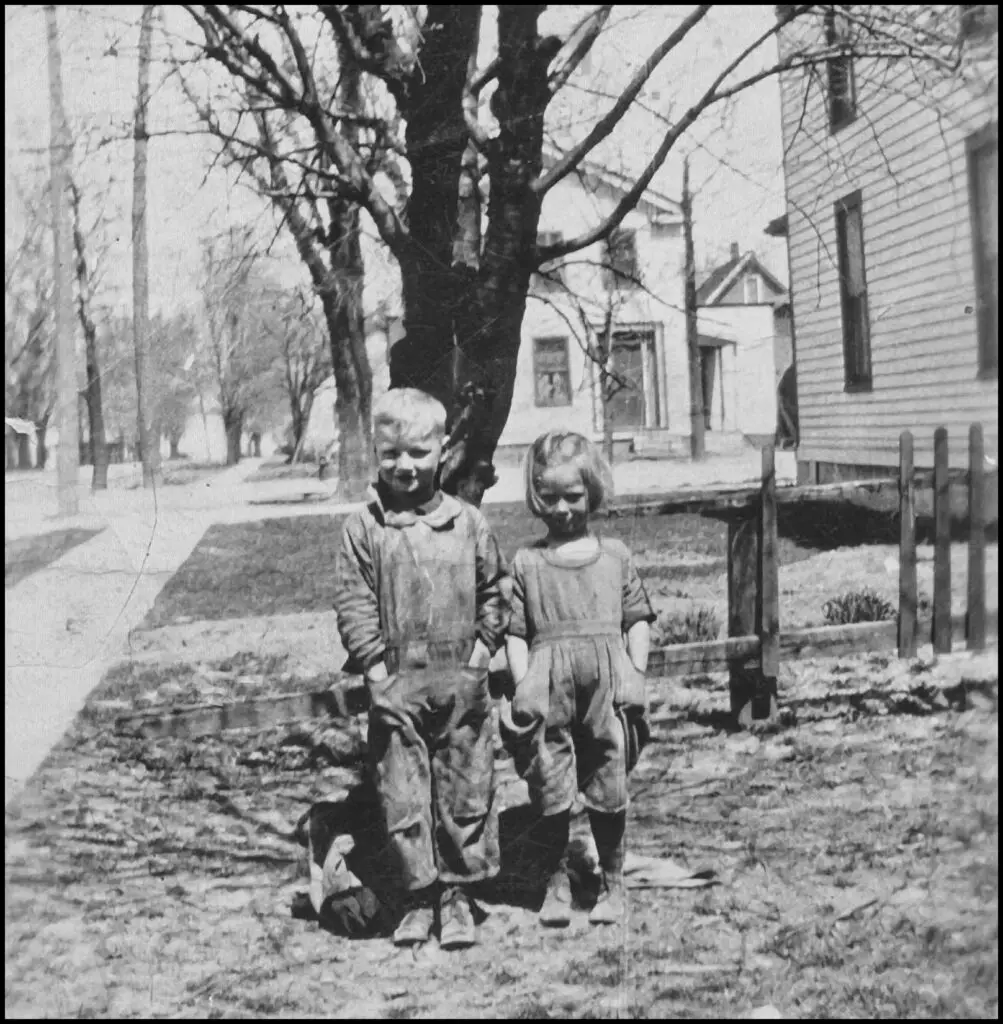
It would be impossible to know what the two rascals in the snapshot subject of this essay were about doing. But you can bet your “kicks” that whatever it was it was fun. By all appearances (i.e. the leafless trees, the absence of leaves on the ground, and the way the youngsters are dressed – as well as their ages) it was perhaps a nice spring day – probably around 1924. Happily standing still (if just momentarily) for their portrait to be captured on the front lawn of their Washington Street home are Bernice and her big brother Fred Fischer Jr.
FAMILY: Their father, also named Fred, was born in Russia the son of Russian parents. The family migrated to America, and to Vermilion at the turn of the 20th century. All Fred’s siblings – 4 brothers and three sisters were very well-known Vermilionites. Fred Sr. who was employed by the B&O Railroad, met a girl named Hattie Johnson while working in the Chicago area. And the rest, as some say, is history. Young Fred and Bernice (pictured) were their oldest children. The couple also had two other children: a boy they named John, and a girl named Mary Jane “Bitsy”.
Fred Sr. was an extremely amiable fellow with a keen interest in seeing that the community of Vermilion, O. would grow and prosper. He served on the village council for many years, and later served several terms as Mayor. His wife, Hattie, was no less amiable. She loved children – both her own and others. For years she played Santa at many Christmas celebrations for Vermilion youngsters. She is also said to have been a wonderful cook and baker. That aspect of her character, no doubt, fit very well with her love for kids. Sadly, in November of 1968 she was struck by a car while crossing the street at the corner of Liberty and Main streets and died of her injuries. Four years later the eldest son, Fred Jr., followed. He was only 55. Bernice married a strapping fellow name Allan Koachway and they had four children: Leroy, Karl, Ellen (O’Hara), and Carolyn (Hill). Bernice died in 1996 and Allan passed in 2001.
“Johnny & Bitsey”: John Fischer later became chief of Vermilion’s Fire Department. He was also known to be a Vermilion historian and as a consequence, was frequently consulted in such matters. He passed away in 2003. His sister, Mary Jane “Bitsey” Laucaitis, passed away in March of last year (2023) at the tender age of 96.
HOUSES: The family home on Washington Street still exists. It is the very first house just south of Liberty Avenue on the east side of the street. The house (a duplex) facing Liberty seen on the right side of the photo just to the north of the Fischer home was razed several years ago. The house, in the background once occupied part of the site where the Ritter Library is today. In the latter part of the 1950s late Vermilionite Melba Knott-Gorbach-Walker purchased the house and had it moved to a new site on the lakeshore behind the place now known (2024) as the Gilchrist House on Huron Street. It, like the former GLHS Maritime Museum that was nearby, has since been eliminated from Vermilion’s landscape. Ironically – or I would not mention it – Melba Walker’s mother, Elsie, was Fred Sr.’s sister.
Well, it’s certainly hard to look at this snapshot of a yesteryear without feeling just a twinge of envy. There – were two children probably having the time of their lives; their futures ahead of them; bright and beautiful. That we know what became of them – good or bad – is irrelevant. In that particular moment they were happy innocents, and all was well with the world. Of course, they were; they were Vermilion kids.
Ref: Special Thanks to: Carolyn Hill and Ellen O’Hara; The Sandusky Register, 1/21/96; U.S. Census statistical data; VPJ 03/25/12; Rev. 01/07/2024.
© RNTJanuary 7, 2024

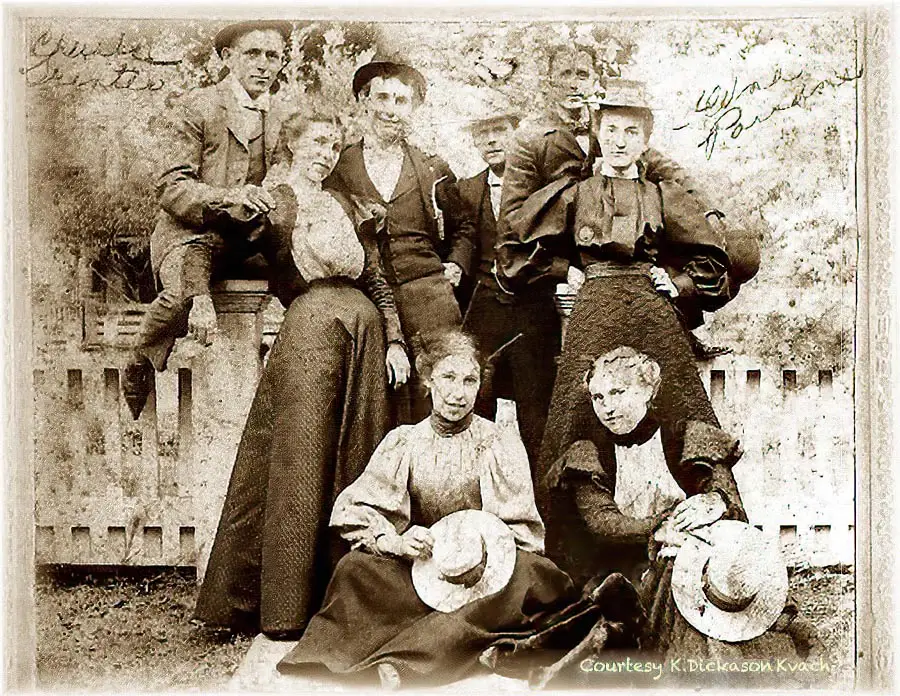
Sunday, June 30,1929. Vermilion residents Dennis Collins and Charles A. Trinter flew to Chicago to attend the funeral services of Mrs. W.P. Carey. Mrs. Carey is the daughter of the late Captain and Mrs. William Young of Decatur Street. Collins and Trinter return to Vermilion the next day. The item recording their journey appears on the front page of The Vermilion News on Thursday of the same week. It is worthy of note because passenger air travel was, then, in its infancy. It would not become a common mode of transportation until another decade had passed.] I did not find the placement of the aforementioned article on the front page of the News to be unusual. In addition to this I did not find the mention of C.A. Trinter as a party in this venture to be unusual either. For in my meandering through the days which comprise the early part of 20th century Vermilion I often come across mention of this gentleman.
Charles Adam Trinter was, to the best of my knowledge, born in Vermilion in 1874. He was the second child of Adam and Wilhelmina Trinter. He had an older sister, Sophia M., and two younger brothers, Frederick and Joseph A. Both parents were born in Hesse Cassel, a country annexed by Germany after the Austro-Prussian War of 1866. After coming to America and settling in Vermilion, Charles’s father was, as he identified himself in the U.S. Census of 1880, a “Saloon Keeper”.
This first-generation son of immigrant parents wasted no time establishing himself as an entrepreneur and civic minded citizen of Vermilion. And by the time he was in his early 20’s he had become a well-known and trusted insurance and real estate agent in the community. His office was on Liberty where currently (2021) an antique store is housed. In 1900, at the age of 26, the Vermilion Village Board of Education selected him to serve as clerk of that board. He would diligently serve the community in that capacity for the next 44 years.
While serving as clerk on the education board he helped it steer through a storm of controversy in 1915 which rated around the School Superintendent and several of the teachers and culminating in the resignation of all parties involved. Nine years later he guided the board through the process of buying the old Pelton Farm just south of South Street and building a new school on the property which became South Street School.
In 1914 he and fellow businessman Lewis Englebry had their photograph taken on the beach at Linwood Park where Lakewood, Ohio aviator, Terry Janus, had landed his Curtiss areoplane one summer afternoon. Both men would fly with Jannus to Cedar Point and back – but on separate flights. For Englebry was a hefty guy weighing nearly 300 pounds. So, it was probably a veritable miracle that he flew at all.
In addition to those things Mr. Trinter also served 23 years as Postmaster of the Vermilion, Ohio office. He spent four and one-half years, 1908-12, as a rural postal carrier. Under the Woodrow Wilson (Presidential) Administration he served as Postmaster for nine years, and again from 1933 until 1943, when he retired. During that era those positions were all held by political. appointees.
Charlie was married to Edna Maude, nee Parsons, (another well-known Vermilion name) and they lived in a large (then stucco) house with a red tile roof on Perry Street They had two children. Their son, Robert, who worked on the Great Lakes, and their daughter, Martha, who married Dr. Russel “John” Dickason (VPJ 10-16-03). Their daughter, Martha, was named after Edna’s mother.
Some of the most “telling information I have about Charlie Trinter was given me by his grandson (also) John Dickason, who now lives in Maine. His “Gramps” always made a point of walking over to the Dickason house (where Dr. Adams now lives) to take him to the Liberty Theater every Friday night. The owner (Bob Nuhn) usually let him in free because he “was “always wanting to buy Gramp’s car.” He always had a new Chrysler. And according to late Vermilionite Hank Fischer he once had a Chrysler Airflow; “an automobile so far ahead of its time, style-wise, that only a few hundred were made.”
And then on a warm summer night, June 11, 1947, Charles Adam Trinter moved on to another adventure in another place. Behind him lay a forest of gladiolus he always cared for in his backyard on Perry Street; his flower and vegetable garden on a property he had purchased near the Dickason home along the lake; the springtime “beach cleaning parties” with grandson John and John’s buddy Doug Francis;’ the thousands of properties bought and sold through his real estate dealings; and, of course, his obvious joie de vivre.
His youngest granddaughter Kathy Kvach who now lives in Virginia once told me, “One of my first sentences was to tell Gramp T. that I loved him.” This was shortly before he died. I’ll bet he liked that. I’ll bet he liked it a lot. [FYI: Since I wrote this piece I acquired a color video of Charlie with Earl “Furgie” Furgason strolling through the gladiolas in Charlie’s backyard back in the 1940s.]
Ref: The Vermilion News: 1-37,3-11- 43; 6-20-44, 7-7-44, 1-48; The Elyria Chronicle: 2-26-15; Ancestry.com; U.S. Census 1880; Special Thanks To: John Dickason, Kathy (Dickason) Kvach, and Al Tarrant; Published in the VPJ 2-12-004; Rev. 12.26.2021.
© RNT – December 26, 2024

THE SEEDS OF YESTERYEAR
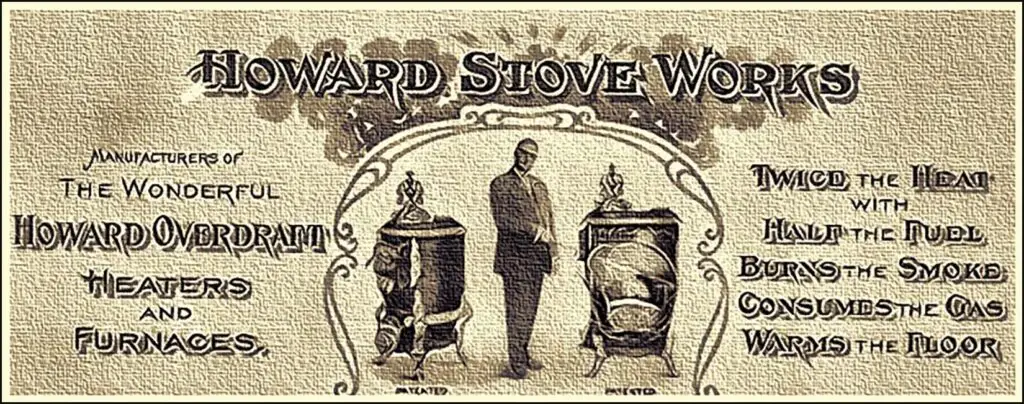
From The Vermilion News – December 18, 1902 – “The Vermilion Chamber of Commerce met Friday evening. A constitution was adopted, and other business transacted. A plat of 40 acres has been secured which will be offered; 10 acres for a site and the balance to be divided into lots and sold to any industry which will locate.” All the acreage lay between the L.C. & M. S. [Conrail) and the Nickel plate railroads, at a point where the electric crossed the wagon [West Lake] road at the west end of the village. [NOTE: The area in question refers to the land between Adams and Jackson Streets on the west side of Vermilion.]
Though no “official” announcement had been made it was reported that a man named W.G. Jackson, president of a pottery company, had visited and inspected the 10-acre site. Thirty acres had been divided into 140 lots, and the lots quickly offered for sale at $200 a piece promising that if they were sold within a reasonable period, it would mean that “the pottery is a sure thing”. Unfortunately, the only “sure thing” in life is death. Taxes being, of course, negotiable.
So – no matter that The News later reported “The pottery concern has agreed to make a contract with the Chamber of Commerce to erect and equip buildings to cost not less than $85,000 and be a permanent thing.” And no matter that most of the aforementioned lots were sold in short order, and the Chamber, the Editor of The News, and the people of Vermilion anxiously anticipated the signing of the contract to seal the deal. By the end of January 1903, the Chamber was forced to abandon the “Pottery Project” because in the end “no satisfactory terms could be made with the company”.
In the meantime, The News ran an editorial suggesting that one of the obstacles with which the Chamber of Commerce had to contend with in their attempt to bring more industry to the town was, of all things, water. The editor referred to it as a “rather queer situation. We have water to drink and wash in, but when it comes to a larger supply, we are compelled to acknowledge that there is none.” And he further observes that, “in case of fire in the business portion of town the hydrant in the [Exchange] park may be brought into use, but the stranger asks, “Why is this the only attempt made to utilize this exhaustless supply?’” It was a timely editorial and an extremely valid question. If Vermilion was going to move forward into the new century and attract industry a good supply of water would be necessary.
As fate would have it almost as soon as everyone had abandoned all hope for the pottery a Mr. Howard from the Novelty Stove Works of Savannah, Mo. came forward with a proposition – sans rash promises – for locating a stove plant on eight acres of the land. The company agreed to give bond for $11 thousand and start work on their buildings as soon as a contract was signed. The buildings would cost no less than $10 thousand and would be completed by July 1st of 1903. The plant would employ at least 50 men and have a payroll of $400. Most – but not all – of the townsfolk were jubilant. Early in March a deal between the Howard Stove & Mfg. Co. was consummated. Soon after ground was broken for the new factory, and the Howard Company’s latest stoves were being displayed at the town hall.
Election results in the April 2, 1903, edition of The News showed that H. R. Williams (D) won the mayor’s office by 84 votes, and John Delker (R) was retained as town Marshall by 14 votes. But more importantly, the mandate for the issuance of bonds for a new Water Works – total completion costs for the plant being a whopping $35 thousand – passed. 186 votes for it – 85 against. And Vermilion was on its way into the new century.
The years ahead looked to be good ones for the town. Down on Liberty Street the first permanent electric lights were turned on at the Lake Shore Electric Power Station. The presses and other machinery at The Vermilion News in the Wells building were removed from the second floor to the north room of the first floor without missing an issue. The first annual meeting of the stockholders of The Vermilion Telephone Company was held and well attended. And Vermilion boasted of having a library. Though very small – folks could become a library member for $1 per year and acquire books at Penning’s News Stand. All these things and more were but mere seeds in our community in the yesteryear. The soil in which they were planted was fertile. Though some of those seeds would never sprout, hopes for the new year ran high, and Christmas was still merry in Vermilion. Very merry indeed.
Ref: The Vermilion News; issues 12/18/1902 through 4/02/1903; VPJ 4/21/11; Rev. 12/17/2023.
© Rich Tarrant 2023

IT HAPPENS (AND NOTE: I SHOULD TALK)
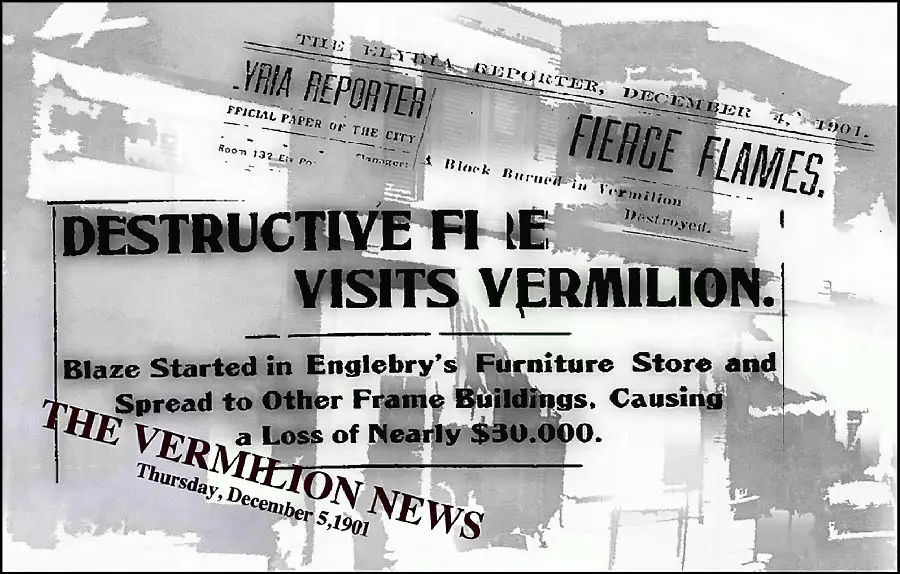
Like most people I hate making mistakes – especially those that get inked. Some may be trivial and / or go unnoticed. That, of course, doesn’t make them any less cringeworthy. But that’s not the real problem. The difficulty is – as the current political environment unfortunately suggests – if an error is not corrected, and is repeatedly replicated, it is likely to be viewed as fact. In the case of politics the “errors” (and I use that word loosely) are often purposeful. In the case of the writer / historian, however, the mistakes are just that; mistakes. There is nothing “purposeful” about them.
A case in point concerns a great fire that reportedly destroyed a large section of Vermilion’s business district on December 3, 1903. It was, incidentally, not the first. The downtown of the village also burned in 1875 and 1891.
In a brief biography of Albert David Baumhart (1873-1961) written, purportedly, at the request of a committee on the occasion of an historical celebration in Vermilion, Ohio sometime around the year 1958 he wrote, “On Dec 3, 1903 our store burned catching fire from other buildings in a frame row.”
In a related article about Mr. Baumhart and his store published in a special “125th Anniversary Historical Vermilion” edition of The Vermilion News in 1962, the following item appeared: “The store ‘grew and waxed strong’ among the business institutions of the community until about 11 o’clock the night of December 3, 1903 when the store together with the Nielsen Jewelry Store, the Englebry furniture and undertaking parlors, Bailey’s Hardware, the Curtis Barber Shop, in fact, the whole west side of the street from the N.Y.C. to the Englebry brick block, was completely destroyed by fire.”
And then in Vermilion historian Betty Trinter’s book, “The Way It Was” Book II (1966) she writes of 1903, in part: “Another disaster came in December when the west side of Division Street went up in flames.”
Taken together these reports most certainly provide a good argument for the fire having occurred on December 3, 1903. At least that’s what I always thought. Moreover, in later Yesteryear columns (VPJ – 02/19/09 and 01/05/12) that make mention of the fire, as well as my “Yesteryear” book (2005), I used these references to date the conflagration. And guess what? All of them are wrong.
In search of more information about this fire I went to the 1903 microfilm files of The News (where I happened to be working anyway). I was unable to find mention of any big fire in the downtown area of the village. Completely baffled I began to search through other newspaper files on the Internet. This search uncovered the fact that the fire that destroyed most of the buildings on the west side of Division (now Main) Street at a cost of nearly $30,000 (which would compute to near $800,000 today) actually occurred at about 9 or 10 pm on Tuesday, December 3, 1901. The information I was looking for in The News did appear in the December 5, 1901 edition of that newspaper.
To be sure, this is a rather minor detail. And one can be equally certain that very few people (other than, perhaps, me) actually care about it. Precisely how all three of the previously listed sources got it, however precisely, wrong may forever remain another mystery of local history. Nonetheless, it is an error worthy of correction. And after all is said and done, it may have just been a simple “typo” in a yesteryear. It happens.
Ref: The Vermilion News, 12/05/1901; The Elyria Reporter, 12/04 and 05/1901; and The Sandusky Evening Star 12/04/19; Published in the Vermilion Photojournal 09/27/12;

VERMILION'S HOME DEFENSE CORPS
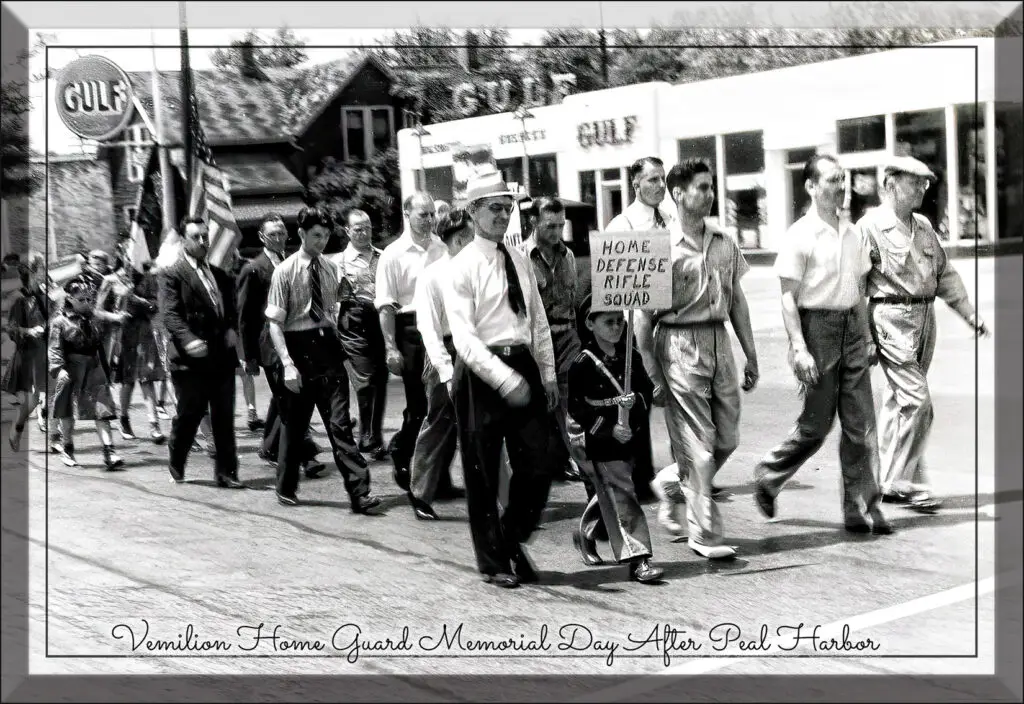
It may sound a bit far-fetched to many folks today. But following Japan’s surprise attack on Pearl Harbor, Hawaii on December 7, 1941, people became astutely aware of the fact that such an attack had a very real potential of happening anywhere in our nation. This included our little Vermilion right here in the heartland of America.
A little over a year earlier President Roosevelt had signed the Selective Training and Service Act into law (another name for the draft) that required all men between the ages of 21 and 45 to register for the draft. Immediately following the attack, the U.S. Congress amended that act to require all able-bodied men ages 18 to 64 to register with their local draft board for military service for the duration of World War II plus six months after. In practice, however, only men 18 to 45 were ever drafted.
During the course of the war, more than 10 million men were inducted into the Army, Navy, and Marines via the draft. However, most men who served, as well as a lot of women, volunteered for the military. Many men who were too old, disabled, or had special skills needed for the effort often served on the home front, doing vital work on farms and in factories.
While the war itself was being fought on foreign soils in Europe, Africa and the Far East It escaped no one that the “homeland” was – to be blunt – “a sitting duck” vulnerable to an attack every bit as crafty as the one which took all by surprise at Hawaii. As a result, many towns, such as Vermilion, wasted no time in organizing a “Home Guard” that would help defend and guard our homes, coast, and factories from any potential invasion.
Vermilion’s amateur, but prolific photographer, Roy Kneisel captured the accompanying shadows at the corner of Liberty and Grand Streets here in Vermilion on Memorial Day in 1942. Mr. Kneisel was kind enough, not only to make this photographic record, but to also provide the names of most of those pictured. First Row: George Stumpp, Larry Stumpp, John Trinter, Orson Kuhnle, and Fred Becker. Second Row: Amos Feiszli, Arland Haber, and Fred Friday. Third Row: Carroll Andress. Fourth Row: John Beursken, Andy Mayer, and Jim Friday. Early the following December Mr. Kneisel left his work at the local Post Office and enlisted in the U.S. Army in Toledo. He was 20 years old.
Fortunately, the mettle of Vermilion’s Home Defense Squad was never put to the test. No one ever won a medal or was praised for their service. The guys just continued on with their lives and work in our town without fanfare. And by 1945 it was all forgotten. And it might have remained forgotten if Roy Kneisel had not been insightful enough to have made this record.
So, as we recognize, quite deservedly, the men and women who actively served (and continue to serve) in the armed forces of our nation over the years we would do well to also recognize the fact that not everyone who served wore a uniform. These are the guys who helped man the factories, farmed the land and sea, and kept the watch over our hometown from December 7, 1941, until September 2, 1945. Thanks for your service.
© RNT November 5, 2023

The Kids @ District School #4
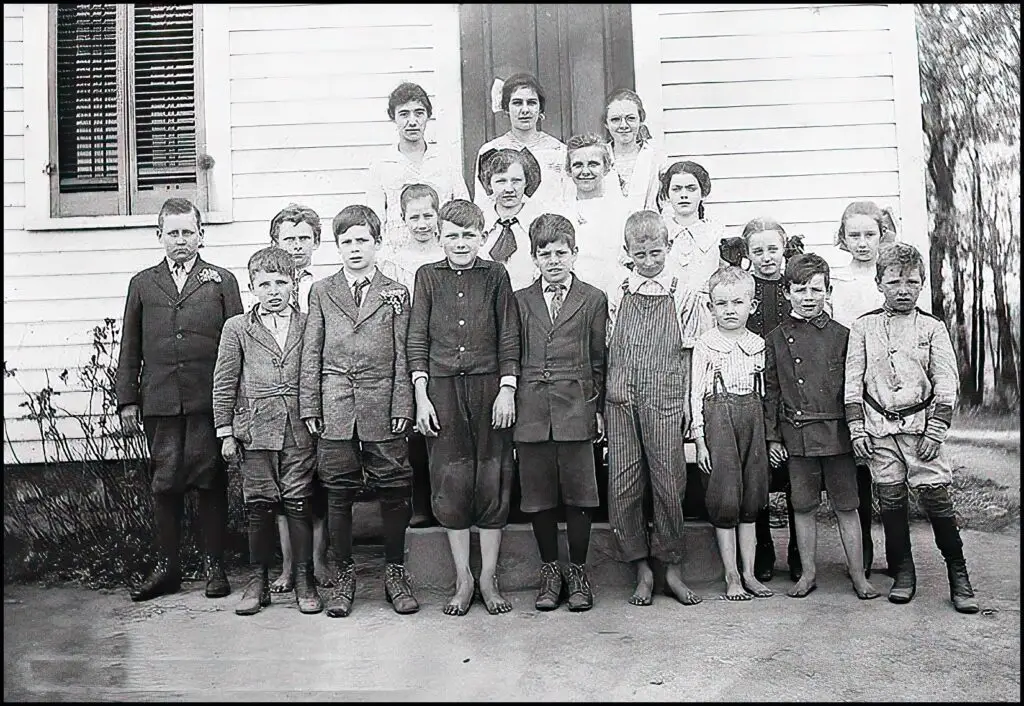
When South Street School opened its doors in the 1927-28 School year the rural schools – the one-room school houses in Vermilion’s hinterlands – were forever closed; and Vermilion’s education system officially entered the 20th century. Initially the new, state of the art, building only had room for the upper six grades. The lower grades occupied the rooms at the old State Street School. But by 1939 an additional wing on the new building made possible for all youngsters in the district to (again) attend one school: albeit a far cry from their pastoral antecedents. And call it what one may – an upgrade, enhancement, improvement, or even a necessity – there were, undoubtedly, a few students who would not have applied any of those terms to the change they experienced. As American writer Ellen Glasgow so aptly observed; “All change is not growth, as all movement is not forward”. Nevertheless, the change did come.
The bucolic setting in the photograph accompanying this essay was District School #4 on the corner of Joppa and Darrow Roads just a few miles to the south and east of the Village of Vermilion. The approximate year of the photo is 1920. It was the same year that the Treaty of Versailles ending the first World War “the war to end all wars” was ratified; Jim Thorpe had been named the president of the American Professional Football League; the 19th Amendment to the United States Constitution was passed granting women the right to vote; and an Ohio boy – Warren Harding – was elected in a landslide to become the 29th U.S. President. At the time Ohio was also very near the geographic center of the United States – population-wise. Ergo, this photograph is, very literally, a vintage portrait of middle American school children of that era.
And thanks to the thoughtful individual who owned this copy of the photo most of the persons in it have been positively identified. Photographed by J.R. Leiter, 37 W. College St., Oberlin, O. they are:
1st Row L-R: Ivan Myers, Earl / Ernie Fichtel, Louie Kovacs, Fred Fichtel, Milton Sanders, Myron Shoop, Henry Fichtel, and Wesley Myers.
2nd Row L-R: James Sanders, Frank Wlodarsky, Ora Crum, Edith Crum, Stella Wlodarsky, Ruth Baker, Catherine Sanders, and Claudia Hauff.
3rd Row L-R: Teacher, Miss K.(?), Catherine Fichtel, and Louise Baker.
The detail in the photograph is to be appreciated. These youngsters walked to school and shoes were apparently optional. That the group knew their picture would be taken on this day is very likely. For some of the boys wore neckties for the occasion, and two of them are sporting lilac boutonnieres. Two of the younger boys (Henry Fichtel and Wesley Myers right front) are wearing faux civil war era military uniforms. One (Fichtel’s) even has a calvary insignia on the collar. The young ladies are all dressed quite nicely with ribbons in their hair. (All of the girls are wearing shoes.) The schoolhouse (I have been told) still exists and is currently used as a private residence.
Many of the names of those photographed are well known about the area. The Wlodarsky family was from Poland. The Fichtels were of German origin. Some like Kovacs were Hungarian. Their precise reasons for settling in this particular area are not known. Whether it reminded them of their homelands, or whether they just arbitrarily settled where family / friends from their homelands settled is also an unknown. But the positive impact of their presence in the community is well known by many. Perhaps that impact had something to do with what they were taught in this one-room school on Joppa Road in that yesteryear – before a tide called progress came along and swept them away. But perhaps not.
Ref: U.S. Census 1920; Special Thanks To: Norris Latteman, Ruth Tanner and Rosemary Kovacs; VPJ 4/29/10; Rev. 10/15/2023.
© RNT October 15, 2023

The Unforgettable Presdee Morgan
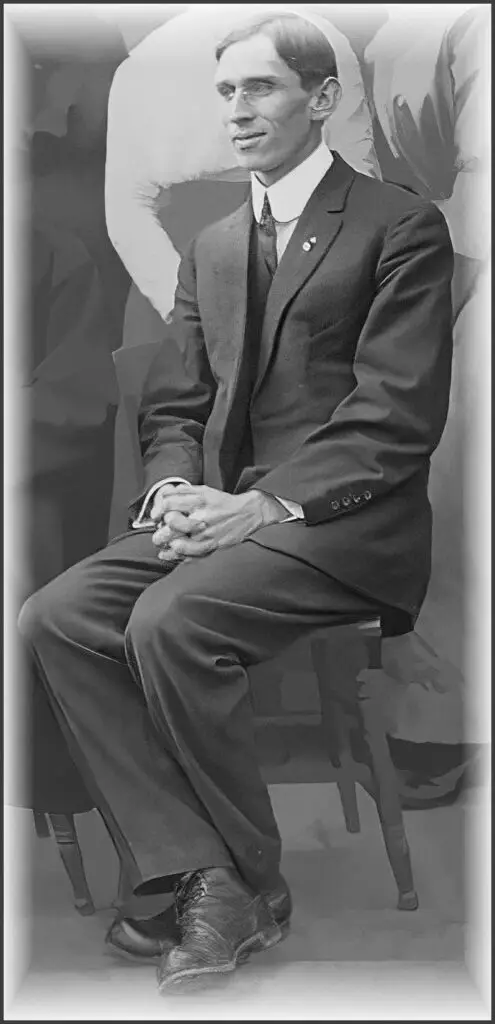
Presdee Burrows Morgan: an unforgettable guy with an equally unforgettable first name. The name Presdee – genealogically speaking – is normally found as a surname / last name. British in origin it has various spelling forms: Presdee, Pressdee, Prestie, Predsidey and, of course, Presdee. The name, however spelled, is essentially locational. Some historians suggest that it is a dialectal variant of the lost medieval village Priestley which, by the bye, eventually morphed into the English surname Presley. Locational names were those given to people after they left their original homes and moved elsewhere. The name “Priestley” is from the old English (pre-7th century) word “preost”, meaning priest and lea / meadow. And this suggests that the aforementioned village from which Presdee Morgan acquired his first name might have been home to a 7th century English monastery. However, in this case it is more likely that somewhere in his family tree the last name Presdee – in some form – was pre-eminent; the roots of the name long forgotten.
So why the historical trivia lesson? Well, if “P.B.” Morgan wasn’t such an unforgettable character all of that wouldn’t really matter. But because he was who he was, it kind’a does. That’s because the roots of his name – either ironically or prophetically – fit both his character and his life precisely.
Like many of Vermilion’s earliest settlers P.B.’s grandparents, Frederick W. and Emma Chapman Morgan, came to Vermilion from Connecticut sometime in the early years of the 19th century. They had two children: a boy they named Frederick Chapman (VPJ 11/20/2003); and a girl they named Lucy. The family settled on a farm along Risdon Road. And, though it should go without saying that the lives of the early farmers / settlers in the area was extremely demanding, the family always found time for their church.
That church, in this particular instance, was Vermilion’s first church; a Presbyterian church that was initially located in a log cabin in the woods near their farm. And though by 1843 the congregation had moved to a new building in what was then the center of the thriving Village of Vermillion the family remained extremely active in it providing music for services with a melodeon that sat on Mrs. Morgan’s lap. With her husband, at her side, pumping air into it; with baby Frederick softly fast asleep on her knee. It was, then, hardly surprising that by the time the boy was twelve he was the one providing music for church services, though on a much larger pipe organ. In due time he also took over the farm, and married a girl named Mary. But ever as faithful as his parents, he continued to play for church services for the next 60 years.
In September of 1887 Presdee was born. Like his father and grandfather, he came of age with a good knowledge of farming. But unlike them he preferred life away from the farm. He did well in school and actively participated in plays both in school and in church. In many respects he was more like his Aunt Lucy who was a public-school teacher and a gifted writer. Later Presdee worked briefly as a teacher. But by the time he was 30 he was an agent for the railroad and was married to a Birmingham gal named Helen Blair. Helen was a clerk for the rail company. [Note: Helen’s sister Grace was married to an Axtel farmer named John Feiszli. Two of their children – Grace Roberts and Amos and their respective families – became, and remain, very well-known and respected Vermilion citizens.] But in February of 1922, after an illness of several months, Helen died at Lakeside hospital in Cleveland with her husband at her side.
Several years passed and Presdee became reacquainted with, and eventually married, an old school friend named Nellie Klaar-Wood. Like Morgan she also had tragically lost her spouse. But unlike him she had three children; a boy named Paul, and two girls; Mary and Dorothy. [Another Note: Mary married a Vermilion boy named Howard Bogart, and Dorothy married another Vermilion fellow named Albert “Jim” Hart.] During all these years Morgan, as did his parents and grandparents before him, faithfully served his church which by then had become Vermilion’s First Congregational. He taught Sunday school; counted the proverbial beans / money; rang the bell calling folks to worship; advised the pastor; and, in essence, became what one might consider to be a bonafide church deacon. In short, he did everything but preach.
Beyond church he was extremely active in the Royal Arch Masons of Ohio. His dedication as a member of this organization eventually led to the application of his name to the local Mason’s Chapter. It is still known as “P.B. Morgan Chapter”. It was, and remains, a significant achievement and honor. So, in essence, Presdee in many respects earned his name after it was given him. Presdee B. Morgan in fact and deed, had become unforgettable.
Ref: U.S. Census data; 1850 thru 1930; Sandusky Star-Journal 2/03/1922; 10/09/1922; Sandusky Register 12/11/1910.
Vermilion resident Rich Tarrant is Curator of the Vermilion History Museum and a son and a grandson of the late proprietors of The Vermilion News (187-1964). Readers may email him at: rnt@twc.com
© RNT September 24, 2023

THE MILL
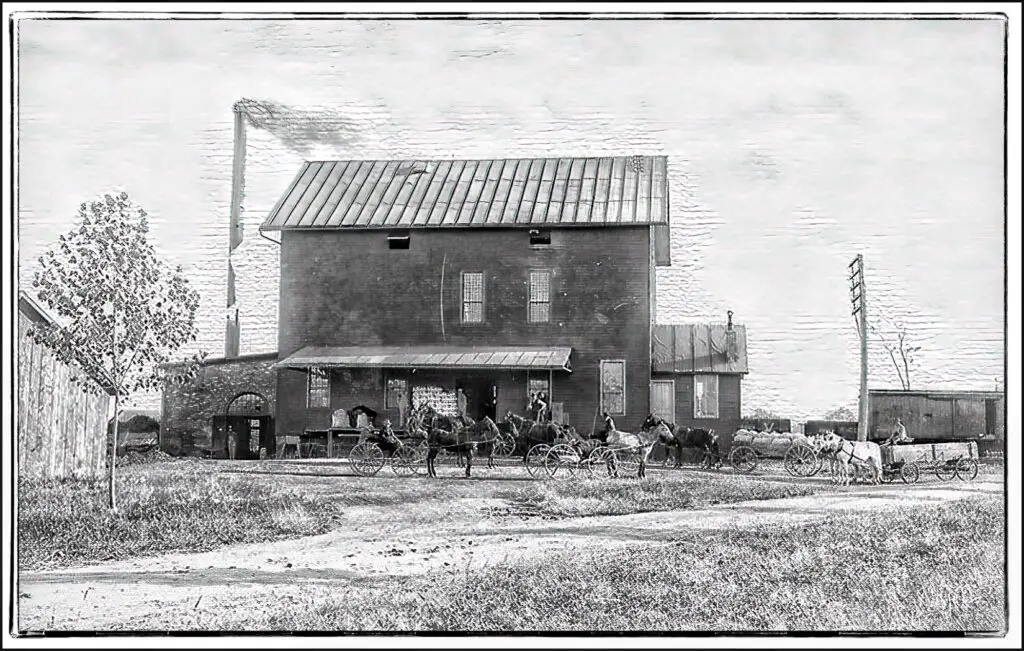
Pictured is the Vermilion Flour and Grain Company (Mill) that once stood at the southern end of Exchange Street in the Village of Vermilion, Ohio. Ironically, both it and the mill in Birmingham were completely destroyed by fire in the early years of the 20th century. The beautiful Birmingham mill was lost in 1906. Vermilion’s Mill, however, survived another decade.
Built in 1898 by D. & A.T. Christman it was one of the town’s foremost industries. This was, in part, because it was one of the only plants of its kind in the immediate vicinity. In 1910 Vermilionite Henry H. Berk (b.1850) purchased the business and immediately went about making needed repairs, building some additions, and installing up to date equipment. This gave them an ability to produce some of the best grain-based products in the region.
The same year Berk bought the mill he hired a gentleman by the name of W.B. Houseman to manage the business. According to an early advertisement that appeared in The Vermilion News during those years they offered consumers, “High Grade Flour, Graham, Buckwheat and Pancake Flour, Bolted Corn Meal, Feed and Grain”, and they “ground on Tuesdays and Fridays (unless otherwise notified)”.
Then, early one morning (3:30 a.m.) on Tuesday the eighth of August 1916, State Street residents, Mabel E. Halloran and John Walper discovered the mill ablaze and alerted local fire-fighters.
All efforts to save the building were futile. No sooner had the firemen thought the fire well under control in one place than it would break out again in another, and then another. This continued through the night. And in the early morning light, when Vermilion News editor Roscoe arrived with his camera, pen, and paper to make record of the tragedy, little more than smoke and ash remained.
When it was all over the damages were estimated to be at least 20 thousand dollars. Aside from the total loss of the building and all the machinery within some 1000 bushels of oats, four to six thousand bushels of wheat, several hundred bushels of corn, and substantial amounts of flour and livestock feed were destroyed. Two train car loads of grain had been saved when a passing Nickle Plate locomotive noted the blaze and transported them away from the flames – one was already burning.
The cause of this spectacular conflagration, which was apparently visible to residents living miles from town was, and remains, a matter of some speculation. Some folks were of the opinion that ancillary lightening from an intense midnight rain storm may have sparked the blaze. Others guessed that spontaneous combustion might have taken place due to the hot and humid weather conditions they had experienced that Monday evening. But most all agreed, and were in fact very certain, that were it not for the drenching rain of the midnight storm the fire might have spread to the homes nearest the mill.
There was some speculation as to whether or not the mill would be rebuilt after the fire. A hundred or so years later we need wonder no longer. It was rebuilt, and it had both a lucrative and illustrious career as a business concern in our town until sometime in the middle of the last century. In fact, if I knew nothing of the fire, I would assert that the mill in this 1901 portrait is the same one I remember visiting on occasion as a boy in the 1950s. In time, like many other institutions of an age, it was abandoned, eventually falling victim to the wrecking ball. Today Vermilion’s very pleasant Mill Manor Care Center occupies the site. But no matter. In my mind’s eye I still envision the old Vermilion Mill of yesteryear each time I pass the site.
Ref: The Vermilion News; 8/10/1916; VPJ; 5/05/05; Rev. 07/30/2023
Vermilion resident Rich Tarrant is Curator of the Vermilion History Museum and a son and a grandson of the late proprietors of The Vermilion News (1897-1964). Readers may email him at: rnt@twc.com
© RNT July 30, 2023

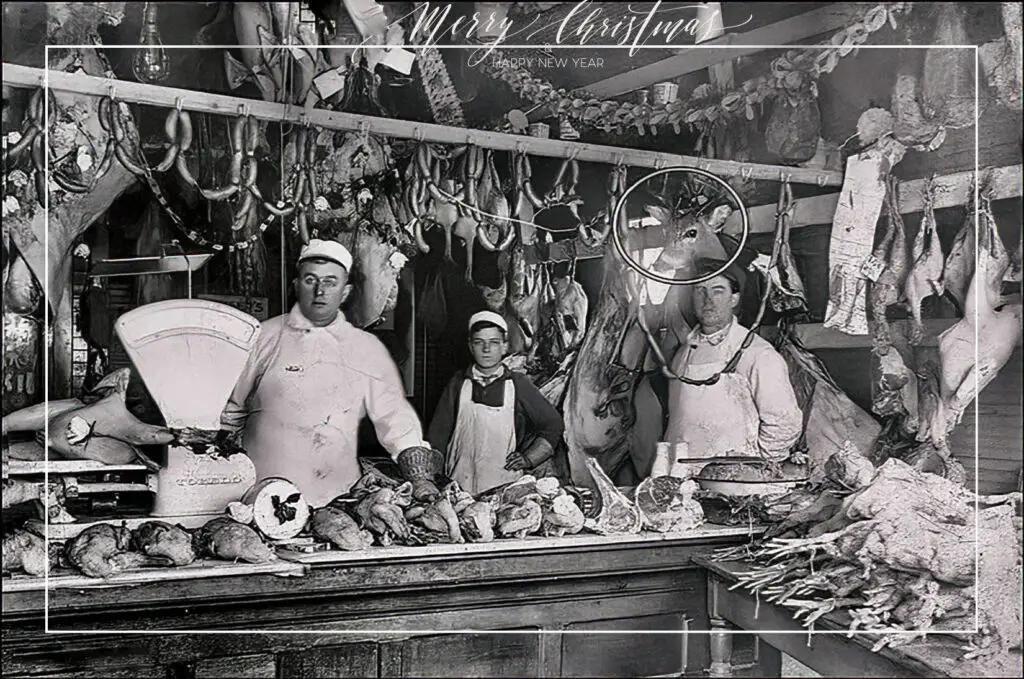
If, perchance, you’ve ever wondered what meat markets might have been like prior to refrigeration wonder no more. As seen in the accompanying photo, chickens, geese, and turkeys (feet and all) were piled on the counters of your friendly neighborhood butcher shop interspersed with an occasional fresh ham and beef rib roast. The birds also hung from the walls and rafters along sides of beef, pork, sausage links and venison. In fact, there are so many carcasses hanging about this shop that the mounted deer’s head trophy on the wall is almost imperceptible.
In the early years of the 20th century a gentleman by the name of George Krapp (pronounced “Krupp”) kept such a shop (i.e. The Krapp Market – Phone 10) in downtown Vermilion. It certainly may be hard for some persons to believe that anyone in their right mind would have purchased meat there. But they did. And no reports of illness or death were ever attributed to the products purchased therein. The poultry and meats sold in the shop probably sold quickly and were used promptly. Like the shop, few households of yesteryear had refrigeration that would sustain perishable foodstuffs for any great length of time. While businesses such as these had electric lights (there is an electric bulb barely visible hanging from the ceiling), that’s about all they had in the way of electrical devices.
Mr. Krapp was born in Vermilion in 1874. The popular meat market operator / livestock buyer, and his wife Dora had eleven children: Dora, Ruth, Dorothy, Irma, Esther, Eleanor, Hilda, and Elizabeth; and sons Herbert and Harvey (not listed in order of age). He also had two sisters: Mrs. Emma Kishman and Eva Krapp. Their 3-year-old son Myron died during Vermilion’s smallpox epidemic in 1903. Around the year 1936 George left the butcher-shop and livestock businesses and began selling real estate. He died in 1954 at the age of 79 years. Dora died the following year.
Persons who have lived in Vermilion for some time will have known several of their children. Son Harvey was also involved in the butchering trade. For a time, he kept a shop in the little building next to the old Vermillion Banking Company (currently the Wine Vault) next to (east) the old Liberty Theatre. Harvey was a wonderful guy – very active in community affairs.
And many long-time residents will certainly remember their daughters Esther (Jackson), Eleanor (Hollosy), Hilda (Blaser), and Elizabeth (Phillips). Though all are now gone the family had a substantial impact in the development of our community. Elizabeth and her husband Clarence gifted the town with the wonderful gazebo in Vermilion’s Victory Park shortly before they died. Esther and her husband Chester left us with a wealth of information about the life of a commercial fishing family in a book called “Lake Erie Fishermen” by Timothy Lloyd and Patrick McMullen (1990). [Note: It was always my intention to talk with Esther about this particular photo and I regret to say that I put it off until it was too late. She passed away in 2012 at the tender age of 98 years.] And those are only a very few of the family’s contributions to our community.
But to return to the photo: The scene does not likely portray “just another day” at the shop. While it is rather difficult to see with the naked eye there are what looks to be some Christmas decorations strung across the ceiling, as well as a sprig of holly on part of the Toledo scale on the counter. The shop appears to be ready to do some rather brisk holiday business. And as unseemly as all of this may appear to contemporary health-conscious people this – as late Vermilion historian Betty Trinter was inclined to view it – was “The Way It Was”. Merry Christmas!
Vermilion resident Rich Tarrant is Curator of the Vermilion History Museum and a son and a grandson of the late proprietors of The Vermilion News (187-1964). Readers may email him at: rnt@twc.com
© RNTDecember 18, 2022
![]()
WHEN THE MAYOR SANG...
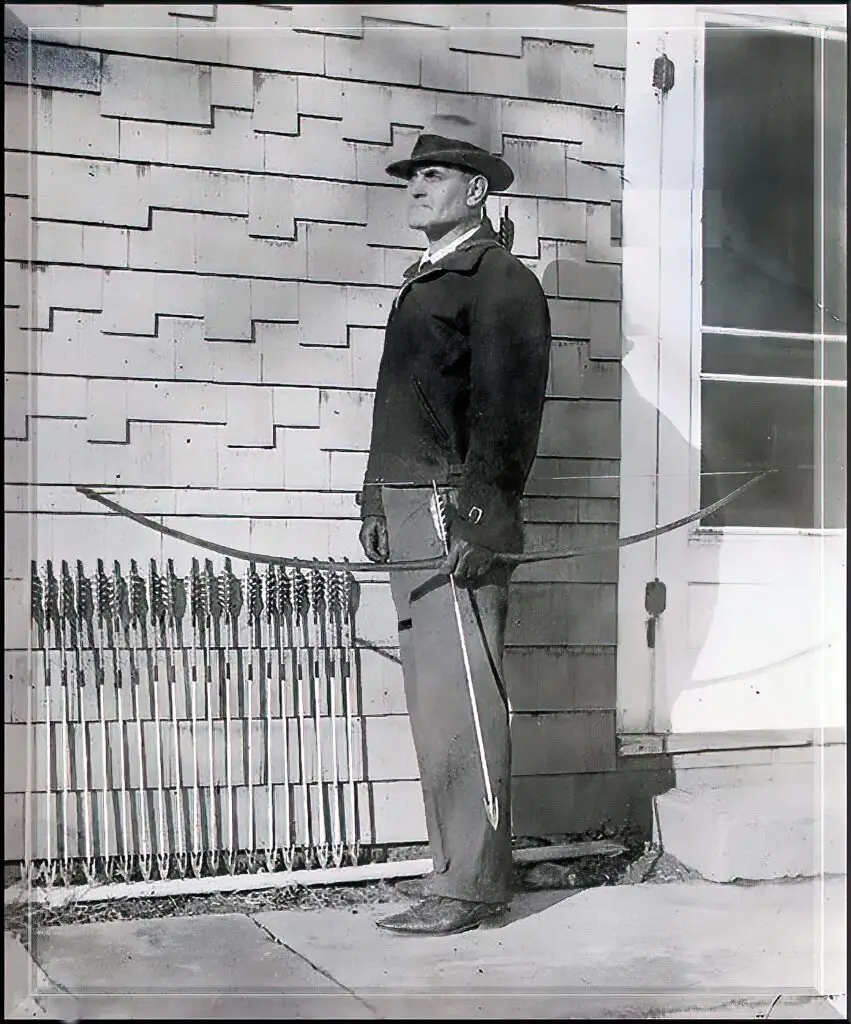
He was Mayor of Vermilion, Ohio from 1940 to 1945. My late sister (Nancy Alice Emery) always referred to him as the town’s “Singing Mayor”. That’s because Leonard Osberg, she said, “had a wonderful singing voice and opened most events in town with a song”.
Mr. Osberg was born in Sandusky Ohio on the 5th day of May in 1893. His father, Karl, was a druggist, sold real estate and in later years worked for a motor company in Erie County Ohio. Both his parents were of German heritage. [NOTE: The family likely originated in Alsace, now a part of northeastern France along the Rhine River, when Germany controlled the region.] Whatever the case both Leonard and his younger brother Carl (with a ”c”) were talented musicians.
After graduating from high school in Sandusky he served in the U.S. Army as Regimental Sergeant Major with the 83rd Division Headquarters in Le Mans, France during World War I. He was responsible for all their personnel files and records. While serving in France he met a lady named Anne Marie Decamp. Her father was Chief of Music for the French Army’s Fourth Corps. Leonard and Ann Marie were married in Detroit in 1921. Their daughter, Vermilion’s late Nadine (Furgason) was born in Le Mans during a return visit.
As one might guess from the accompanying portrait of him near the side door of the Vermilion News building on Grand Street, Leonard was also an archer. He competed in events throughout the United States and wrote some about the sport in The Vermilion News. [We don’t really give it much thought today, but it is an ancient exercise. Before gun powder and sliced bread mankind used bows and arrows to gather food and settle disputes.]
After his military service Osberg had worked in real estate in Ohio and Michigan and then took a position in Industrial Relations at the Plum Brook Ordinance Works in Sandusky (now NASA’s Neil A. Armstrong Test Facility). Eventually he came to work in Vermilion for the F.W. Wakefield Company where he worked as their Personnel Director.
Outside his duties with the Wakefield company, he was of course, a nationally recognized archer / bowman. But he was also a song leader and a past-president of the Vermilion Rotary Club and served three terms as the Mayor of the Village (1940-1946). During his first term of office Vermilion’s landmark water tower (now a part of Rotary Park) was built. Many residents (as mentioned) referred to him as the “Singing Mayor” because of his love for music and singing. During his years in office, he had also been a member of Vermilion’s well-known Rube Quartette. Both brothers also performed with bands that played in dance venues across the lake shore such as Vermilion’s Crystal Gardens at the Crystal Beach Amusement Park and the dance halls at Elberta and Ruggles Beach.
Additionally, Mr. Osberg was not shy about his expressing his political views during the 40s and 50s. He authored a column articulating his views in the NEWS during those years. I also came across at least one letter he wrote on the theme that had been published in the Cleveland Plain Dealer.
I do, although only vaguely, remember him. He and his French-born wife (Anne Marie) lived in the duplex house just north of the old Congregational Church (currently the Millet Auction House) on Division / Main Street. His brother, Karl, married a local girl named Virginia “Ginny” Haine. Ginny once operated a nursery school atop the Fischer building in downtown Vermilion. A younger sister, Elizabeth “Betty”, was married to a Vermilion Osteopath named V.B. White. Another sister, Lenore, was married to a retired insurance broker named George Wolfenden. The couple kept a house on State Street (currently owned by the Harbourtown Community Foursquare Church) where she ran a nursery school.
As may be obvious, Vermilion’s Osberg family was popular, intelligent, and extremely, extremely talented. And this was certainly an asset for Leonard. That’s because in the yesteryear when the Vermilion Mayor sang – everyone (everyone) listened.
Vermilion resident Rich Tarrant is Curator of the Vermilion History Museum and a son and a grandson of the late proprietors of The Vermilion News (187-1964). Readers may email him at: rnt@twc.com
© RNT December 11, 2022

NANCY ALICE
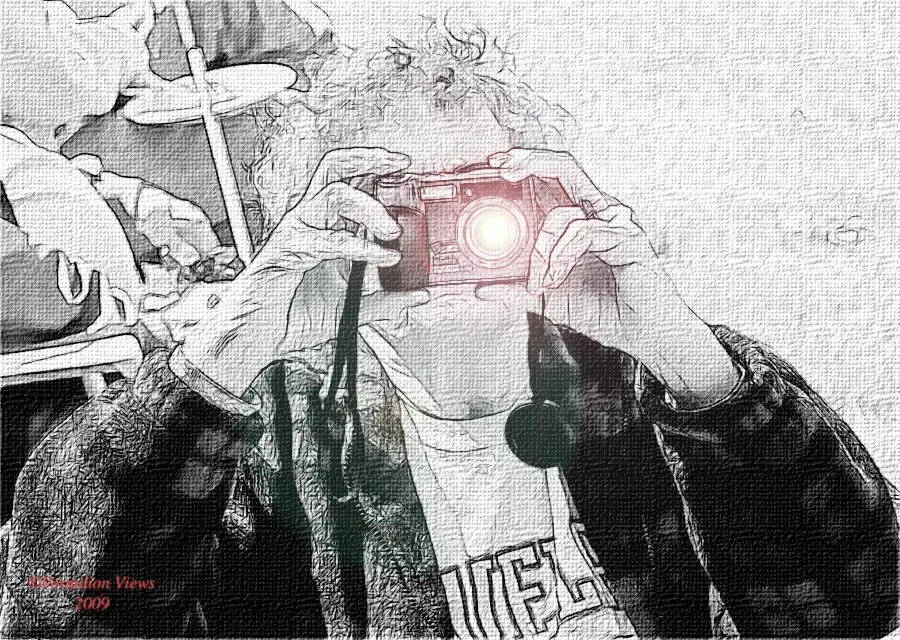
When I was in 6th grade our class was studying the Crusades. My teacher Miss Edith Kropf (1905-1987) required that we each write a report about it. At about this same time the TV program Robin Hood was a popular show – and I always watched. Thus, I was enthused with the project and began writing immediately.
I was so enthused with the assignment that I went home and made an elaborate color drawing of a crusader that I thought would go well with the report I had written. I suppose I spoke so enthusiastically about it that my big sister Nancy Alice volunteered to type it up for me. I was, to say the least, extremely pleased with the results. I was confident that it would be received very positively by my teacher. And I was right. I received an A+ on the report. And that, in a roundabout way, was the beginning of my extreme interest in writing and, of course, history.
As is obvious, I never forgot this milestone in my education. And I never forgot that my sister Nancy played an important part in it. Even though she’d likely forgotten about it a long time ago, I now regret that I never thanked her.
Through the years I have often called upon her knowledge of local history and her remembrances of persons, places, and things from Vermilion’s past to help me write about them. Where I could not recall something or someone she often could. And there were small details, like who was related to whom, or certain habits of persons of yesteryear that I found helpful and afforded some color to stories.
For instance: when she worked at the Okagi Restaurant as a teen Mr. Okagi feigning outrage would gleefully chase her around the lunch counter in the restaurant until she greeted him properly with a cheery, “Good Morning, Sir”. Or the related story about Mrs. Okagi standing by the door between the kitchen and dining room of the restaurant making sure that the bowls of mashed potatoes were hot by gently touching the bowls as they were carried to the diners. [Note: In the Okagi Restaurant many dinners were served family style.]
Or then there is the case of Eleanor “Nell” Neiding who at one time lived next door to The Vermilion News print shop on Grand Street. I was surprised to learn that she was a sister to one Lillie McDaniel. As a consequence, Nell would have been the aunt of a former Vermilion policeman named Ken McDaniel. Ken’s son – also Ken – is the proprietor of Vermilion’s Coley’s Inc. machine manufacturing company. Knowing these “little “relationships between local personalities and businesses has always proven advantageous – both socially and historically. And taking this knowledge just a step further; Both Nell and Lillie were Dewhursts of Huron. Their father, Joe, was a marine engineer. This is / was wonderful “stuff” for a writer of history.
Well now, Nancy is history. She, too, belongs to the ages. She passed into the ether last week on her 91st birthday. I’m not going to posit any weird theory about that. It’s just a fact. You will find her “obit” somewhere in this week’s VPJ. And it’s a good’n. Her children, I must add, did an A+ job writing it. Nancy was a stickler for accuracy in such things. If and when I made mistakes in writing anything she lost no time in correcting me. (I must have been on speed dial.) So lest her children wanted a visit from her ghostly visage to get after them about any errors in her life story it had to be right.
In a framed plaque that for years hung on the wall at the upper stair landing of our family home on Perry Street was a poem titled “A Friend”. It read, “A friend is not a fellow / Who is taken in by sham. / A Friend is one who knows your faults, / And doesn’t give a damn.” But Nancy did. Nonetheless, she was always my friend and perhaps more importantly – my sister. So, thanks.
Vermilion resident Rich Tarrant is Curator of the Vermilion History Museum and a son and a grandson of the late proprietors of The Vermilion News (187-1964). Readers may email him at: rnt@twc.com
© RNT December 4, 2022
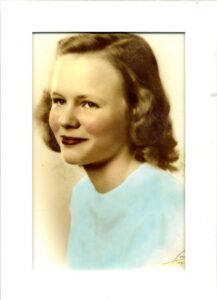
When Trains Were the Way to Go
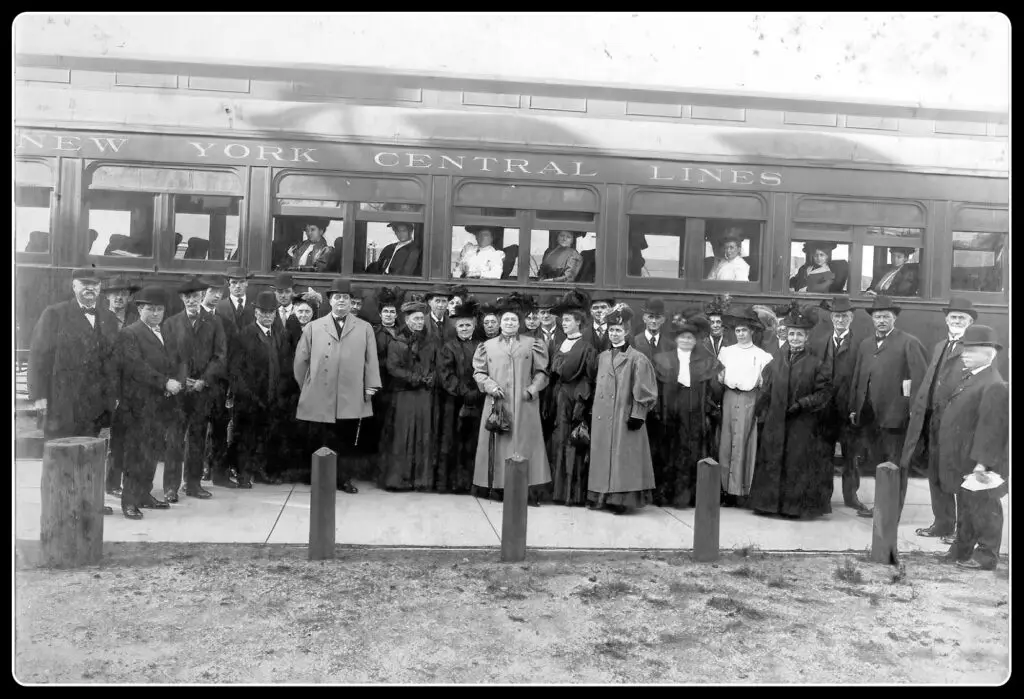
When I was a boy taking the train somewhere was kinda classy. People got dressed up and away they went to places like Cleveland, Toledo, Chicago, or New York. Today flying is the way to go – and nobody gets dressed up (or at least very few). This wonderful photograph (among others) was contributed to the museum by Vermilionite Karyl Wetzler earlier this year. They came to her through her husband’s (Fred’s) family and are very certainly appreciated.
I can’t say much more about this particular photo except what I’ve said already. I don’t know where it was taken, nor do I immediately recognize anyone pictured. But I do like it.
Given the clothing styles I’d guesstimate that the photo is c. 1912. The ladies in their long dresses and overcoats with their hair neatly styled neath their finest bonnets – and the men in suits, neckties, and their bowler hats [The bowler hat, also known as a billycock, bob hat, bombín (Spanish) or derby (United States), is a hard felt hat with a rounded crown, originally created by the London hat-makers Thomas and William Bowler in 1849. It has traditionally been worn with semi-formal and informal attire.] You can purchase a “Bowler” on Amazon for $45.
Something I didn’t know for sure until I saw this photo is the fact that windows by the seats could be opened. I suppose that’d be nice when the train stopped to get a bit of air. But if the train was moving at 40 or 60 mph the draft might’ve been somewhat annoying for other passengers. That, along with the smoke and cinder residue from the locomotive, could make things a tad uncomfortable. Perhaps the conductor made sure the windows were closed when the train was moving.
Prior to the inception of the Lake Shore Electric interurban system persons traveling to and from Vermilion, visitors to Linwood Park retreat, and Shattuck’s Grove (later Crystal Beach Amusement Park) were regularly transported on the steam rails as well as on steamboats. [Imagine that.]
The New York Central operated what it called the “Water Level Route” from Buffalo, New York to Chicago, along the south shore of Lake Erie. It may also interest some to learn that the original train depot / station was located along the rails between Grand and Division (now Main) streets. [The duplex that occupies the area between the tracks and what is currently Millet’s Auction House had yet to be built.] Following and real “pile-up” directly in front of that station it was moved to the site where it still stands along the rails on Columbus Street behind the St. Mary Church.
Aside from the worried journey I took from the Terminal Tower in Cleveland to Fort Knox for a job with the U.S Army in 1965, I’ve not been on a civilian passenger train for quite some time now. The first was on what was – at the time – supposed to be one of the most modern, and comfortable passenger trains in the country that ran from Wellington to Columbus. [I was eleven years old – so what did I know?] In Europe passenger trains are quite common. Perhaps in the future passenger rail transport will return to the U.S. But I don’t expect that to happen. At least not in my lifetime. Politicians who might encourage such an improvement are not yet in office. Persons who really want to accomplish things like that are eleven years old and still in primary school. And those who don’t probably should be.
Well, once upon a merry old-time, rails were certainly the way to travel. It took a bit more time than we’re used to today. But the ride was usually quite comfortable, the passing countryside quite interesting, and the conversations that developed among friends and even perfect strangers quite wonderful in that yesteryear: When trains were the way to go.
Vermilion resident Rich Tarrant is Curator of the Vermilion History Museum and a son and a grandson of the late proprietors of The Vermilion News (187-1964). Readers may email him at: rnt@twc.com
© RNT November 27, 2022

MAUDE
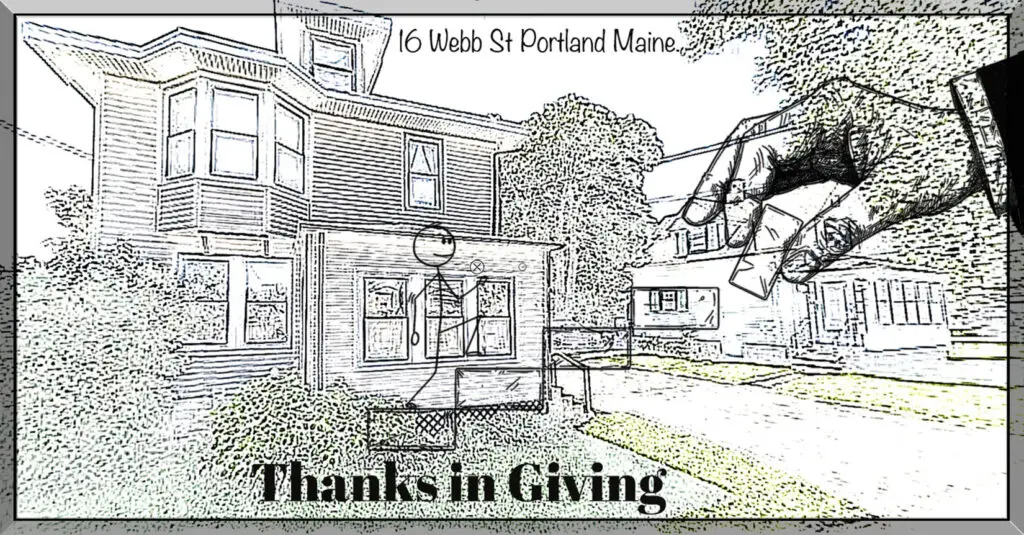
The Tarrant side of my family came from Great Britain in the latter years of the 19th century. They had migrated to Nova Scotia, where my grandfather, Fred, met and married my grandmother, Ellen Maude Eleanor Lynch, and where my father was born in 1898. From there the family migrated to the state of Vermont in the U.S. where grandfather found work in a farm machinery factory. While in Vermont Ellen’s younger sister, Bertha, who had come to the U.S. to live with her sister and brother-in-law, met and married a fellow named Fred Murrell who had also worked in the farm machinery factory. In 1900 a daughter was born to Bertha and Fred. They named their little girl, Maude, after my grandmother. Then, sometime during the first decade of the 20th century both families found their way to Portland, Maine.
This is, I believe readers will agree a brief, but very, very convoluted story about a small portion of my family. I apologize for leading you down such a muddied path. On the other hand, it seems to me that all family histories are similarly torturous – long and twisting. But most of them probably do not have a “Maudie” in them. And please note that I might have said most simply that she was my “cousin once removed”. But where’s the fun in that? And Maudie was a fun person.
Maudie is what one might today term to be “a maiden aunt” type figure. Though she was my cousin she was much older than me (44 years) so I quite naturally referred to her as my Aunt Maude. I never really got to know her until I was nearly thirty. She lived in what was once her family’s home at #16 Webb Street in Portland Maine. She shared the home with her younger brother, Walter, until he married and purchased the house next door.
It’s now been nearly 50 years since I last saw her. She passed away in 1989. But she’s always been (and remains) up front in my thoughts. Maudie was a unique personality who led a unique life outside (but well inside) the limelight. Before she retired to live with a half-dozen adopted felines in her unassuming Webb Street home, she worked as a private nurse for wealthy New England families traveling the world. And while she never ever exposed details of her clients (it would have been in her words “an unseemly thing to do”) she did hint a bit about her private life.
The F. Scott Fitzgerald book “The Great Gatsby” was published in 1925. That was coincidentally the same year when she turned 25. She recalled the days when she and her friends would take off on a spur-of-the-moment jaunt throughout New England or Canada. “We were just doing the Gatsby”, she said. Those familiar (as am I) with Fitzgerald as well as “Gatsby” will need no further elucidation of the activity. However, it was probably very fortunate that her younger brother was an attorney. Ah, but perhaps my imagination supersedes the reality. (But probably not.)
In any case, by the time I knew Maudie she had been long retired and was well into her 70s – her Gatsby days gone. Her life then ran like this: She would wake early and tend to her cats. (She grew grass in a pot by the window just for them.) Then she would walk to a house behind hers and collect a little girl whose mother had to work all day – and bring the child to her home to spend the day. After taking the child back home in the afternoon, she’d return home and prepare a “toddy” for her and her brother who was by then a Judge. They would visit until dinner was served at his home next door. Following dinner was conversation until bedtime. Back home at night as she slept and all grew quiet her cats began to play. Galloping around the house after midnight like a great herd of softly stampeding cattle until dawn.
“I don’t go to church anymore” she told me. “I don’t drive, and it’s too far to walk. So, I take care of the little girl across the alley for her mother who has to work. It’s the Christian thing to do.”
As yesteryears go this one was not, of course, about Vermilion. But it’s honest and it’s true. There is certainly a Thanksgiving lesson here. Maiden aunts are I believe good for such things. And I am thankful for having known mine. Perhaps a day will come when I might share my “Gatsby days” with someone. But until then, like her, I’ll do what I can to help my neighbors in need. After all, it’s the Christian thing to do.
[FOOTNOTE: Maude’s great uncle, Howard Lynch, was the pastor at Vermilion’s First Congregational church 1918-1919. He is the reason the Tarrant Family landed in town.]
Vermilion resident Rich Tarrant is Curator of the Vermilion History Museum and a son and a grandson of the late proprietors of The Vermilion News (187-1964). Readers may email him at: rnt@twc.com

Death of a Saloon Keeper
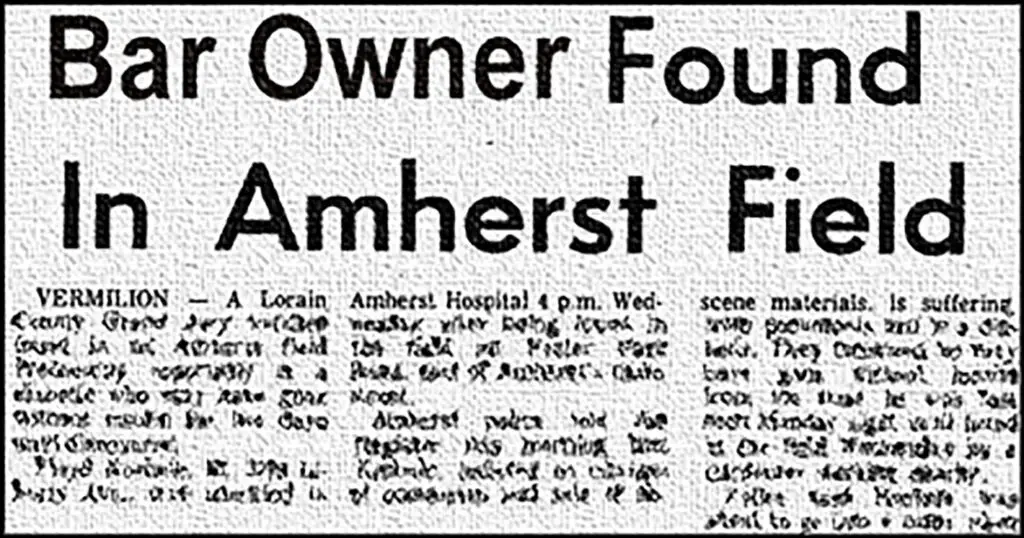
The best word I can think of to describe it is “dive”. Fresh out of the Army in February of 1967 it was the type of place where I felt quite at home: It was dark, dank, smoky and often very loud. It was not the type of place you’d take your mother. And that was just fine with me. I’d just left Vietnam and though it was cold in Ohio when I got back I was still in a sweat. But that’s another story. So let it suffice for me to just say that the place called Gino’s Lounge was a good place to cool down.
How many nights of my life I wasted there is something I don’t recall. But I remember being there in the crowd with friends talking, laughing and watching what seemed to me to always be the same Go-Go girl dancing on the bar in a two-piece bathing suit to a Mitch Ryder song called “Devil in a Blue Dress”. To this day every time I hear that song I think of Gino’s and the blond girl dancing to that song on the bar.
Currently (2017) the place is a very nice restaurant decorated in the fashion of a “Speakeasy” of a the yesteryear; a time when men and women danced the Charleston and enjoyed a few drinks while the “Feds” chased the providers of that booze – bootleggers – up and down the Lake Erie coast. I don’t know much about that, but what I do know is that a “speakeasy” would’ve been a major upgrade from the place I once knew. As I said it was a dive – and there was certainly nothing romantic about the place.
The owner was a guy most folks called Gino. After all that was the name of the place. But his Christian name was actually Floyd. And he was hardly Italian. But that’s okay, because he didn’t look Italian either. He was a diminutive figure – not really small – but slight. He might’ve weighed 140 pounds soaking wet. His hair was dark. But it was actually hard to tell the color exactly because he didn’t have much of it. The one thing I would give him, however, is that there was no question about his being the boss and owner of the place. I don’t have a picture of him, but I can see him now just as clearly as when I first walked into the joint. It certainly fit his persona.
Everyone (including myself) knew he was running some heavy card games in the basement of the bar. And that was, in truth, no big deal because his game would not have been the only one in the area at that time. But that, I later learned, had not been Floyd’s real vice. He had allegedly been peddling pornography in the basement. In retrospect the whole thing was (to my way of thinking) very apropos.
On September 3, 1968 State Liquor Agents raided Floyd’s Lounge and confiscated a plethora of pornographic materials. They also seized a movie projector and screen that were apparently used for private parties. In an article that appeared in the Sandusky Register on September 21, 1968 Floyd told a reporter that, “…the material came from his private collection and was not generally available to customers of his establishment.” He told the reporter that the raid took place without a search warrant, and went on to explain what happened, “A fellow came in and after a while, he said he was going to have a party and would I sell him the stuff. He seemed like a nice enough fellow and I let him have some of my own merchandise. Shortly afterwards, the rear door burst open and two other men came in and said the place was being raided. They told me the money used to make the purchase was marked. I sold the man one strip of film and some cards (playing cards said to have lewd pictures on the backs). The liquor control board men went to my desk and found the other film strips and cards.”
He also stated that merchandise, such as he had sold the agent, could be purchased at many places in a nearby city. “Why, I can show you any number of places along … where the same kind of stuff can be bought.” He said he had a “party room” in the basement of the establishment but it is infrequently used. I have always run a legitimate place,” he emphasized, “Why, I can get a petition signed with hundreds of names stating that I am not that kind of a guy. The newspapers are crucifying me.” Ol’ Gino was in a panic because a temporary order had been requested by Lorain County Prosecutor to padlock the bar. Moreover an October 7 hearing had been set to consider permanently closing the place. In the end he was indicted on two counts of the possession and sale of obscene materials he was slated to go on trial in Lorain County, Ohio on November 26th to answer those charges. But he never made it.
On Wednesday October 23, 1968 a barely conscious Floyd was found by a carpenter working nearby lying in a field off Foster Park Road just east of Amherst’s (Ohio) Main Street. He was reportedly suffering from pneumonia and had apparently gone without insulin for his diabetes for perhaps two days. He was taken to Amherst Hospital. The report said that the carpenter who discovered him hearing his moans told authorities that Floyd had managed to tell him that he had been kidnapped. He was only wearing a light knit shirt and pants. Both his shoes and socks were missing and they were never found.
His bartender had filed a missing persons report with the Vermilion Police the previous day. The report said that Floyd had left the bar on Monday evening with an unidentified blond woman and drove away in her car. Exactly what happened to the guy we called Gino was never determined. The local gendarmes never followed up on the case because whatever happened to him appeared to have happened outside their jurisdiction. The Amherst police were unable to get a statement from him before he died on Friday, October 29th. He was buried the following Monday in Woodlawn Cemetery in Norwalk – his hometown. No trace of the car he left from the bar in or his shoes and socks were ever found. And no one ever saw the blond gal he left the bar with again.
Vermilion resident Rich Tarrant is Curator of the Vermilion History Museum and a son and a grandson of the late proprietors of The Vermilion News (1897-1964). Readers may email him at: rnt@twc.com
© RNT 04/14/16 – Rev. 4/17/17

Add Your Heading Text Here
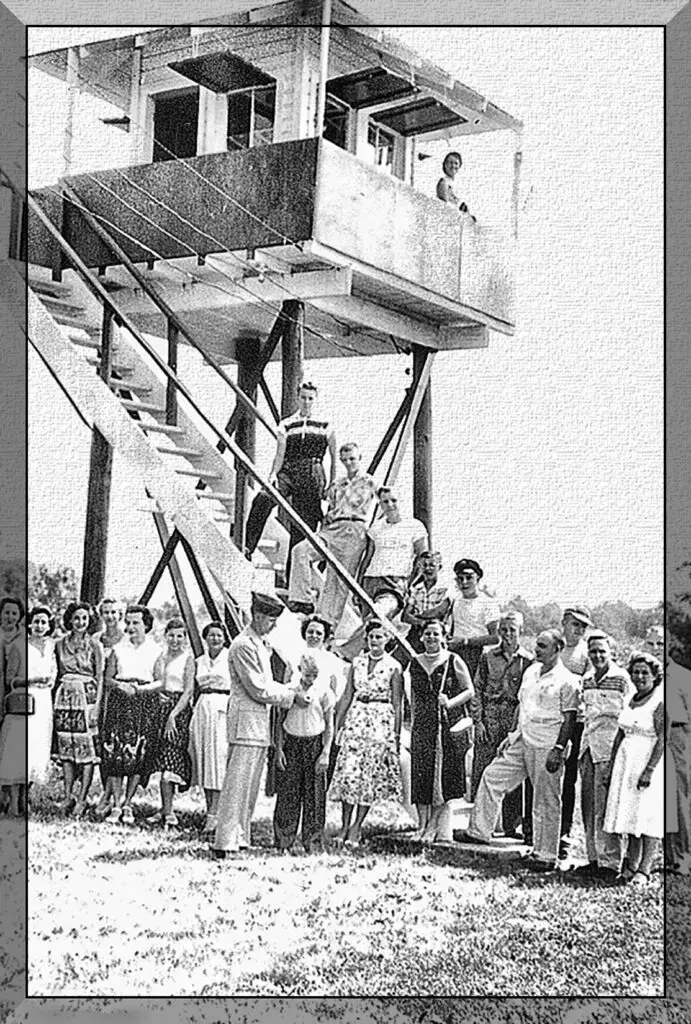
I was born in Vermilion, Ohio near the end of WW2 – on November 8th in 1944. Franklin Roosevelt had just been elected to his 4th, and final, term as President of these United States. The nation was running strong on a war driven economy. And although I was unaware of it at the time that economy would build in strength, as it pertains to Vermilion, Ohio, for about the next 40 years.
For the first half of the 20th century the economy of Vermilion, Ohio was driven by two primary industries: fishing and the manufacture of lighting fixtures. The fishing industry didn’t suffer due to the obvious fact that it was a primary food source provider of fresh water fish for a good part of America. The lighting industry didn’t suffer because it produced signal lighting for the navy, and also because, in addition to lighting, the industry also manufactured war products that were necessarily made of brass and therefore could produce shell casings if needed. These enterprises fed the local economy and provided employment to all able-bodied citizens who cared to work – both male and female.
As a youngster who came age near the end of this great conflict; and as the youngest of eight children born to parents who owned and operated a weekly newspaper; I do not recall a time when I didn’t know about the war. I knew who was involved, and where it was fought. I knew of the great events of the war (i.e., D-Day, Pearl Harbor; Hiroshima; etc.). I knew what “VE” and “VJ” days were about. I knew who Adolph Hitler, Joseph Stalin, and Emperor Hirohito were. I knew every veteran in town – personally. I respected these men and women, and I was (and remain) in awe of them.
People were then, by and large, extremely patriotic. The Memorial Day parades were well attended. The local Veterans of Foreign Wars Post was organized as a direct result of the WW2 and Korean wars. I never heard one bad word from anyone about our military or our Presidents (current or past). Folks pledged their allegiance to the flag and joined in the singing of our national anthem (even if they didn’t’ know all the words) when required. I also remember when the words “under God” were inserted into the Pledge of Allegiance.
Vermilion’s churches were all well attended. In fact, the church my family attended, which was built in the latter part of the 19th century, grew so large that by the mid-1950’s a new, larger, church was needed and consequently built.
Several reactions associated with the war and now nearly forgot by most Americans who came of age during and after the conflict had to do with the “cold war” (that was a direct result of philosophical differences between the United States and Russia) and the emergence of the world into the “atomic age”.
Civil Defense organizations throughout the nation were quite common. Areas in cities and towns that might provide shelter if an atomic bomb were to fall on or near our respective areas were common. They were marked by yellow and black signs and usually pointed the way to basements in public buildings. During those years a common piece of graffiti often found scrawled near the doors of beer joints was “Fallout Shelter! / Walk in. / Fall out!”
Related to these post-war sensitivities were spotter towers where persons would sit and watch the skies for enemy aircraft. They were similar to towers one might find in forested areas where rangers looked for forest fires. They were simply an open room (about 12’x12’) about two stories high. There were windows that could be fully shuttered all around and a telephone connected to a central location somewhere where (I imagined) someone sat with a map on a wall. There were posters on the walls of the tower with silhouettes of various airplanes on them. When a person spotted and potentially identified a particular plane, they would pick up the phone and call that information in to whomever took such calls. By the time I began to visit the one in our town there were never any people regularly scheduled to spot planes, and the facility was only open in the summer (there was no heat).
Vermilion’s tower was located on the eastern side of the Decatur Street High School football field. During football season a sports announcer was able to use the watch room at the top to call games. Later, I believe, a similar tower took its place with a room at the base that was used as a refreshment stand during football games.
Another reaction to this “atomic age/cold war” threat was a bomb drill designed for school children wherein students were directed to get on their knees beneath their desks and cover their heads with their arms. This routine, in retrospect, was probably one of the dumbest emergency drills ever designed by man. One might easily suspect, however, that it had more to do with assuaging the anxieties of parents than it had to do with providing protection from an atomic blast.
Things in post-war Vermilion, Ohio were rapidly moving along. A booming market in the American automobile industry brought a new Ford Assembly Plant to the area, and the population exploded in the latter part of the 1950’s – from roughly 2000 to approximately 10,000 people in a matter of a few years. The steel mills and shipyards in nearby Lorain, Ohio were going strong – and all was well. No one envisioned a day when it all would disappear. But it did. But that’s another story – for another time.
Ref: Special Thanks to late A.C. Tarrant; VPH,11/10/11; Rev. 11/06/22.
Vermilion resident Rich Tarrant is Curator of the Vermilion History Museum and a son and a grandson of the late proprietors of The Vermilion News (1897-1964). Readers may email him at: rnt@twc.com
© RNT November 6, 2022

A BAD DAY IN VERMILION
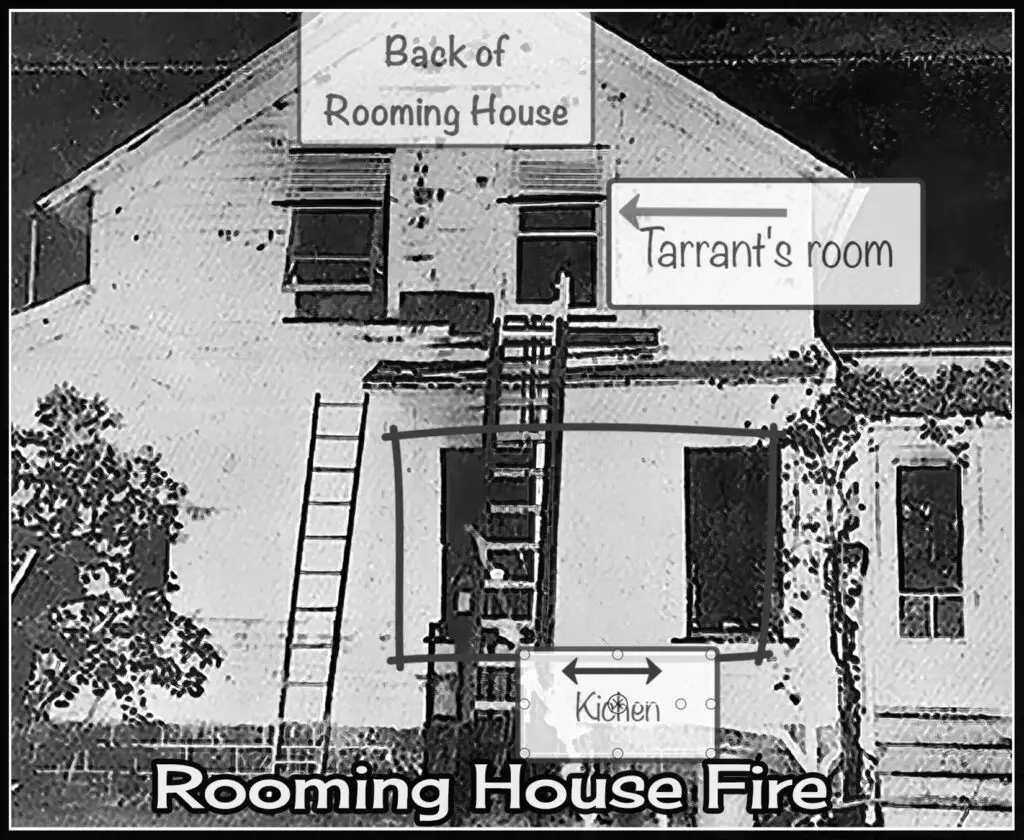
May 12, in 1964 was a dismal day in Vermilion. Cloudy and rainy it was one of those early spring days when all a person really wants to do is just roll-over in bed and go back to sleep – until June. But before the sun had a chance to touch the horizon sirens interrupted the sweet dreams of folks living near west Ohio Street – the odor of smoke permeating their reveries.
Some years thereafter, late Vermilionite “Pete” Alan Neiding, who at the time lived with his parents and sister in a home on South Street, told me that the smoke had awakened both he and his father (who was at the time a Vermilion Volunteer Fireman). Running from their home they discovered the house behind them at 413 Ohio Street aflame.
On a small roof just above the kitchen of the home “Pete” saw a man bleeding from cuts to his head and shoulders frantically looking for an escape from the flames below him. Somehow, he found a way to get the man out of harm’s way. Just a very few minutes before that another resident of the house had discovered the fire and had run from room-to-room banging on doors to alert others living in the home.
Gladys Risdon, 66, the owner of the rooming house who kept a room on the first floor tried to alert authorities but due to the smoke and confusion was unable to use the phone. She along with two of her boarders, Elmer E. Palmer, 67, a retired railroader, and Arthur Fox, 58, an employee of the Heys Music Store were able to escape the inferno just before the firemen arrived. Unfortunately, one boarder, Theodore R. Adkins, 57, did not.
Adkins, a former W. Virginia coal miner, had lost a leg some years earlier and had come to Vermilion to live near his son Frank. He had apparently been overcome by the smoke, and due to his handicap was unable to move fast enough to escape.
I have a rather vivid recollection of this fire because my family home on Perry Street was only “half a Vermilion city block” from the rooming house. In addition to this, the bloodied and burned fella Pete Neiding had helped down from the roof of the home was my 63-year-old uncle Phillip Baden Tarrant. My uncle never really recovered from his injuries. His room was located directly above the kitchen where the fire had apparently started. When he woke and jumped from his bed to the floor the flames burned his feet and legs. In a panic he crashed through a window onto the porch roof where “Pete” found him. The burns to his legs were extremely incapacitating. By 1969 he was living at the Soldiers and Sailors Home in Sandusky where he passed away in January of that year at the age of 69.
As the years passed, I’d nearly forgotten the fire where my uncle had been so terribly injured. Forty years passed. Then one day I met and befriended a Vermilion guy named Frank Adkins who was helping out at our local food pantry. During our many conversations he mentioned a fire where his father had lost his life back in 1964. I was astounded to discover that it was the same fire in which my uncle had been so terribly injured. It had proven to be, as is obvious, a fateful day in the life of my uncle. But for Theodore Adkins it had been his last.
The entire event was tragic. One that I don’t believe could be replicated in our town today. I assume that if and where boarding / rooming houses exist in our community laws regarding their operation and safety codes are strictly enforced. Maybe this event is best forgotten. Maybe not. But for sure it was a bad day in Vermilion – for everyone.
Ref: Sandusky Register, 05/12/1964; Special Thanks to late Vermilionites Frank and Dolores Adkins.
Vermilion resident Rich Tarrant is Curator of the Vermilion History Museum and a son and a grandson of the late proprietors of The Vermilion News (1897-1964). Readers may email him at: rnt@twc.com
© RNT October 30, 2022

Ackley: The G.A.R. Music Man
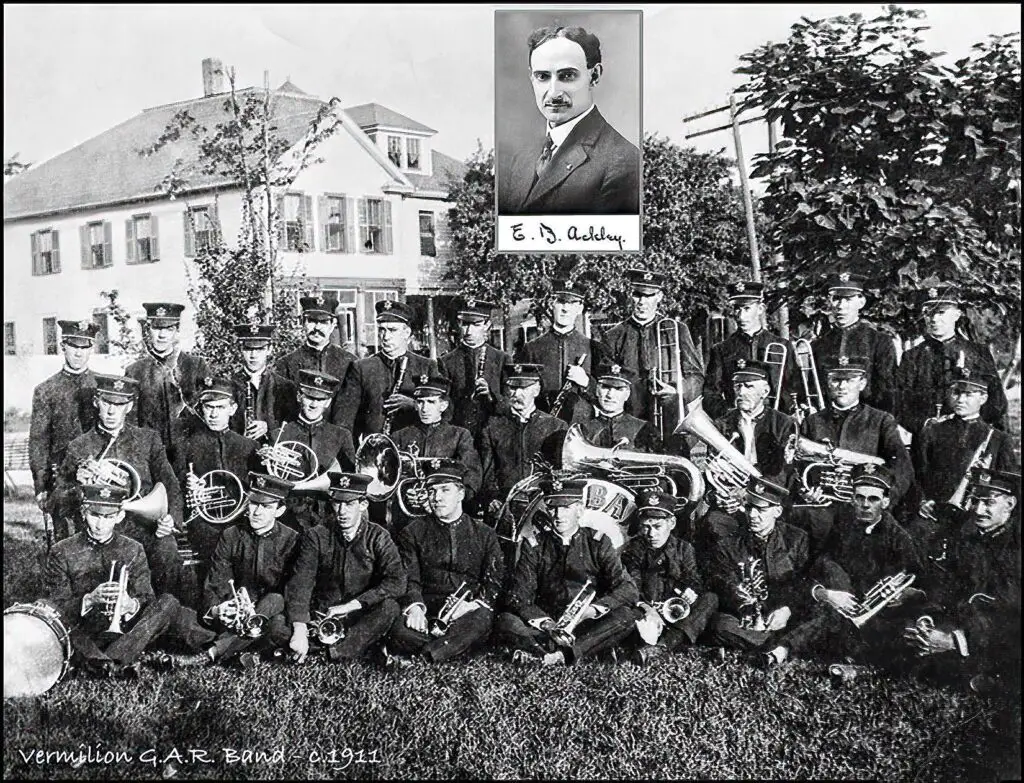
The Grand Army of the Republic (aka. G.A.R.) was a fraternal organization composed of veterans of the Union Army, Union Navy, Marines, and the U.S. Revenue Cutter Service who served in the American Civil War. It was founded in 1866 in Springfield, Illinois, and grew to include hundreds of “posts” across the nation. It was comparable to present-day veteran’s organizations such as the American Legion, Veterans of Foreign Wars and AmVets. It dissolved in 1956 upon the death of its last member Albert Woolson of Duluth, Minnesota. But back in the early years of the 20th century it was still a very strong and active organization all across our nation.
In Vermilion the G.A.R. Chapter was known as the Delker Post. It was named in honor of Captain Henry Delker. Delker had been born in Baden, Germany on the 4th day of July in 1836. He passed from life at exactly 4:00 p.m. on Monday, December 22, 1890, in Vermilion, Ohio. He was, oddly enough, a belated casualty of the American Civil War. Wounded in the Battle of Nashville in December of 1864 the bullet he received on that battlefield 26 years earlier had finally proven fatal. But that is another story.
In the early years of the 20th century the Delker Post of the G.A.R. organized the band seen posing for the accompanying portrait. It was taken near the marine cannon at the back of Exchange Park about 1911. The large building in the background is the historic Wagner Hotel – currently the home of Harbour Town Dentistry and the Vermilion Photojournal offices. Few (or perhaps none) of the band members pictured were veterans from the War of the Rebellion. Most were relatives, friends of veterans or just local musicians who were talented and enjoyed being part of the company.
Pictured in the Top Row: John Krapp, Alfred Buell, Clarence Walper, Pearl Roscoe, Jake Baumhart, John Becker, Miles Lawless, Otto Kuehlman, George Becker, Phil Darley, and Charles Horton. Middle Row: Tony Becker, Carl Blair, Ralph Risden, Charles Krapp, T.J. Ball, Ed Law, Fred Morgan, Creight Powell and John Malik. Bottom Row: P.B. Morgan, August Schwensen, Will Krapp, Earl Childs, Fred Krapp, Walter Murschell, Henry Reis, Cliff Squires, and E.B. Ackley the band director. Ackley is also pictured in the inset.
Band Director Ackley was truly an interesting personality. He was born Eugene Baker Ackley on the first day of November in 1871 in Illinois and died in Sandusky on the first day of September in 1957 at the tender age of 85 years. He was, of course, a consummate musician. But he was also a talented businessman. In fact, when he died, he was board chairman of the Western Security Bank in Sandusky.
He began his musical career while a youngster as a trouper with the traveling Gorman Minstrel Show that played in every state in the union during the 1880s. In the late 1880s a member of The Great Western Band, then performing at Cedar Point, noting the unusual musical ability of one member of the Gorman troupe (namely Ackley), got in touch with him and brought him to Sandusky to join the Western group.
The Great Western Band had been founded in 1867 by a man named Charles Baetz, one of the early (1888) general managers of the Cedar Point Pleasure Resort Company. The Western Band played for both daily concerts and dances at the resort. Shortly after he began performing with the band it disbanded (pun intended) and he formed his own band and with it continued to perform at Cedar Point.
However, his band was but one of many he organized and directed over ensuing years. Vermilion’s award winning G.A.R. Band was but one of them. In addition to it he directed the Zenobia Shrine band in Toledo. And in Sandusky he organized an orchestra that played for numerous formal events in the region. He frequently acted as a guest director of a large Sandusky High School orchestra and organized a large and valuable library of music for the school. In his spare time, he operated (of all things) a pool and billiard parlor and was also engaged in the wholesale tobacco business. He was also an active member of local Masonic lodge becoming a Master Mason; a member of the Shriners in Toledo; the Sandusky Elks, Eagles, Odd Fellows, and director of the Erie County Ohio Automobile Club.
When he passed away, he was serving as the chairman of the Good Samaritan Hospital building fund and, as previously indicated, board chairman of the Western Security Bank. To be sure Band Director Ackley, the G.A.R. Music Man had passed away. But the harmonies he put together during his lifetime certainly did not. He had simply passed on – the baton.
Ref: Sandusky Register 09/03/1957; VHM Photo Archive; 10/20/2019; Rev. 10/23/22.
Vermilion resident Rich Tarrant is Curator of the Vermilion History Museum and a son and a grandson of the late proprietors of The Vermilion News (1897-1964). Readers may email him at: rnt@twc.com
© RNT October 23, 2022

Entertaining History

Some years ago, I wrote about some items I came across in the morgue files of The Vermilion News that I found to be – for the lack of a better word – entertaining. Though I realize some of these items are not “ha-ha” funny it is still difficult not to be entertained by them. Anyway, I’ve been working my way through these files one week at a time for 20 years and I find that some of those stories are like old movie serials: every week there’s something new. With that being said what follows are parts of some of them:
One of the items was a piece about a fellow who lived in Milan, Ohio whose wife, after leaving him with another man, returned and subsequently conspired with her lover to poison him. There’s obviously nothing funny about that. But to get right to the facts as reported…
The March 9, 1905. edition of The News reported that while “very little has developed” (in the case) “besides what was already known…several ‘love’ letters have been brought to light in which…” the Mrs. asked her beloved to “dispose of her husband, etc.”
Now that information, of and by itself, may be of interest. But what’s more interesting is the fact that the court deemed it appropriate to release to the press “a specimen” of those letters – and tis a doozy. The Mrs. writes [an unedited letter]:
”Oh Chucky Dear don’t for get what I told you Monday goe and get that or sonthing tht wont smell I will fix him right off I cant live with him no more I hate him like a snake so Chucky do get it and give it to me Tuesday night about half Past 6 o’clock at dicks meanes barn so don’t be slow so this is all fir this time My darling chuck I love you and you know it ther will no one know anything about this but you and me
Love kissessss From your sweet ANNA”
Though I’ve not reached the sentencing part of this thrilling soap opera, methinks I can guess the rest before I find it. It is very likely that “Sweet Anna” and “Chucky Dear” spent most of the rest of their lives together doing time in separate penitentiaries. I guess a simple divorce was out of the question.
And then there was an item, also in the 1905 newspaper, about a fellow named Benjamin F. Goodsell, an aged resident of Ashmont (a rural settlement just south of town), who was quite ill. [NOTE: Ben’s middle initial wasn’t “F” (it was “N” for Newberry) and his illness wasn’t fatal.] Ben was determined to deliver his own funeral oration. In pursuit of that it was reported that he “prepared and delivered into a phonograph an obituary in which he set forth ‘his life’s objects.’”
Somehow, he managed to hold the grim reaper off until April 16, 1908, and even then, he was only ailing for about an hour before he died. In addition to that he was hardly what most folks would currently consider being an “aged” person. He was 72.
What he or someone else did manage to do, however, was to have the eulogy he wrote for himself about himself read at his funeral. The April 29, 1908, edition of the Sandusky Daily Register reported, “The address was delivered by Hudson Tuttle”. [Note: Some readers may recall that Mr. Tuttle was a prominent Spiritualist, author, and lecturer who made his home in Berlin Heights.] But sadly, no mention was made of the aforementioned “phonograph recording”. The article went on to tell readers that, “Mr. Goodsell had a creed of his own, which he lived up to and was willing that others should do the same.” About that there was, and certainly remains, no doubt.
I realize that these files are contained in a newspaper library historically referred to as a “morgue”. And it’s a given that morgues are historically considered to be unpleasant places. But I would submit, as I have before, that although some of the stories therein are sad, and some not, that many, many of these tales of a yesteryear are still very, very entertaining.
Ref: The Vermilion News 02/02/05 – 03/09/05 – 04/16/08; Sandusky Daily Register 04/22/08 – 04/29/08; Special Thanks to Bobbi Neller Riley; VPJ 02/07/13; Rev. 10/17/22
Vermilion resident Rich Tarrant is Curator of the Vermilion History Museum and a son and a grandson of the late proprietors of The Vermilion News (1897-1964). Readers may email him at: rnt@twc.com
© RNT October 16, 2022

Things Built to Last
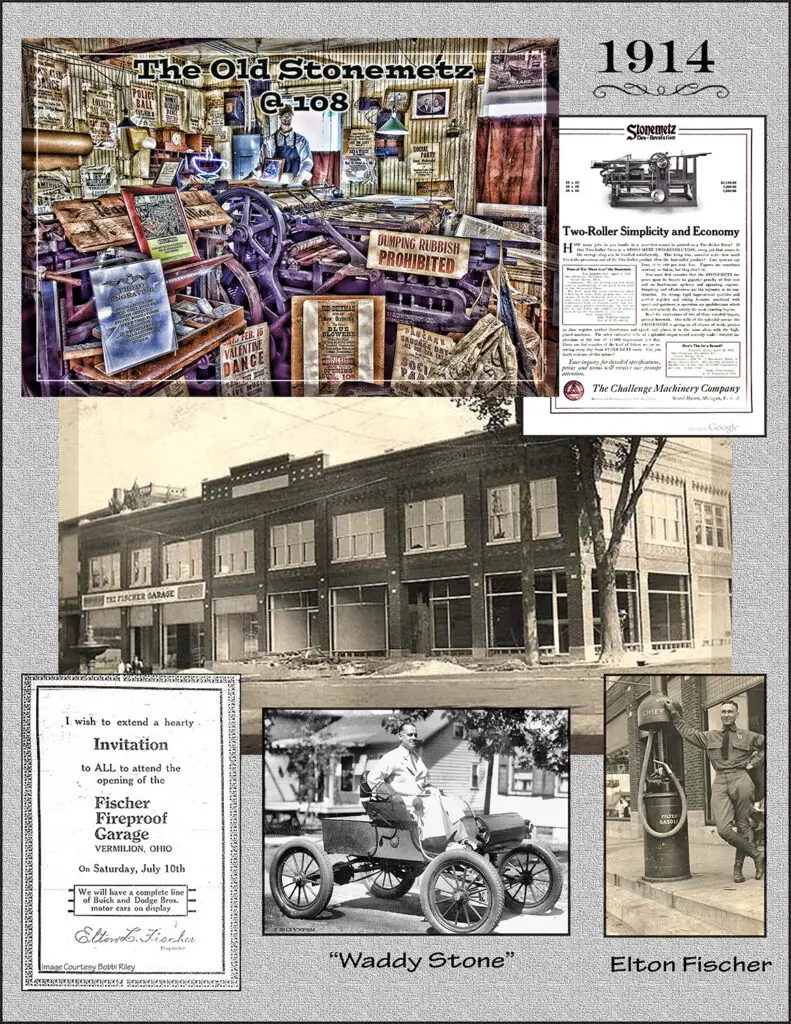
It is extremely unlikely that many persons (other than me) celebrated the 108th anniversary of the Stonemetz 2-Revolution newspaper press located on the main floor of the Vermilion History Museum. While I didn’t really have a celebration for the press. Coincidentally, I also found that it was purchased and installed 108 years to the day I stumbled across that particular information. My grandparents had purchased the for about $1300 in September of 1914. Today that would be equivalent to a bit under $40,000. So, it was a major investment. It was also a good one. It printed the local weekly for the next half century.
The press was installed in the shop in time to print the September 24th edition of the paper and it “showed”. Many of the headlines for articles (at least on the front page of the newspaper) were larger than they had been in the past. And while the old press was only capable of turning out 1500 papers in an hour the new one could easily do 2000. Posters and half-tone work could also be done using the press.
By current standards the machine would be considered to be a dinosaur. But in that yesteryear, it was a marvel. In 1914 the local weekly would generally be an eight-page newspaper and 2000 copies were printed. The press was hand fed and inked two 25”x33” pages on one sheet of paper at a time. Four runs were needed to complete the printing. It took around 4 hours to print the entire broadsheet. The new machine saved an hour of printing time. And that, if you were the person running it, spelled relief.
The Stonemetz was state-of-the-art. And few towns the size of Vermilion in those years had such a press – much less a newspaper – like The Vermilion News. An open invitation to the public at the time invited all to visit to see “the new machine run”. While press was powered down in 1964 that old invite to visit and see the press remains open.
At almost precisely the same time this marvelous printing press was cranking out its first weekly issue on Grand Street something just as “grand” was taking place in the downtown section of the village.
The News reported that local entrepreneur George Fischer had been given permission from the town council to use the “sidewalks and such portion of the street as was necessary” while he was erecting a new building block on the southeast corner of Division and Liberty streets. Fischer broke ground for a brick block on that corner that would be 60 by 130 feet, and would consist of a basement, 4 storerooms and a garage. When asked whether it would be one or two stories Mr. Fischer replied that he had not yet decided, but it was to be built with the intention of making it a two-story block. It was thought that the new block would add greatly to the business portion of the town, and all were assured that it would be put up in first class shape because “Mr. Fischer never does things in a slip shod manner”.
Now flash forward 108 years. We all know and recognize the result of Fischer’s request (i.e., the Fischer Building). But there is something some may not know or realize about his building. It concerns the unique way the 2nd floor was constructed. There are no roof support pillars on that upper story – which means that it was/is one large room. I’m not precisely sure as to the reason this was so. While documents show that it was later used as a dancehall and then a roller-skating rink (the floors are all hardwood), I have the very distinct impression that no one had any substantial idea as to precisely how it was to be used prior to construction. And there is one other thing.
Just prior to the building of the building Mr. Fischer along with his son, Elton and another Vermilionite named Albert “Waddy” Stone had acquired a franchise for a Buick / Dodge dealership. Although it may be hard to imagine an auto garage and showroom operating in the building. But it did – back then.
In some respects, 1914 had proven to be a banner year for the Village of Vermilion, O. But how long would / did all of it last? Well, there’s no auto dealership in the Fischer building today (2022). And the monster Stonemetz printing press in the old print shop has in many respects actually proven to be a veritable dinosaur; albeit a quiet one. But one thing for certain. Both were built to last.
Vermilion resident Rich Tarrant is Curator of the Vermilion History Museum and a son and a grandson of the late proprietors of The Vermilion News (1897-1964). Readers may email him at: rnt@twc.com

Bill Koinis Vermilion’s A&W Man
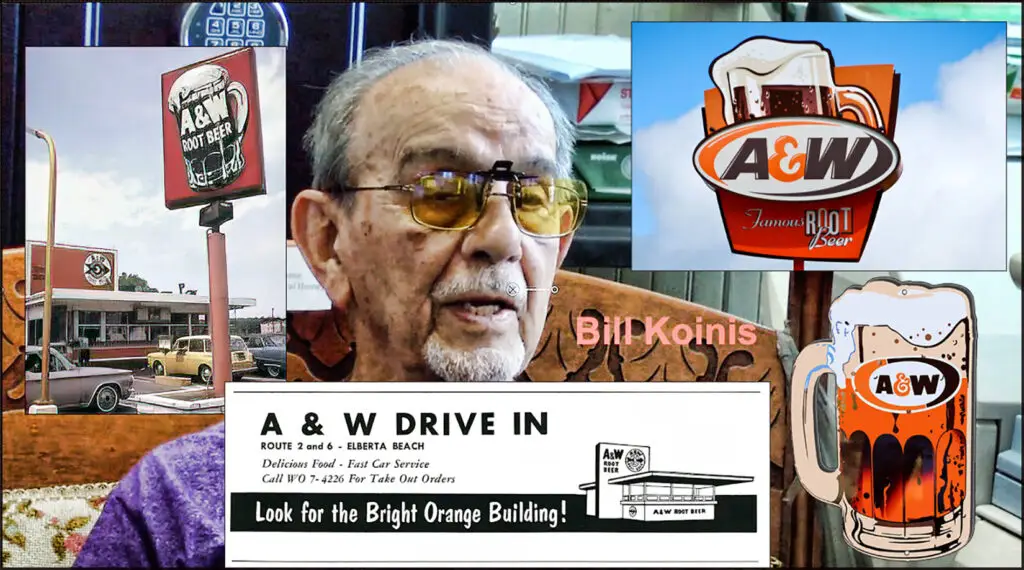
At the end of WW1 in 1919 a man named Roy W. Allen opened a root beer stand in Lodi, California. Three years later he partnered with a man named, Frank Wright. Combining their initials, they created what we all know today as “A&W” Root Beer. It was one of the first franchised restaurant chains in the U.S.
In 1958 a Toledo man named Chris Koinis opened an A&W In Sandusky. Two years later his brother William “Bill” Koinis and his family, opened Vermilion’s wonderful A&W Root Beer Drive-In. Bill’s restaurant was located on a site along Elberta and East Lake Road. Currently (2022) a Wendy’s Restaurant occupies the location.
Bill’s road to Vermilion began in Toledo following his graduation from Scott High School in 1947 He attended the University of Toledo for several years before deciding to venture out into the business world. For a time (and as a young boy) he helped his father in his business and then went to work at a new restaurant at Gross Point Michigan for six months before joining the Air Force in December of 1950.
Following military service, he returned to Toledo and worked again for his father, James, who operated a food concession business. He then worked for the Otis Machinery Company as sales office manager until the spring of 1960 when he and his wife decided to open the A&W business in Vermilion.
Bill and his wife Patricia Ann Livi-Koinis had four children and all – John, Jennifer, Jodi, and Julia – worked at the restaurant over the years. They started by (what else?) washing root beer mugs. But they did, of course, have other workers. Many of the names will be familiar to long-time residents: Toni Yeamans, Debbie Rust, Steve Burch, Linda Casterline, Marylee Russell, and Nancy Puckett. In the winter Mark, from Mark’s Sunoco, would plow the lot.
None of the carhops / servers used roller skates like those in the movies because Bill was not enthused with the prospect of having to clean up broken glass from mugs that might fall from the trays and break on the pavement. He noted that many customers liked the mugs, and he did sell them. His workers tried their best to keep track of them. But somehow a few seemed “to leave the premises without being paid for.” (Imagine that.)
One time one of the carhops told him that one of the mugs she’d taken to a family with their order didn’t return when she went back to refill them. Politely hinting to the couple in the car, that they might have “forgotten” to return it, they said “No, we don’t have any mugs.” Then their little girl in the back seat spoke up saying, “Yes, mother. Remember? You put it under the front seat.” He indicated that there were a few incidents like that. “But all in all,” he said with a smile in his voice, “it was a great place.”
All the food they served was fresh. The only items that were frozen were the french fries and shrimp. Nothing was pre-cooked. Everything breaded was freshly breaded using their own recipe. The fish (fresh perch) were purchased in the morning from either Dennis or Kishman Fish for 25¢ a pound. The full dinner was a whopping 95¢. He said, “Most of our fish were swimming in Lake Erie the night before.” They also made their own barbecued beef from a slow cooked roast. Folks also got what they wanted on their hamburgers.
Bill operated the Drive-In for 26 years. Twenty-five under the A&W name – the length of his franchise. He might have renewed it, but it was recommended that he tear the building down and build one with inside service. But that would have required longer hours and by that time his children had grown and had families of their own. So, for one more year he operated under the name “Bill’s Last Stand”. And it was.
Mr. and Mrs. Koinis retired and eventually moved to Madison, Georgia to live with their daughter Julia and her husband John Kimball. Patricia passed away on April 24, 2014. In November Bill will be 93. He told me, “I have really enjoyed being and living in this community, the business community – working with them. Supporting the schools, the athletic facilities, the Lions Club. This has been a great, great place. My children have prospered here – enjoyed it. It’s a great place to anchor.”
Thanks Bill. Vermilion certainly appreciated having you here too.
Vermilion resident Rich Tarrant is Curator of the Vermilion History Museum and a son and a grandson of the late proprietors of The Vermilion News (1897-1964). Readers may email him at: rnt@twc.com
©RNT October 2, 2022
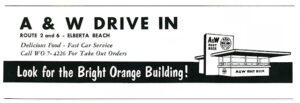
Vermilion’s Sea Scouts
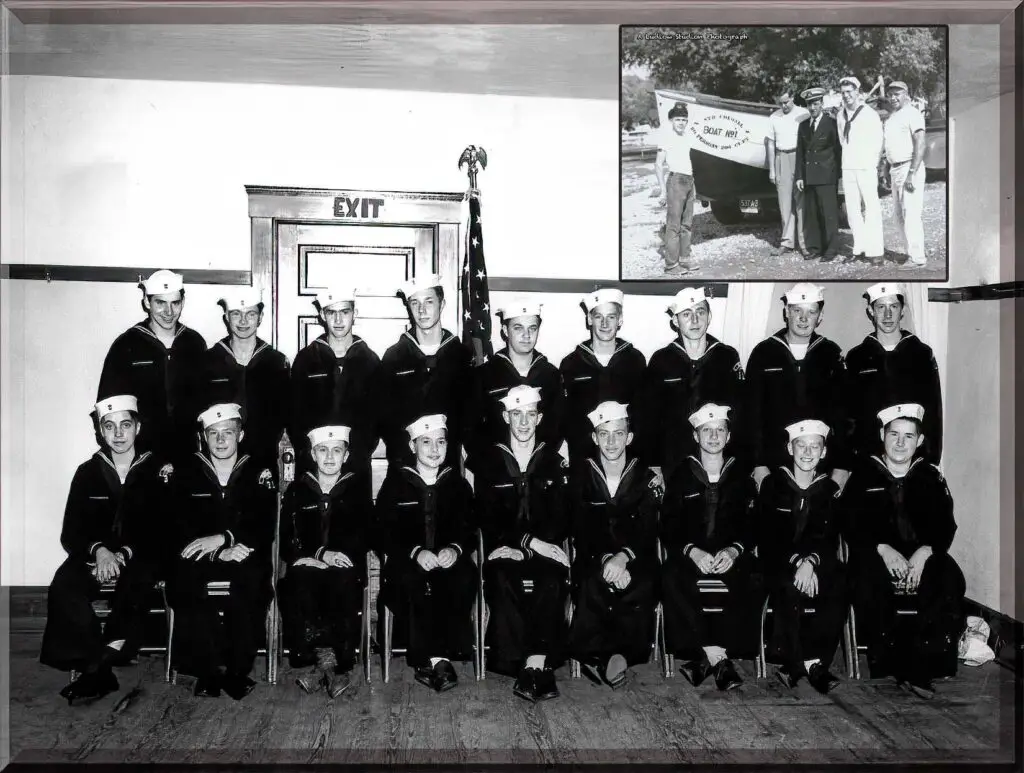
In 1910- Warington, the older brother of the founder of the Boy Scouts, wrote a book called Sea Scouting and Seamanship for Boys. It was enthusiastically received by the young men of Britain and soon found its way to the United States.
In 1912- Sea Scouting in America was founded by Arthur A. Carey of Waltham, Massachusetts, and he was appointed Chairman of the National Council Committee on Sea Scouting. That summer, Charles T. Longstreth organized a Sea Scout patrol on his yacht in Philadelphia.
On September 1, 1949 – Sea Scouts officially became Sea Explorers. This was primarily a change in terminology and the old Sea Scout program continued much the same is it had in the past.
The photo accompanying this essay came to me several years ago in a round-about way (for me). It was captured by late Vermilion photographer Paul Ludlow and Vermilionite Larry Howell gave it to me. I’d not seen it before Larry showed it to me. He had acquired it from my brother Al. Although I did recognize a few faces many names of those pictured were provided by my brother-in-law Dave Wilkes and my sis “Ginny” Wilkes. The Scouts / Explorers pictured are:
Standing – Tom Jevons, Ray Ackland, Billy Lee, Frank Norcross, Gilbert Olah, Larry Riggleman, Jim Beursken, Dean Osberg, Jerry Normandeau Seated – Bill Banks, Harry Troxel, Ray Dunn, Mike Anastas, Jim Greenawalt, Rich Parsons, John Kudela, Bruce White, Doug Francis..
Although I did not know all the explorers in this portrait, I did remember nine of those faces – after the names had been provided me. Harry Troxel (as many of my contemporaries know) eventually went to work with the Vermilion Police Department and was later known as Sgt. Troxel. I always found him, and his younger brother Billie and sister Mary Ellen, to be very likeable people.
Bill Lee. Bill is the son of L.D. Lee (in the inset pic). In the 1950s the Lee family lived in the gigantic house now known as the Gilchrist Bed and Breakfast. His sister Nancy later married a well-known Vermilion guy named Glenn Fulper. But what I found most impressive about Bill when I was a wide-eyed youngster was that he had joined the U.S. Coast Guard and was stationed for a time in Lorain. I always thought it fantastic when the Coast Guard boat docked in Vermilion (down by the water treatment plant) and our own Vermilion guy – Billy Lee – was one of the sailors who disembarked from the vessel.
Mike Anastas was a dark handsome fella that I knew / know to be an extremely intelligent guy. Following his graduation from VHS and Ohio University he eventually found employment in the news and advertising business in New York. I spoke with him briefly when he visited Vermilion just a few years ago. I would also hear from him (via email) from time to time. Like many Vermilion “expats” he was compelled to “come home” now and then.
Jim Greenawalt (his name was actually Norman James) was the son of Rev. Norman Greenawalt pastor of the Vermilion Evangelical and Reformed Church. His mother, Norma, was a Vermilion school teacher. Jim (I believe) followed in his father’s footsteps and “took up the cloth”.
Rich Parsons was a very well-known Vermilion guy. Rich was (as many know) Don Parsons’s older brother. Rich and his wife Pat ran a fire extinguishing maintenance company as well as the local extension of the Ohio BMV for many years. It was located just above his brother’s marina.
Don Parsons is the young fella (on the left) in the inset photograph. He is pictured with several Vermilion Sea Explorer advisors: Robert Horner, Bob Liljegren (in the uniform), Jerry Normando and L.D. Lee (owner of Lee’s Boat Yard next to McGarvey’s). This photo was taken aside a 20-passenger lifeboat that was given to the Sea Explorers in 1954 by a company in Baltimore Md. [Note: That’s another whole story.]
John “Johnny” Kudela was an extremely good-natured person with a variety of interests including aviation. And next to him is Bruce White. In this photo Bruce reminds me of his little brother, Stuart. During their teen years both were small guys. But they didn’t stay that way. And both Stu and Bruce, were very clever persons. Bruce worked as an air traffic controller in Oberlin.
The next guy, Doug Francis, was the son of one of the town’s most popular 1st grade school teachers Margaret “Mrs.” Francis and a direct descendent of Vermilion’s Thompson family. As a young man Doug always seemed to be driving some rather exotic (at least for the 1950s and ‘60s) sports car (i.e., vintage MG, Morgan, etc.).
Well, I wish I knew, and could tell you about, all the guys in this photograph from the yesteryear. But I’m real sure that if you asked someone like Don Parsons, my friend Larry E. Howell, or Ginny or Dave Wilkes they could fill in the blanks. But, as far as the sea / lake goes the only thing I’ve ever done perfectly with water is drink it.
Vermilion resident Rich Tarrant is Curator of the Vermilion History Museum and a son and a grandson of the late proprietors of The Vermilion News (1897-1964). Readers may email him at: rnt@twc.com
RNT – September 11, 2022

MR. WELL'S FOLLY
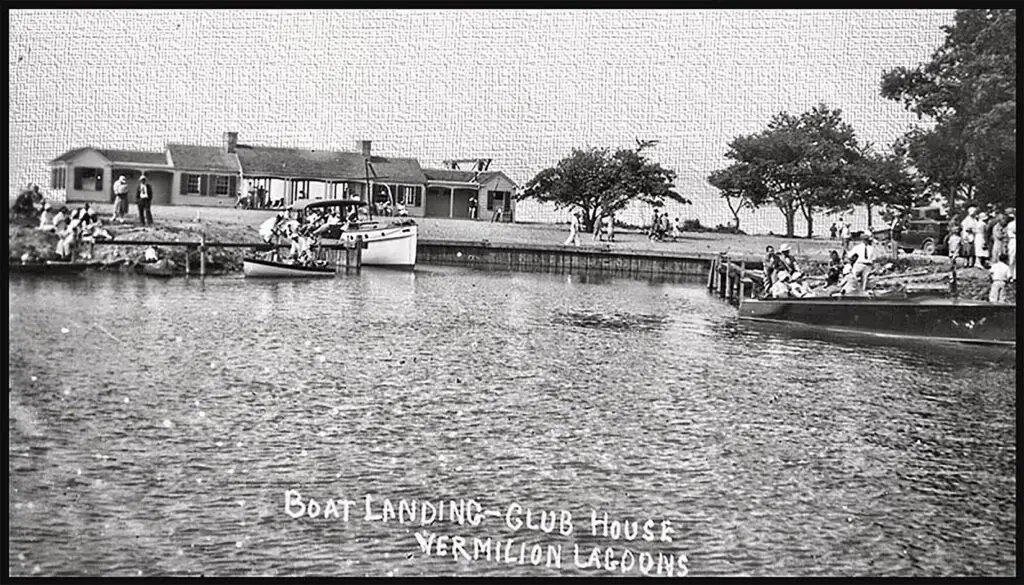
Days In Vermilion: Where dear old Vermilion’s flowing / Where the weeds and thistles grow. / Where the rippling waters flowing / Where the hoboes wash their clothes / It’s a lovely stream of water / and everybody knows / There are no Chinese laundries / Where the Vermilion River flows.
These words first appeared in the 125th Anniversary Historical Edition of The Vermilion News on August 25, 1962, noting that it was written and sung by someone named F.B. Maxfield. Unfortunately, there was no further mention of precisely who Maxfield was, when the ditty was written or sung. But clearly it was before the development of what all have come to know as the Vermilion Lagoons: The Cape Cod on Lake Erie.
Here, I take you (temporarily) back in time to the days when only “weeds and thistles” thrived in that area. It was mainly a wetland from the beach on the lakefront and south to the lake road, and the river and rail bridges. There was a worn path that ran east and west through the marsh. It bordered the beach allowing persons access and egress through the west gate of Linwood Park and the river. At one time a colorful French-Canadian named Lewis “Cloudy” Noel operated a ferry franchise and boat livery along the stream. Cloudy rented rowboats and (with a song in his heart) ferried persons across the river to and from the thriving, but small, conurbation called Vermilion.
During the era known as The Great Depression in our nation a man named Louis Wells, who owned The Wells Construction Company in Cleveland, had an idea. Knowing that the depression would eventually end, he wanted to keep his company going because he employed a good number of men. So, he just had to find work for them.
Wells looked at the swamp that bordered the Vermilion River and saw opportunity. He could dredge lagoons from parts of the swamp, pile the rich soil on the sides of the lagoons, let the wet soil dry, smooth it out, and make it into a water-side housing development. In October of 1929 an agreement transferring the marsh land from the Smith estate to the Wells Marine Construction Company of Cleveland was finalized. Vermilion Mayor, E.S. Welch was given notice of this project during the last week of that month.
The initial stage of the plan was to build a road that would run from Lake Road, south of Linwood, to the lake. It called for the construction of a 250-foot lagoon, and a smaller one near the lake. The road would later be known as Portage Drive. The proposed lot size for housing was 50 x 125 feet. Construction was to begin on December 15th and continue throughout the winter with the expectation of having part of it completed by early summer.
The task was formidable. Also, it is easy to imagine there were many town folks who laughed at the idea. After all, who in their right mind would want to build a house in an old marsh. It was (and remains) in a flood plain. But despite all criticism Wells forged ahead with his folly unperturbed by naysayers.
The accompanying photo affords a rare look at one of the first structures (if not the first) in the Vermilion Lagoons. While the script on the photo refers to the structure as the “Club House” people would later come to know it simply as the “Beach House”. Although it has over the years been renovated it still looks much the same today. Interestingly enough, the view of the area pictured would be impossible to reproduce without tearing down several homes.
“Wells Folly” eventually became one of the most attractive and popular home development projects on Lake Erie. One home after another went up. Residents had ready access to their boats along the lagoon that fronted their homes. The view was/is spectacular from their living and dining areas. The gulls, cranes, and other odd-looking waterfowl soared over the water and roosted along their docks waiting for a stray fish. There was also a great deal of continuity among the houses. All were white. Most had green trimmings. But once in a while black crept into the trim. It truly resembled- and continues to appear as – a tiny Cape Cod village.
Occasionally, hard times visited the area. When the ice froze thick in the river, and the thaws came, ice jams would form, and the water and ice would surge around and through the lovely homes. Yet this was true of all the homes and cottages along the river. Currently the Vermilion Port Authority attempts to keep the ice from getting too thick from at least the bridge to the mouth of the channel. It is broken with some regularity. One of the only things that might bring ruin to these wonderful homes today is a flood like the one experienced on July 4,1969. Nothing would stop that. But simply stated: floods do flood, flood plains. As for those who inhabit the Vermilion Lagoons, as well as all others who live, work, and play in the flood plain; they persevere – just clean up and start over again.
Mr. Wells had certainly given new definition to the word “folly”. And it was a positive one: The Vermilion Lagoons.
Ref: VHM News Archives; Special Thanks To: the late A.C. Tarrant; VPJ 08/08/2002; Rev. 09/18/22.
Vermilion resident Rich Tarrant is Curator of the Vermilion History Museum and a son and a grandson of the late proprietors of The Vermilion News (1897-1964). Readers may email him at: rnt@twc.com
© RNT September 18, 2022

The Typesetter(s)
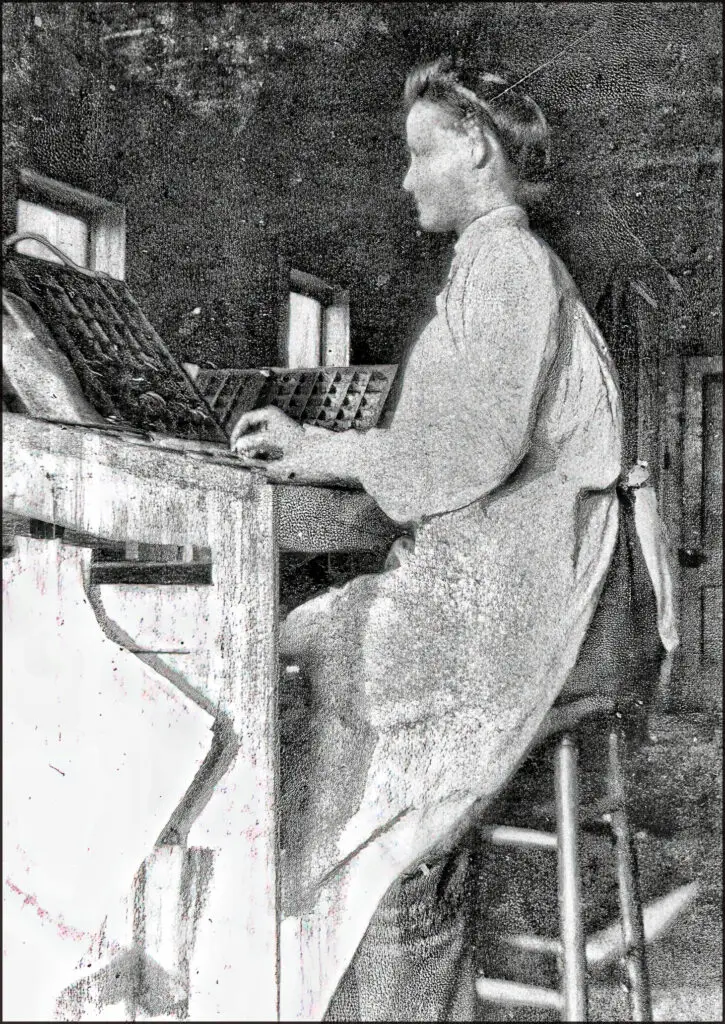
A little blip in the February 6,1903 edition of The News reported that “Electricity turned on the first permanent electric lights in Vermilion Monday night at the Lake Shore [Electric] Power Station.” Nevertheless, electricity for practical and common use had not yet come to Vermilion even five years later. An editorial in The News from October 15,1908 asks: “Do the people of Vermilion village want electric lights providing a fair and just contract can be made?”
When the print shop for The Vermilion News on Grand Street was built in 1904 all the presses were operated by a 4hp gasoline powered engine that turned a line shaft that ran into the shop. Leather belts from the shaft to each of the presses made provided them with power. One might note that this type of power source was not uncommon in most factories throughout the world during the 18th, 19th, and well into the early years of the 20th century. It is important to note in the specific case of the print shop tasks like writing, typesetting, page makeup and composition had to be done by light provided by oil lamps and / or natural light streaming through the windows.
In the photo accompanying this essay my grandmother, Bessie Roscoe is pictured setting type by hand in the print shop around 1905. She is pulling type (letter-by-letter) from the case in front of her. The case is known in the old letter press circles as a “California job case”. Each little compartment houses a letter, number, or symbol. There are large compartments on the left side of each case that contain lower case letters. Upper case letters are contained in smaller compartments on the right. The lower-case compartments are bigger because they contain type pieces that are used more often than others.
And now I pause for a moment in this dissertation to provide ye with a brief history lesson. In years previous, upper, and lowercase type pieces were kept in separate cases, or trays. The capital letter tray was set above the tray with lower case letters. This is the reason capital letters are called UPPERCASE and the miniscule letters are called LOWERCASE The combined case – i.e., the California job case – became popular during the western expansion of the United States in the 19th century.
Typesetting was, as is obvious, a labor-intensive occupation. Ergo, it is easy to see (no pun intended) that having a good light source was very important. And though most persons have likely paid little attention to the design of the building it is no small part of the reason there are so many large windows in the old print shop on Grand Street. Ventilation was, of course important. But good lighting was critical.
To many persons today setting type by hand using one of these old job cases seems an impossible, not to mention a very slow exercise. But just as some of us are able to type rather quickly on a typewriter or computer keyboard without much thought or struggle, it is likely that typesetters like my grandmother knew where each letter of type was located and didn’t struggle finding and setting type. But, again, lighting was critical.
By 1916 electricity and other utilities had become well-established in Vermilion and life and work in the old print shop made good use of those resources. Powering equipment by line-shaft was replaced by electric motors for each press. The old oil lamps were replaced by electric lighting. All the wiring in the print shop (the old knob and tube) was installed on the outside of the interior walls and ceiling. [Note: Although no longer live, remnants of the original wiring installation remains visible today.] And finally, a new Linotype type-setting machine was installed.
Next to the invention of mass-produced moveable type by Johannes Gutenberg in the 15th century the Linotype machine, invented by Ottmar Merganthaler in the late 19th century, no other invention furthered printing or literacy in our world more than the Linotype. Thomas Edison once referred to it as “The 8th Wonder of the World”. My grandmother, along with many other typesetters of the day, likely just let out a long sigh of relief saying, “Now, if we could just teach people how to spell”.
Vermilion resident Rich Tarrant is Curator of the Vermilion History Museum and a son and a grandson of the late proprietors of The Vermilion News (1897-1964). Readers may email him at: rnt@twc.com
© RNT September 11, 2022

Rich "Van Winkle"

And so, another Labor Day is now history. It seems like Memorial Day was just a few weeks ago. I am absolutely certain that many persons both in and out of our great town will agree with that thought – the days just fly. But methinks that for some of us older folks the days seem to go faster than they do for younger persons.
Here are some facts about ageing: The average age of an American is 38.1 years. Only sixteen percent of our population are 65 years of age or older – that’s one out of seven. The good news is that forty-three percent of us will live to the age of 70. The bad news (for me at least) is that the average life expectancy age in the U.S. is only 78.1 years (and falling).
Soon, I will have reached that average life expectancy age. I don’t ask “Are we there yet?” anymore, because before I can get the words out of my mouth I’m already looking at “there” in the rearview mirror.” Still, I’m hardly alarmed. I am (aside from the physical kinks that accompany the ageing process) very often amazed and amused by the experience. Moreover, I don’t really believe that I would’ve noticed the changes that have taken place in just my lifetime if I didn’t conduct tours through our local history museum so frequently.
One of my greatest amusements is to encourage visiting youngsters to work a vintage telephone. To many the word “telephone” of and by itself is passé (so to speak). They have long ago morphed into multi-use devices and are now just referred to as “cells”. But there are several vintage black Bakelite molded rotary phones on display in the museum. One is situated in where youngsters have easy access to it. I encourage them to try to figure out how to work it.
Well, it’s not rocket science of course. So, most of the children get the gist of it immediately. They know what it is. But many don’t exactly understand how the rotary dial works. Some try punching the numbers on the dial face as if they were buttons. Others work the dial – but not exactly. They don’t know that you have to move the dial all the way to the end for it to work correctly. Then there are a few more who don’t know how the receiver works. And those are just some of mechanics surrounding the use of the old rotary devices. We don’t get into things like phone numbers that were once listed like WO-7-4555, much less the fact that “party lines” were platforms from which one’s private affairs suddenly became very public. But it’s not always the very young children who have questions about items in the museum.
I along with my contemporaries, came of age in an era when few kitchen devices needed electricity to operate. Having an electric mixer, for instance, was, once upon a time, a big deal. And many persons still refer to a refrigerator as an “ice box”. But some of these new devices came about so subtly that the changes never really registered in our thoughts. One of those subtle changes is / was the can opener.
On a wall in the kitchen at the local museum is a wall-mounted can opener. It’s there simply because it’s been there since, as some might put it, “Shep was a pup”. In short, it came with the building and its presence was so innocuous there was no need to remove it. Aside from that it’s still useful. It’s not an article that I had ever given much thought to; it’s not spotlighted nor is there a little plaque beside it explaining how it was / is used. Thus, was I very amused / surprised one day while conducting a tour with a young couple in their 20s when they asked what it might be.
Suddenly it occurred to me that I must’ve been napping when all these changes took place. One day those items were common appliances in nearly every home in America – and the next was Labor Day 2022 with cell phones, electric can openers and a thing called Alexa providing world news, weather, and music on request. It really seemed like I had just closed my eyes for a minute. Just call me “Rich Van Winkle”.
Vermilion resident Rich Tarrant is Curator of the Vermilion History Museum and a son and a grandson of the late proprietors of The Vermilion News (1897-1964). Readers may email him at: rnt@twc.com
© RNT September 4, 2022

VERMILION GOTHIC
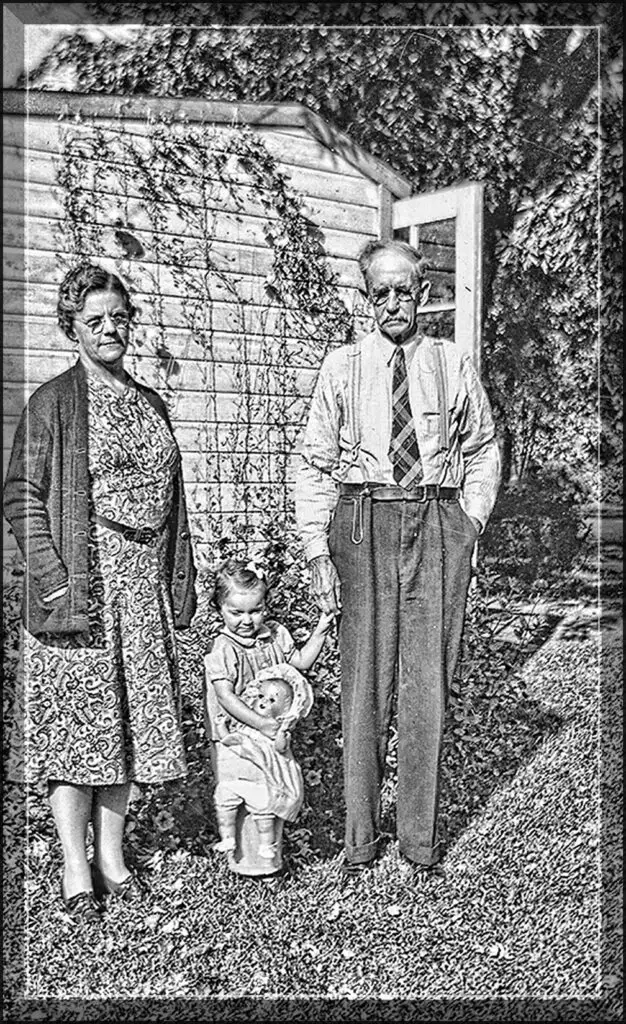
Several years ago, Vermilionite Leslie (Roberts) Ennis was kind enough to allow me to scan this wonderful c.1940 pic of her (when she was but a very little gal) posing with her (then) neighbors Zella English, and Zella’s father John McLaughlin. They were standing by the garage at the back of the First Congregational Church parsonage on Ohio street. (The home that once served as the parsonage is still standing. But I’m not sure the garage still exists.)
Along with many others, I have fond memories of Mrs. English. My father liked her name so much he and my mother christened one of my sisters with it. She was a wonderful person. And her husband – the Reverend Earl T. English was one of the most popular and respected ministers who ever walked the streets of good ol’ Vermilion, O.
I can’t say that I actually knew Mr. McLaughlin. But I certainly remember him. I have a very vivid memory of him working inside the garage behind them in the snapshot. On days that I made a weekly delivery of The Vermilion News to the home I can recall him mowing the lawn at the parsonage with an old push mower.
Mr. John McLaughlin was born in 1860 in Pennsylvania. He and his wife, Margaret, were the parents of four children. Zella was the only girl. John was a blacksmith by trade. For some reason I always knew that about him. I remember seeing him “chinning” with the guys inside Becker’s Blacksmith shop as I zipped past on my bike on my way to Hart’s Drug Store for an ice cream when I was a kid. The smith’s shop sat on Liberty Ave. on part of the land now occupied by the Ritter Library. The doors were always wide open when the shop was working. When he was at work in the parsonage garage repairing / sharpening the lawnmower blades it was reminiscent (out of habit and / or purpose) of Becker’s shop. But, anyway, that’s where and how I remember him in my mind’s eye.
Back in 1927, with the approval of state officials, Vermilion’s Congregational and Methodist Churches had voted to unite. The two churches organized under a Congregational policy. After this merger, a new Methodist pastor was chosen to serve. That was, of course, the Reverend Mr. Earl T. English. At the time he was serving as a faculty member of Heidelberg College in Tiffin.
Reverend English was also a Pennsylvania native. His father, T.W. English, was also a minister. His mother was (like mine) named Ella. He had a brother named Floyd, and a sister named Edna. Early in his marriage to Zella he worked as a teacher in (of all places) Crow Creek, Colorado. After the couple came Vermilion in 1927 Zella also taught school. She possessed a warm and extremely “brilliant” personality.
Mr. McLaughlin, passed into the great beyond in February of 1959 at the tender age of 98 years. Reverend English died in 1974. He was 85. Zella died in 1985 at the age of 93. I am compelled to add that I sincerely appreciate seeing and having a copy of this photograph. I was initially reluctant to share it in fear of possibly dampening all the memories it evokes (for me). I just never want those memories to become mundane and fade. On the other hand, it’s too marvelous a portrait of and from a Vermilion yesteryear not to share.
Ref: Special Thanks to Bud and Leslie Ennis families; Betty Trinter’s History of the Congregational Church.
Vermilion resident Rich Tarrant is Curator of the Vermilion History Museum and a son and a grandson of the late proprietors of The Vermilion News (1897-1964). Readers may email him at: rnt@twc.com
© RNT August 28, 2022

WHEN EVERYBODY KNEW EVERYBODY
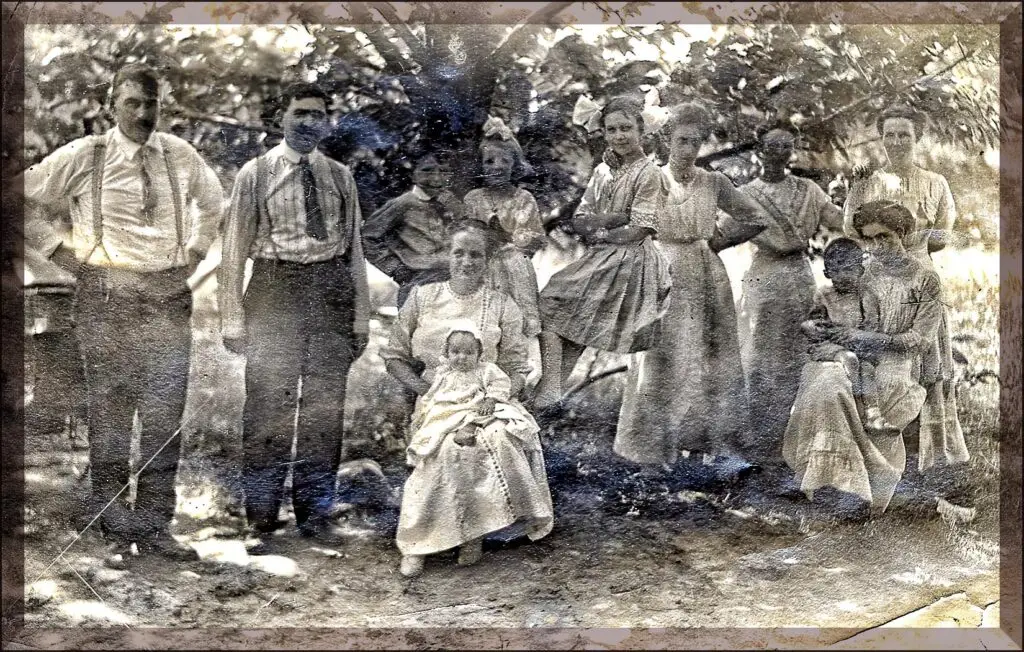
This photograph may be difficult for persons other than myself, or maybe a few others, to fully appreciate. This is partly due to the fact that the town Vermilion in Ohio was for a majority of its 185 years of life a very small town. It was, for at least 120 years a place where everybody knew everybody. And it was only during the summers when persons flocked into town to spend a week or two at Linwood Park or to play for a day at Crystal Beach Amusement Park when familiar faces were outnumbered by the unfamiliar. Such familiarity had good points and bad. Good because it is nice to have friends and family nearby. And bad because it is not always nice to have friends and family nearby. But like it or not – that was yesteryear in Vermilion. When the Ford Motor Company entered the scene in the 1960s that familiarity disappeared.
The photo accompanying this essay was one that puzzled me for a number of years. It puzzled me because it is – and it isn’t – a family photograph. Seven of those pictured are my relatives. The other five faces were unfamiliar to me. However, in this case I was fortunate to discover the names of all those pictured written in longhand on the back of the piece.
Pictured (L-R) are my great uncle Worley Houseman, my grandfather Pearl Roscoe, and my grandmother Bessie Roscoe who is seated with my aunt Alice on her lap. Behind them are Wayne Patton, my mother Ella Roscoe, then my cousin Clara Houseman, Margaret Trinter, Gertrude Patton, my great aunt Ella Houseman, and seated are Jessie Delker with John Trinter on her lap.
So why the photo? After a good deal of time (a few years) I have deduced that this is simply a photograph of a group of friends and neighbors enjoying the summer of 1912. It was likely taken somewhere along Grand Street near The Vermilion News Print Shop where the Roscoe’s made their home.
Jessie Delker (later Windham) lived with her parents, John and Eva, her sister Margaret Trinter and brother-in-law Albert in the home on the northeast corner of Grand and Ohio streets. At the time of this photograph Jessie worked at the News just down the street. It may interest some to know that Delker’s great-granddaughter still owns and lives in that home. The Delker and Trinter families have very deep roots in the history of the town.
Gertrude Patton and her son “Wain” [sic Wayne] were unfamiliar personalities to me. But I did recognize the Patton name from past research. Gertrude was married to H.H. Patton who was at one time the town’s “ice man”. He later went into the fishing business, owning and operating a fish house located in the area where Romp’s Water Port Marina is today.
Anyway, when I discovered that Gertrude’s maiden name was Gertrude Octeda Simons the photo began to make a tad more sense to me. Gertrude was the daughter of Sidney and Frances “Frankie” Minkler-Simons. Sid Simons was for at least 30 years during first quarter of the 20th century one of the town’s premier grocers. He operated a grocery store on the west side of Grand Street where the Railway Barber Shop is today. Many residents will better remember the building as “Bailey’s Hardware” store.
The link between parties here (aside from familial) is, of course, Grand Street. The Delkers, Roscoes, Trinters, and Simons all lived near each other on the same street and obviously befriended and interacted with one another on a regular basis – even without cell phones. It was undoubtedly nice to have good friends and neighbors on the same street. But then there were also the people on streets close by like the Whitmores, Furgasons, Englebrys, Hortons, Rathbuns, Deckers, Bonds, Parsons…ad infinitum. As Charles Dickens might have put it, “It was the best of times, the worst of times…”. But bad or good, it was a time when everybody knew everybody.
Vermilion resident Rich Tarrant is Curator of the Vermilion History Museum and a son and a grandson of the late proprietors of The Vermilion News (1897-1964). Readers may email him at: rnt@twc.com
© RNT August 21, 2022

Busy, Busy Vermilion
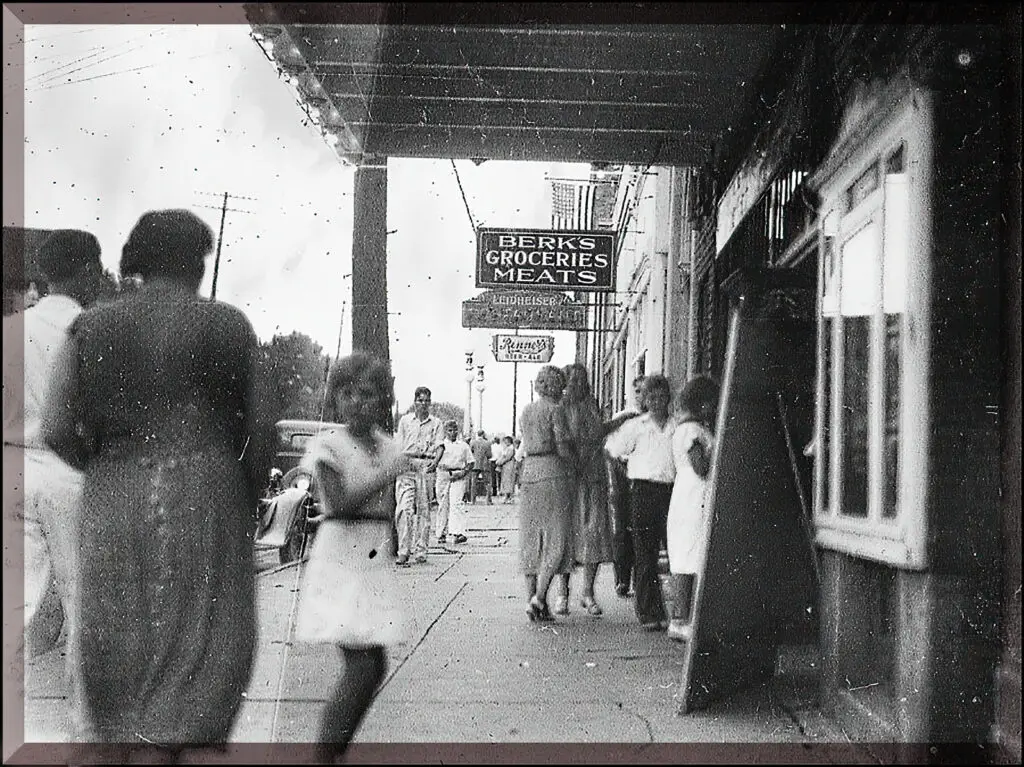
The accompanying photograph predates having my shadow cast across the walks in good ol’ Vermilion Ohio by a few years. But it’s very close to the town I remember roaming when I was a lad. To be a bit more specific it appears to be a Sunday afternoon in the summer of perhaps 1941 or ’42. It was taken along the walk on the south side of Liberty Avenue near the old Liberty (movie) Theatre (currently the Artseen).
The persons gathered to the right foreground in the picture are standing in line beneath the theatre’s marquee to buy tickets to whatever movie was playing that afternoon. The only time the theatre was open afternoons was on Sunday. The rest of the week it only opened in the evenings. This was, of course, before television, so as one might imagine the “picture show” was a very popular place of business. And Vermilion – a town of only about 2000 year-round souls – was very fortunate to have such entertainment available.
You will note without much fanfare, the signs in the upper portion of the photo. Harley “Berk’s Groceries Meats” was the name of the market that had replaced the “C.A. Stevenson” grocery (VPJ (08/11/22). Berk’s was still in business when I was a youngster. Many Vermilionites may remember one of the employees – the meat-cutter, Harvey Krapp. Although he was a rather slight person physically, he had considerable personality.
The sign just beyond Berk’s is that of the “Leidheiser Restaurant” (currently the Route 6 Pub). Leidheiser’s was a well-known eatery serving first-class dinners. You will also note that they served Renner’s Beer. Renner’s was a beer brewed in Akron by the George J. Renner Brewing Company. Renner’s was considered to be “Ohio’s longest lasting brewery” (1862-1952).
Further on down the street there are two tall light poles with globe-type fixtures toward the top. Those lights were on the street in front of the Okagi Restaurant. Those standing on the walk below the lights were waiting in line to get a table. To say it was a popular eatery is an understatement. Oddly enough, Okagi’s was a Japanese restaurant in name only.
While Mr. Okagi (Mamoru) was Japanese and his wife, Marie, was French the restaurant fare was purely American and was most often served “family-style”. This concept has, by and large, been discarded by American eating places today. For those unfamiliar with the technique, food was served on large platters and shared by family and friends as opposed to serving food on individual plates. This was not, however, without some rather odd and surreptitious panache on the part of Mrs. Okagi.
[NOTE: My sister, Nancy Tarrant-Emery, who worked for Okagi in the 50s told me that Mrs. Okagi would often stand by the door between the kitchen and the dining room. When the servers brought out a bowl of mashed potatoes, she’d touch the top of them with a knuckle to make sure they were hot.]
I developed this photograph from a glass negative some time ago. And while some quality is lacking, I really like it. The little girl in the light dress (left foreground) looks very much like my sister Nancy when she was around ten years old. And the man and woman with their backs to the camera on the left resemble my mother and father. If this is true, I suspect that several of my brothers were nearby. The picture was taken from the sidewalk in front of my grandmother’s store (the News Gift Shop) that was next to (just west of) the movie house. The boys had no doubt easily coaxed my grandfather into letting them take this photo with his camera before joining the family as they purchased tickets to the movie. It was a busy, busy day in Vermilion.
Vermilion resident Rich Tarrant is Curator of the Vermilion History Museum and a son and a grandson of the late proprietors of The Vermilion News (1897-1964). Readers may email him at: rnt@twc.com
© RNT August 14, 2022

FOREVER SEARCHING
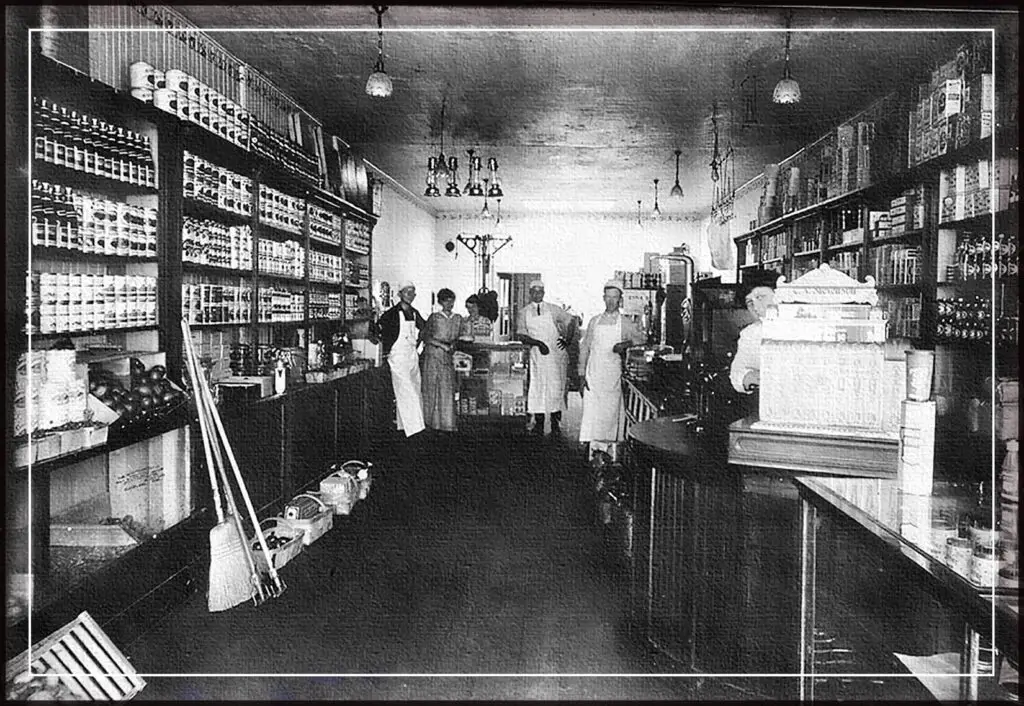
On October 30, 2010 I wrote the following blip about the accompanying photograph: “Obviously, this is not a painting. But it’s a very nice portrait (derived from a glass negative) of one of Vermilion’s old superstores. Currently it’s a puzzle for me to decipher. I don’t know the who, where’s, or what’s of it. All I know is that the name C.A. Stevenson is on the cash register and a sign near the back of the store advertises lake and river excursions on the “Edna B” from the Crystal Beach Amusement Park (now the site of the Crystal Shores Apartments) shoreline.
I’ve not had a great deal of luck discovering the identity of C.A. Stevenson (yet). I have found some info on a person named Clarence A. Stevenson whose father, Murray, was a Vermilion blacksmith, and another fella named Stephen G. Stevenson who had a barbershop on Grand Street. But beyond that I’ve been unable to rustle up and more “stuff”.
I’m thinking that as I slowly peruse the old microfilm files of The Vermilion News, I’ll probably find something. I’ve got a lot of questions about a number of things concerning the photo. Hopefully I won’t run out of time before they can be answered.”
Well, twelve years passed, and I was still stumbling around in the dark until last Monday (08/01/22) when I was transcribing some info from The Vermilion News of August 6, 1914, and I came across the following article about a “New Grocery Store”.
“C.A. Stevenson will open a grocery in the Baumhart building just east of the Bank of Vermilion as soon as the building can be refinished. The carpenters are busy this week putting in a new front and making other necessary changes.
Mr. Stevenson has been a resident of Vermilion for a number of years and has been in the grocery business as clerk for some time past for Unser & Seely. The store will be opened within the next two weeks.”
It was one of those “Aha!” moments for me. According to the article the store was in the shop next to (east of) the building currently known as the “Wine Vault” in beautiful downtown Vermilion. This information began to bring things into focus for me because years later Vermilionite Harley Berk operated a grocery store in the same shop. When Berk retired Vermilion grocer Harold Moats operated a grocery store in the that building.
C.A. Stevenson was Clarence Andrew the oldest child of Murray and Inez Stevenson. He was born in Clarksfield Ohio in 1894. As a youngster Clarence helped clean stables at Lewis Decker’s Livery Stables (then located where the Ritter Library was later constructed). Later, as mentioned in the News article, he worked as a clerk for Unser & Seely – a general store that occupied the southwest corner of Liberty and Division / Main streets in the area where the Erie County Bank was built, and the city offices are currently (2022) located.
I don’t know (yet) if Stevenson’s Grocery was successful or not. But by the time he registered for the draft in 1917 he had married and left that business and was working as a fireman for the New York Central Railroad out of Toledo. He was working as a locomotive engineer when he died in 1942 at the rather young age of 48 years.
Well, this certainly is an interesting photograph. There are a thousand things to look at and (for me at least) to wonder about. But now I believe I’m at least one step closer to having the many questions I have about the store and C.A. Stevenson answered. Hopefully, it won’t take another twelve years to find all of them. I am forever searching.
Vermilion resident Rich Tarrant is Curator of the Vermilion History Museum and a son and a grandson of the late proprietors of The Vermilion News (1897-1964). Readers may email him at: rnt@twc.com
© RNT August 7, 2022

THE PLACE I LOVE
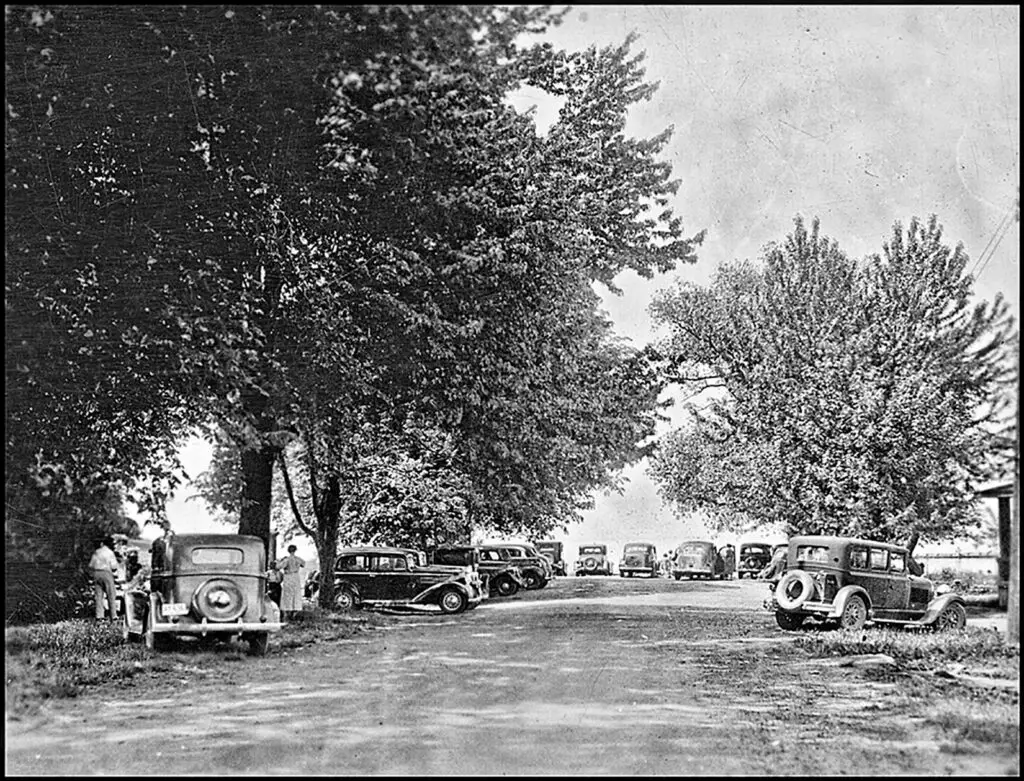
One would hope that everyone (or nearly everyone) familiar with the place known as Vermilion, Ohio is able to recognize the site of the snapshot subject of this week’s essay. I would not call it the heart of the town today; but it may have been the place – or very close to the place – where it all started when William Haddy (sometimes spelled Hardy) built his cabin way back in 1809. It is, of course, Main Street near the beach.
This photo was taken back in the 1930s during the era better known in history as “The Great Depression”. At the height of this worldwide economic disaster nearly 25% of Americans were jobless helping to create careers for folks of the ilk of John Dillinger, Bonnie Parker, Clyde Barrow, and George Francis Barnes Jr. (aka “Machine Gun” Kelly). But it was also the “Golden Age of Baseball” producing athletes like George Herman “Babe” Ruth Jr., Lou Gehrig, and Joe DiMaggio. (By the way a young fella by the name of Ron Reagan was the official radio announcer for the Chicago Cubs, 1933-36). At Vermilion’s Crystal Gardens folks were “boogying” to music played by the Glenn Miller, the Dorsey brothers, Duke Ellington, Benny Goodman bands, and others. And on warm summer afternoons families jockeyed for places to park their vehicles down at Main Street Beach.
During this era the street had yet to be paved. But it was, as it appears, frequently frequented. The clay surface was as hard as a rock. And the large trees provided some respite for those seeking lake breezes out of the heat of the sun. Though I doubt that many or any persons violated the privacy of Vermilionite F.W. Wakefield’s Harborview home property that overlooked this scene (on the left), they certainly took up all the parking spaces in front of it. That was perhaps the price Mr. Wakefield had to pay for having built his home on such a beautiful site.
Oddly enough this was hardly the best beach in Vermilion. It’s small as beaches go and parking (as is obvious) was and remains a problem to some extent. But the lake here is perfect for bathing. In most other places the bottoms are either rocky and / or they drop-off quickly from the shore. But in this particular spot the depth is gradual and sandy. It’s always been a fine place for younger children to wade and learn to swim. But more than any of those things – the view is spectacular night and day. (Ergo, the reason Mr. Wakefield acquired the property and built his home.)
When I was a young person, I spent a good deal of time on this beach. It was there I learned to swim. I also liked to go there all year round just to sit and watch the lake free or frozen, night or day. It was just a very pleasant place to be. If I knew a storm was coming (usually from the northwest) I’d hustle down to the beach to watch it sweep across the lake pushing all sorts of boats toward the harbor – some just barely making it home. And there was nothing more thrilling then to be on the beach when a storm in all its terrible fury began to lash the beach with the waters of Lake Erie. Sometimes the waves were so furious they would sweep across the beach – submerging it in foam – actually touching the road where cars were often parked with fellow spectators inside. I would walk home soaking wet but elated by the raw beauty of what I’d witnessed.
I don’t go there anymore. The place, like most places, has changed too much since that yesteryear in the snapshot (as well as the one I knew). To paraphrase a philosophy of some American Indian tribes, “It’s a mistake to habituate a place so much that the natural environment is made to suffer.” Years later I would write a poem with the first line: “The Place I Love is where I am not always…” reflecting that philosophy in honor of Vermilion’s beautiful Main Street Beach.
Ref: VNPSM photo archives; VPJ, 05/07/2015; Rev. 08/02/22
Vermilion resident Rich Tarrant is Curator of the Vermilion History Museum and a son and a grandson of the late proprietors of The Vermilion News (1897-1964). Readers may email him at: rnt@twc.com
© RN8/1/2022

Never Say “Never”
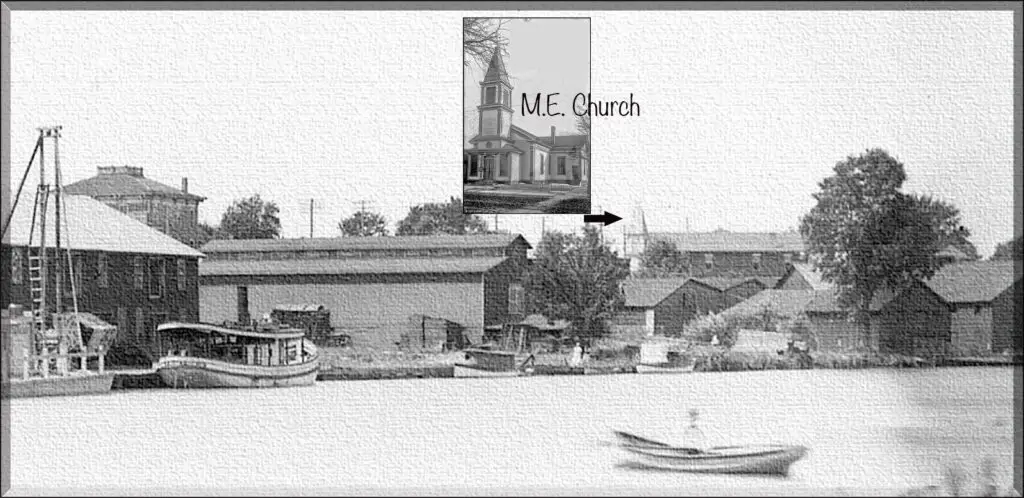
One Memorial Day as I stood on the edge of Exchange Place / “Rubberneck” Park in beautiful downtown Vermilion observing the early services for and by veterans I couldn’t help but wonder what that place might be like 100 years hence. It is said that American poet Walt Whitman (1819 – 1892) was aghast when various cemeteries in and around New York City where Revolutionary war veterans had been interred were uprooted to accommodate the building of that city. Although I mean not to suggest that Exchange Park might someday meet a similar fate, I do have a very politic / practical view of life now: Never say “Never”.
When my grandfather stood on the northeast bank of the Vermilion River and captured this extremely bucolic scene (C. 1906) on a glass plate inside his camera (perhaps a Tourcraft made by a. T. Underwood Co. c.1897) it is unlikely that he ever dreamed of a time when much of what he saw before him would disappear. And though it took some time it did..
The steeple so prominent in the background is that of the Methodist-Episcopal Church (inset) that graced the southeast corner of Liberty Avenue and Grand Streets. Although it had once been both an extremely active and prosperous church, after experiencing a significant decline in membership its congregation merged with Vermilion’s First Congregational Church in 1927, and the building was abandoned. Several years later, while providing space for the Taylor Plumbing and Heating Company, the landmark structure was destroyed in a dramatic nighttime fire. Afterwards, the land was occupied by a Standard Oil facility, and finally Glenn Fulper’s service station / auto parts store. Currently visitors to town only know it, and the adjoining properties that had over the years provided space for several restaurants and various other shops and businesses – as a car park.
The large building visible just above the idyllic Kishman barns is perhaps among the very few buildings in this photo still standing intact. Built by Gaylord and Merrill in 1870 the building has housed many businesses through the years including the Post Office, Davis Brothers Dry Goods, the Goodsell Company, the Wagner shoe shop, and the Miller saloon. Many older Vermilionites knew it as the home of the much beloved (Jim) Hart’s Corner Drugstore followed by Higgins Pharmacy. Today of course, it is the home of the wonderful Main Street Soda Grill.
And then there is the rustic Kishman Fishery. It was from here that the event folks have come to know as the Vermilion Festival of the Fish was very literally spawned during the late 1960s. The event was designed to bolster commerce throughout the community (and did), but it, unfortunately, did not help save commercial fishing.
Though Lake Erie had historically proven to be the most productive of all the Great Lakes (e. g. 62,000,000 pounds harvested in 1935 and 1956) exploitation of the most desirable and valuable species of fish married to the habitat deterioration over the years led to a drop in those populations and moved fisheries to focus on less desirable species. In addition to this, government controls / interference (however one chooses to view it) over the industry in Ohio eventually led to the complete extinction of Vermilion’s commercial fishing industry.
Consequently, the Kishman Fish Houses, the old tugs, the nets, and the fishermen all disappeared. It seemed to happen so fast – in a blink of the eye. And all that remains are some pretty condos along the river, some meticulous oil paintings, some photographs (like this one), and an annual festival to remind us of the way things once were, are not now, and never will be again. So, never say “Never”.
Ref: Vermillion Area Archival Society. Oral transcription made on 06/26/09 at the Olympic Outing Club. VPJ 06/15/06; Rev. 07/24/22.
Vermilion resident Rich Tarrant is Curator of the Vermilion History Museum and a son and a grandson of the late proprietors of The Vermilion News (1897-1964). Readers may email him at: rnt@twc.com
© RNTJuly 24, 2022

The Great Propeller at Main Street
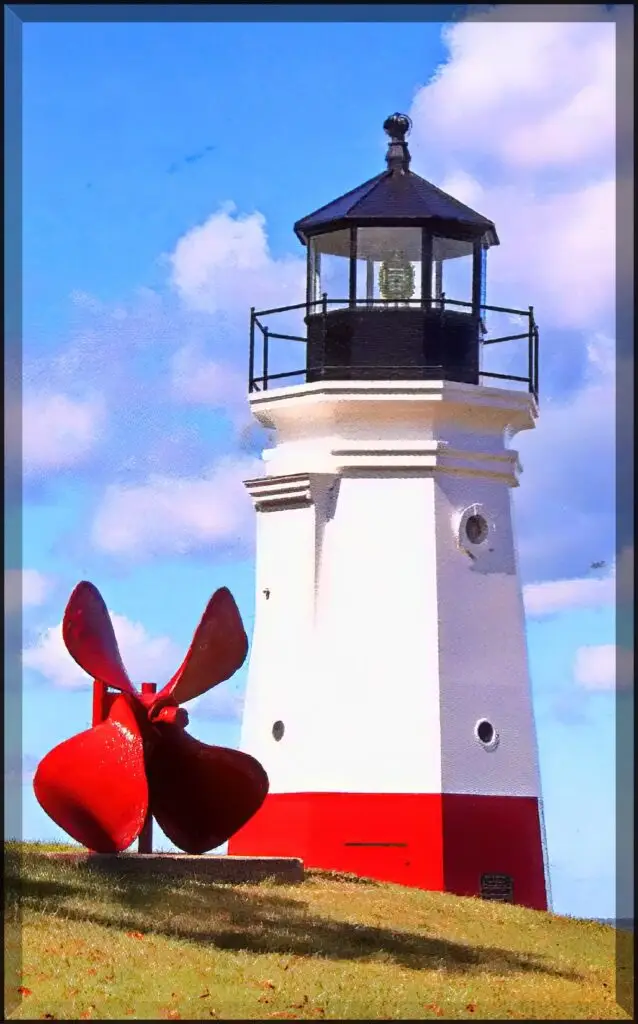
This is a story about a propeller – a big one. It’s over 7 feet tall and weighs between 4 – 6 tons. It’s the one that now rests in the lawn near the Vermilion Lighthouse replica on the hill above Main Street Beach. No small part of the problem I had with this particular story is that I’m not a boat person. No matter that I’ve lived in Vermilion (“The Village of Lake Captains”) for a majority of my years on the planet. A sailor nor marine aficionado I ain’t. While my wife and I once owned a nice vessel – like a number of people, one of the happiest days of the entire experience was the day we became former boat owners. But back to the prop story.
Recently Vermilionites Terry and Ellen Ohara visited me asking what I know about the aforementioned propeller. My answer to their inquiry was (surprise, surprise!) “nothing”. But as an old Pepsi-Cola truck driver once told me, “I know what I know. You know what you know. But I won’t know what you know until you tell me.” So, they did.
The gist, of what they told me is simple. The propeller was found by Ellen’s father, Allan Koachway, back in the early 1960s. I really and truly cannot tell you much more about his discovery at this time – except that he and his brother-in-law (another well-known Vermilionite of the yesteryear named Henry “Hank” Fischer) acquired a wrecker and brought it to town from Lorain. For over 30 years Mr. Koachway worked as a licensed marine engineer on tugboats owned by The Great Lakes Towing Company. This company, by the way, operates the largest and most experienced U.S. – flag tugboat fleet on North America’s Great Lakes and Saint Lawrence Seaway marine transportation network. In this capacity Mr. Koachway, likely did a good deal of work on the lakes as well as on the Black River in nearby Lorain. And it was my initial understanding that it was from that area (i.e., the Black River) that the great anchor was recovered.
In searching for more information about this particular object I found there wasn’t much available. In many places it was referred to as a tugboat propeller. And while it seemed a tad too big to be from a tug my limited knowledge of maritime things certainly didn’t help me deny or substantiate that idea. While it’s not impossible to find information about marine propellers it is a bit more difficult to find any material about large props made of cast iron like the one in question. Interestingly enough the most comparable prop I found was from the wreck of the cargo steamship Indiana that shivered her final timbers (that’s marine-speak of course) on Lake Superior back in 1858. Ironically (at least to me) is the fact that the Indiana was built in Vermilion in 1848 and first captained by Vermilion’s Alva Bradley. The Indiana prop, incidentally, is currently on display at the Smithsonian.
Anyway, I eventually came across a June 2, 1962, article in the Sandusky Register featuring Vermilion’s former Marine Museum. It was when Captain Inches curated the institution. With the article is a photo of the Vermilion prop stating that it was [probably] from a Great Lakes lumber steamer “authentic…and presumed to be over 100 years old”. It also stated that it was recovered from the Black River in Lorain “by the historical society”. (That would be Al Koachway and Hank Fischer.) Consequently, claims about the prop being from a tug were about to be – as even a novice mariner might allowed put it “deep-sixed”.
I find this information to be credible (because the reporter likely acquired it from Cap. Inches). But to further substantiate the information I thought I should also ask about it from someone with a good deal of knowledge of marine things. Consequently, I contacted a local marina owner Don Parsons for further clarification. He agreed that it had likely come from an old lake steamship.
Unfortunately, a detailed – a more specific – provenance of the Great Propeller on the Hill above Main Street is and will likely always be, unknown. But we do know that it didn’t just fall out of the sky and land where it sits today. We now know what it is, where it was found and who brought it here, and why. To be sure visitors to Vermilion would also like to know those things. So, as my old Pepsi driver friend might put it, “You know what you know. I know what I know. But nobody will know what we know unless we tell them.” On the other hand, a simple plaque would probably suffice.
Vermilion resident Rich Tarrant is Curator of the Vermilion History Museum and a son and a grandson of the late proprietors of The Vermilion News (1897-1964). Readers may email him at: rnt@twc.com
© RNT July 17, 2022

They Just Called Him “J.I.”
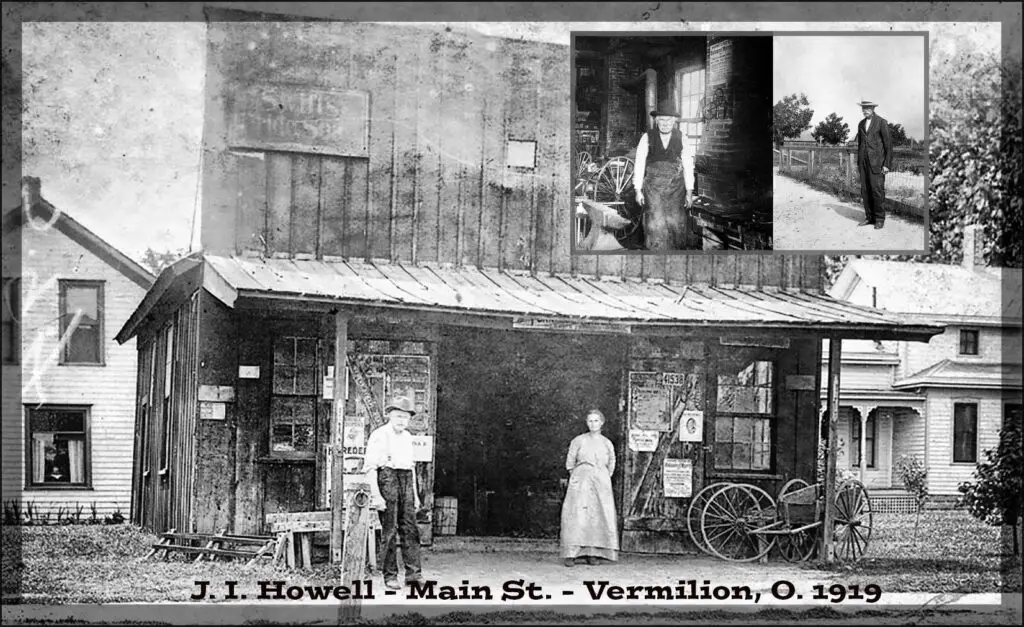
Even without a name the initial story about him would be interesting enough. He was born in Calhan, Georgia about 1841 or ‘42. His parents, by some accounts, were North Carolinians. On the twenty-second day of March in the year 1862 – nearly one year after the start of the American Civil War – he enlisted in the Confederate Army as a Private and became an infantry soldier in Georgia’s 51st Regiment.
Over the next three years the regiment participated in nearly 40 engagements in Virginia, Maryland, Tennessee, and Georgia. He was a young man of about 20 years when the war began. When it was done, he was very likely twice or even thrice that.
As the story is told there came a time in his life when he realized that part of what he was asked to fight for was a thing called slavery. It was not, to say the very least, a concept he eagerly embraced. Consequently, by the end of the war he had abandoned the south.
By 1880 he was living on South Washington Street in Sandusky, Ohio with his wife Sarah, and their five children; Willie, Daniel, Henry, George, and Jessie, where he worked as a blacksmith. During the years which followed the hardworking smithy and his family moved to Birmingham (1888) and then, by 1890, on to a shop in the Village of Vermilion, Ohio. But wherever they went misfortune seemed to follow. Sarah died in 1898 and sometime during those same years three of their youngsters also died.
The shop in Vermilion was located on the west side of Main Street just south of Ferry Street. It was torn down in September of 1931 by Anna Leidheiser – the widow of Captain Henry Leidheiser. Currently a tiny house – where the Leidheiser daughter-in-law Frances / “Billie” lived for years – still occupies the site. But prior to that, the shop had served as a smithery for men with unassuming names such as Jim Miles, Henry Baldwin, Christ Ott, and then, of course, the subject of this essay; and later his son George.
In about the year 1920 with his health beginning to decline he sold the shop, and briefly returned to Georgia to visit the scenes of his youth. By 1923 he had returned to town and made his home with his son George who had since left smithing and gone to work for the railroad. And then, “Shortly after two o’clock” on the morning of October 25, 1923, as the Vermilion News report put it, “…one of Vermilion’s oldest and best-known citizens died…”.
It’s hard to say if anyone about town knew him by his first name. This may be, in part, because it’s unlikely that anyone really knew what it was. And those who search for information about him using U.S. Census data will quickly discover the reason.
The U.S. Civil War Soldier Records have him listed as Jarrett and Jariot in several places. And U.S. Census Records from 1880, 1900, and 1910 have him listed as John, Jared, and Jeriot respectively. The only things that any of these records have in common are his birthplace, the approximate year of his birth, the first names of members of his immediate family, and his middle initial.
Well, as Bill Shakespeare’s so aptly put it in Romeo and Juliet, “”What’s in a name? That which we call a rose / By any other name would smell as sweet.” That is, to be sure, very true. In this case it’d probably be safe to bet that most folks in the yesteryear just called this rose “J.I.”.
Ref: The Vermilion News, 10/25/23 and 9/24/31; Ancestry.com; Special Thanks to: Larry E. Howell; VPJ; 3/18/10; Rev. 06/12/22.
Vermilion resident Rich Tarrant is Curator of the Vermilion History Museum and a son and a grandson of the late proprietors of The Vermilion News (1897-1964). Readers may email him at: rnt@twc.com
© RNT June 12, 2022
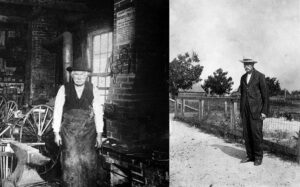
American Song & Drum Tale
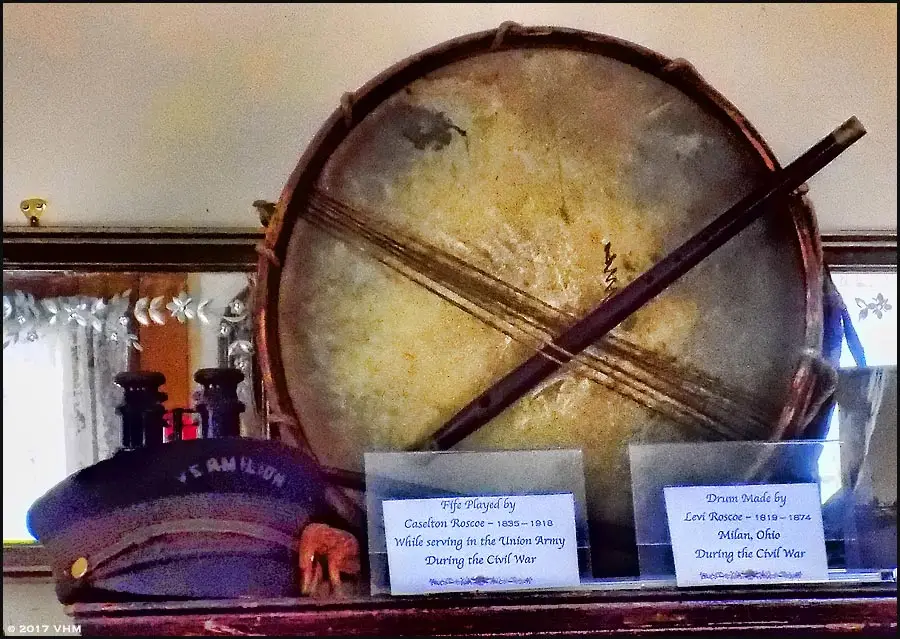
Back in the early years of the 20th century the media in our nation always referred to July 4th as “The Glorious Fourth”. The term disappeared some time ago in a flurry of sales promos for furniture, automobiles, and fireworks. Our National Anthem, “The Star-Spangled Banner” as some may know was formally adopted to be our national anthem on March 4, 1931. The lyrics were written by a 35-year-old lawyer named Francis Scott Key after witnessing the bombardment of Fort McHenry in Maryland by the British during the War of 1812. The tune was from a popular British song called “To Anacreon in Heaven” written by an English composer named John Stafford Smith for the Anacreontic Society a male social club in London England. The Greek poet Anacreon was renowned for his drinking songs and odes to love. While the poem / song has four stanzas, only the first is commonly sung. To be candid, I doubt that more than a handful of people (anywhere) can recite all four stanzas with any accuracy let alone sing them.
Before it was officially adopted as our national song several others were considered: “Hail Columbia”, “My Country ‘Tis of Thee”, and “America the Beautiful” were contenders for the anthem. Of them I believe the last – a poem by Katherine Lee Bates (with lyrics amended in 1911) and music by church organist / choir master Samuel E. Ward was (and remains) the best. But, again, that’s just my opinion. The words do seem however to accurately celebrate my view of our country as well as, perhaps, my ancestors both saw and lived it. “America! America! / God shed His grace on thee / And crown thy good with brotherhood / From sea to shining sea!”
In the autumn of 1635, my ancestors arrived in Boston Harbor from England on a ship named “Increase” captained by one Robert Lea. One hundred years earlier, as Huguenots, they had fled France for England. They eventually left England because their beliefs and practices had been in growing opposition to the faith and rituals used by the Church of England. After arriving in Boston, they went on to be among the first 50 settlers of Cambridge Massachusetts as well as one of the founding families the Massachusetts Bay Colony. Moving on they helped found Hartford Connecticut, then Norwalk and New Canaan where they lived for over 125 years, then on to Poultney Vermont and to Elizabethtown in Essex County in New York. “O beautiful for pilgrim feet, / Whose stern, impassioned stress / A thoroughfare for freedom beat / Across the wilderness
My g-g-grandfather, Levi Roscoe was born in Essex County, New York in 1810. In 1832 he married a girl named Eliza Stockwell in a small town called Lewis N.Y. Two years later they came west to Ohio on canal boat to Buffalo and then by boat to Huron, moving on to Townsend Center where my g-grandfather, Caselton, was born in 1835. Soon after his birth the family purchased a 125-acre farm in North Milan. Eventually the couple had nine children. One, a little girl they named, Emma, died when just a bit over one year of age. “O beautiful for patriot dream / That sees beyond the years / Thine alabaster cities gleam / Undimmed by human tears!”
In 1861 when the War between the states began four sons left to fight for their country. Their father, Levi, who followed the trade of carpenter and millwright, also did some cooper work. During the war he made drums for the boys. One had a head three feet across. He called it the “Union”. He sold three of the smaller drums to a nephew for nineteen dollars. Two drums, a base drum, and a snare drum remained with the family. “O beautiful for heroes proved / In liberating strife, / Who more than self their country loved / And mercy more than life!”
A decade ago, while cleaning a closet at the Vermilion History Museum I came across a dusty old garbage bag. Inside was a present from my g-g-grandfather – the snare drum he made during the Civil War. All four of his sons had survived the war. And somehow the drum had also survived. “America! America! / May God thy gold refine, / Till all success be nobleness, / And every gain divine!”
Vermilion resident Rich Tarrant is Curator of the Vermilion History Museum and a son and a grandson of the late proprietors of The Vermilion News (1897-1964). Readers may email him at: rnt@twc.com

Old News Is (Great) Fun News
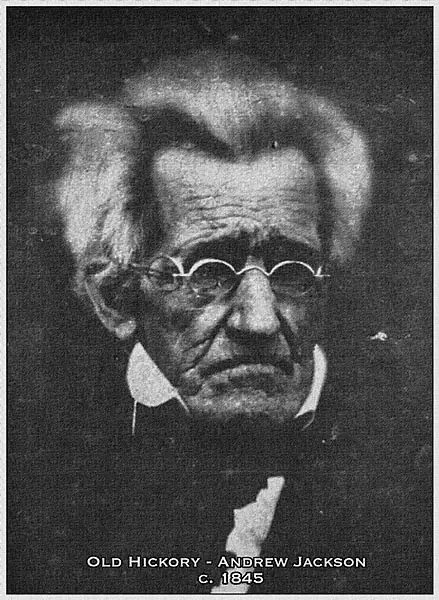
Old news is good news. Or if it’s not it’s fun news. For many years I’ve been working my way very slowly through the microfilm files of our town’s former weekly The Vermilion News (1897 – 1964) acquainting (as well as amusing and entertaining) myself with the news of our community from those yesterdays. Thus far I’ve only traveled as far as the early months of 1914. And I seriously doubt that I’ll ever reach the year 1964 – the year the tabloid was put to bed, before I follow in the path of our ancestors. But no matter, I learn something new about our past every day and have some fun along the way. What follows is but one of the items I have stumbled across while on my journey.
An article that appeared in the February 15 1905 edition of the paper that I found exceptionally enthralling was a report of the marriage of one Samuel Kuhns and Sarah Jackson at Penfield (just east of Wellington). Ordinarily a wedding notice wouldn’t be of any great interest to a wide audience (then or now). But this one was different because Samuel was allegedly 101 years old, and his blushing bride was allegedly 100. I interject the word “allegedly” because I chased this story for perhaps six hours trying to verify the facts therein without much success.
Sarah claimed to be the daughter of President Andrew Jackson as well as being a distant relative of Abraham Lincoln. The story was that she lived in the Lincoln home in Springfield, Illinois, and it was there that she met, and fell in love with Samuel, a lawyer who met and befriended Lincoln in the courts sometime before the American Civil War. Both Kuhns and Jackson were by that time middle-aged citizens. They courted and were to be married, but Sam went off to the war telling her (according to the report) before he left, “If we were boy and girl instead of old man, and middle-aged woman, I could not love you half as well as I do. I shall carry your image in my heart through the war. If I am alive when the union is saved, I will come back to you.”
The story goes that he went on to fight at Fredericksburg, Vicksburg, and was with Sherman when he “marched to the sea”. Eventually he said he was incarcerated in Libby Prison at Richmond where he lost contact with his sweetie. In the meantime, she assumed he had been killed and married a man named Samuel Crawford.
Following Kuhns released from Libby Prison he discovered that Sarah had married, and the heartsick suitor wandered the country for some time finally settling in Columbus, Ohio to practice law. Then toward the end of 1905 by what was apparently an act of providence he and the widow Sarah Crawford discover one another at a reunion of army veterans leading to their marriage at Penfield Ohio. Ergo, the love story
What a wonderful story. Moreover, it was just in time for Valentine’s Day that (coincidentally of course) just happened to be the day before it appeared in The News, and the day after it appeared in the (Elyria, Ohio) Reporter. And it is such a great story why would anyone question its veracity? I certainly didn’t. At least I didn’t until I discovered that President Jackson didn’t have a daughter – lest she was illegitimate and never used the Jackson name publicly until 1906.
Well, the story may very well have been “fudged” some, but it still had a ring of truth to it. I say that because a short blip in the March 8, 1906 edition of the paper reported Mrs. Samuel Kuhns as being seriously ill with pneumonia. How that turned out I have yet to discover. And methinks it’s irrelevant. I know not where Sarah and Samuel really came from, nor where they went, but the story was certainly an entertaining learning experience. I now know more than I needed to know about “Old Hickory” as well as how much I don’t know about the news business in the yesteryear. To be sure the stories are not always verifiable, but they are believable and, more importantly, great fun.
Ref: Published in the VPJ 02/21/14; Revised 06/26/22.
Vermilion resident Rich Tarrant is Curator of the Vermilion History Museum and a son and a grandson of the late proprietors of The Vermilion News (1897-1964). Readers may email him at: rnt@twc.com
RNT June 26, 2022
Light & Hope & Brutal Reality
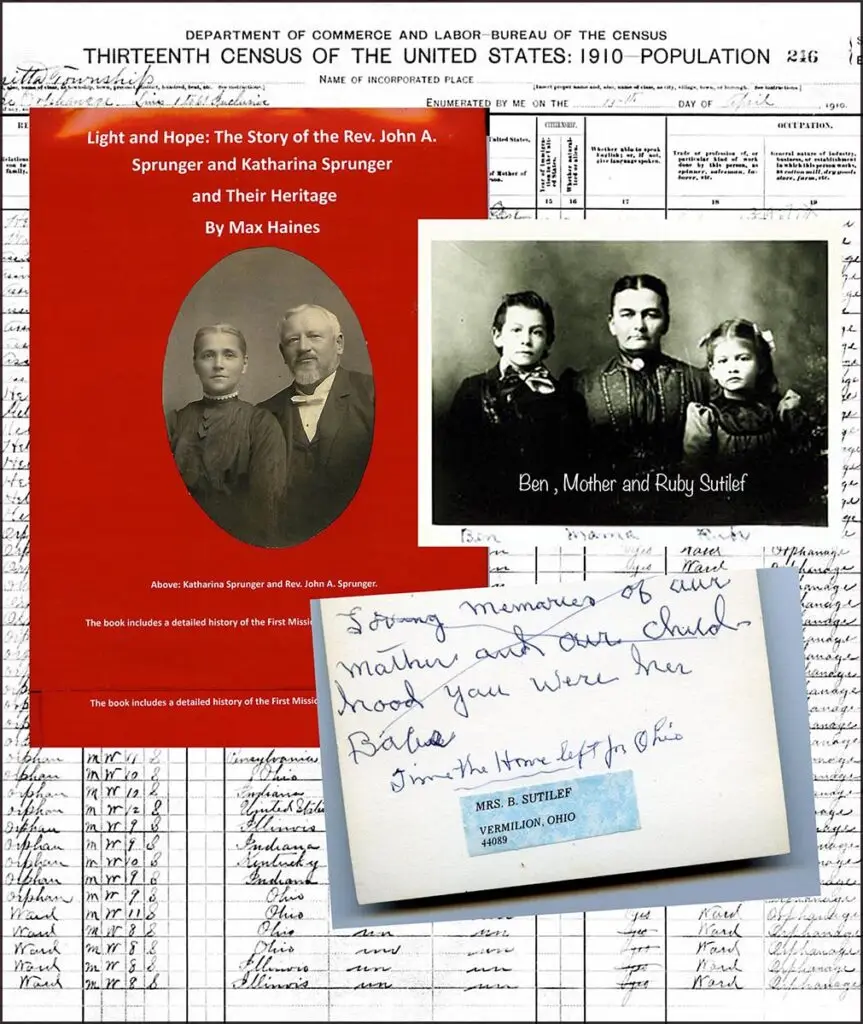
Some time ago, a young lady from the Hayes Presidential Museum and Library in Fremont visited the Vermilion History Museum seeking information about the fabled place many have come to call the “Gore Orphanage”. It seems that she and an associate intend to do a book / story about the “real” orphanage. Well, I certainly hope they do. What follows is some of the information provided.
What’s In A Name: Over the years I have attempted to pass along as much as I know about the orphanage to anyone and everyone searching for information about it. So, to begin with, its formal name was The Light & Hope Orphanage. Established in 1903 it was located on two farms in Brownhelm and Florence Townships along the “Gore” Road. Readers should note that the word “gore” from which the name is derived is defined by Merriam-Webster as “a small usually triangular piece of land / or a tapering or triangular piece (as of cloth in a skirt”. Thus, the name of the road had absolutely nothing to do with the secondary and more gruesome meaning of the word. Precisely when the road began to be known as the “Gore-Orphanage” road is unknown – except it was obviously sometime after 1903 when the orphanage was founded.
Location, Location: During the latter part of the 19th and early 20th centuries families of Swiss descent located in Brownhelm and Florence townships south of Vermilion Ohio. Many names like, Bauman, Baumgartner, Bachman, Gerber, Maurer, Schmidt, Zurcher were common among the Swiss and are still well-known locally. Ergo, it should not be too difficult to imagine why at the turn of the 20th century two persons of Swiss heritage – namely John and Katharina Sprunger – might be drawn to this area to establish their orphanage.
The Proprietors: One of the things that need be understood right from the “get-go” is that most, if not all, the stuff that’s been said and/or written about the orphanage over the years is pure nonsense. (i.e., The folks that ran the place were not Monsters, the children were not abused, and a fire did not kill any of them.) Orphanage director Rev. J.A. Sprunger – known as “Pa”- by all the children at the orphanage was born in 1852 in Bern, Switzerland and died (age 59) at the orphanage in 1911 after having suffered from the effects of a series of strokes that had plagued him since 1907. His co-director wife, Katharina, who the children called “Ma” Sprunger was born in 1859 at Bern, Indiana and died there in 1931. Their adopted daughter, Helen, who was born in Chicago in 1899, died in Adams County, Illinois in 1973.
Sprungers’ Natural Children: The Sprunger’s had 4 natural children in addition to their adopted daughter. Two children died shortly after their births. Another lived for only one year. A daughter they named Hillegonda, died at the age of 7 (in 1887) when the couple still lived in Indiana. None of their natural children ever lived in Ohio.
When the couple moved to Birmingham Hillegonda’s remains were brought here and buried at their compound garden behind the carriage house / chapel. After Rev. Sprunger’s death, and Mrs. Sprunger returned to Indiana Hillegonda’s remains were removed and reinterred in the MRE cemetery in Bern. While this may seem unusual to some persons today – it really wasn’t – nor would it be now.
Not Rosedale: Also take note that the orphanage was not located in the place many locals know as Swift’s Hollow. None of the five or six buildings that comprised the orphanage were in the river valley. The 500-acre farm located in both Brownhelm, and Henrietta Townships did include the old Swift place in the valley called Rosedale, but none of the children lived there. The children were housed in girls and boys dormitories above the valley.
A Fire at the Orphanage: There was, in fact, a fire at the orphanage, but it was not in either one of the children’s dormitories. A fire destroyed the printing plant on Tuesday November 22, 1910. No one was hurt. It was never rebuilt partially because they held no insurance on the building.
One Youngster Did Die: There was, in fact, an accidental death among the children. While coasting / sledding on Saturday February 5, 1910, a 14-year-old boy named Charles Lawhead collided with a wagon, hit his head on the wheel hub, and was killed.
Epilogue of Sorts: It might surprise some persons to know that two of the children that once lived at the orphanage became rather well-known Vermilionites. Frances, born in 1900, was adopted by orphanage teachers Katharine McQuistion and Nellie Griswold. She later married “Jack” Leidheiser co-owner of the Leidheiser Fishery. She worked at Hart’s Corner Drug Store for many years. Most persons knew her as “Billy”. She passed in 1998.
The other person was a fella named Ben Sutlief. Ben born in 1896 in Indiana and came to the area with the Sprungers in 1903 with his younger sister Ruby. He was “the” person most responsible for exposing problems at the orphanage. He left the place in 1908 to live with a Vermilion family, and later served in WW1, married a girl of Swiss descent named Ida Opplinger and worked as a carpenter in Vermilion. He died in 1977.
The orphanage problems exposed by Sutlief were recounted in detail in several Ohio newspapers of 1908. They were very real but, in the end, had little to do with its closure in 1916. In short, however idyllic it might have seemed to the Sprungers, operating a 500-acre farm that would support and educate an orphanage of 70 plus children was simply not feasible. Oh, the light had been there. And the hope had most certainly been there. But so was that ever-present commodity called brutal reality.
Ref: Light and Hope: The Story of the Rev. John A. Sprunger and Katharina Sprunger and Their Heritage, by Rev. Max Haines; The Vermilion News 1908; In Memory of Betty McMillen and Jacqueline Jeffery-Herold.
Vermilion resident Rich Tarrant is Curator of the Vermilion History Museum and a son and a grandson of the late proprietors of The Vermilion News (1897-1964). Readers may email him at: rnt@twc.com
© RNT June 19, 2022

Hallelujah indeed.
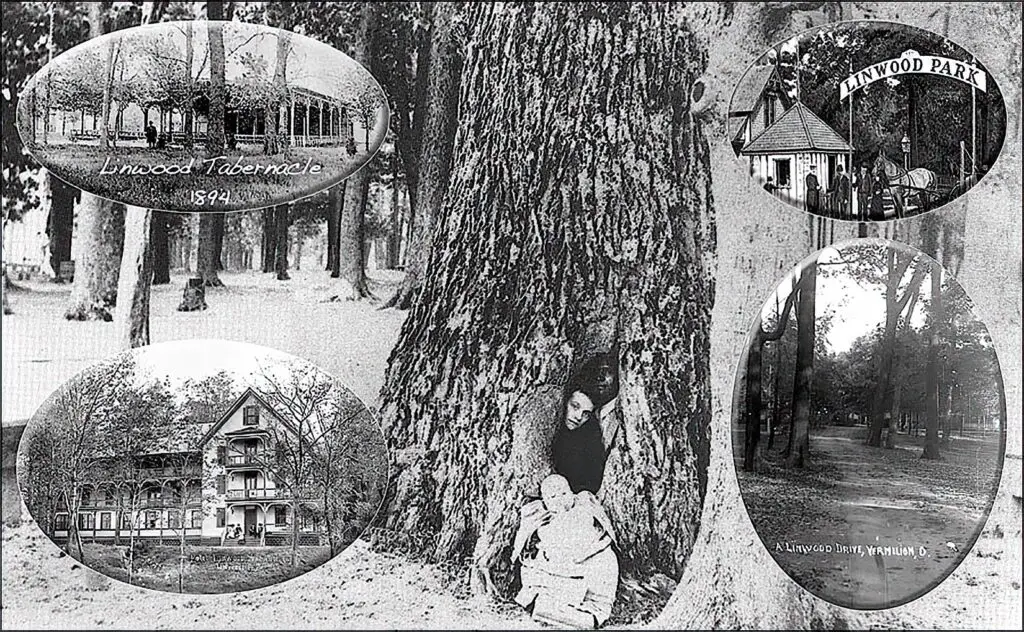
On November 20, 1883 the following telegram appeared in “Der Christliche Botshafter” (translated: The Christian Ambassador) newspaper. It was the first religious newspaper (est. 1836) written in the German language in the United States of America: “Oak Harbor, Ohio November 20, 1883. Rev Wm. Horn! Linwood Grove has been purchased for $11,000. Hallelujah. Thanks be unto the Lord! C. Gahn.”
Hallelujah again. By March 31, 1884, the mortgage was signed, the deed transferred, and the place known as Linwood Park in Vermilion, Ohio was “officially” born.
It might interest some to know that the committee, elected by the Ohio Conference of the Evangelical Church to locate a new site to replace their “Haley’s Farm” Campground near Huron, Ohio, had also been offered a property owned by William Kolbe of Lorain, Ohio. It was just four miles west of that city. It is currently known as Beaver Park.
The origin of the name – “Linwood” – is somewhat elusive. Karen Boas in her book “Through These Gates” (1984) suggests that the name may have been derived from an abundance of Linden trees once found in the area. But whatever the case, the name apparently existed years before the Evangelical Church purchased the property.
The tree that came to be known as the “Linwood Tree” was estimated to be five centuries old by the time park officials found it necessary to have it removed. By that time, it towered at least 85 feet over the park, and had a circumference of eight feet. The great tree had to be felled because many of its upper branches had weakened, and a substantial area at its base had become hollow. In the accompanying photograph Linwood denizens Louise and Otto Goetz peer out from inside the tree whilst baby Esther Goetz (Shanks) patiently poses for this, often copied and published, Linwood family portrait.
Early in the 19th century when Almon Ruggles, the Connecticut man who surveyed the “Fire Sufferers Lands”, (this includes Erie and parts of Huron and Ottawa County) determined the position of the northeast corner of the region it is said that he carved his initials in the bark of a nearby tree to mark that location. Later, after discovering his original calculations to be in error, he repeated the survey pushing the line 2 miles further to the east of the original locale. That line would later be used to separate Erie and Lorain Counties in Vermilion. In addition, it also means that the tree in which he carved his initials probably stood near the Lake Erie shore in the place known as Linwood. Legend has it that those initials were carved in the bark of the great “Linwood Tree”.
Whilst the veracity of that legend is impossible to know – it is equally impossible to refute. But fact or fiction – it is an extremely charming story. And as the “whole story” of Linwood Park unfolded the great tree quietly watched.
On Sunday August 31, 1884 when the tabernacle (pictured upper left) was dedicated 2,000 people had to stand outside because it was filled to capacity. In 1886 a three-story hotel was built with 20 furnished rooms on the first and second floors. In 1895 an addition was added after moving the original a short distance to the north and west possibly to avoid a premature felling of the nearby “Linwood Tree”. The hotel was, as is obvious by the lower left inset photo, a very remarkable structure. And although the entrance to the park has changed a number of times during the last 125 years (inset upper right) it is still recognizable to passers-by familiar to the area.
To be sure, much has changed during the years. People have come, and people have passed along. The tabernacle is no more an open-air facility. The hotel fell out of favor and eventually yielded to the wrecking ball. The front gate, as already mentioned, has been razed and rebuilt several times. And, of course, the “Linwood Tree” no longer watches over the ebb and flow of life in the park as time passes. But when one walks along its well-worn paths clothed in the verdant shadows of the tall trees – time has a way of being set aside. That is perhaps the real magic of Linwood Park.
There are very few persons who have grown-up in our pretty city who are without at least one fond remembrance of Linwood in a yesteryear. It is, has always been, and will forever be, an essential part of coming of age in Vermilion, Ohio.
Hallelujah? Hallelujah indeed.
Ref: Special Thanks to Karen Boas; “Through These Gates” (1984) – reprinted as “Through These Gates And Down The Path: Linwood Park”; “The Evangelical Church in Ohio”; Roy B. Leedy (1959); VHM Archives VPJ 7/31/08; Rev. 06/12/22

© RNT June 12, 2022
1914 Vermilion
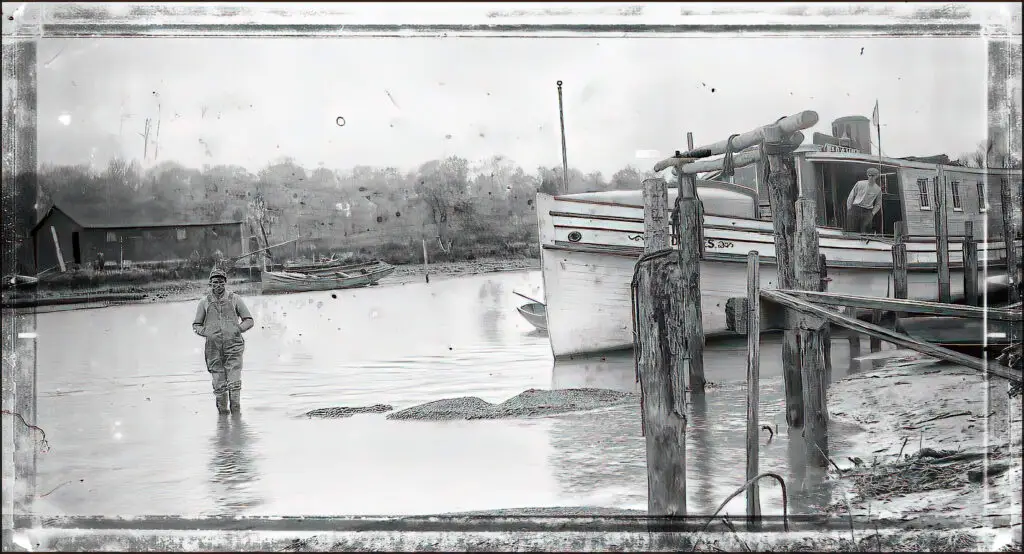
For almost two decades I’ve been transcribing bits and pieces from past issues of the town’s former weekly newspaper, The Vermilion News (1897-1964). Besides reporting the old weekly also had correspondents who covered events in Huron, Berlin Heights, Birmingham, Axtel, Brownhelm and Amherst. Occasionally, there’d be a special report from the dailies in Cleveland, Lorain, and Sandusky. But it was mostly local stuff. Included were reports from regional neighborhoods with names such as Ceylon Junction, Ogontz, Ashmont, Joppa and Strong’s Corners. It’s been fun as well as informative. This year I’ve been immersed in the affairs of 1914.
As is obvious from the accompanying photo the river was a tad low that year. And in late March the Driscoll Fish Company people weren’t very happy about it. A communication from the company was read to the village council stating that the river had become so shallow at their docks that at low water, boats could not be moved. The asked that the council help remedy the condition. The letter also intimated that improvements [to the fish house] were planned but the condition of the river would prevent them being made, and that it might conclude with the dismantling of the plant. After some discussion council moved to have the matter referred to the street committee. At the time here was no harbor committee.
The Village Mayor, F.W. Wakefield, stated that $7,000 had been appropriated for dredging and that he was trying to ascertain how far up the river the government had ever dredged. He asked that anyone who might have definite information in this respect inform the committee or mayor.
The editor of the News responded by writing with a big bold headline: LET’S DO SOMETHING – “There are some who do not realize the importance of our river. The government has appropriated $7000 for dredging purposes and as it is up to the village and abutting property owners to look after the rest of the work. We believe it is about time something was done. The river should be dredged to the wagon bridge to a depth of 10 or 12 feet and the time for the completion of the work would be when the government equipment is here. Why not get busy. Fishing is one of our most important industries and while it is well to look for other industries to locate here, we should endeavor to assist those already here to such an extent as to keep them for our own. We realize it might be cheaper and more economical for an industry to move than to go to a great expense unassisted to remedy some defect in their present location. Here is a job for the chamber of commerce as well as individuals to look into. Let us get busy.” [To their credit they did.]
Speaking of the harbor there was the following carefully worded report from a Cleveland publication about VERMILION’S NEW BOAT CLUB: Possessing one of the cleanest and beautiful little harbors on Lake Erie, the little town of Vermilion, located on the Ohio shore, 35 miles West of Cleveland has at last awakened to its possibilities and a Boat Club has been organized by a little band of enthusiasts. It is called the Vermilion Boat Club. The officers are Commodore, T. J. Ball; vice Commodore, William Showalter; Secretary, A. F. Wakefield; fleet measurer, A. J. Copeland.
Although but few months old, the club boasts a membership of 50 active yachtsmen and a fleet of about 18 power and sailing craft. Vermilion is a well-known fishing port and is located at the mouth of the Vermilion River, which is navigable for large boats for “some little distance” from the harbor mouth. The government maintains piers protecting the entrance with a fixed red light at the outer extremity of the west side of the channel. This harbor is a favorite port of call for passing powerboats and powerboat men, who find it’s quiet hospitality a relief from the old coal harbors so common along the Great Lakes route.
They also noted that the latest addition to the Vermilion fleet was a new 45-foot cruiser, designed and built by the Matthews Boat Company for F. W. Wakefield. Wakefield’s new cruiser was called Lotus 2, and was powered with a four-cylinder, 30 horsepower marine engine. It was to be one of the handsomest and roomiest cruising craft on the lakes.
In the same issue it was reported that the little son of Mr. and Mrs. Clifford Parsons had been very ill the past week suffering from spasmodic croup, but he was considerably better at the time. Their son’s name was Nelson To further elucidate – this was Vermilion’s Rich, Don and Patty’s father.
There was also a report from the Cleveland papers containing the notice of the death of Karl P. Steinbrenner, eldest son of Henry and Sophia Steinbrenner at the family home in that town. It went on to say that the family is well known here. The mother before her marriage was Sophia Minch of Vermilion. They were, FYI, the g-great-grandparents of a prominent American businessman named George Henry Steinbrenner III.
Then, hidden away amongst all these dusty reports from the yesteryear was a simple recipe for pie crust: Three cups flour, 1/2 teaspoon baking powder, one cup lard,1/2 cup cold water. Cut all together with knife. Roll out. Will make 3 crusts. (Please make mine cherry.)
Vermilion resident Rich Tarrant is Curator of the Vermilion History Museum and a son and a grandson of the late proprietors of The Vermilion News (1897-1964). Readers may email him at: rnt@twc.com
© RNT June 5, 2022

Whistles (And Horns) No More
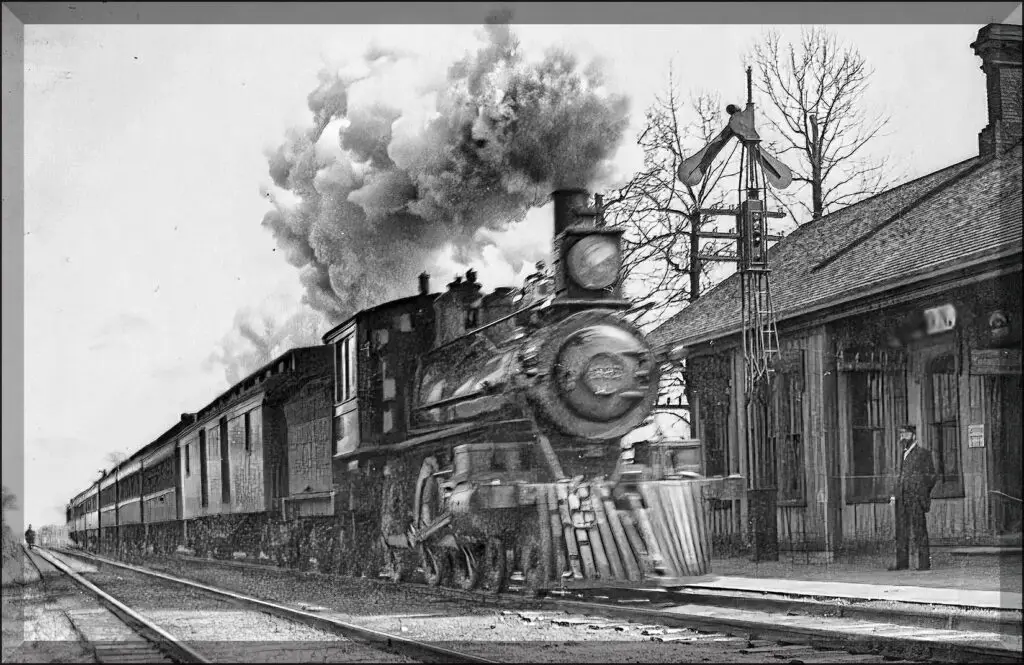
Most everyone knows the old philosophical question: Is your glass half empty or half full? The intent of the question is, of course, to point out that our attitude(s) accompany our perceptions. When I sat in my home office writing this piece, the windows were open and I could, now and then, hear train horns / whistles. They didn’t bother me too much. I was born in and grew up in a house right next to the railroad tracks on Perry Street. So, it is more than likely that the first loud noise I ever heard in this world was that of a train. But it occurred to me that very soon I would hear those whistles and horns in Vermilion, O. no more.
Trains have had a long history in Vermilion. Would you believe that they’ve been running along the lakeshore through the town for nearly as many years as the town has been officially incorporated? It’s true.
The first steam engine rolled through the village on the Junction Railroad in 1853. The line would later become the LS&M (Lake Shore and Michigan Southern), then the NYC (New York Central), and then CSX/Conrail/Norfolk-Western. The Nickel Plate rails (those passing through the southern part of town) were laid through the village during the late 19th century.
With the trains came prosperity; economic development and jobs flowed in the wake of the rail lines across the nation. Before the advent of the “horseless carriage” trains were the most efficient source of land transportation for people and the goods they produced, needed, or wanted. Many a town in the land envied the towns that had trains running through them. And some actually died because they refused to have them. But there was a trade-off. The noise was one thing. The most noticeable thing, then however, was the smoke released from the coal-fired boilers of the engines as the trains passed through town.
Sometime during the mid 1950’s the steam engines began to disappear and were gradually replaced by the diesel-electric locomotives that we know today. It was, to say the very least, an immeasurable technological, environmental, and social upgrade. [Note: The social upgrade was, in no small part, when the ladies of the town no longer had to worry about having the items they had washed and hung out to dry becoming soiled by the soot from steam engines.]
Then, of course, there were the mishaps. The deaths. Vermilion has had its share; three doctors – Buell, Englebry, and Jeffery – as well as a significant number of others lost their lives on the rails. All tragedies. Such tragedies are, in fact, the very reason for the train whistles and horns. However, given the tone of these whistles, the frequency of trains passing through town, the number of grade crossings in proximity, and the time of day (night) of occurrence, nearby residents felt that the whistles have a detrimental effect on the quality of their lives. Ergo, the quad grade crossing gates; the closure of the Perry Street and Washington Street crossings; and a quiet, whistle free, zone was established in Vermilion.
But there is one more little thing. While growing up along the railroad it was never the whistles, bells, nor even the smoke from the locomotives that was really bothersome. Those things came and went with the passing of each engine. It was the noise and motion of the trains themselves that was more significant. Just how many discussions were suspended whilst the dinner plates clinked on the table, and the windows of the house rattled, as a train swept by our home will never ever be known. Now THAT was annoying.
Well, it’s a fact that the train whistles and horns have been, like the old steam locomotives, relegated to a place in our yesteryear. Whatever the case, one really must wonder about the real significance of the trade-off – especially for youngsters and other train watchers. Is the proverbial glass as a consequence, half empty or half full? Only history and train buffs will tell.
Ref: VPJ 06/23/11; Rev. 05/30/22
Vermilion resident Rich Tarrant is Curator of the Vermilion History Museum and a son and a grandson of the late proprietors of The Vermilion News (1897-1964). Readers may email him at: rnt@twc.com
© RNT May 30, 2022

The Signalman’s Signalman
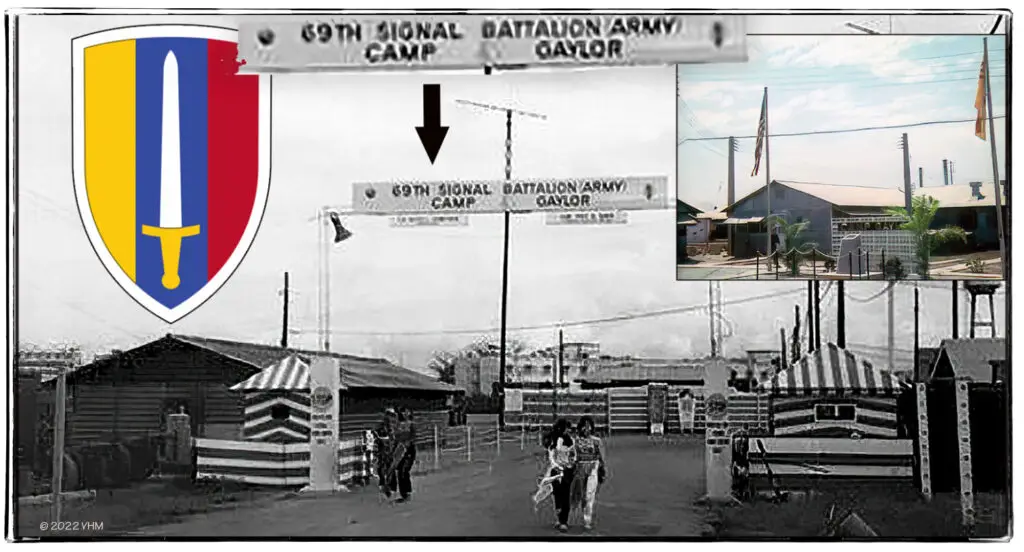
During 1966-67 I was an employee of the U.S. Military Vietnam in a place they called Camp Gaylor. This was a small Army compound just inside the sprawling Ton Son Nhut Air Force Base just outside of what was then the city of Saigon – now Ho Chi Minh City. The camp was named in honor of SSgt. Gerald Henry Galor who died of massive head injuries due to a terrorist explosive device placed just outside his quarters at the U.S. Servicemen’s Billets in Saigon. Gaylor was only 35 years old when killed. He is now at rest in Arlington.
F.Y.I. Do you know that for every soldier actively involved in combat it takes 5 to 6 non-combat troops to support him / her? This, in military jargon, is known as the “Tooth to Tail’ ratio. Sergeant Gaylor was an Army MOS (Military Occupation Specialty) 360C40 (i.e., a Wire Systems Installer) in the 69th Signal Battalion. I was a “Classified Document Specialist” working in the HHD 2nd Signal Group stationed in the compound that took his name. To most combat troopers we were their “Dirty Legs”. As such we did not carry weapons unless absolutely necessary. But as indicated – and as the untimely demise of Sgt. Gaylor illustrates – it didn’t mean that all were immune to bullets or bombs.
Anyway, 2nd Signal, had originated in France as the HHD 3348th Signal Service Group in 1944. It saw service in Europe until 1946. In the spring of 1965, it was reborn as the HHD, 2nd Signal Group at Fort Bragg, North Carolina. It was then sent to the Republic of Vietnam and had only been there about eight months when I joined the unit. The group was charged with providing signal / communications support for U.S. combat forces in Vietnam. In addition to providing lightweight, portable communications to troops, we needed to provide fixed-base communications with large antennas and heavy equipment. Divisional signal battalions, such as the 69th Signal, had to cover operating areas of 3,000 to 5,000 square miles. In a conventional war setting they would have only had to cover a 200 to 300 miles area. It was a formidable task.
Camp Gaylor sat on the very edge of the airbase. It was, of course, fenced off, but it had a huge drainage ditch below the fence that even a blind man could breach at midnight. Generally, most attacks began with mortars being launched over our heads toward the runways on the airbase, followed by sniper fire. During such attacks my duties required that I run to the headquarters and enter a heavy wire cage-type structure inside the office building where large metal safes filled with classified documents were located. Once there I had to secure the “cage” (i.e., lock myself in), open the top drawer on each of the safes, and if we were overrun drop an incendiary grenade into the drawers and close them. Those were the end of my orders. There was no escape plan. Nonetheless I had dreamed up a cockamamy scheme for survival because the only weapon I had was a rather useless 45-cal pistol. There was no place to hide inside the cage. But luckily that scenario never transpired. So, I never had to find out what might happen after I would’ve destroyed the materials. Fortunately, such attacks were relatively rare. (I prayed a lot.)
I would like to say that because our headquarters building was, in essence, “communications central” for the entire country our communication systems were great. They were not. The building housing the operational headquarters for the country was simply one big room with metal walls bolted to a concrete pad. The office walls (where there were walls) were simply flimsy wood partitions that could be moved by a cool breeze or a soft sneeze. Thus, to say it was a noisy place is like saying the Grand Canyon is a ditch. Persons in various parts of the building could be heard literally screaming in their phones trying to communicate with others. (They’d might have been better off using empty soup cans and string.) In effect the entire place was a veritable echo chamber of loud and profane imprecations and blasphemies. To be sure, the Lord’s name was consistently invoked, but seldom properly until…
Sundays were workdays because (as most persons understand) war doesn’t care about weekends. Our Chaplain, whose Irish descent was as tangible as corned beef on St. Patty’s Day, would quietly enter the building each Sunday morning in hopes of collecting errant souls for his service. And amid clamor of frustrations and misdirected profanities, he’d slap a shillelagh he always carried (WACK!!) on a desk and yell at the top of his lungs “Watch Yer Language”.
The Result: Even those unfamiliar with the Third Commandment suddenly experienced what some might call a spiritual awakening – or at least an understanding of that particular charge. The room would grow as quiet as the Sistine Chapel on Easter Sunday. And though the good Chaplain seldom picked up strays to attend his chapel services his homily was most definitely heard and understood. And just for those few quiet moments everyone in shouting distance prayed. He was what one might call a signalman’s signalman. And God Blessed America.
Vermilion resident Rich Tarrant is Curator of the Vermilion History Museum and a son and a grandson of the late proprietors of The Vermilion News (1897-1964). Readers may email him at: rnt@twc.com
© May 22, 2022
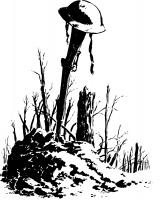
…Dear Olden Golden Rule Days...
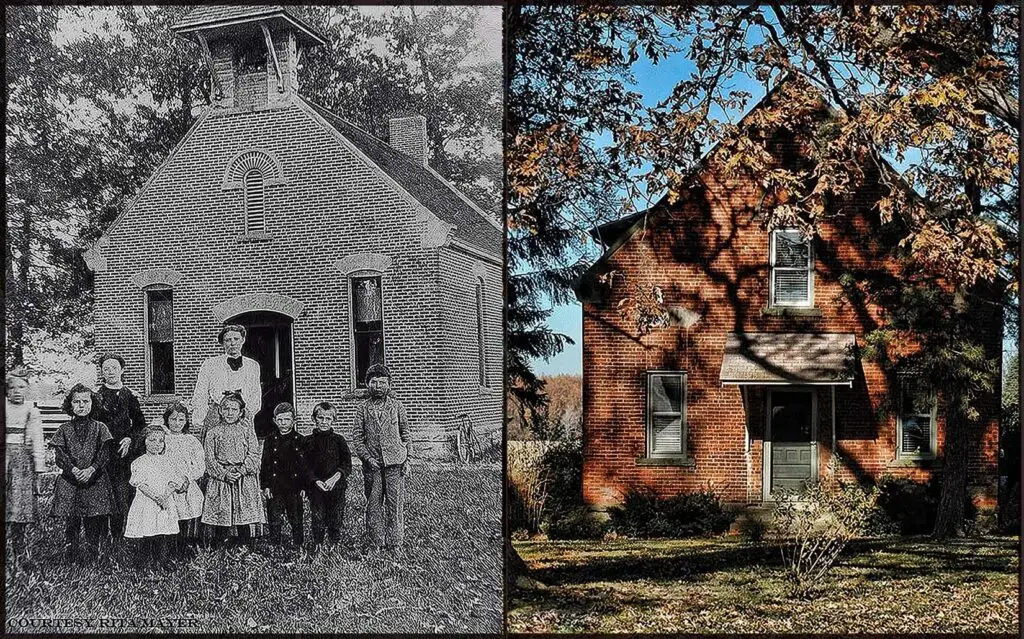
A facsimile of this (old) photograph has been in circulation in the Vermilion area for years. The photo was among several given me for the local historical archives by Vermilionite Rita (Ratcliff) Mayer some time ago. While it’s not, technically speaking, a particularly attractive portrait it is, historically speaking, a significant one. Significant because (1.) The schoolhouse is still standing; (2.) because one of the individuals in the photo took the time to write down the names of all the persons in it; and (3.) because that person also provided the date the shadows were captured. This is a great find. For an amateur historian such as myself this is akin to discovering gold in my backyard.
Currently the old one-room school is a private residence. For a good number of years, it was the tidy Tony Buersken (VPJ 10-02-08) home. It is located on the sharp curve on the most southern end of West River Road – just south of town. Aside from some very subtle alterations the exterior of the schoolhouse appears very much the same today (2022) as it did when the portrait accompanying this essay was taken.
The photo was taken in 1906. The teacher’s name (behind the children) is one Miss Babcock. And the children (from L-R) are Dorothy Aston, Helen Risden, Bertha Hull, Ruth Kneisel, Edith Poyer, Anna Mayer, Floyd Hull, John Mayer, and Roy Sherwood.
The person who so conscientiously provided this information later in life was Edith Poyer (5th from the left). Edith Rae Poyer was born in 1900. She was the eldest of the three children born to Dwight and Frederica Poyer. In 1927 she married a Brownhelm / Rugby fruit-farmer named Ralph W. Niggle. Eventually the couple retired to Scottsdale Arizona where Edith died in 1976. Ralph followed in September of 1982.
But moving on: In addition to the names, she also wrote that Helen Risden and Roy Sherwood were brother and sister who were adopted by two local families. Records show that their natural parents were Austrian, but no record of their last name was available (to this writer).
Helen / Hellen, born in Ohio in 1898, was the adopted “granddaughter” of a Brownhelm township couple – George and May/Mae Risden. The reason she is called an adopted “granddaughter in some official records is both unusual and unknown. Her brother Roy, born in Pennsylvania in 1894, was the adopted “son” of another Brownhelm couple – Charles E. and Ellen Sherwood.
There were, in this group, two other brother and sister sets: Bertha and Floyd Hull and Anna and John Mayer. The Hulls were children of John and Anna Hull born in 1892 and 1899 respectively. The Mayer youngsters were the children of Joseph E. and Anna M. Mayer. Anna was born in 1898, and her brother in 1900. Both families still have many descendants in the Vermilion area. Floyd Hull, for instance, is the father of Vermilion’s late Lucile Clark; and grandfather of Vermilion attorney / businessman Jon Clark. And the prominence of the Mayer family in the development of the place we know as Vermilion O. is well known.
The smallest cherub, Ruth Kneisel, was the eldest child of William and Christina Kneisel. She was born about 1900. Her father was a master carpenter who built many a home in the area. Information about Dorothy Aston – the blurry figure on the far left of the group – is proven to be as obscure as her visage in this photograph.
Also included with the photo is a hand-written note which reads “West River Road One Room School [built] ‘1837’”. All the other information was, incidentally, typewritten. If this is, indeed, the actual year the school was built it means that even in the yesteryear – 116 years ago – when these shadows were captured, the West River Road school was “olden”. Or perhaps better said it was, and will forever remain, “Golden”.
Ref: U.S. Census data, 1900, 1910, 1920; Special Thanks to Rita Mayer and to the late Edith Rae Poyer-Niggle; VPJ 7/29/10; Rev. 05/15/2022.
Vermilion resident Rich Tarrant is Curator of the Vermilion History Museum and a son and a grandson of the late proprietors of The Vermilion News (1897-1964). Readers may email him at: rnt@twc.com
© Rich Tarrant 2022

America's 1st Sloppy "Joe's" Place
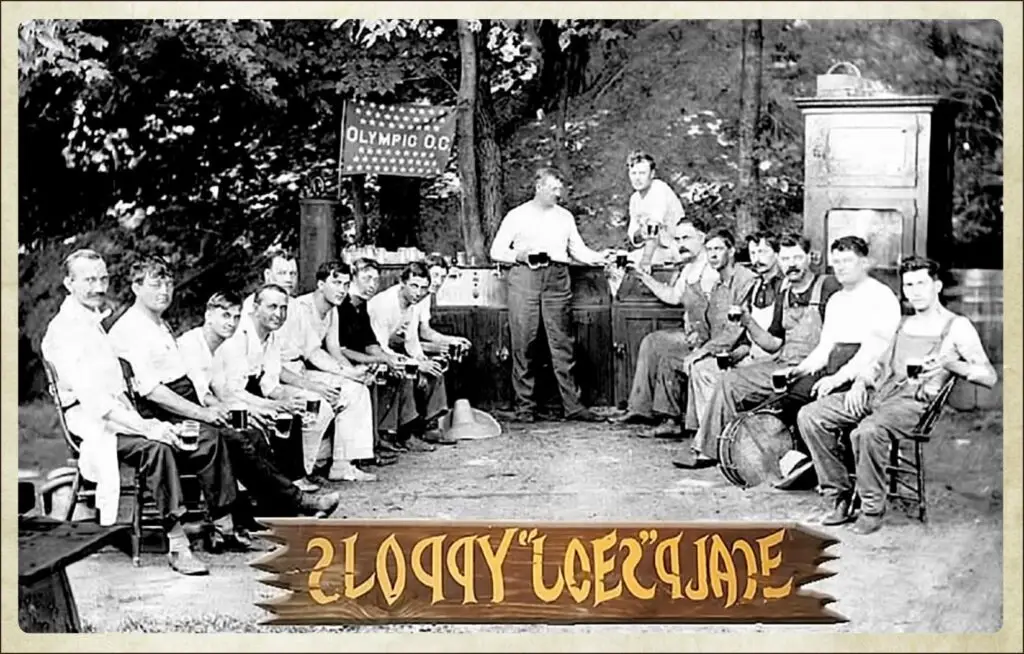
Let me begin this tale with a disclaimer. The story you are about to read may (or may not) be precisely accurate. It all depends upon who you talk to – or better still – who you believe. But despite those rather vaporous details, it is definitely a sincere (and fun) account of how, and approximately when, the clubhouse at Vermilion’s Olympic Outing Club (OOC) acquired the name Sloppy “Joe’s” Place.
In 1902 a group of men from the west side of Cleveland, Ohio acquired a property along the western banks of the Vermilion River just south of Vermilion Village to be used as a campground. They called it the Olympic Outing Club. The name “Olympic” was adapted from a place they had met / frequented in the city.
In any case, the intent of these men was to create a place of respite from the travails of inner-city life. And there, in the flood plain ‘neath the great shale banks that tower above the stream, they pitched their tents, fished, played cards, told stories, sang old songs that echoed through the valley, smoked a few cigars, drank a little beer; and, to use a tired old phrase, “Communed with nature”.
As time passed the tents gave way to permanent structures. Tidy white cottages were built away from the river – most near the cliffs of the valley to avoid severe damage from springtide freshets that naturally find a course across the flood plain. In addition to the cottages a clubhouse was also built. This took the place of the open-air gathering place (pictured) that while amenable enough in good weather undoubtedly served everyone a great deal better with walls and a roof.
By 1925 the clubhouse featured electric lighting, a long refreshment bar, card tables, spittoons, and a cash register. And although this was during the era of Prohibition (1920-1933) and no alcoholic beverages were permitted (Hey folks! It was illegal!!) folks at the club still gathered to enjoy one another’s company. And herein lies the tale of how the place was named.
Joe Ehrhard was an early member of the club. For whatever reason he also served as tender of the bar in the aforementioned clubhouse. Photographs of the clubhouse during that era show that Joe kept the place in very good order. But perhaps more importantly it was said that Joe, himself, was an extremely tidy person. This penchant for Joe to be so fastidious appears to have led his fellow club members to constantly, but good-naturedly, razz him as being “sloppy”. Ergo, the clubhouse came to be called Sloppy “Joe’s” Place. The sign (also pictured) that still adorns a wall in the present-day clubhouse appears to underline the fact that “Sloppy” was not just a figurative label; but was rather a literal term of affection and amusement.
As a matter of public record, it might be of interest for folks to note that the famous Sloppy Joe’s Saloon in Key West, Florida did not assume the name until the middle or late 1930’s – a bit after the 18th Amendment to our Constitution (Prohibition) was repealed. Consequently, the OOC clubhouse is very likely America’s very first Sloppy Joe’s.
But in the end, it really doesn’t matter. In either place the refreshments are just as wet; the laughter is just as spirited; the music is just as lively; and the times just as memorable – as they were in the yesteryear and will most certainly be in the morrow.
Ref: Olympic Outing Club Photo Archives; Special Thanks to John and Larry Fogarty, Jay Dorsey, Jeff Dorsey, and the general membership of the Olympic Outing Club; Published VPJ 10-11-07; Rev. 05-01-22.
Vermilion resident Rich Tarrant is Curator of the Vermilion History Museum and a son and a grandson of the late proprietors of The Vermilion News (1897-1964). Readers may email him at: rnt@twc.com
© RNT May 1, 2022

Character [Kar-Ik-Ter]

I guess every community / town has at least one. Persons of character are necessary components of our daily existence. They are the salt and pepper on our scrambled eggs – the catsup on our fries. They are the spice on what might otherwise be our rather humdrum daily lives.
When I was in the Army, we had a fella from Haiti in our unit who, when not in uniform, wore tennis shoes sans shoestrings. He pulled the shoe tongues out and painted odd, but colorful pictures on them for decorations. He really thought they were the “cat’s meow”. He was what one might consider being a character: a person who most certainly marched to the beat of his own drummer – however distant. Vermilion has also had its fair share of such folks in the yesteryear – some I knew, some I did not, but heard about because few could forget them.
For instance, there was once an elderly lady with the elegant name of Sophia who day and night, summer or winter always seemed to be wearing a ratty old greatcoat. Sophia liked the movies. She also liked to dine. While most people would go to a restaurant, have a meal, and then go to the theatre; Sophia would go to the restaurant, order something like a roast chicken dinner to go, put it under her coat, go to the movie and eat while she watched Clark Gabel and Lauren Becall on the silver screen. I’ve no idea how she ate her mashed potatoes with gravy and green beans. Perhaps she carried her own silverware.
And who could forget Wally. Wally was a true fan of local sports back in the late 1950s into the 60s. To my knowledge he seldom missed a game home or away rain or shine. He didn’t have a car, but he did have a motorbike. No matter where a game was being played, he managed to get there and get back home. And if one ever wanted to know anything – anything at all – about local sports, players or the coaches Wally had the scoop.
Then there was the lady who apparently never got undressed because she always wore at least two garments at a time. When she needed a new garment, she simply removed the top one and added the new. And there was another lady some knew as “Dirty Girty” because the name seemed appropriate for a person who never used soap and water. It should be noted that none of these persons were financially lacking nor weak minded. They were just (what else?) characters.
One of my very favorite characters was a Bostonian transplant to Vermilion named George. I seriously doubt that anyone could dislike this man. Like many Vermilionites George came to town after the Lorain Ford Plant was built. While he didn’t talk much about his past, he did go back to Boston on occasion to visit family. But in Vermilion he lived alone. And while he didn’t have any car that I ever knew of he did manage to get to work every day. Moreover, George liked to help people – and he did so without anyone ever having to ask him. If the windows on a restaurant (for instance) needed washing, he washed them. If a floor needed sweeping, he swept it. In short, he had a very positive attitude about most everything. And in a rather obtuse way he was a folksy philosopher who believed, “If you’re going to go, go first class.” He was a “first-class” person: A real character.
And then, of course, there was Louise. Louise was an unabashed critic of John Barleycorn devotees and was so blatantly open and honest about her several husbands it would have been embarrassing were it not so insightfully funny. But more than that she was a serious talent. She was a professional musician who played the piano in saloons and lounges throughout Ohio entertaining some of the very folks whose infatuation with alcohol she found detestable. She was, in short, a delightful character.
Through the years I’ve given much thought to all these characters and more, and once upon a time wrote a poem about them, I titled “Strange Man in a Dirty Greatcoat”. It goes: There are some things / I cannot see, / Because those things / Belong to me. / And if I ever met myself / Walking down the street / I’d look the other way, / And so would he.” For in the end, I suspect all these characters that surrounded and still surround us, adding salt and pepper to our lives, are us.
Vermilion resident Rich Tarrant is Curator of the Vermilion History Museum and a son and a grandson of the late proprietors of The Vermilion News (1897-1964). Readers may email him at: rnt@twc.com
© RNT 06/18/2017

The Whole Dang Town

Even today the site of the photograph accompanying this week’s essay is easily familiar to both residents of, and occasional visitors to, Vermilion, O. Nonetheless the changes that have taken place since the day Vermilion News editor Pearl Roscoe captured these shadows around 1906 are subtly significant.
Though I know very little about the subject of photography I believe that Editor Roscoe used something called the “wet” collodion process on glass plates to acquire many of his early photos. The process was widely used for photographing landscapes (or in this case a “small townscape”) in the yesteryear. It allowed for a relatively long exposure time and, as a consequence, produced some very detailed photographs. The hitch – if you want to call it that – was that the photographer had only about 15 minutes after taking a picture to process the glass photo plate.
Another interesting thing about this particular photo is it’s panoramic view. Precisely how this was accomplished is unknown. This is one of only three or four panoramic photographs found in Roscoe’s extensive portfolio. I assume that he somehow “stitched” them together, but I don’t know how. This can easily be done with current computer software. But doing it with glass negatives and leaving no telltale signs of having done so? That’s quite another matter.
Anyway, it’s a great photo of the corner of Liberty and Division / Main streets during the very early years of the 20th century. To provide a better idea of how this scene actually looked I should point out that the aforementioned photo process was sensitive only to blue light. This means that this scene was a good deal more colorful than we might imagine. The Pelton-McGraw sign, for instance, could have been painted with white or light blue lettering on a deep red or green background.
The building housing the Pelton-McGraw store had been rebuilt after it burned to the ground in 1892. Members of the Ely Lodge Chapter of the local Freemasons leased the upper rooms for an annual fee of $100. The store part of the building was razed in 1922 to provide space for a new Erie County Bank building (currently city offices). The Masons still occupy the upper rooms of the portion of the building that remained.
Along Division / Main and Liberty streets are shops run by persons with names also familiar to long-time Vermilion residents like; Englebry and Leidheiser. In the building currently occupied by the Main Street Grill (on the right) was Wagner’s Café – a place offering spiritual refreshments for thirsty sailors and spiritually bereft ne’er-do-wells who “shot the breeze” as they leaned on the horse tie bar outside its doors. The lion head cornices (inset) on the café are quite interesting. Whether they were simply intended to be a decorative flourish on the part of the builder or there was some ulterior reason for them is not known. But they are an interesting detail.
Though the interurban – the Lake Shore Electric Railway (note the rails running down the middle of Liberty) – had come to town by 1906, electric lighting had not. A lamplighter employed by the village council tended to the kerosene streetlights that lit the dusty lanes at night. There were gates at the rail crossings. But they were raised and lowered by a “Gate Keeper” who passed the time between trains in a little booth near the rails. Sidewalks and crosswalks were made of wood. Horse and wagon, bicycle, and feet were the main modes of transportation for most townspeople. A new technological gadget, however, had come to town. They called it a telephone. The number at The News was 19. The Erie County Bank was 1.
An adolescent Vermilion, O. was being coaxed slowly and I suspect somewhat unwillingly into the 20th century. But business was booming; commercial fishing was thriving, the Duplex Stamping Co. had come to town; and A. H. Burrows had opened the Erie Wood-Working Company for the manufacture of interior finish doors. It was time for the whole dang town to wake up and move along. And it did.
Ref: VPJ, 10/24/04, 05/10/09 and 05/27/2013; VHM Photo Archive.
© RNT 2022
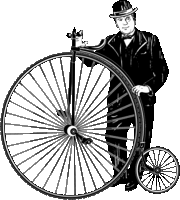
Twelve Ladies & Amen
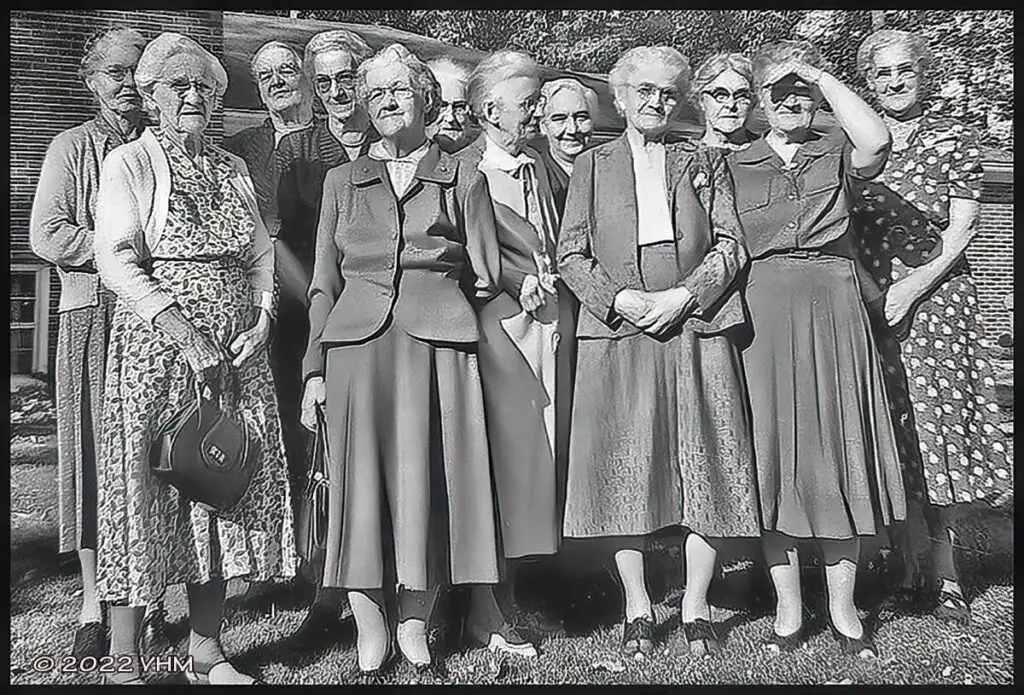
To folks with enough insight not only to take snapshots but to also inscribe the date of the photo and the names of the persons in them on the back I offer my humble and heartfelt thanks. And to those persons who discover those snapshots squirrelled away in a dresser drawer, an old trunk in the attic, or basement; who do not chuck them in the trash or sell them by the shovel-full in an estate sale where they might eventually be dumped for the frames or scrapbooks in which they are contained; I offer my perdurable blessings. These are priceless historic artifacts.
Late Vermilionite, Bertha Leimbach (the fourth person from the left in the accompanying photo) kept such snapshots as described. Her son, Fred Wetzler, also kept them. They were contained in an envelope addressed to Mrs. Gus (Bertha) Leimbach at 5678 Columbus St. Vermilion, Ohio postmarked June 3, 1968. There are 5 snapshots of a group of Vermilion ladies that were taken between the years of 1952 and 1957. Most were taken at the home of Bessie Sherod.
(Just for the sake of posterity the name Sherod is pronounced [share-id] not [sha-rod]. This pronunciation is that which the family used and apparently preferred. The family gave us a nice place for a park. The least we can do is get their name right.)
This photo was taken in September of 1957. And although one of the ladies in it is Bessie Sherod, I don’t believe it is at her home. The home in the background is made of brick. Hers was not. According to my cousin, David Lindsay, it may have been taken at the home of his parents, Captain Ferl and Alice Roscoe-Lindsay on Martin Avenue in Vermilion. Almost all the women in this photo also appear in others I have seen. And I can only speculate as to the reason they were gathered. It was very likely a church related women’s group.
The women pictured from left to right are Alberta Johnson, Laura Goetz, Adda Palmer, Bertha Leimbach, Harriet Ball, Flora Linsay, Lottie Lawless, Bessie Sherod, Nettie Jump, Maude Bennett, Ora Rumsey, and Rose Lang. (Please note that the names given here are exactly as Mrs. Leimbach wrote them.)
Having only been 12 years old when these shadows were captured on film, I recognize most of the names but few of the faces. The names are of families that had great historical impact on the development of our city. The Sherod and Ball families, for instance, go back to local pioneer times. But of all the women pictured it is Laura Goetz that I remember best.
Mrs. Goetz lived on the west side of Perry Street between Ohio and South Streets. It was about a block away from my childhood home near the railroad tracks on the same street. What makes my memory of her so vivid is the fact that she was a deaf mute. At that time folks like her were called “deaf and dumb”. I don’t believe that the label was intended to demean, but it surely didn’t help a 12-year-old village boy understand her handicap. In brief, her unintelligible mutterings, and arm-waving gyrations when she came to our house to see my mother, scared the daylights out of me. I would usually avoid her like the plague.
What I wasn’t aware of at the time is her close connection, through her husband’s family, to Linwood Park. Her father-in-law, the Rev. George Goetz, was a well-known figure in that association. Her husband, Henry, who shared her handicap, and his brother were prominent carpenters and boat builders in Vermilion Village. (As an aside it might interest some to know that Henry was bitten by a stray dog while walking down the street in late August of 1937. He was infected by the rabies virus. Refusing prophylactic treatment, he died less than a month later.)
I suppose what my meandering ruminations may indicate is that a simple snapshot of a yesteryear may generate memories that allow those who are interested help connect the figurative dots that make up a complete picture of Vermilion’s history. So please don’t throw such things away. And that’s all I have to say about a snapshot of 12 ladies. Amen.
Ref: Vermilion Area Archival Society; Special thanks to late Vermilionite Fred Wetzler and David R. Lindsay.
Vermilion resident Rich Tarrant is Curator of the Vermilion History Museum and a son and a grandson of the late proprietors of The Vermilion News (1897-1964). Readers may email him at: rnt@twc.com
© RNT April 10, 2022

The Cold War in Vermilion
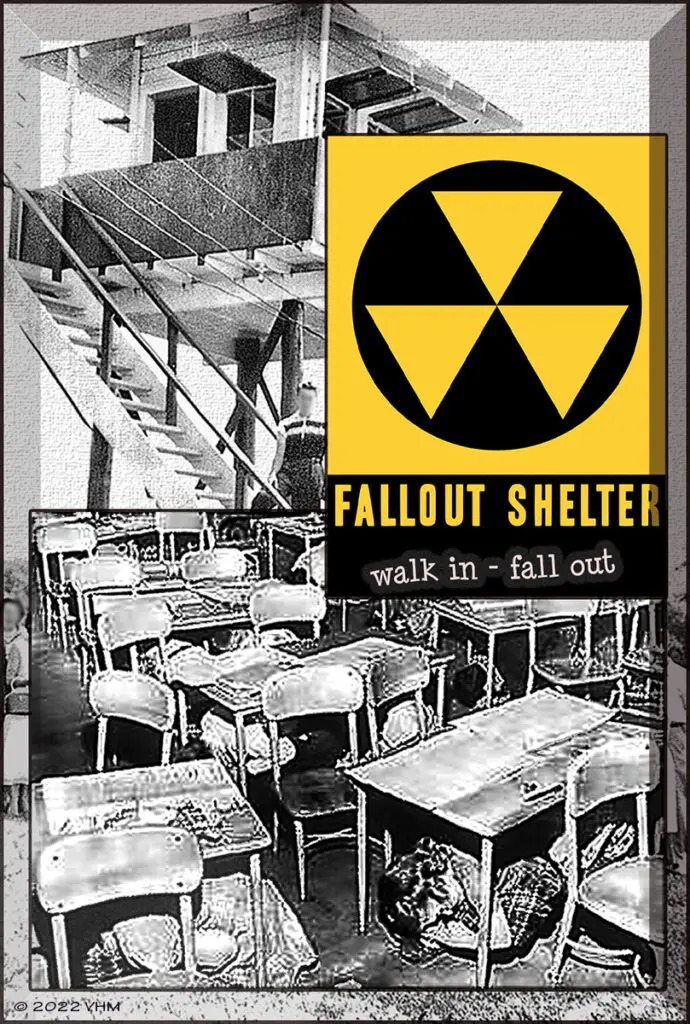
I was born in Vermilion, Ohio near the end of WW2 – on November 8, 1944. Franklin Roosevelt had just been elected to his 4th, and final, term as President of these United States. The nation was running strong on a war driven economy. And although I was unaware of it at the time that economy would build in strength, as it pertains to Vermilion, Ohio, for about the next 30 years.
For the first half of the 20th century the economy of Vermilion, Ohio was driven by two primary industries: fishing and the manufacture of lighting fixtures. The fishing industry didn’t suffer due to the obvious fact that it was a primary food source provider of fresh water fish for a good part of America. The lighting industry didn’t suffer because it produced signal lighting for the navy, and also because, in addition to lighting, the industry also manufactured war products that were necessarily made of brass and, therefore, could produce shell casings. These enterprises fed the local economy and provided employment to all able-bodied citizens who cared to work – both male and female.
As a youngster who came of age just after this great conflict; and as the youngest of eight children born to parents who owned and operated a weekly newspaper; I do not recall a time when I didn’t know about the war. I knew who was involved, and where it was fought. I knew of the great events of the war (i.e. Pearl Harbor; Hiroshima; etc.). I knew what VE and VJ days were about. I knew who Adolph Hitler, Joseph Stalin, and Emperor Hirohito were. I knew every veteran in town – personally. I respected these men and women, and I was in awe of them.
People were, by and large, extremely patriotic. The Memorial Day parades were well attended. Our local Veterans of Foreign Wars Post was organized as a direct result of the (Korean) war. I never heard one bad word from anyone about our military or our President. Folks pledged their allegiance to the flag and joined in the singing of our national anthem – even if they didn’t’ know all the words. I also remember when the words “under God” were inserted into the Pledge of Allegiance.
Church was always well attended. In fact, the church my family attended, which was built in the latter part of the 19th century, grew so large that by the mid-1950’s a new, bigger, church was needed and consequently built.
Several reactions associated with the war and now nearly forgot by most Americans who came of age during and after the conflict had to do with the “cold war” (a direct result of philosophical differences between the United States and Russia) and the emergence of the world into the “atomic age”.
Civil Defense organizations throughout the nation were quite common. Areas in cities and towns that might provide shelter if an atomic bomb were to fall on or near our respective areas were common. They were marked by yellow and black signs and usually pointed the way to basements in public buildings. During those years a common piece of graffiti often found scrawled near the doors of beer joints was, “Fallout Shelter! / Walk in. / Fall out!”.
Related to this were spotter towers where persons would sit and watch the skies for enemy aircraft. They were like the towers one might find in forested areas where rangers looked for forest fires. They were simply an open room (about 12’x12’) about two stories high. There were glassless windows all around and a telephone connected to a central location somewhere where (I assume) someone sat with a map on a wall. There were posters on the walls of the tower with silhouettes of various airplanes on them. When a person spotted and potentially identified a particular plane, they would pick-up the phone and call that information in to whomever took such calls. During the days when I hung around the place there were never any people regularly scheduled to spot planes, and the facility was only open in the summer (there was no heat).
In Vermilion the tower was located at the side of the high school football field. In season a sports announcer occupied the room at the top. Later a room was built at the base and used as a refreshment stand during football games.
Another reaction to this “atomic age/cold war” threat was a bombing drill designed for school children wherein we were directed to fall to our knees beneath our respective desks and cove our heads with our arms. In retrospect this was probably one of the dumbest emergency drills ever designed by mankind. However, I suspect it had more to do with assuaging the anxieties of parents than it had to do with providing protection from an atomic blast.
In post-war Vermilion, Ohio things were rapidly moving along. A booming market in the American automobile industry brought a new Ford Assembly Plant to the area, and the population exploded in the latter part of the 1950’s – from roughly 2000 to approximately 10,000 people in a matter of a few years. The steel mills and shipyards in nearby Lorain, Ohio were going strong – and all was well. No one envisioned a day when it all would disappear. Nevertheless, 50 years later it did. But that’s another story – for another time.
Ref: Special Thanks to late Vermilionite A.C. Tarrant
Vermilion resident Rich Tarrant is Curator of the Vermilion History Museum and a son and a grandson of the late proprietors of The Vermilion News (1897-1964). Readers may email him at: rnt@twc.com
© RNT April 3, 2022

Vermilion Telephone
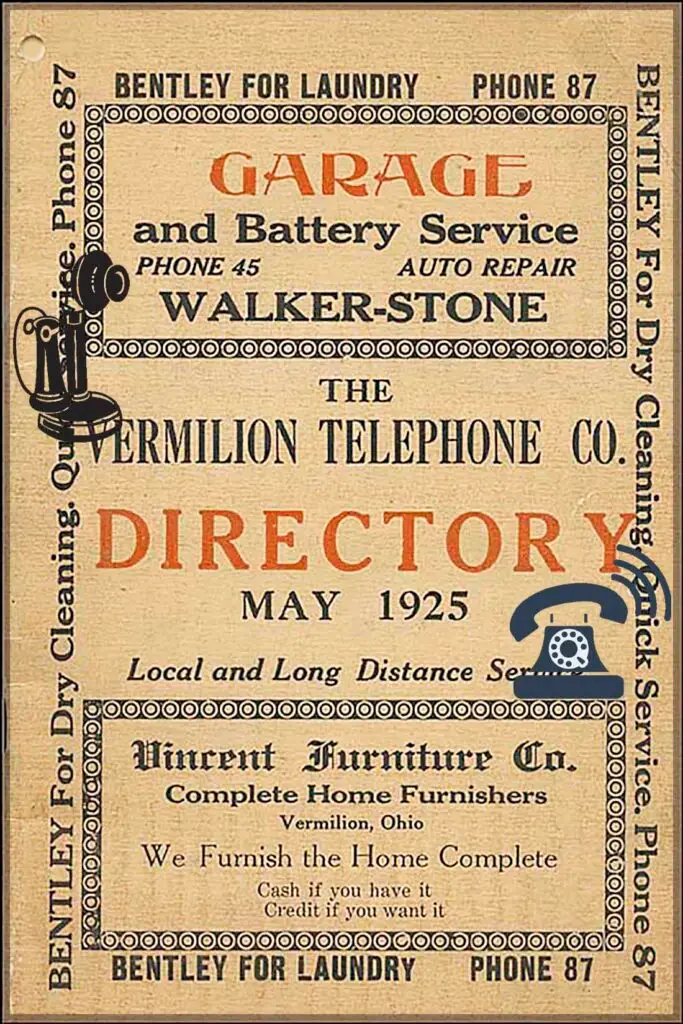
In the print shop office at the Vermilion History Museum there’s a very old metal cabinet with about 30 small drawers. Inside the drawers are all kinds of things; old receipts, pamphlets, letters, hand written news articles etc. It was, one might suppose, a kind of a “catch-all” cupboard for the newsroom. (One time I found a set of false teeth in one of the drawers.)
Some time ago, I was rummaging through the drawers and came across a copy of “The Vermilion Telephone Co. Directory for May 1925”. As most persons may know, in the yesteryear most towns had their own telephone companies – owned and operated by local entrepreneurs. In 1925 Vermilion the board of directors consisted of businessmen like A.D. Baumhart, A.J. Giddings and E.L. Coen etc.
Unlike the “mega-page” directories of the recent past, Vermilion’s 1925 book consisted of only 24 pages (not including the cover) and listed 379 local subscribers. The longest number in the book was 200-R. It belonged to Mrs. Lewis Englebry who then lived on “Liberty St”. None of the addresses were more specific. There was hardly a need for it. At that time everyone in a town of about 1400 souls already knew where their fellow townsmen lived making more specific information unnecessary. From a historian’s point-of-view its absence is frustrating. It would most definitely be helpful to have a more specific idea of where all these folks lived in the yesteryear. Nonetheless, the information that can be gleaned from such a book is both interesting and amusing.
One of the things I found interesting is the fact that there were apparently only 200 telephone numbers available, and the numbers were assigned as customers subscribed to the service. Consequently, if you were the first one to subscribe your number was (of course) 1 – and so on. The Erie County Bank, with its head cashier Edward L. Coen on the Board of Directors, had the number one. Linwood Park had 2. And young doctor Emil Heinig who kept his office in the Englebry Block had 3. The Vermilion News was 19.
But as said, there were 379 subscribers for 200 numbers. The problem appeared to have been solved by assigning duplicate numbers to several subscribers living in the same area, and then providing each with a different letter (i.e. a through z) after their number to differentiate from their neighbor’s.
These were referred to as “Party Lines”. And for those old enough to remember them, “Party Lines” were a rich source of much news that was not intended for public consumption. When one had a party line it meant that it was possible to listen (clandestinely of course) to conversations of others on the line you shared with them – or worse: to have someone listen to your conversations. For many years very few folks had private lines, and local news – the unprintable kind – abounded. The lines, as some folks used to say, were “abuzz”.
The Directory did however have a “Party Line Rules” section: “If you are on a party line remove the receiver and listen…. If the line is in use replace the receiver immediately and wait a few minutes before trying again.” And though the “General Terms and Conditions Which Service is Rendered” section specifically said that “Listening in” on a party line, except to ascertain if the line is “open” or “busy” is prohibited” it hardly put the fear of God, much less the telephone company, into every subscriber. Let it suffice to say that life in Vermilion became a little spicier with the advent of the telephone party line.
In the introduction to the book the company asks subscribers who, for one reason or another, experience problems with service “to report any difficulty, or apparent neglect of operators, to the manager.” How nice it must have been to call the company and talk with a human being capable of assisting someone without being transferred umpteen times and/or having to listen to an hour of elevator music, only to have to start over when the call is mysteriously dropped. I suppose that’s just the price of progress. But at least we know for sure that no one – absolutely no one – is listening.
Vermilion resident Rich Tarrant is Curator of the Vermilion History Museum and a son and a grandson of the late proprietors of The Vermilion News (1897-1964). Readers may email him at: rnt@twc.com
© RNT March 27, 2022

A Crown For Harry
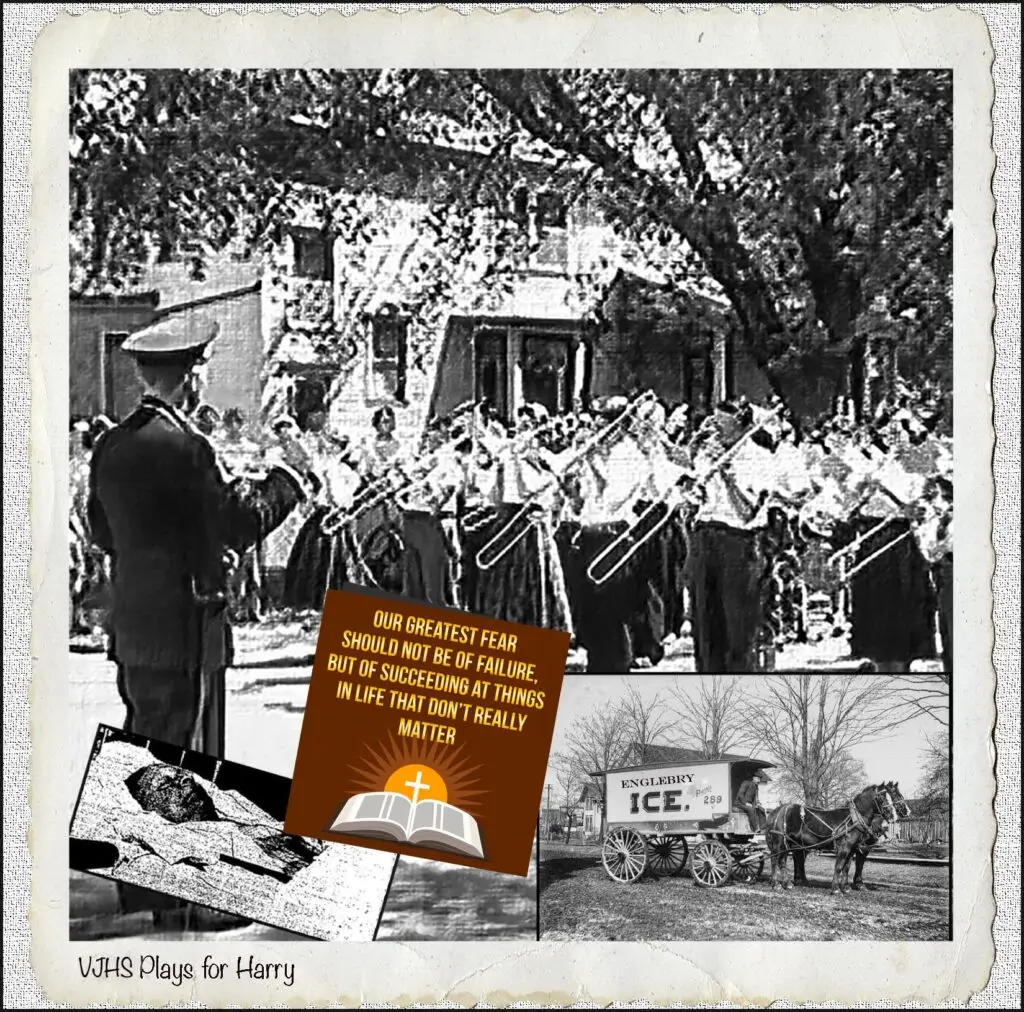
What happened to Harry could have happened to any 12-year-old boy during the summer of 1900. Life is an adventure. Jumping aboard the ice wagon as it made its rounds about Vermilion must have been a natural thing to do for a boy his age. And on a sweltering summer day there was probably nothing better than helping deliver blocks of ice to his friend’s and neighbor’s homes. One great benefit of the task was undoubtedly that of being able to pop a chunk of ice into his mouth and let it slowly melt as the horse team towed the ice wagon slowly about the village. But then, little things happen as they are wont to do, and sometimes those little things become big things.
For Harry it was a simple matter of slipping on a stray bit of ice and falling from the wagon onto a rear wheel. Without missing a beat, he tried to bounce back up into the wagon. But the horse drawing the vehicle lurched forward and caused him to be pitched to the ground head first.
Unconscious, they carried him home. For the next week the pain he experienced from his fall was excruciating. But it gradually subsided. Although partially crippled from the accident he carried on with his life. For a time, he tended to the coal oil street lamps at Linwood Park and did some light farm work during season. Then while working as a shipping clerk for a firm in Cleveland he suffered another injury. This time it was to his right arm. Arthritis set in, then gradually paralysis enveloped his entire body. And by age 21 he found himself completely bedfast.
For the remainder of his life Harry would be unable to move his head or sit upright. His activities were essentially confined to those of reading, hearing, and speaking. A man of lesser mettle might have quickly succumbed to this debilitating condition. But Harry was a person with a deep and abiding faith in God. After his mother, best friend, and caretaker was killed in her 89th year on the Division/Main Street rail crossing in 1949 Harry would say, “I have only trusted in God and kept my faith with him. I know that whatever way he moves is the best way for me.”
That unrelentless attitude and stirring faith made him one of the best known and most loved citizens of the Village of Vermilion. Until his eyesight faded, he spent his days reading the Bible, numerous other books, newspapers, and magazines. Above his bed in the living room of the family home on South Street he kept his reading material in a book rack suspended from the ceiling. Attached to the rack was a very large rear-view mirror from an automobile that afforded him a reflective view of the street in front of his house. Local citizens and folks from all over the country who had heard of his trials, tribulations and strong faith would visit him over the passing years.
During those same years Harry developed a great love for music. Because of this Vermilion’s High School and Junior High School bands frequently stopped and performed in front of his home during parades. During the Christmas season carolers seldom missed stopping at his house to sing. His fondness of music induced Vermilion’s Band Boosters to arrange with Vermilion’s Fisher Funeral Home to take him to hear the U.S. Marine Corps Band when it was visiting the city of Lorain in 1957.
In addition to this he was a big Cleveland Indians baseball fan. Because of this his friends made it possible for him to attend several games. Perhaps (this is only my thought) he had an opportunity to see the American League winning Indians team of 1954 play ball.
Harry also had opportunities to be transported to Beulah Beach to hear some nationally recognized ministers preach. A classmate of mine, Steve Armstrong, then a young resident of the camp, told me that Harry always insisted that he be able to take along a set of clean clothes when he made those pilgrimages. He reportedly told folks something to the affect that, “If God would allow me to stand and meet him, I’d better have some proper clothing to wear.”
The photograph accompanying this article records Vermilion’s Junior High School Band playing for Harry on Memorial Day in 1958. The Band Director is well known Vermilionite Bill Burt. Some of the students playing in the front row are Bob Risdon, Steve Armstrong, June Horton (now Katherine Rand), and my good friend Bill Ream. This was the very last time anyone played for Harry. He died the following September.
Some years ago, a gentleman by the name of Edward Chapin wrote that “The brightest crowns that are worn in heaven have been tried, and smelted, and polished, and glorified through the furnace of tribulation.” If there be any truth to that thought Harry D. Miller must certainly be wearing one of the most brilliant.
(Ref: Lorain Journal; 10-17-49; Elyria Chronicle Telegram, by Vermilionite Dayle Rodgers; 3-15-58; 10-4-58; Ancestry.com; and Special Thanks to Steve Armstrong)
Vermilion resident Rich Tarrant is Curator of the Vermilion History Museum and a son and a grandson of the late proprietors of The Vermilion News (1897-1964). Readers may email him at: rnt@twc.com
© RNT March 20, 2022

Ifs and Buts -30
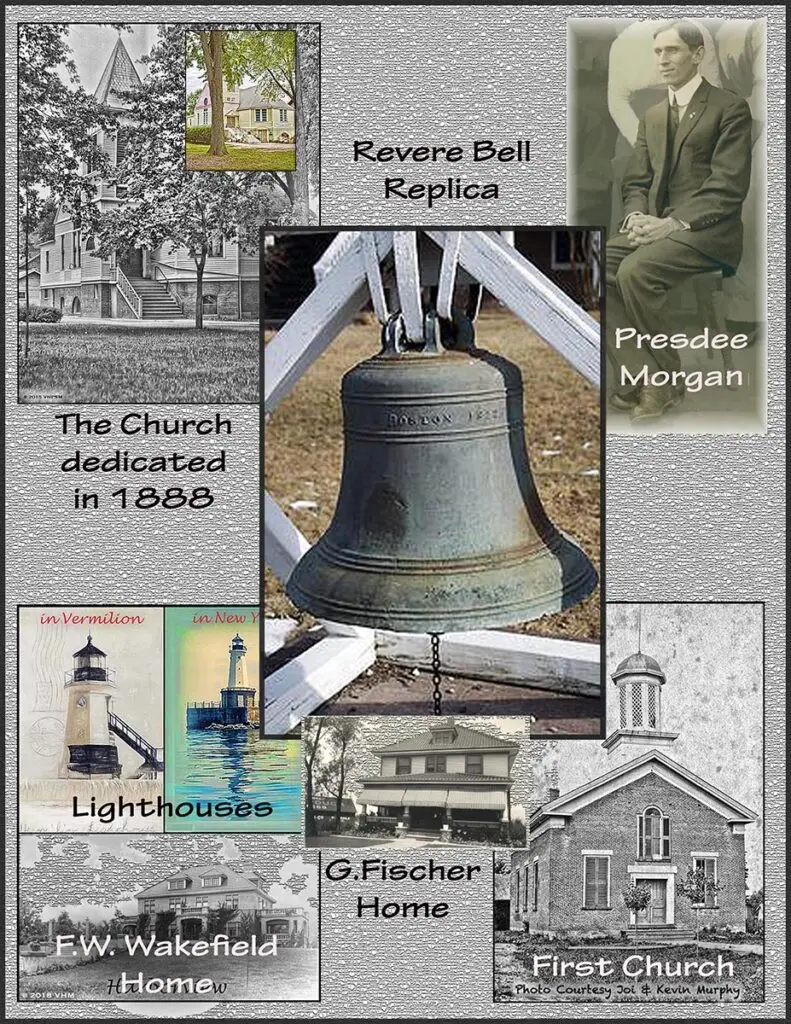
Several friends phoned me during the last week to tell and / or ask me about an article that had apparently appeared in newspapers across the U.S. recently. It was about the Revere bell that once upon a time lived in the belfry of the old First Congregational Church (currently the Millet Auction House) on Main Street here in town. I can only guess that the reason the article seems to have garnered so much attention across the nation is the novelty of the coast-to-coast journey(s) it took across our country. (It is a “well-travelled” instrument.)
It’s stay “in Vermilion” began in 1854. Eleven years earlier Vermilion’s first church building was built on Lot 130 on the public square in the newly incorporated village. Then in 1854, what was probably the first women’s group in Vermilion’s First Congregational Church was organized. It was called “The Bell Society”. Through church suppers and sunbonnet and shirt sales the women earned enough money to enable the Society to purchase the bell from the First Presbyterian Church at Cleveland’s Public Square. There is no record of price paid, but it was said that the 3,000-pound bell had to be carted to Vermilion by two yokes of oxen.
In 1883 An elaborate Township Town Hall was built on the corner lot just south of the little brick church. It replaced an old schoolhouse that had once occupied the corner. The new building with its opera house, council chambers, jail and community room was the pride of the village and a boon to the ladies of its churches. Within a week of its opening, stoves and cooking equipment were hauled in and a successful church supper was put on by the Congregational Church next door.
In 1885, a church committee was appointed to solicit funds. for a new and larger building. The little church had become an old church, with its bricks crumbling it was in a “generally dangerous condition.” The following year, the walls were pulled down at a cost of $50 and the bricks cleaned and readied for use in a new foundation. The bell was removed and polished for re-use in the new steeple. Then on January 15, 1888, the bell called a joyful congregation to worship in a new House of the Lord. And the years passed.
By the mid-1950s the congregation in the ageing church had grown so large that a new church was built on the west side of State Street to accommodate the growth, and their former church building was sold to the Vermilion First Baptist Church – bell included.
In the early 1980s when the Baptist congregation, also having outgrown the building, moved to a new church the real estate broker not wanting the bell to be scrapped purchased it. And when the broker moved to California, the bell also moved. Since 2009 it had been sitting on a garage floor. This year the bell went home to a museum in Massachusetts where it had been cast by the Revolutionary War patriot’s son, Joseph Warren Revere, way back in 1834.
Now that is, admittedly, a great story. But I must add that years prior to my becoming involved with the Vermilion History Museum project I had tried to recover the bell for Vermilion’s UCC Congregational Church – to bring it back to Vermilion. Obviously, my efforts were not successful. Nonetheless, I am thankful that it has found an appropriate home. And I do have at least one great memory of it to keep forever.
As a youngster I used to arrive at the old church before the bell was sounded calling people to worship. In those days a guy named Presdee Morgan was the main “bell ringer”. Mr. Morgan was a rather slight fellow. I always thought him the embodiment of the character Ichabod Crane from Washington Irving’s story “The Legend of Sleepy Hollow”. Anyway I (along with many others) liked to watch him pulling on the rope to ring the bell at the entrance to the church. After pulling down on the rope, with a great deal of effort, and with a solid “gong” it rose back up. We then would hold our collective breaths imagining that the rope might yank him up into the steeple. That of course, never happened. But we nonetheless watched and waited – in anticipation of his (so to speak) ascension.
But seriously. I ofttimes regret having lost many of the great things in our town: the real Vermilion Lighthouse that went to New York, the wonderful brick bandstand in Victory Park, the old bandwagon, the old George Fischer and F.W. Wakefield homes, the beaches at Linwood and Nokomis, and the list goes on. Some of those things we could have saved, like the Revere Bell, if only… but for this reason or that, we did not. As sportsman Don Meredith used to say, “If ifs and buts were candy and nuts we’d all have a Merry Christmas.” -30.
Ref: History of Vermilion’s Congregational Church by Betty Trinter; Frist 100 Years History of the First Congregational Church of Vermilion, Ohio by Lucy Morgan.
Vermilion resident Rich Tarrant is Curator of the Vermilion History Museum and a son and a grandson of the late proprietors of The Vermilion News (1897-1964). Readers may email him at: rnt@twc.com
© RNT March 13, 2022

It Tolls For Thee
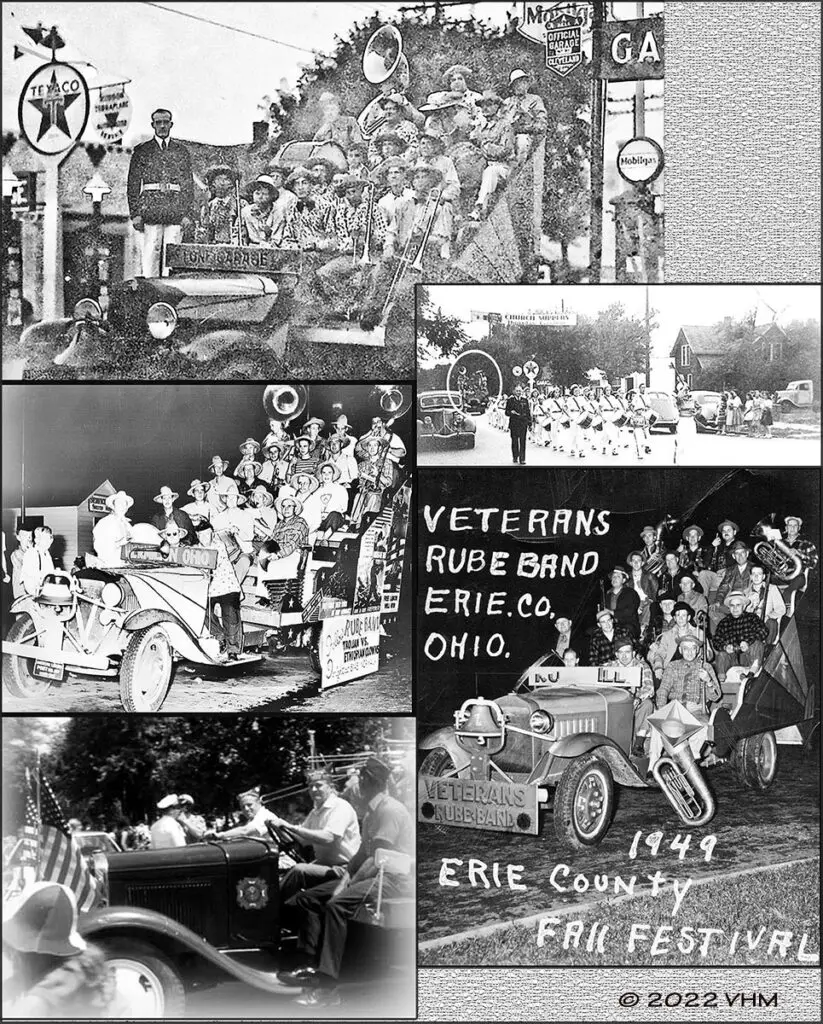
Did I ever mention (or fail to mention) that I feel lucky to have been born and raised in Vermilion Ohio? I was born in 1944, so my “growing-up” years were mostly the 1950’s. The three main churches: St. Mary’s, the Evangelical and Reformed, and the Congregational. Downtown was “really downtown”. In those years Vermilion was a village that stretched from about Maurer’s Lane (i.e., Haber Road) in the south, Lake Erie to the north, from about Bluebird Beach to the west, and to Crystal Beach Park in the east. South Shore Shopping Center was a muddy parking lot for Crystal Beach. Just west of this parking lot was a little drive-in restaurant that was only open in the summer. The area between it and Vermilion (i.e., East River) Road was littered with summer cottages. Romp’s Waterport was a swamp, and the Lagoons across Liberty Street was a small, but growing, housing development.
As one might imagine growing-up in a town with a population of 2000 people had its “ups and downs”. One of the “downs” was that everybody knew everybody. Thus, when a person incurred some infraction of decency it didn’t take too long for everyone (including one’s parents) to get word of it. But thank heaven, there were many, many “ups”. One of them was Vermilion’s American Legion Rube Band.
Maybe every little town had one. About that I don’t know. But Vermilion Ohio sure did. It was called, as the name in one of the associated photographs indicates, “The Rube Band”. And as one can also see they had their own mode of transport. Some astute person, may be able to tell the precise make and model of the vehicle pictured. But one thing for sure, it was neither a stock nor a factory-built vehicle.
As is obvious I have photographs of the band in their customized truck that as best I can determine were taken over a span of 40 some years. The photo at the top is the oldest one I’ve ever come across. It was taken in front of what was at the time Albert “Waddie” Stone’s garage and Oldsmobile Dealership on Liberty Avenue in 1932 or ’33. This is (in 2022) the building next (west) of Rudy’s Bar & Grill. The garage in the background is Ed Walker’s Hudson dealership and garage that was later razed for a Ritter Library expansion. You will note that in those years auto dealerships sold gasoline and remarkably were allowed to place their pumps right next to the road.
Initially the band must have been organized using the remnants of the old G.A.R. (Grand Army of the Republic) Band led by Sandusky band leader Gene Ackley. (Ackley is the uniformed man standing in the first photo.) “Waddie” Stone was a veteran of the WW1. Following his death in 1943 it appears, given the photo directly below it, that the local American Legion Post had acquired the vehicle. An advertisement on the back part of the vehicle promotes the purchase of war bonds. In the smaller photo just to the right the bandwagon can “just” be seen in the background during a parade down Liberty street. Due to the absence of young men in that photo it may have been taken during the war as well.
The 1949 Photograph is the best photo I’ve seen of the band. It was obviously a “veteran-owned” vehicle, although which one is not clear. But no matter. By the 1960s the local chapter of the VFW owned it. And in the lower left photo VFW members Clayton Cook and Ozzie Kelm were in charge. Both men are seated (smiling) in the front seat of the truck during a Memorial Day Parade.
I have several more photographs of this vehicle. One shows the truck at a Vermilion Street Dance on Division (now Main) Street. Another provided me by Vermilion (VPJ) photographer Scott Domin a few years ago shows members of the VHS Band performing on it during a parade in the 1970s. And last, but hardly least, I also have video of the truck and band participating in a function at Vermilion’s Olympic Outing Club during the 1940s.
Well yeah, all who played in the band over the years were rubes – but they were (our) Vermilion’s Rubes. They were talented musicians and entertainers who had, and shared, a great deal of fun. To be sure they were a band of unsophisticates. But one that helped us keep our chins “up” through two wars and an economic depression with tunes of a yesteryear that many may still recall provoking memories that can’t help but put a smile on one’s face.
Epilogue: The old bandwagon finally succumbed to the ravages of time. For many years it sat outside Vermilionite Ozzie Kelm’s home on Cherry Road. After Ozzie’s death in 2005 I was told that salvageable parts of the old wagon were sold at auction. During the auction Vermilionite Jim Smith’s oldest son reportedly purchased the bell. Here I can’t help but recall the end of a poem by English poet John Donne, “Therefore send not to know / For whom the bell tolls, / It tolls for thee.” And however sad that may seem let me assure thee – it ain’t.
Ref: Special Thanks To: Vermilion’s Grob Family; the Jim Smith Family; the Whitt Family; Scott Domin; Nancy Alice Emery; and Clayton and Nuggie Cook
Vermilion resident Rich Tarrant is Curator of the Vermilion History Museum and a son and a grandson of the late proprietors of The Vermilion News (1897-1964). Readers may email him at: rnt@twc.com
© RNT Sunday, March 6, 2022

And That’s the Truth
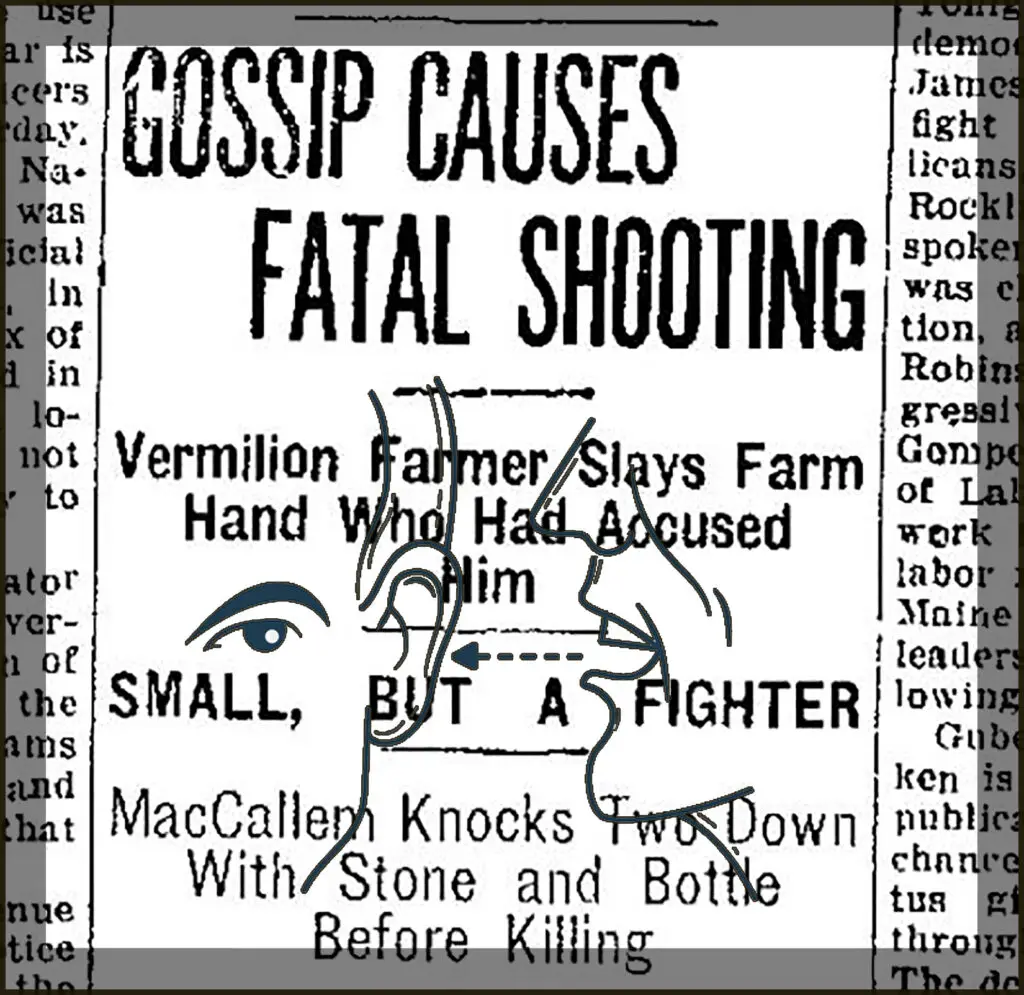
In September 1916 the first “true” self-service grocery store in the U.S. opened in Memphis, Tennessee. The founder, one Clarence Saunders, called it the Piggly Wiggly. Just a few days before (08/31/1916) a young man named Harry Butters earned a place in history when he became the first U.S. casualty of World War 1 while serving with British Forces during the Battle of the Somme. He was 24.
Now those things aren’t “gossip” (i.e., now widely called “fake news”). They’re facts. But if manunkind has faults – and we certainly do – one major shortcoming is our proclivity to hear, cipher and decipher things not as they are, but as we want them to be. The real problem arises when we publicly state such information as fact. Generally, that isn’t of grave concern for most folks. But once in a while, it is. Thus, in the late summer of 1916, while Clarence Saunders was busy founding his grocery business, and Mr. Butters was busy being a victim of a German gas attack, it was. At least it was for a Vermilion farm hand by the name of “Mack” MacCallem. And when the dust settled on the night of September 8, 1916, it was Mack who had “bitten it”.
It’s doubtful that we’ll ever know the precise details initiating the following incident. What we do know is that after being given a ride by a man named Nicholas Myers to a home southwest of Vermilion where he’d been working as a farm hand, Mack later went to Myers’s home and accused him of making uncomplimentary remarks about a woman. (The identity of the women was never revealed.)
When Myers denied having said anything about the woman Mack became angry and went down the road searching for a stone to throw at him. Meanwhile a wary Myers went into his home and retrieved a pistol. When he returned to the porch, he fired the pistol in the air telling Mack to skedaddle or he’d shoot. Undeterred, Mack boldly walked up to Myers, hit him with a beer bottle and took the gun away from him. Saying that he could “prove that Myers had talked about the woman” he left. With revolver in hand, he went to the home of a nearby farmer named John Risden inducing him to return. But he did, however, leave the gun behind.
After returning to Myers’s home with Risden, Risden denied ever hearing Myers having said anything about the woman in question. Infuriated, Mack lambasted Risden with his fists saying the “he was in same class as Myers”. He then picked up a stone and, threw it at Myers hitting him squarely on his left cheekbone. And that was, as some are wont to say, when something unseemly hit the proverbial fan. Myers then went into his home and returned with a shotgun. Pointing the gun at the raging Mack he pulled the trigger. The charge tore away Mack’s chin. Death was instantaneous.
Myers was summarily arrested and taken to the Erie County Jail. Later at the hospital it was found that his jaw had been broken, a result of Mack’s stone throw. Released on $3,000 bail he was bound over to the Grand Jury. But it would later be determined that the shooting was justified. Although Mack was small in stature, while both Myers and Risden were big guys, both weighing in at 200 pounds, he had displayed no fear of them. And with his coat off and shirtsleeves rolled up he had prepared for action when he was shot.
So. What were the facts? Or did town gossip enhanced by a gun and (perhaps) some booze instigate a tragedy in Vermilion’s yesteryear? It’s doubtful that we’ll ever know with any certainty. Myers later told the sheriff, “I didn’t expect to shoot MacCallem when I got the revolver, but after he had knocked me down with a beer bottle and then with a stone, I thought it about time to protect myself and I got my gun.”
Epilogue: Four years later Nick Myers, well-to-do farmer, and locally famed trapper with a reputation of being a peaceable law-abiding citizen with hardly of a quarrelsome disposition died from heart failure at his home in Axtel, O. He was 50 years old and had suffered with heart disease for most of his life. As comedian Lily Tomlin’s character Edith Ann used to say at the end of her monologue, “And that’s the truth.”
Ref: The Sandusky Star-Journal 09/09/1916; Ancestry.com.
Vermilion resident Rich Tarrant is Curator of the Vermilion History Museum and a son and a grandson of the late proprietors of The Vermilion News (1897-1964). Readers may email him at: rnt@twc.com
© RNT February 27, 2022

Plywood Plaza
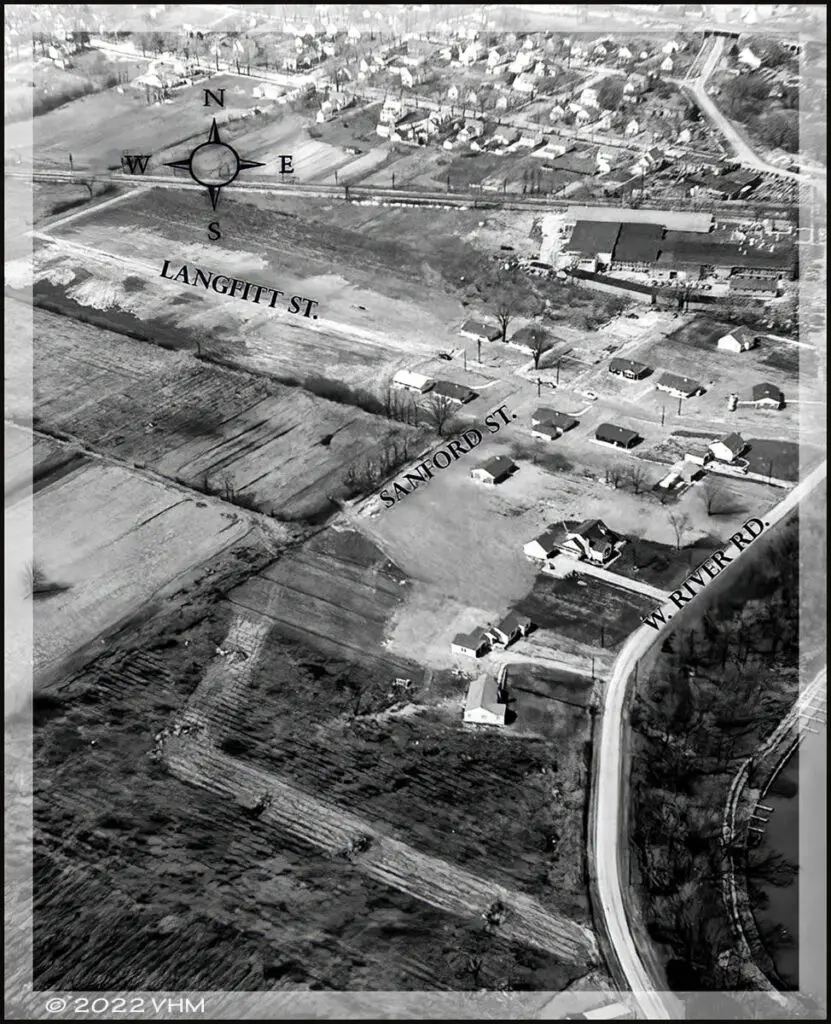
Following W.W.II there was a severe housing shortage in America. This was because homebuilding during the years of the Great Depression through those of World War II (1929-1945) had dramatically decreased. Federal officials estimated that between 1946 and 1947 at least 3 million new houses would have to be built to effectively address the problem. Prefabricated housing was viewed as a quick solution to the difficulty, but prospective buyers were not readily inclined to agree. Their experience and knowledge of the cheesy prefabs which had been built as emergency housing during the war had been less than stellar. And the prospect of their owning a home built on a cold concrete slab surrounded by panels of thin plywood with visible joints between the panels helped to insure that the aforementioned goal set by the feds would not be realized. In addition to this, existing building codes and labor unions were less than receptive to the concept. Thus, when it came to building prefab homes – the community of Vermilion, O. was no different than any other place in the nation. Skeptical would have been the operative word.
Local skeptics referred to Vermilion’s first prefab development as the “Plywood Plaza”. The term, however innocent it may have been, was not entirely harmless. To be sure, the intent was not particularly malicious. But it was inappropriate. Especially when what it really suggested was that the houses were inferior to those in the rest of the Village. But, in fact, they were not.
Technically they were known as Gunnison homes. They were named after a lighting engineer, Foster Gunnison who did for the American home building industry what Henry Ford did for the auto industry. Working with a group of architects, engineers, and plywood experts during the 1930’s he developed affordable housing using assembly-line techniques. The homes were made from 4-by-8-foot panels and thus could be expanded in 4-foot increments. The walls were a mere 2 inches thick, made with 1/4-inch plywood, wood stud framing and rock wool insulation. A resorcinol formaldehyde adhesive was applied to the plywood and the sandwich sent through a hot plate press. Some said that this resulted in a stronger bond than if it had been nailed, and that the walls, consequently, had an insulation value of 22 inches of concrete. They were attractive, well-built and, thanks to a variety of add-on features, could be custom-made to accommodate families of different sizes and means. If the foundation was set a home could quite feasibly be built and ready for occupancy in four days flat.
In Vermilion a new subdivision of Gunnison-type prefab homes began to take shape in an area just south of what was then the F.W. Wakefield Lighting Company on West River Road sometime in the early 1950’s. The aerial photograph of the development was the work of local photographer Paul Ludlow from a plane piloted by Vermilion builder “Bud” Burkhardt. Mr. Burkhardt, along with several other Vermilionites such as Lin Creel, S.E. Langfitt, and long-time Vermilion School Educator / Principal Jim Sanford, were perhaps responsible for the burgeoning development. Although the naming of the first two streets in it may well have been “incidental”, it was hardly “coincidental”.
In a relatively short time the need for, and quality of, these homes simply overwhelmed the hypothetical logic of local skeptics. And gradually the stigma associated with prefabricated homes, as well as the insalubrious nickname for the subdivision, dissipated. More homes went up, and more streets were added. Families (in no particular order) with names like Martinek, Kyle, Meese, Langfitt, Wendell, Cutcher, Bricker, Diehl, Maiden, Lane, Hallet, Davis, Moeller, and Wilkes populated the neighborhoods, and actively participated in the task of helping to improve and strengthen the community.
Within a few decades the entire area visible in the accompanying photograph would become a maze of streets lined with affordable and attractive homes. Thus were the demands of a burgeoning community and a nation which then, at least seemingly, had no bounds were met in that yesteryear by persons of extreme vision who were confident enough, and brave enough to ignore both critics and naysayers. God bless ‘em all.
Ref: Mann Library, Cornell University, Ithaca, NY – Fast and Affordable – A Century of Prefab Housing; Prefabricated Homes Prized in Postwar Years; By Bill Kemp Archivist/Librarian McLean County IND. Museum of History ; Special Thanks to: Pat Creel, and to Greg Trocchia; VPJ, 03/04/09; Rev. 02/20/22.
Vermilion resident Rich Tarrant is Curator of the Vermilion History Museum and a son and a grandson of the late proprietors of The Vermilion News (1897-1964). Readers may email him at: rnt@twc.com
© RNT February 20, 2022

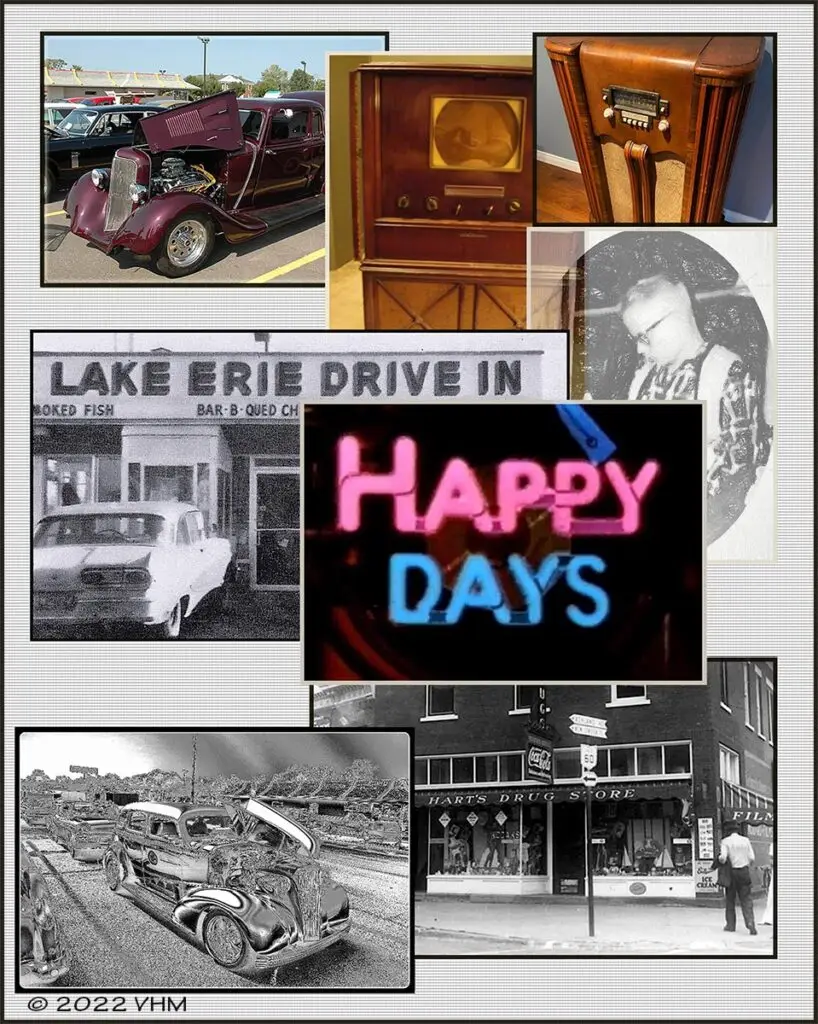
A short time ago while showing a younger visitor through our local history museum I was asked what it was like to grow up during the 1950s. “Was it like Happy Days (i.e., the television show)?” he asked. Because at the time I was talking and thinking about our Vermilion in the 1920s or 30s I was somewhat taken aback with the question.
Well, of course, I came of age during that era. But it never seems to me that it was all that long ago. Then I was reminded of a time in the early 1990s when I sent a photograph of Vermilion taken in the early 1940s to late Vermilionite George Wakefield asking for some comments about it. He responded by telling me that he didn’t have anything to say because “It wasn’t that long ago.” And I suppose that he was right. Comes a time in every person’s life when fifty years ago seems like yesterday – not history. But in retrospect those memories (from a half-century back) may not be antiquated (at least not yet), but they are vintage. So back to the question, “Were the 1950’s in the U.S.A. like the TV show Happy Days?”.
Checking into my memory bank I find that I can reach back to Thursday February 3rd in 1949 when a guy the townsfolk called “Smokey” was hit and killed by a train on the NYC (currently Norfolk & Western) tracks between Grand and Washington streets in our village. I was 4 years old. Well, that’s hardly a Happy Days type memory. But I suppose it’s a start. Then there’s my 7th birthday in 1951. I remember it because I still have a present that was given me that day. It’s a children’s book called “Bugs Bunny’s Birthday” But still, not Happy Days stuff.
But as those days turned things began to change. Our family didn’t have a television until about 1952. Before that we all listened to radio programs on a big wooden cabinet radio that sat between our living and dining rooms. News was always big in our family. But then there were my mother’s soap operas. There were also comedy programs like Fibber McGee and Molly and Amos and Andy; crime fighter programs like The Shadow; and entertainment stuff like Arthur Godfrey with Julius LaRosa. And I recall a time after we got our first 13-inch television when Godfrey’s program was simulcast on both TV and radio. Most Sunday programming on either medium was usually a bust. So that was a time for movies at the Liberty Theatre with Roy Rodgers, Dean Martin and Jerry Lewis, Abbot and Costello and some Little Rascals short films, etc. and ad infinitum.
I reached my teen years in 1957 which is coincidental with the Happy Days program era. And to be sure cars seemed to be a big deal then. Though driving was a few years away from me it didn’t stop me nor my friends from admiring the rides the older kids had as they passed our gang on Liberty Street where we hung out in front of Hart’s Drug Store (currently 2022 the Main Street Soda Grill). While Hart’s had long been a gathering spot for numerous generations of high school kids their acquisition of “wheels” began to change that. Suddenly that crowd found the A&W Root Beer or Lake Erie drive-ins on the eastside of town better places to gather. They could show off their cars and flirt with the cute carhops. Some of the guys who pooled their resources were able to cruise Broadway in Lorain or Columbus Avenue in Sandusky looking for girls or a drag race. If nothing else, they might be able to make a few passes through the Hoop Drive-in on the southwest corner of West Erie and Leavitt Road in Lorain.
“Happy Days”? Yeah, I suppose so. But there were also some down days that the movie from which the series was inspired “American Graffiti” only alluded to at the end of the flick. Those things happened as well. Many persons may be inclined to ignore those times and wax rather idyllic when reviewing past years as did the television show. I do not. But, by and large, I just gotta say that looking back from my place in existence that persons of lesser years than myself seem to consider antique but are, in truth, vintage (i.e., Over the Hill (and Half-Way Through the Woods) those days most certainly weren’t unhappy. Wait’ll you hear about the 60s and 70s.
Vermilion resident Rich Tarrant is Curator of the Vermilion History Museum and a son and a grandson of the late proprietors of The Vermilion News (1897-1964). Readers may email him at: rnt@twc.com
© RNT February 13, 2022

The Exciting Life of Jimmy Moses
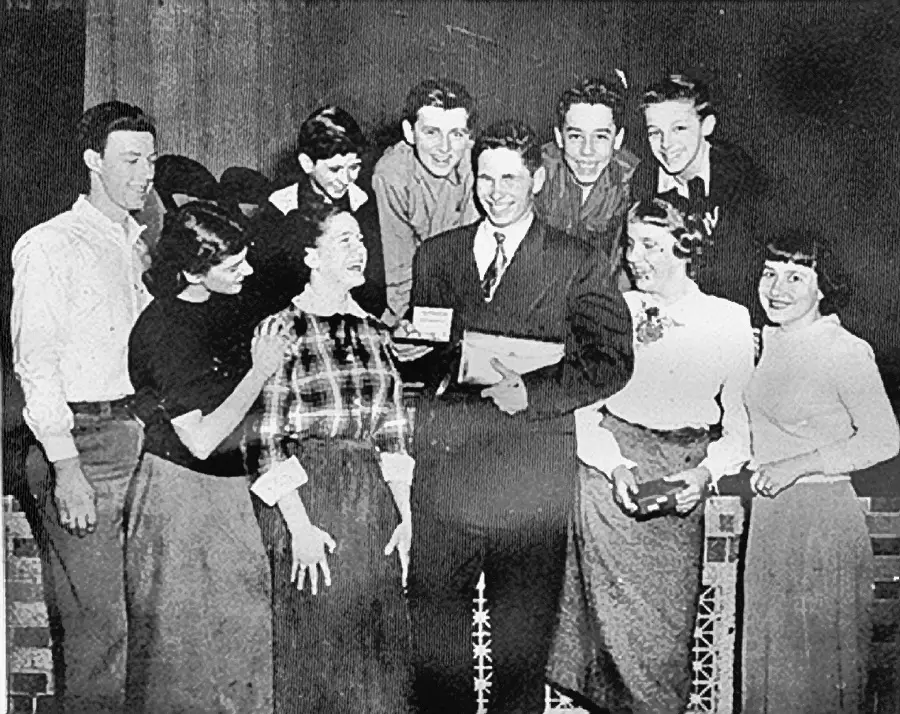
I don’t mean to bore everyone by repeating myself so often. But sometimes (I believe) it’s important. What follows is one of those things. Facsimiles of the accompanying picture, and story, have appeared on the pages of the VPJ before. In fact, this photograph appeared in the very first issue of the Vermilion Photojournal on August 26, 1959. Just for the record and spermologists (i.e., collectors of small pieces of trivia) Vermilion resident, George Radosovich, was the editor.
The simple motive for the retelling of this story is to remind persons who participate in recreational activities on ice – be it on creeks, ponds, rivers, or lakes – to be very cautious and aware of their environment while having fun. It’s so very easy to get caught up in the moment when having a good time with friends that… Well, this is what happened near Vermilion, O. a bit over 70 years ago.
On the icy cold Monday of February 27, 1950, a group of 10 teenagers who lived in the vicinity of Mitawanga, and Ruggles Beach west of Vermilion decided that it would be a good day for ice skating. Later reports indicated that their party began on a pond at the mouth of a creek (i.e., Cranberry Creek) that emptied into Lake Erie. After a time, one of the youngsters discovered that the lake could provide them a smoother skating surface, so they promptly moved their party onto the lake just off Ruggles Beach. They were having a great time until one of the group, Jimmy Moses, skated off the ice toward shore onto what he first thought was “black ice”. It was not. It was open water.
Quickly understanding their dilemma Jimmy and another one of the boys, Bob Rathbun, who were both at 17 the oldest kids in the group, quickly stripped to their shorts and prepared to swim for shore and help. And just as quickly both realized that only one should attempt the swim, agreeing that someone should stay back and watch over their younger friends. The boys elected Jimmy to be the one try for the shore.
Truth be told Jimmy was no stranger to icy lake waters. On the previous New Year’s Day, he had been one of the first persons of the year to take (albeit intentional) a dip in Lake Erie. This, however, did not make his swim through floating and drifting chunks of ice in the freezing water any easier. At one point during his swim, he gave a cry of distress that caused his buddy Bob Rathbun to prepare to follow. But almost immediately Moses shouted to let him know he was okay and had finally reached the beach. It was later estimated that the swim had been about a quarter of a mile. The fact that he had survived was nothing short of miraculous. But even then, his travail didn’t end.
Once ashore young Moses although having incurred numerous bruises and lacerations during his struggle with ice and deathly cold water had to race home, sound the alarm, and help organize the rescue. And it was none too soon. When help finally arrived the nine remaining teenagers were found standing in ankle deep water and the ice floe on which they were stranded had drifted a full half-mile from shore. To be sure James G. “Jimmy” Moses was a bona fide hero.
In the accompanying photo he is pictured with his extremely grateful friends in front of the stage at Vermilion’s South Street School. Those with him (L-R) are Robert Rathbun, Marilyn Ruetenik, Carrol Lydic (Baker-Harrison), our hero Jimmy Moses, Donna Ruetenik, Jane Bradley, (Back Row) Lowell Knittle, Duane Knittle, Charles Ruggles and David Rathbun.
The story of Jimmy’s fearless swim to shore at Ruggles Beach to get help to rescue his friends received a great deal of local, state, and national newspaper and radio attention. (Note: television was still in its infancy.) And as a result, James Grant Moses was nominated for and awarded the Carnegie Bronze Medal for Heroism as well as numerous state and local awards.
Epilogue: His life proved no less exciting after graduating from VHS in 1950. He played linebacker at OSU under legendary coach Woody Hayes. He would also manage to establish a punting record at Ohio Wesleyan University of 86 yards. Following college, he joined the U.S. Navy became a pilot, and flew combat missions in the Korean conflict. He was aboard the U.S. Ticonderoga in 1956 when six airmen were killed in an explosion. And he once bailed out of his jet over Florida shortly before it exploded. Finally, he returned home (to Huron) married and had three children. He worked in industrial sales from 1958 to 1972. He then purchased the Hayes Marina in Huron and operated that business until 1983. That same year he went to work selling Marine supplies for a Toledo concern until he retired in the 1990s. His life had certainly been eventful. Then, on a Sunday afternoon in January 2011, the very eventful life of James Grant Moses came to an end. Without fanfare he moved on to collect his final reward passing peacefully into the hands of God.
Ref: The Vermilion News; 3-2,9, 23-50; VPJ; 8-26-59, 8-25-05 and 2/11/10; Rev. 01.06.22.
Vermilion resident Rich Tarrant is Curator of the Vermilion History Museum and a son and a grandson of the late proprietors of The Vermilion News (1897-1964). Readers may email him at: rnt@twc.com
RNT © February 6, 2022

An Enigmatic Picture
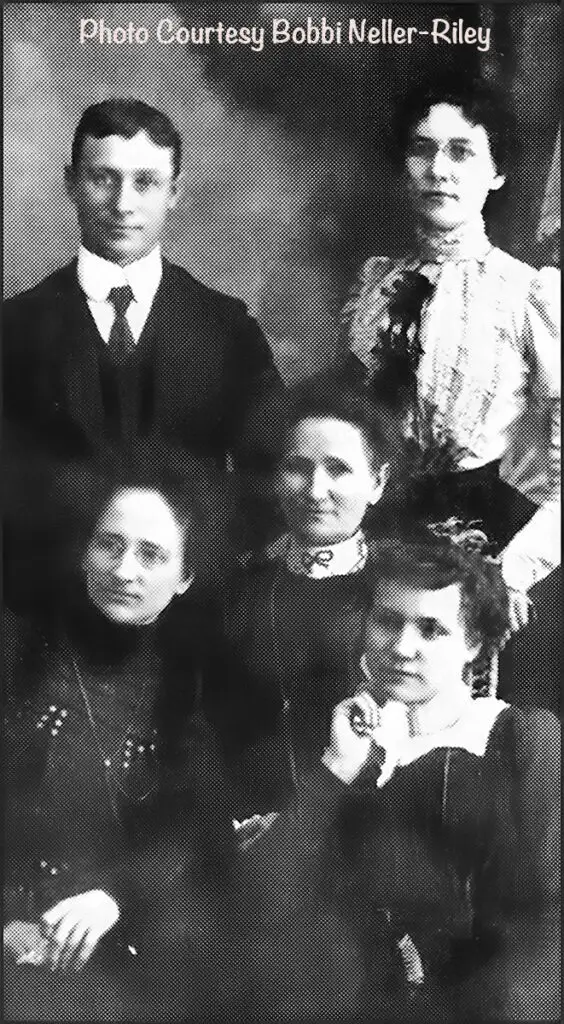
Quite a few years have passed since I became acquainted with a person via the internet named “Bobbi” (Roberta) Neller-Riley. At the time she was living in Santa Maria, CA. (She was surfing the net one day and came across one of my webpages.) Bobbi, it turned out, is a great-granddaughter and granddaughter of late Vermilionites George and Elton Fischer (respectively) who operated a rather prosperous lumber business during the latter part of the 19th to the mid 20th centuries in Vermilion. Thanks to her their names, faces and stories have appeared in this column numerous times over the years (VPJ 1-22-02, and 7-6-06). In brief, this is, and continues to be so as evidenced by the accompanying photo, an historically relevant digital connection to over a century ago from 3000 miles away. Amazing.
But even more amazing may be the relationships that existed amongst citizens of the Village of Vermilion, Ohio 100 years ago. It should be of no surprise to anyone that in a hamlet that, then, only consisted of roughly 1500 to 2000 souls that kinships among the townsfolk would be both strong and numerous. And so, it was. However, during the passage of those 100 years these obvious relationships are likely to become less and less obvious until they are nearly, or sometimes completely, forgot.
Many older townsmen in our pretty city, for instance, will recognize the name, if not the face, of a gentleman named Andrew E. Beeckel. Mr. Beeckel’s name is known by most persons familiar with local history because he was for many years Vermilion’s funeral director. During the last century he kept a parlour in the shop(s) situated between what is now (2022) Brummer’s Candy Store (north), and Tiffany’s flower shop (south) on Main Street.
Late Vermilionite Henry “Hank” Fischer, in his 90s, made some mention of him in his oral histories of Vermilion at the local library. And advertisements for Beeckel’s professional services and furniture business regularly appeared in the local weekly newspaper “The Vermilion News”.
Mr. Beeckel was a very busy person. He had entered the furniture business in 1903 and in 1905 began his funerary business. It lasted until his death in 1942. As an aside it might be helpful for some readers to understand that furniture sales by persons engaged in the funerary business was not unusual. In fact, it was more the rule than the exception.
Aside from that, he had also been engaged as a partner in his brother-in-law’s lumber business, one of the first to engage in “small net” fishing in town, a volunteer fireman for 52 years, a past commodore of the Vermilion Boat Club, founder and a past president of the Vermilion Rotary Club, had served as a member of the Erie County Board of Education and, last but not least, had been a collector for the Ohio Fuel Gas Company. As said, he was a “very busy person”.
But back to the photograph. Mr. Beeckel is pictured (here) standing next to Elizabeth “Lizzie” Liberman Fischer. The ladies seated – from left to right are Mary “Mame” Beeckel, Catherine Liberman, and Blanche Liberman. Their apparel suggests that the photograph was taken about 1902. The location is unknown.
Now about their relationships. “Lizzie” Fischer was Andrew Beeckle’s older sister. She was married to Vermilion entrepreneur and lumberman George Fischer. “Mame” Beeckel was Andrew’s younger sister. Catherine was their stepmother. And Blanche was Catherine’s older sister. But hold on folks it doesn’t end here.
At the time these shadows were captured by an unknown photographer Catherine was married to a Vermilion businessman by the name of John W. Krapp [pronounced “crop”]. Mr. Krapp was the proprietor of a well-known Vermilion hostelry called the Lake House which at that time sat on the southwest corner of Liberty Avenue and Division/Main Street. In time Lizzie’s husband would purchase the hotel, move it down the hill (to the southwest corner of Liberty and Exchange streets where it stands today) and name it after their children Maud and Elton.
To further illuminate / confuse matters folks should know that John and Catherine Krapp also had four additional children: Helena, George, August, and Carrie. So, unlike the razor-sharp images in this beautiful photograph come 3000 miles to afford us a glimpse of Vermilion folks one century ago the relationships among those in the photo are nearly, if not completely, enigmatic.
Ref: Ancestry.com: U.S. Census 1880, 1910; Special Thanks to Bobbi Neely-Riley, Santa Maria, CA. – Adapted From “Yesteryear” in the Vermilion (Ohio) Photojournal 2-1-07; Rev. 01.39.21.
Vermilion resident Rich Tarrant is Curator of the Vermilion History Museum and a son and a grandson of the late proprietors of The Vermilion News (1897-1964). Readers may email him at: rnt@twc.com
© RNT January 31, 2022


Sometimes when I’m talking with a friend like Vermilionite Larry E. Howell or one of my sisters, Nancy, Ginny or Ginny’s husband Dave Wilkes we get lost yakking our way through Vermilion history and some of the folks who once cast long shadows on the landscape of the town. The mention of one name can go a long way. Everyone has a story.
Take C.A. “Charlie” Trinter (b. 1873) for instance. I never knew him because he passed when I was quite young. But as I meander through the history of the community his name and picture come up quite often. Whether I’m talking about groceries, insurance, real estate, schools, fishing (perhaps a tiny bit of bootlegging), politics, automobiles, or the Liberty Theatre – he’s always somewhere in the mix. Charlie’s grandson told me that his granddad owned a Hudson Terraplane automobile. (A fact that made me envious because it was really a “cool” car.) And Charlie was also very likely one of the very first Vermilion guys to ride in an airplane. When Aero-pioneer Tony Jannus landed his bi-plane on the beach at Linwood Park Charlie, as well as local haberdasher Lewis Englebry, got to ride in the aircraft to Cedar Point and back.
I have a fair number of photos of Charlie. One celebrates the afore mentioned airplane ride with Jannus. Another is a formal portrait of a time when he was (I suppose) the Commodore of the Vermilion Boat Club. Both have prominent places in the history museum. Others are less formal – in a group of men dressed as clowns for a Vermilion Day baseball game at the Olympic Outing Club. I also have a photo of the C.A. Trinter fish tug. As I said, “he’s always somewhere in the mix”.
Charlie’s wife was Edna Mae Parsons (b.1875). Her father, Cory (b.1846), was the son of Burton (b.1802) was a brother to Alva, Almon and Burt Parsons. All well-known Vermilion guys. Both families (Trinter and Parsons) go back to the very early days of the place we know as Vermilion.
Anyway, Charlie and Edna had two children – Robert and Martha. Robert was a lake captain and Martha married a handsome doctor from (I think) the LaGrange area. His name was Russell Dickason. Dr. Dickason, although not a bonified Vermilionite, became one. As such he knew, and passed on, numerous historical anecdotes for persons like late Vermilion historian George Wakefield as well as myself to relish.
One of those stories (used by Wakefield in his book Lure of the Lakes) told of the time when Lake Erie Legend “Big Ed” Lampe first came to Vermilion. He tied up his sailboat at the Kishman docks and was walking through the area we now know as Exchange Park when he heard someone call for help from inside an old shed. Lampe went to the shed, unlocked it, and freed a poor fella inside. It turned out that the shed was at the time being used as the town “lockup”. And the poor fella inside was none other than Gib Snider who had likely earned the accommodation compliments of John Barleycorn.
Dr. Dickason’s stories must have made a great impression on his children because his youngest daughter, Kathy, has recently written a memoir wherein she describes her father. While he was indeed a physician she expanded on him some including his skills as “a wood-worker, a waterman, a repairman of anything broken, an avid reader, a banjo player, a fisherman, an inventor, a golfer, a history enthusiast, an artist (he made prints from original woodcuts), and was a model ship builder extraordinaire.”
But the real reason I mention Kathy here is that she, like her dad, is also a talent. Her memoire “Afloat” is an account of a young girl coming of age in our little town in the second part of the 20th century. I can really identify with it because it runs parallel to my own experiences.
In her teens she befriended a girl in my neighborhood nicknamed “BeeGee”. She describes their adventure (or misadventure) while exploring a frozen Lake Erie; also, of her adventures with her horse, Blondie, her dog Laddie and good friend Nadine on the trails that ran along the NYC railroad tracks on the west side of town. Most if not all the persons and places she writes of I know / knew as well: The river, Crystal Beach, the Vermilion Lagoons, The “Bridge”, Tommy Roberts, Sammy Anastas, Lynn Creel and Jackie Jeffery, ad infinitum.
Her mention of Jackie Jeffery takes me in a new direction. Jackie’s grandfather, for instance, had been a very popular Vermilion doctor (“Dr. Jeff” to school kids). He was killed on his way to make a house call when his auto was hit by a speeding locomotive at the Adams Street crossing in 1929. Unfortunately, Jackie (Dr. Jacques Jeffery Herold) who had made her home in the state of Texas some years after leaving Vermilion, lost her fight with ALS and passed into eternity on December 22, 2019. But that’s another story. You see, all it takes is a name.
Vermilion resident Rich Tarrant is Curator of the Vermilion History Museum and a son and a grandson of the late proprietors of The Vermilion News (1897-1964). Readers may email him at: rnt@twc.com
© RNT January 23, 2022

In 1913
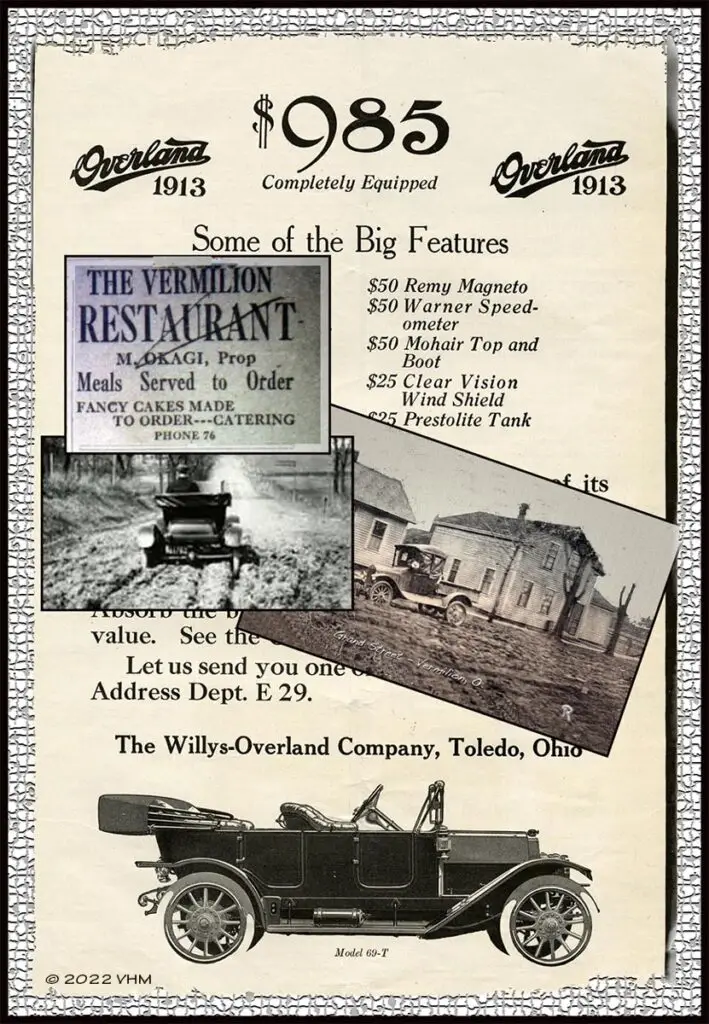
In the November 6th, 1913, issue of the Vermilion News the results of the local election for Mayor of the village showed that F.W. Wakefield had carried the day by beating H.R. Williams by only six votes (167-173). It would be Wakefield’s second and last term in that office.
But no matter the size of the vote it was a tight race. Both men were extremely capable leaders. But they had demonstratively different styles of administering the duties of that office. Mr. Wakefield was a strong administrator, organizer, and planner. Mr. Williams was a populist leader who readily understood and empathized with the daily trials and tribulations of most citizens. And the result, as indicated, was that they went about administering the government of the village differently. Yet, whether one agreed or disagreed with their styles both were held in high esteem by all who knew them.
The News also reported that in 1913 there were only 2 saloon licenses allowed in the village. (Can you imagine that?) The problem was that one license had already been awarded and there were three saloons. Both John L. Becker who at that time ran the saloon at the Maudelton Hotel and a retired fire tug Captain named James F. Nolan who had kept a saloon on Division Street since 1896 (currently – 2022 – known as the Woodstock Cafe) claimed the rights to the remaining permit. The dispute went to court in Sandusky. And when the proverbial dust settled Mr. Nolan was declared the victor.
And then there was a notice at the bottom of the front page of the News from an obviously upset local confectioner named George Otto. He wanted folks to know that a story about him selling sandwiches for 25¢ each and coffee for 25¢ per cup during a November snowstorm was not true. He added that he would give $50 to anyone that could prove that he charged more than 5¢ for each during that storm. (25¢ would have been about $7 today. A nickel would be $1.41 in today’s currency.)
Toward the end of the year there was another interesting development that, at least from my perspective, presaged the coming of a new chapter, not only in Vermilion, but all across northern Ohio and perhaps our nation as well.
On December, 11 1913 a good roads meeting was held at Lorain with some 400 members of the “Ohio Good Roads Association” of Lorain, Vermilion, Huron and Sandusky as well as numerous interested citizens. Among those present from Vermilion were C. F. Decker, William Parsons, L. A. Dall, J. R. Dall, F. W. Wakefield, E. H. Wakefield, L. H. McQueen, H. B. Kishman, Lou Braun, Ed Kishman, C. F. Dixon and Geo. Risdon.
Many persons spoke out about their interests in the Association. As a consequence, preliminary plans were made to have the road from Lorain through Vermilion and Huron to Sandusky designated a market road and to promote for it to be established as a government or national highway. Clearly this was the initial, albeit rudimentary, step toward the creation of roads that would facilitate motorized vehicles. It was a step or two ahead of muddy wagon paths and dusty roads across the north coast of Ohio.
As if to add a footnote to this report it’s interesting to note that Captains W. H. Moody and Charles Gegenheimer were at the time learning (as some tongue-in-cheek reporter put it) “the art of navigating automobiles”. Each man had purchased a “fully equipped Overland car”. The News report also observed that the sailors were getting so good at it that they were able keep their “land crafts in the proper channels about town”, although they seemed to have found the going a little rough.
Just before Christmas in 1913 The, aforementioned, good roads committee from Erie, Lorain and Cuyahoga counties met in Columbus with Ohio Governor James Cox and the Road commission in regard to the proposed road from Cleveland to Sandusky. Both the Governor and Commission looked with favor upon the project and accepted the offer of the committee to provide for two thirds of the cost of the road if the state would furnish the other third. The road was to cost approximately $700,000. It was to consist of brick or concrete and be 16 feet wide. It was to be known as a “Main Market Road” and it was hoped that it would become a section of one of the Great National Highways across the continent.
Another very interesting blip also appeared in the paper during that time. It seems that a Japanese fella named M. Okagi, had purchased a place formerly known as the Carr restaurant and was open for business. A point was made to let folks know that Mr. Okagi “was not the same Japanese” person who had operated a restaurant in Lorain, as well as a “chop suey” joint in Vermilion the previous summer. (Note: I believe Okagi’s first restaurant in town, he called the Vermilion Restaurant was located in the building currently (2022) occupied by the Old Prague Restaurant.)
Times were certainly changing. 1913 had been a good year in the village. No doubt all were confident that 1914 would be even better. Perhaps.
Vermilion resident Rich Tarrant is Curator of the Vermilion History Museum and a son and a grandson of the late proprietors of The Vermilion News (1897-1964). Readers may email him at: rnt@twc.com
© RNT January 16, 2022

Add Your Heading Text Here
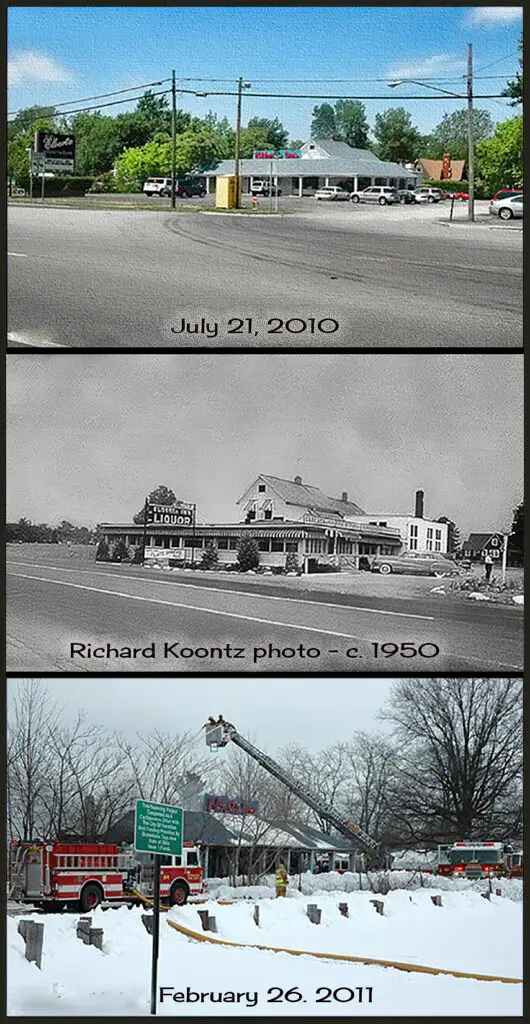
For over a year I’d been struggling at putting together a pictorial history of the Vermilion area. One Saturday morning, as I was grinding away at the task, my sister, Nancy Alice, called to tell me that Vermilion’s landmark Elberta Inn restaurant was ablaze. She said, “I thought you’d want to know.” And I did.
Coincidentally (and I’m not prevaricating), I was transferring the photographs that accompany this essay to another image format (i.e. from “jpg” to “eps”) requested by a publisher, when I received the call. (Truth is indeed stranger than fiction.)
Unfortunately, I don’t know every “little” detail about the history of the Inn at Elberta. What I do know is that the Inn along with Crystal Beach Amusement Park, the Vermilion-On-The-Lake Club House, and the Ruggles Beach Dance Hall allowed local fans an opportunity to listen and dance to the music of many nationally known bands / orchestras. This covered the years from about 1925 on into the early ‘50’s. In the later years bands still played, and dancers still came to dance at Elberta. But the day of “big band” performances at local venues had passed.
In 1912 the man who started it all – George W. Hess – opened the Inn at Elberta Beach amid an orchard of Elberta peach trees in Vermilion, Ohio. Mr. Hess was, professionally, a cook who became a restaurateur – a very good one. [The Inn, incidentally, preceded the establishment of Vermilion’s Helfrich (later) McGarvey restaurant.] If the food at the Inn was excellent – which it was the entertainment was superb. From 1925 to 1940 nearly 90 different dance bands entertained patrons throughout each year. Among them were Duke Ellington, Kay Kyser, Sammy Kaye and his Swing and Sway Orchestra, Jimmy Dulia, and many, many more. One of the local bands that played at the Inn was the Floyd Hays Orchestra. The Elberta, unlike most dance halls in the region, was open 12 months a year.
Sometime during the early 1950’s Routes #6 & 2 (Lake Road) from the Lorain County line into the city of Lorain was transformed from a 2-lane into a 4-lane highway. To make way for this expansion several homes and businesses had to be moved. Consequently, the Elberta Inn was “picked-up” and moved back (north) about 50 feet from its original location (middle photo). During the 1960’s the restaurant was given an attractive facelift (upper photo) which it maintained – until the morning of Saturday February 26, 2011
Mr. Hess, along with his wife Gertrude (Nickley), operated the successful restaurant / night-club until his death in April of 1962. Mr. Hess’s daughters Helen (Horton) and Anna Mae (Gannett), as well as Gertrude’s brothers and sisters – the Nickley family – were, and remain, well known and respected members of the community. Helen died in 2006; Anna in 2008; and Gertrude passed away in 2010.
From about 1996 until the fire the owner, Ali Sabbaghzadeh, guided the operation of the restaurant then known as the “Alize At Elberta”. During that time the restaurant earned a growing reputation for its food – especially its garlic soup. Mr. Hess would have, no doubt, been delighted. Unfortunately, however, prospective diners may never get a chance to try it. For the “Elberta” of that yesteryear is no more.
Vermilion expatriate Hugh Darley who was, back in the ‘70’s, affiliated with the inn emailed me Saturday afternoon following the fire saying, “Sad…another Vermilion Landmark gone. Of course, it’s especially sad for me but I have many pictures (customer pics) of my tenure there.” Another Vermilion expatriate, Bill Hlavin, also messaged me saying, “Another Vermilion Land mark disappears!!!!” As for myself all I could say is “For Auld Lang Syne, my friends, for auld lang syne.”
Ref: Richard “Dick “Koontz Photo Archive – Ritter Public Library; Chronicle Telegram, 10/15/1924; Sandusky Register, 4/11/1962; Chronicle Telegram 4/29/1963; Big Bands on the Lakefront, compiled Burton Nesbitt, 2002; Special thanks: Pamela Seymour; Barb Ruggles; and the Vermilion Area Archival Society; VPJ, 3/03/11; Rev. 01.10.22.
Vermilion resident Rich Tarrant is Curator of the Vermilion History Museum and a son and a grandson of the late proprietors of The Vermilion News (1897-1964). Readers may email him at: rnt@twc.com
© RNT January 9, 2022

A Boy and His Red Bike
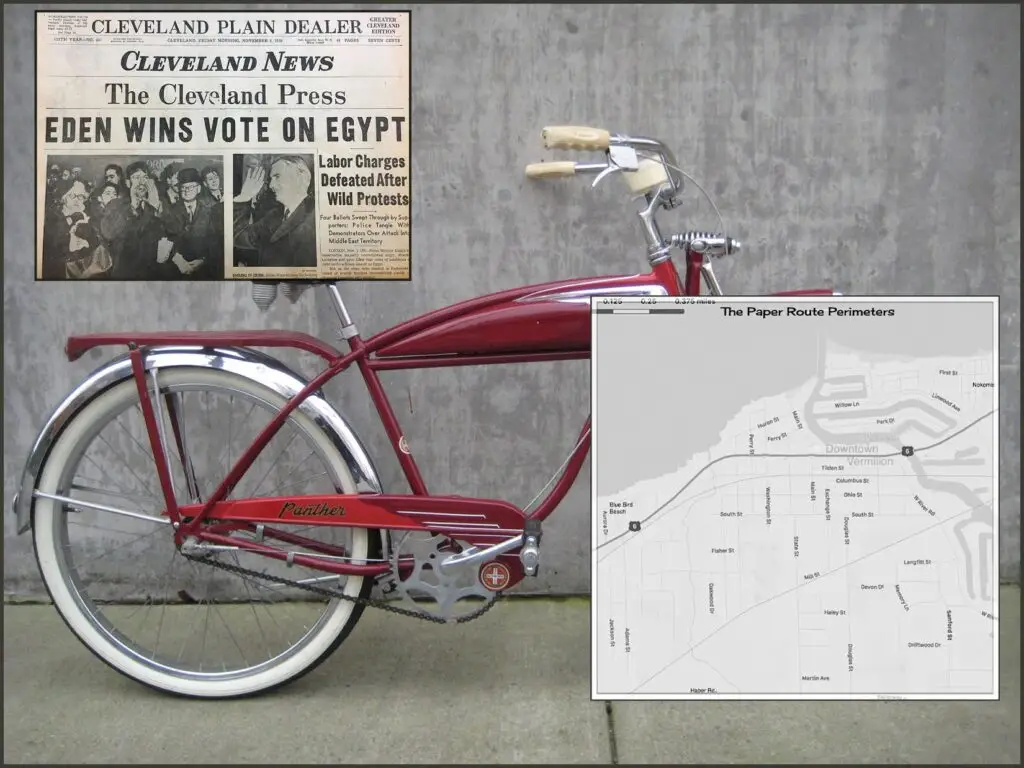
One, if not “the”, best Christmas presents I ever received as a boy was a red bicycle. Looking back now, I think that the big reason I consider the bike to be the best present I ever received is because I never expected to ever have a “new” bicycle. I was truly satisfied riding an old girl’s bike. I was about eight or nine years old and had been using one of my older sisters’ bikes to zip about town for months. I didn’t mind though. Having wheels – no matter whose or how the appeared – was just wonderful.
The bike was bright red, my then favorite color. It also had white-wall tires. It was, again, just wonderful. There was no snow on Christmas Day that year. It was cold, but it was also sunny. It was truly a good day. And so, too, were the days that followed. Soon I had a paper route and had added a basket to the front of the bike to help carry the papers. I had visions of adding a radio (they did have them for bikes back in the mid-1950s) so I could listen to rock and roll music while I delivered newspapers. But that’s all it ever was. A vision.
My first newspaper route (aside from the one delivering my parents’ weekly, The Vermilion News, about town) was delivering the daily editions of the Cleveland News and Cleveland Press. That route didn’t have many subscribers about Vermilion. Those that did subscribe were scattered all over the village. It was like someone had taken a half a handful of stones and tossed them about town.
The perimeters of the route ran east to Nokomis Park (including the Vermilion Lagoons), west to Bluebird Beach, north to Lake Street and south to Maurer’s Lane / Haber Road. It was a journey. But it was a good job for a kid with a red bike. It had its ups and downs.
In good weather it was a pleasant ride. In bad weather it could be trying. I recall one rather brisk winter day trying to peddle (west) down Langfitt street. The wind was blowing so hard that I could hardly make way standing on the pedals. And the wind was so cold it burned my cheeks and brought tears to my eyes.
In those days Langfitt Street and only parts of Sanford and Devon Drive had been built. There was no way to access those streets. One had to ride up West River Road to access that area. There were no through streets from the west. This was before the Valley View development. Fortunately, the good days outnumbered the bad and I kept on peddling.
One of the upsides to the task was my ability to read and ride at the same time. Growing up at the family’s print shop I had a natural affinity and desire to keep up with the news of the day. So, as I delivered, I familiarized myself with the daily activities of people on the planet. Thus, in some respects the rather large borders of the route gave me time to read and to think about the world beyond. In short, I knew who the players were and what they were about.
I “liked Ike” but also thought a great deal of Adlai. (Politics was a bit more cordial between opponents in those days.) I followed the daily drama following the murder of Dr. Sam Shepard’s wife, Marilyn in nearby Bay Village: On July 5th, 1954, the Cleveland Press reported on the preliminary investigation of the murder of Marilyn Sheppard. I idolized Boston Celtics guard Bob Cousy (I later wore his No. 14 when I played basketball in school); followed the antics of Jimmy Piersall with the Indians and later followed the career of a guy named Tito Francona.
All these things I learned while riding my red bike up and down the streets of Vermilion. I learned the nuances of the walks (where they were broken or where they had been lifted by tree roots – where the puddles were); I knew every short-cut (at one time I could ride from the west to the east side of town without needing to stop). I learned the hard way that it was not a good idea to ride down the hill at the Olympic Club (at one time they kept a chain across the drive at the bottom of the hill). I had skinned knees and elbows, torn pants. But most importantly, I was happy. Vermilion was a (again that word) “wonderful” place to be for a boy and his red bike in the yesteryear. I hope it still is.
Vermilion resident Rich Tarrant is Curator of the Vermilion History Museum and a son and a grandson of the late proprietors of The Vermilion News (1897-1964). Readers may email him at: rnt@twc.com
© RNT January 2, 2022

Remembering Vermilion Fire Chief: Roy Hurlbut
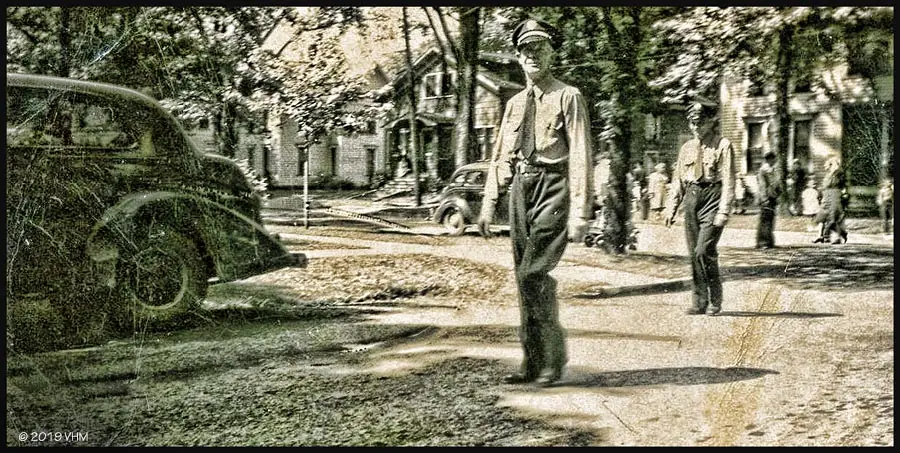
During my lifetime in Vermilion I have known a good many of Vermilion’s Volunteer firemen (my big brother Bill and brother-in-law Dave Wilkes among them) – but I’ve only really known one or two fire chiefs. I knew Gene Kropf and I knew John Fischer. But I never knew the long-time Chief William Adam “Dad” Tischer, and I really wasn’t aware of Chief Roy Hurlbut until a few years ago.
The interesting thing (to me) about Mr. Hurlbut is that he was chief of the department for 13 years and he had lived in Vermilion for 54 years (on Exchange and Ohio streets). I guess that only goes to show how much I don’t know about my hometown.
Roy Hurlbut was born in Amherst, Ohio on August 3, 1880. Growing up there I don’t believe (and this is my opinion only) that his life was, as some might put it, “a bed of roses”. The year 1900 found him and his mother, Ellen, servants in the home of George and Annie Quigley. George Sr. was a farmer, and his son, also named George, was a doctor. [I don’t know if this Quigley family was related to the Vermilion Quigley family. A gent named Reber Quigley was one of the town’s old-time doctors.]
In any case, by the year 1910 Roy was living in Vermilion, and he and his wife, Lizzie, had two daughters – Blanche (4) and Norma (3). He was initially employed as a fisherman. By 1920 he had worked up the job ladder and was working as the foreman at one of the fish houses. I’m conjecturing again here, but I believe he may have been working for the Kishman Fish Company.
By the 1930s, he had taken leave of the fishing industry and was employed as a motorman for the Lake Shore Electric Railway Company. After the L.S.E. ceased operations, sometime around 1938, he went to work for Vermilion’s F.W. Wakefield Company, where he remained for 11 years until retiring in 1955.
Roy was a Vermilion Volunteer fireman for many years before he was appointed chief in 1940 after the long time chief (44 years), “Dad” Tischer, retired at the age of 80 years. Roy retired from the fire department in 1953 but not from life. Among other things, he was also a trustee of Maple Grove cemetery, a member of the Fish and Game Association, Woodmen of the World (an old fraternal benefit organization), and the Evangelical and Reformed church.
The accompanying photograph is that of Chief Hurlbut marching in a parade. He died on March 25, 1958 while visiting his daughter Norma Huene on Indian Hollow Road in Elyria. I found the accompanying snapshot of him while going through a box of old photographs at the Vermilion History Museum. Fortunately (and thankfully), some astute person had identified him in pencil on the back. It was taken while he was participating in what was likely a Memorial Day activity on Ohio Street near the corner of Division / Main Street during the late 1940s or very early 1950s. I’m glad I found it. While I’m sure many local firemen and citizens knew of him I did not. He is most assuredly one of those persons of yesteryear who needs remembering.
Ref: U.S. Census data: 1900 through 1930; the Elyria Chronicle Telegram 03/26.
Vermilion resident Rich Tarrant is Curator of the Vermilion History Museum and a son and a grandson of the late proprietors of The Vermilion News (1897-1964). Readers may email him at: rnt@twc.com
© RNT December 27, 2021

A Voice from Christmas Past - Reverend A.C. Pretzer
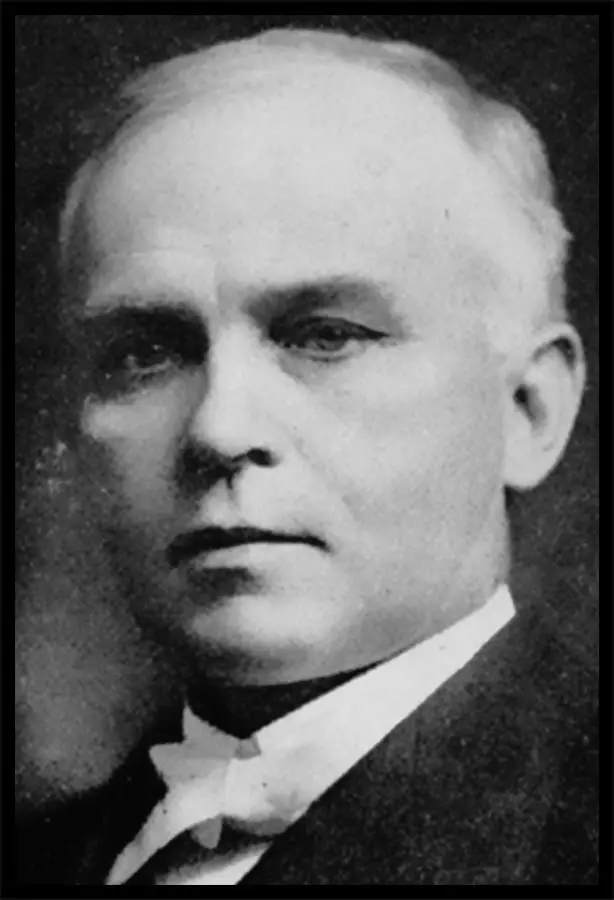
During the mid-19th century political turmoil in parts of Germany became the catalyst for peoples to migrate to the United States of America. Of the thousands of families that left their “Fatherland” some 100 of them chose to settle in Vermilion, Ohio. More than a few of their names are still familiar to local citizens: Abel, Fischer, Gegenheimer, Griesel, Hahn, Neiding, and Schmidt (to name only a few).
By both nature and habit, they were a religious lot accustomed to having a church home where they could attend services and prayer meetings on a regular basis. In the Autumn of 1852, they organized a church organization. Early the following year church officers purchased two lots on Grand Street for $75 and on May 2 construction was begun. By late November of the same year the congregation assembled for services in the new church. However, formal dedication ceremonies weren’t held until December 31, 1854. Total construction costs were $724.
Less than 20 years later that church became too small for the growing congregation, so it was sold at auction and moved to a site by the river. The new church, which forms the nucleus of the existing Evangelical and Reformed Church on the corner of Grand and Ohio streets, was formally dedicated in February of 1896. By this time a young minister named Albert C. Pretzer had already been in the service of the congregation for six years.
During Reverend Pretzer’s pastorate. (1890-1901 and 1909-1919) he saw many building improvements. New doors which would swing outward were installed; the church was wired for electricity; a new furnace was installed to replace two wood stoves located at the back of the sanctuary; the building was raised, moved back some from the street, and placed atop a new basement that had been dug by hand during the moving process. Rev. Pretzer had (at that time) been in service of the church longer than any of his predecessors.
And it was during his tenure as pastor of this congregation that he reflected upon his childhood, and what his parents had taught him and his four siblings about the meaning of Christmas.
Both Pretzer’s parents were born in Germany. So as previously stated about the religious natures of Vermilion’s German settlers his early home environment was very similar. His family considered Christmas to be “the most joyous event of the whole year.” And “waiting for its annual recurrence seemed like passing through a small eternity.”
Every Christmas the Reverend’s parents would have each child choose a passage in the old German Hymn book they had carried from their homeland describing the Nativity of the Christ Child and commit it to memory. And then, on the Eve of Christmas, each child would be expected to recite that passage in the candlelight of the tree in their home without stammering. Later they would repeat their performance(s) at the festival in their church.
And it was also from his parents that he learned the symbolic meaning of the tree. “Its evergreen was to represent the never changing love, grace, mercy, and power of Christ. The candle lights represented Him as being the light of the whole world. The exchanging of gifts referred to Christ as being the unspeakable gift of a Father to a lost world.”
Although he considered his family’s way of celebrating the event to be rather “simple,” it undoubtedly “had a good and lasting effect” upon his charge. Persons who pass the old church on Grand Street may now come to recognize just how such spirit within helped influence the lives and, consequently, the history of the people who lived (and still live) in the town surrounding it. [Have a wonderful, prosperous, and peaceful Yuletide.]
Ref: The Vermilion News; 12-14-22; Ancestry.com; US Census; 1910 & 1920; Published in the VPJ 12/23/2004; Rev. 12/19/21.
Vermilion resident Rich Tarrant is Curator of the Vermilion History Museum and a son and a grandson of the late proprietors of The Vermilion News (1897-1964). Readers may email him at: rnt@twc.com
© RNT – December 19, 2021
.
Vermilion’s “Bucket Brigade”
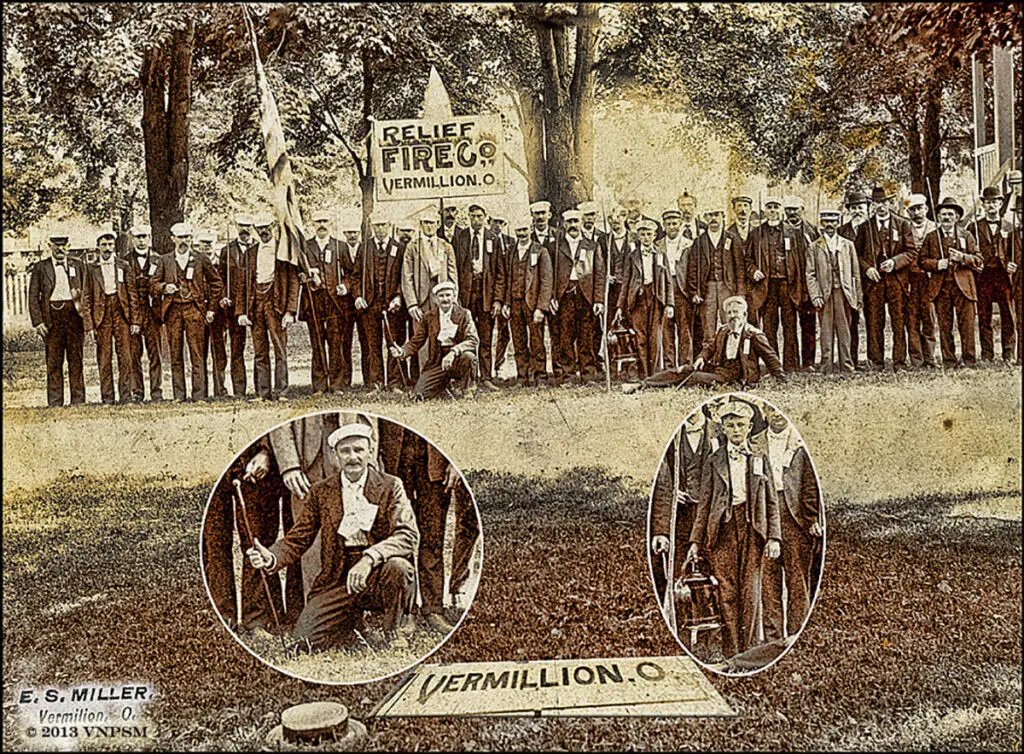
The photograph accompanying this monograph has, for reasons I will not herein detail, caused me no small amount of grief in the past. And while I am pleased to have discovered it squirreled away in a manila envelope on a near invisible roll-out shelf beneath an old stone make-up table at the print shop – I really, really wish I’d found it years ago. But about the photo: It is possibly the oldest photograph of Vermilion volunteer firefighters in existence.
As best I can tell these shadows were frozen in time during the late 1890s or very early years of the 20th century. Vermilion in this photograph is spelled (one may note) with 2 “ells”. While the second ell was officially dropped in 1898 it remained in use by various people and institutions for some years after. However, by the way all these fellows are dressed it is likely that this portrait was taken prior to the name change. My late brother Al referred to this portrait as that of Vermilion’s “Bucket Brigade”. He never told me anything further about it. A professional photographer named E.S. Miller took the portrait. His straw hat, incidentally, lies in the grass in the foreground. Because it is a Vermilion photograph taken by a Vermilion.photographer,
I believe one can safely assume that it was taken at Shadduck’s Grove / Park – currently the site of the Crystal Shore Apartment buildings. The buildings and bandstand in the background seem to substantiate that thought.
Initially organized as the Relief Fire Company #4 in the mid 19th century it was reorganized and renamed the Vermilion Volunteer Fire Company at the dawn of the 20th century. This information also seems to substantiate my thoughts about the date of the photo. Although no physical records exist to document the organization of the company a loosely organized force of volunteer firemen probably existed for some time prior to Vermilion’s official incorporation as a village in 1837.
Vermilion didn’t have a substantial water delivery system until 1904 / 05 so there weren’t any water hydrants in the village. Prior to the time water became readily available fire pumpers were placed near a good water source – such as the river – where they were used to pump water through lengths of hose to the fire. The hand-pumper they used, as the name implies, required as many as 10 men to operate. Given the fact that there were great fires in the village in 1875, 1891, and 1903 a rather large company of volunteers (as seen in the picture) was not merely a luxury – it was a necessity.
The inset photo of the fireman on the left was added because it allows a better view of a cane he is holding in his right hand. All the firemen have these canes. Lacking a better explanation, I make the wide assumption that the canes were gifts to each of the men for their service: A souvenir of sorts. They were likely inscribed. And the inset of the young man on the right shows him holding a large lantern. The lantern was used at night to light the way to a fire ahead of the pumper.
Beyond the shadow of any doubt, Vermilion’s Volunteer Fire Department was the oldest safety-service organization in Vermilion in the yesteryear and remains so today. This is an amazing and extremely historic photograph. And I reiterate, I really, really wish I’d found it years earlier.
Ref: VPJ 04/22/2007; Vermilion Bugle – 1981, History of Vermilion Fire Department by John Fischer; VNPSM Photo Archive; Special thanks to A.C. Tarrant; Published in the VPJ 10/10/13; Written 10/06/13 @ 2:57 PM; Rev. 12/12/21.
Vermilion resident Rich Tarrant is Curator of the Vermilion History Museum and a son and a grandson of the late proprietors of The Vermilion News (1897-1964). Readers may email him at: rnt@twc.com
© RNT December 12, 2021

The “Magic” Lantern
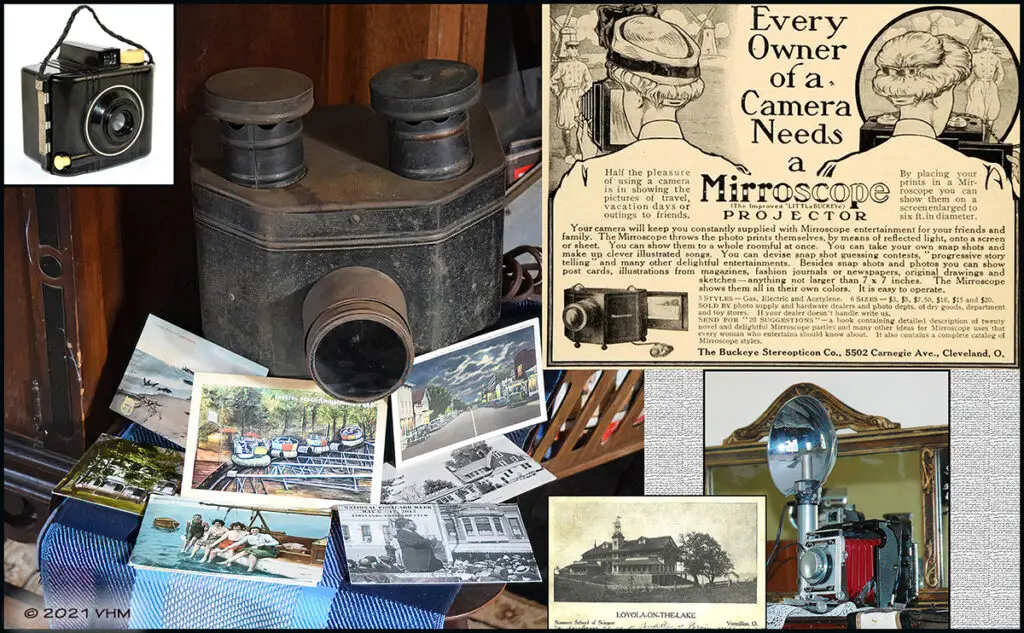
As one might imagine, or at least infer, by my regular referral to and about them; I really, really like old photographs. When I was very young, I recall being infatuated with my parent’s ancient photo albums. They were stored on the bottom shelf of a large bookcase that I, by the way, still possess. I would spend hour upon hour leafing through the pages looking at the faces (they were mostly professional family portraits) of persons that I knew had bitten the proverbial dust long before I was born.
I wondered what their names were and what they were like. What they did, who they loved and who they didn’t. Did they have big families like mine? With a bunch of brothers and sisters? Did they own a horse? Have a dog – or a cat? It was a pleasant way to pass the day before I was old enough for school.
During those days my mother (aside from being our mother) was very active in all types of local organizations: the American Legion Auxiliary; Eastern Stars; “B&PW” (I didn’t knew the letters stood for the Business and Professional Women organization until I was older); the children’s orphanage in Sandusky and of course (but not the least) a women’s circle at the First Congregational Church. And it was because of her membership in the church circle that I first became acquainted with and forever enamored by a thing called The “Magic” Lantern.
It seems that the ladies in the circle took turns at arranging a program for each of their monthly meetings. So, when it was my mom’s turn, she decided that it would be a novel idea to have the women each contribute a childhood picture of themselves that could be used for a game. Using the “Magic” latern she projected one picture at a time on a screen, a cloth or a wall and all the ladies were asked to guess the identity of the child pictured. Well, I don’t know how that party turned out, but I do know that it was my first introduction to this wonderful – this “Magic” – device.
As one can see in the accompanying photograph it really isn’t anything spectacular to look at. It’s not at all sophisticated – just a tin box with two lightbulbs and a lens. It’s a rather simple device. But it’s one that can project and enlarge photographs / images of picture postcards on a blank wall, a sheet, or screen. And while that might not seem like much to most folks today keep in mind that these were still the days when radio was big and television screens were small (12-inch black and white). It was “Magic”.
I could suddenly show large color postcard images to my friends. I could take black and white pictures with the trusty Baby-Brownie Bakelite box camera (pictured). I shared that camera with my sisters. We’d have the film developed at Hart’s Drug Store, and then project the life-size images on an old sheet. It was “Magic”.
My grandfather’s Graflex (pictured) took numerous photographs about town until his death in 1946. In the yesteryear it was not unusual to have many of one’s photographs made into postcards. It was the Facebook medium of those years. While none of his film or glass negative pictures were color photos some were colored-tinted by hand and sold locally. They were nice. But they were amazing to see enlarged.
I don’t know what happened to our original lantern / projector. Like many things in all our lives we move along and lose them in the wake of the passing years. While I vividly recalled what the device looked like I didn’t know its formal name until just recently. Nor did I know that the device was manufactured around 1910 by The Buckeye Stereopticon Company in Cleveland, O. at 5502 Carnegie Ave. It was called a “Mirrorscope” projector.
There were three styles – Gas, Electric and Acetylene – and six sizes – $3, $5, $7.50, $10, $15 and $20. Ours was electric and likely one of the $3 models. Believe it or not that would equate to $83.81 in today’s market. But I can earnestly say after all these years it was worth every one of those 300 pennies. It was in a word, “Magic”.
Vermilion resident Rich Tarrant is Curator of the Vermilion History Museum and a son and a grandson of the late proprietors of The Vermilion News (1897-1964). Readers may email him at: rnt@twc.com;
© RNT December 5, 2021

The Kishman Twine House
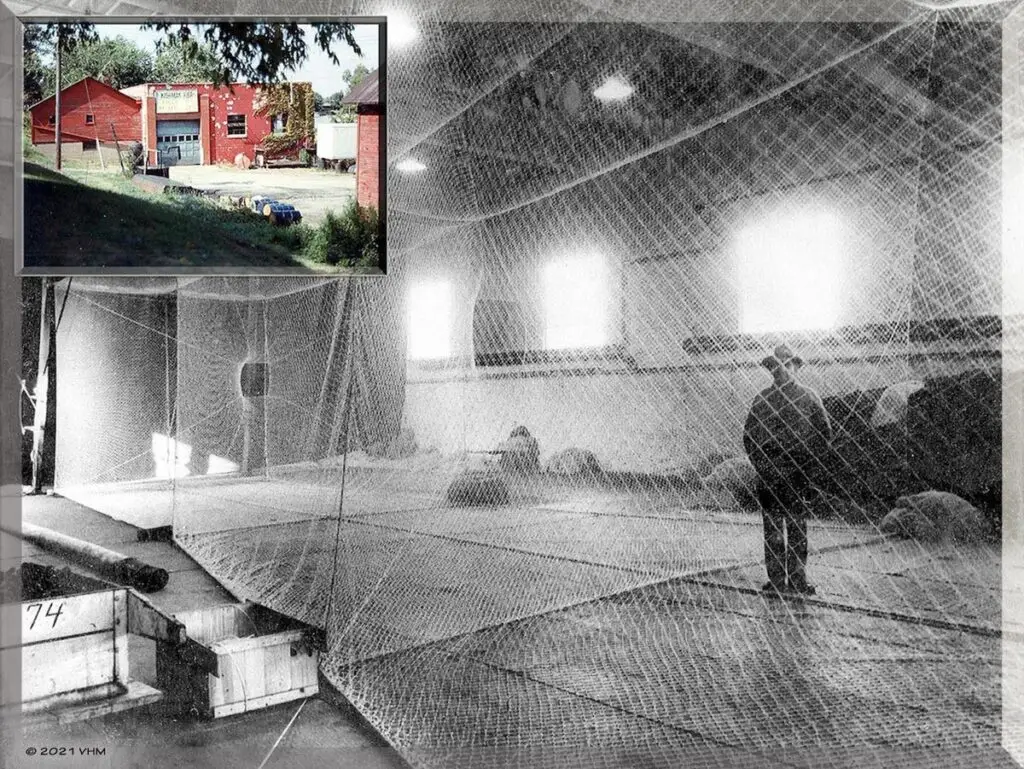
Although Lake Erie is the smallest of the five Great Lakes and ranks 18th in the world by volume of fresh water, it supports at least 140 species of fish, of which at least 18 species are caught by anglers and 11 species are caught by commercial fishers. Because it is the warmest and most biologically productive of all the Great Lakes, its walleye fishery is, far and wee, considered by many to be the best in the world.
In Vermilion, Ohio the end of large-scale commercial fishing was for most citizens a gradual, almost imperceptible, event. The number of persons who might tell anyone the date the last commercial tug sailed from the harbor may literally be counted on one hand (or less). It was not, in short, an event proceeded by glaring newspaper headlines and marching bands. And so it is that folks easily forget that it was, at one time, a major industry of the town – one that fed a plethora of people across America on a daily basis.
Make no mistake about it. The task of catching the tons of fish that would feed the aforementioned “plethora” was formidable. It required exceptional business skills married to the very practical sciences of biology, mechanics, navigation, and weather. Additionally, the physical demand of the work itself was, at times, merciless. It was, therefore, hardly a job well suited for a dull or frail person. Beyond all this there was some essential handcrafting involved in operating the industry that even a person with no knowledge of commercial fishing should be able to appreciate.
From Brownhelm (Ohio) Township historian Bill Cutcher is this wonderful photo of his grandfather, William “Bill” LaCourse, surrounded by a stretched-out trap net inside the Kishman Fish twine house [inset photograph]. Those unfamiliar with commercial fishing may be surprised at the very size of the net. It is, of course, substantial. But more surprising than that (for some) may be the fact that each of these nets were handmade. And like the age-old adage that tells us that “Rome was not built in a day” the same must be said of the building of these nets.
It’s also worth noting that the process of learning to design and sew the nets was not formal (i.e., one did not take a course in net-building at a university). The process was learned by the doing under the tutelage of a seasoned fisherman or two who had learned it the same way. It was essentially a folk craft developed, improved upon, and handed down from generation to generation of fisher men and women. But whatever the case, it is an impressive accomplishment – and sight.
So – those who might wonder how many fishermen spent their time during months when the watery fields of the lake were froze solid need wonder no longer. Much of their time was spent in the twine house puffing on a pipe or cigar and telling or listening to tales of sea and land to pass the winter days whilst the nets grew and took shape by their hands.
The commercial fisherman of yesteryear was a highly skilled worker. It was never a matter of just catching fish. There were, literally, hundreds of things involved in working the industry. Building a net was but one of those things. But it was hardly the least of them.
Ref: Ministry of Natural Resources, Ontario Canada, Lake Erie Fisheries Management – Walleye and Yellow Perch Fishing – 3-31-05; Special Thanks to Bill and Bonnie Cutcher; VPJ 01/20/08; Rev. 11/28/2021.
Vermilion resident Rich Tarrant is Curator of the Vermilion History Museum and a son and a grandson of the late proprietors of The Vermilion News (1897-1964). Readers may email him at: rnt@twc.com
© RNT November 28, 202

Shadows of a Yesteryear
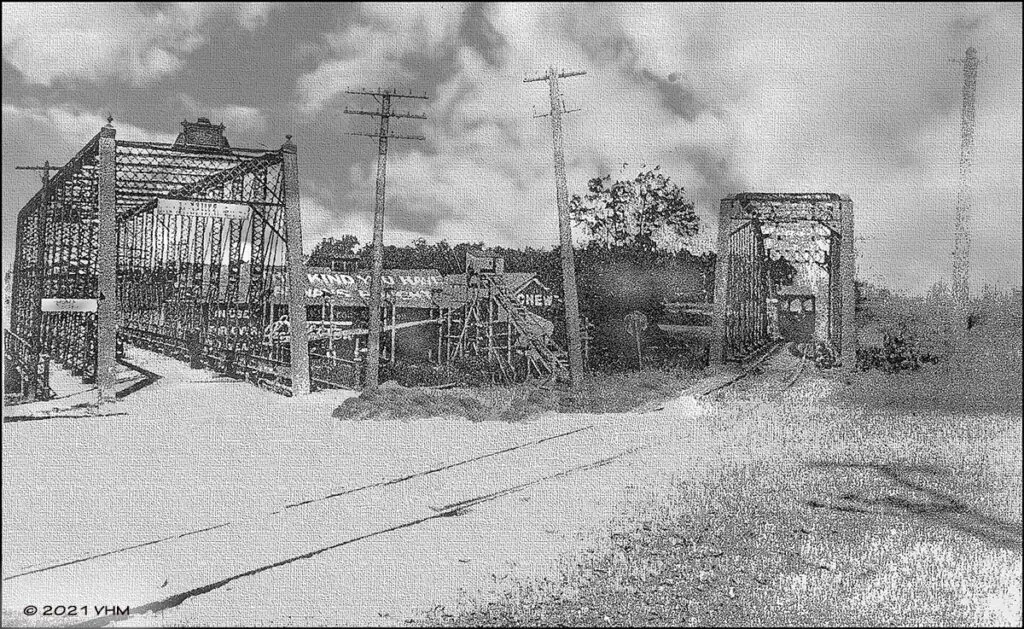
The photo attending this week’s essay was not / is not of very good quality. Nor is it – at least on the surface – a very remarkable photo. I have been familiar with it for several years. But I guess I never really looked further into it until I began tweaking it in Photoshop to make it more discernable.
For those folks unfamiliar with the scene the photo was taken on the west bank of the Vermilion River looking east just a little north and west (in the street) of what is currently the site of Rotary Park wherein Vermilion’s old water-tower is located. Neither bridge still exists. The building visible between the bridges was the H.H. Patton and Captain “Big Ed” Lampe’s Southwest Fish Company. The fishery, like the bridges, has also been relegated to a nearly imperceptible history lesson.
What I found interesting after my umpteenth look at the photograph was the extreme closeness of the bridge landings on the west side of the river. I also noted that there are vehicles on both bridges. The bridge on the right was the Lake Shore Electric (L.S.E.) interurban bridge with an electric car on it. And the bridge on the left was the old wagon / automobile bridge with an auto on it. The auto is heading west. I don’t know which way the electric is going. Nonetheless, it occurs to me that there must have been times when both types of vehicles heading west crossed their respective bridges at about the same time and touched the bank at about the same time.
There appears to be enough room for an auto to turn before coming to the tracks; and I have yet to come across any account of any collisions at that site – but it certainly seems to have been an uncomfortably close path for both vehicles to have to follow. For persons unfamiliar with the history of the interurban electrics in Vermilion it might help to know that the tracks ran right down the middle of Liberty Avenue.
The wagon / auto bridge had a wood deck. Late Vermilionite Hank Fischer vividly recalled the clacking sound of the wooden blocks when vehicles (horses or autos) crossed the old bridge. As one can see there were also walkways for pedestrians. [As an aside, there is a an old yarn pertaining to the the muscle of legendary Captain “Big Ed” Lampe wherein someone met him as he was crossing the old bridge carrying several fully loaded fish boxes under both arms. The boxes weren’t light when they were empty. But no problem. Captain Lampe stopped to talk for a good five minutes and never broke a sweat.]
Around 1901, before the electric bridge was constructed, a temporary track was laid over the wagon bridge to allow a party of L.S.E. officials to make an inspection trip of the railway from Cleveland to Detroit. A year later, while using the highway bridge to construct the electric bridge, it was severely damaged when a steam locomotive workers were using proved to be too much for it. Finally, in 1913 the L.S.E. completed the steel truss bridge (pictured) over the river. It remained in service until the railway ceased operations in 1938. The following year when the bridge was being dismantled officials were seriously embarrassed when the crew accidentally dropped the bridge into the river blocking river traffic and irritating many Vermilion residents.
The old wagon bridge was dismantled and replaced by the existing river bridge in 1929. [Note: The old bridge remained operable until the new one was completed.] Remnants of the abutments of both bridges are still visible on the west bank of the river. Only the wagon bridge abutment is visible on the eastern bank. It can be seen between Vermilionite Jon Clark’s former residence and the store / office for Romp’s Marina. Today both the “new” / old river bridge and the old water tower have become Vermilion icons. And the bridges in the photo are mere shadows of a yesteryear.
Ref: Special Thanks to: late Vermilionite Hank Fischer; The Lake Shore Electric Story, Harwood, Korach; Indiana University Press, 2000; VHM photo archive.
Vermilion resident Rich Tarrant is Curator of the Vermilion History Museum and a son and a grandson of the late proprietors of The Vermilion News (1897-1964). Readers may email him at: rnt@twc.com
© RNT – Monday, November 15, 2021

It Can Be Tough Work (Sometimes)
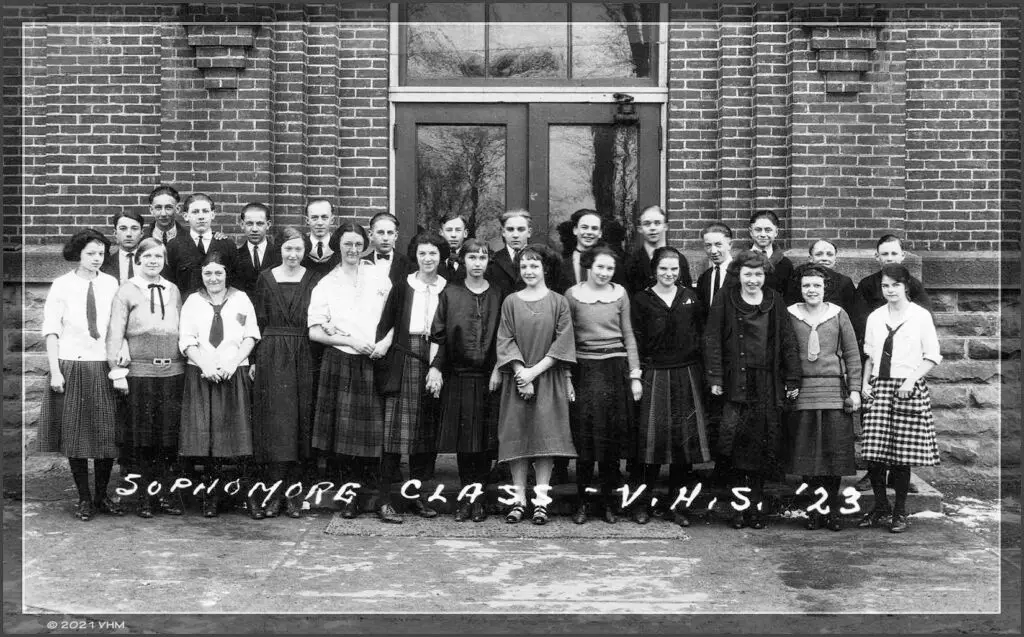
Some years ago, when I was chief cook and bottle-washer (among other things) for Vermilion’s Meals-on-Wheels program I became acquainted with a Vermilion guy named Fred Wetzler and his wife Karylle who were volunteer delivery-drivers. Though Fred was somewhat older than me, we shared an interest in local historical matters. Over the years he shared some photographs and information with me that I’ve found very informational for myself and others.
For instance, his father, Joseph (1873-1924) was Vermilion’s last lightkeeper. After the light was removed Joe (VPJ 2003 / 2006) went on to work for the railroad. Hard of hearing he was struck and killed by a train as he walked down the rails to greet a group of fellow workers that were frantically waving and yelling for him to get off the rails because they saw a locomotive bearing down behind him. (Talk about tragedies.)
Anyway, I’d not seen Karylle for some time. But a week or so ago she came by the museum with a box of Vermilion memories. Among them was the accompanying photo of the 1923 Sophomore Class of Vermilion High School. The photograph was not new to me. It appeared in the 1923 VHS Annual called the “Hi-Times”. The VHS annuals were printed at the Vermilion News print shop from 1919 until WW2.
The annuals are, visually speaking, quality publications. However, they tend to fall short as an informational resource. That’s because the only persons identified in them are the faculty and members of the graduating classes. Group photographs like the one shown here were just that – “group photos”. None of the persons in them were identified.
This maddening problem (at least for genealogists and historians) is because during these years the entire population of Vermilion was only between 1500 to 2000 souls. In short, everyone knew everyone. Identifying all the faces in these group pictures was, therefore, considered to be unnecessary. Also note that this is the “entire” sophomore class – not just a portion of the class. Few to no persons dreamed that nearly a hundred years afteer the day this picture was taken that anyone might like to know all those pictured. But in this case, Fred’s sister, Kathryn, certainly did. And on the back of the photo, she listed all the names. I knew and remembered only three of these persons. But I’m sure that some folks may recognize more faces after being afforded these names.
Girls L-R: Ruth Hamel / Burrows, Norma Hurlbut, Alice Haber / Rathe, Mary Decker / Copeland, Kathyrn Wetzler / Nalley, Bessie Hoffman / Bartlome, Ellen Aldinger / Miller, Jean Obney / Saunders, Claudia Hauff / Sell, Muriel Steane / Ohara, Edith Crum / Fulton / Rougk, Alice Christian / Lockwood, Clara Steane/ Pickering / Hansen.
Boys L-R: Lloyd Bogart, Floyd Heys, Harry Krantz, Carl Carlson, Fred Fredricks, Ralph Hasenflue, Olen Aufderheide, Lawrence Krapp, Earl Ficktel, Edwin Nellis, Laurence Naegele, Earl Knittle, Earnest Zelinski, George Showalter.
I did take things a few steps further and initially made a cursory search of all these people. It’s interesting to follow them through their lives and to learn more about them. Floyd Heys, many persons may recall was a local musician / store owner of some note; and Larry Naegele owned and operated a local grocery/meat market with his brother, later becoming a Chiropodist. And I was somewhat surprised to find Bessie Bartlome in the group. Mrs. Bartlome worked in the school cafeteria when I was a pup. She and her husband, Fred “Fritz” had two sons, Larry and Cliff, who were (not just good but) superb athletes in all sports.
And then I came across the mysterious death of class member Harry Krantz. As an armchair detective I found myself mesmerized by his story. On Tuesday August 20, 1935, Harry’s body was recovered from an inland lake at a popular country club in Columbus. He had disappeared from a club dance the previous Saturday night. Friends said he had become ill and stepped outside “to get some air” and just disappeared. He had not been robbed. He was an automotive engineer and was about to be promoted. His mother was puzzled because he was an excellent swimmer having spent 27 summers at the family cottage on the lake. The coroner ruled his death accidental; that Krantz “just fell into the lake after becoming ill” and drowned. But that’s another story for another time. And Sherlock Holmes I’m not.
As may be obvious, one thing, one photograph, one story, leads to another…ad infinitum. It can be tough, demanding work (sometimes). But mostly, and more importantly, it’s fun.
Vermilion resident Rich Tarrant is Curator of the Vermilion History Museum and a son and a grandson of the late proprietors of The Vermilion News (1897-1964). Readers may email him at: rnt@twc.com
© RNT November 14, 2021

Old Soldiers Never Die…
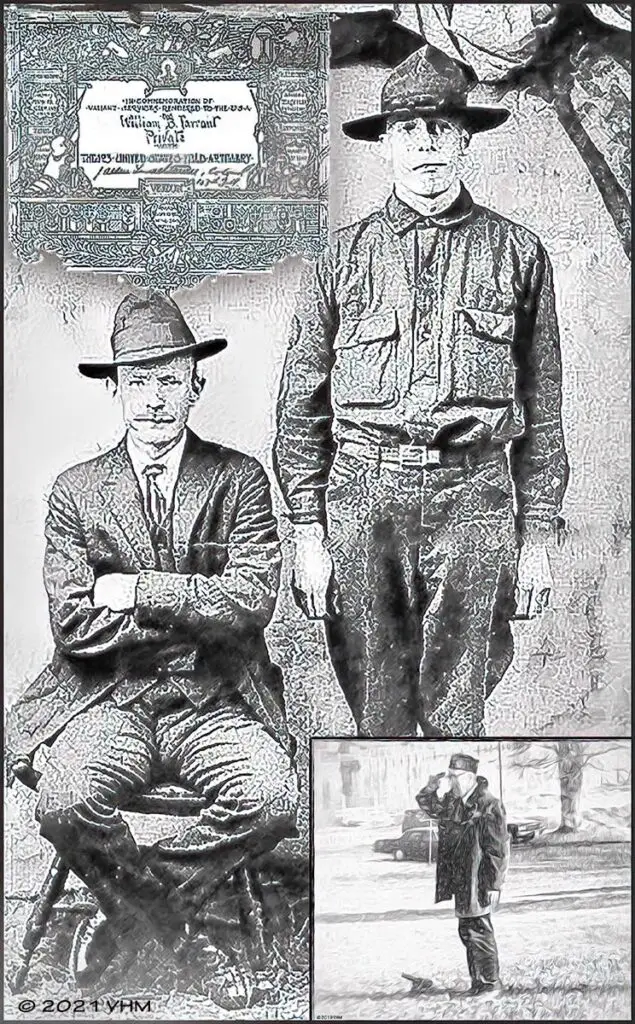
I found most of this “stuff” in a letter written by my paternal grandfather to my mother just after Christmas in 1931. Although World War I had then been over for thirteen years it was obvious that the memory of it was still very vivid in the minds of those who lived during those years. And so, it would always be.
Even so my father must not have talked much about his war – “The war to end all wars” they called it. I would later find in my own experience that such matters only get easier to talk about the further you distance yourself from them. And even then, some of the really bad things are purposely forgotten or never fully aired. Perhaps it’s best that way.
Pop enlisted in the Maine National Guard on the 5th day of July in 1917. Shortly afterward his company was called to Fort Williams and the federal government assumed control over the unit. On the 25th of August he left Fort Williams for Camp Curtis in Boxford, Massachusetts where he joined the 103rd Field Artillery, and started training for overseas deployment.
At the end of September, the company was sent to Newport News, Virginia to collect horses and guns. Shortly thereafter they boarded the transport ship “Kansas” and set sail for the French seaport city of Brest, France. Whilst asea the transport ship encountered a bad storm. They were given up for lost. But 30 days later they somehow reached port having only lost time and a few horses on the cruise.
From Brest Pop’s unit – that was by then known as the 103rd U.S. Field Artillery – left for Neufchateau where the regiment was preparing for combat. From there they went to Soissons to enter “the line” (i.e., to actively participate in the war). The unit was part of the first full American Army Division to land in France in 1917. It is known as the famed 26th “Yankee Division”.
Altogether they spent 205 days on the front line: participating in the Champagne-Marne, Aisne-Marne, St. Mihiel, Meuse-Argonne, and Defensive Sector battle campaigns. They advanced 23 miles and lost 2,281 soldiers during the expedition. 11,383 were wounded.
Just six days before the Armistice (November 11, 1918) Pop fell victim to a mustard gas attack at Verdun and was hospitalized. Afterwards he was supposed to go to a “detention camp” but, instead, set off to find and rejoin his regiment. And on the Eve of Christmas 1918 he found them. In the process, however, his medical records were lost. As a consequence, he wasn’t awarded a purple heart until he was well into his 80s.
Pop was discharged from the service in April of 1919. He was 21 years old. A short time later he left his home state of Maine on a young man’s quest to find his fortune in the west. On his way there he stopped to see his uncle, the Reverend Howard C. Lynch at the First Congregational Church in a little Ohio village called Vermilion. He never left.
For the most part he put the war behind him. But he never ever forgot those he left behind nor those whose war wounds were much deeper than his own. As the years turned, he became a charter member and first Commander of Vermilion’s American Legion Post. And so long as he could he participated in Memorial and Armistice Day ceremonies. He was also the last person to fire one of the big naval cannons in Exchange Park on the 4th of July in 1921. (VPJ 07/12/21). In his later years he fired the little cannon (inset picture) kept by the Legion at football games, etc.
Fresh from the war Pop must not have talked a great deal about his war – “The war to end all wars” – at least to Mom, which explains the letter from her father-in-law. But there was a New Year ahead (1932) and the world was at peace. There would perhaps be time to think and speak of that yesteryear another day.
Personal Papers and photograph from the Roscoe-Tarrant Family Collection; Special Thanks to my family; Published in the Vermilion Photojournal 01/07/10.© RNT 11/07/21
Vermilion resident Rich Tarrant is Curator of the Vermilion History Museum and a son and a grandson of the late proprietors of The Vermilion News (1897-1964). Readers may email him at: rnt@twc.com

Thoughts on a Photograph of a House
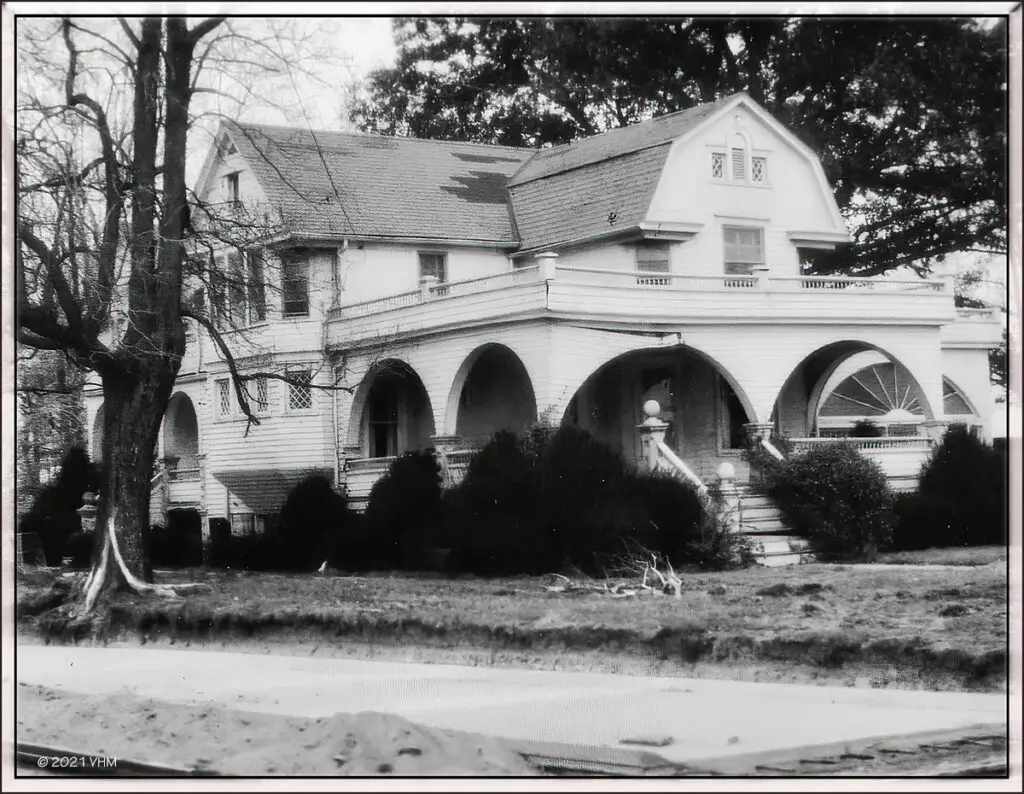
If anyone asks (and I hope no one does) I can vociferate for an hour and a half or more on the reason(s) there is little need to tear down old, but perfectly good, buildings. Yeah, I know some of the intelligences given to justify their destruction(s): i.e. The cost of renovation is prohibitive. The asbestos in the old building will be too expensive to remove and dispose…ad infinitum. And whether I like it or not most, if not all, the reasons given really, but unfortunately have merit. And so, I am slightly bemused by all the small billboards scattered throughout town finely illustrating what was but mostly ain’t any more. But I do get it. Many persons seem to prefer “new” things. Moreover, maintenance of the billboards is not nearly as costly as the “real” thing. But I am rambling.
The photograph accompanying this week’s essay shows what once was one of Vermilion’s finest homes in a state of minor disrepair. This particular domicile probably had more history echoing through its rooms than 99% of 19th century captains homes in Vermilion, Amherst, Birmingham, Berlin Heights, Huron, Lorain, and Sandusky combined. But no matter. It was getting old. You can see in this photo that part of the wood over the entrance to the front porch along with the front steps was coming apart. And the bushes around it, as well as the trees above it, were in sore need of a good trimming. And Heaven knows what the interior might have been like. Consequently, the place was ripped apart and carted off to a landfill to make way (eventually) for a gas station.
This once grand home was the home of Vermilion entertainment pioneers George H. and Josephine L. Blanchat. These are the folks who purchased some acreage on the eastern edge of Vermilion Village in 1906 that had historically been widely known as Shattuck’s Grove picnic grounds. And from it they created an even more popular place to recreate – a Vermilion amusement park – they called Crystal Beach. Along with the rides, cottages, and casino they also built a beautiful dance hall / skating rink they called Crystal Gardens. And what a place that was.
On Friday, May 29, 1925, Mr. Blanchat arranged to have two of the finest orchestras in the nation play host at the grand opening of what was then undeniably “the” most beautiful dance hall to ever grace the banks of the Great Lakes. And though my description may be somewhat “overstated” it is only because I, along with thousands of others, loved the place.
Bedecked in tones of blushing pink and apple green the new hall was capable of comfortably accommodating two thousand (that’s right kids – two thousand) dancers on its hardwood floor. A broad promenade that afforded enough room for nearly the same number of people embraced the dance area. Also included were a new refreshment stand, coat check room, and spacious lavatories. In the decades that followed it was not unusual for folks in the area to enjoy and dance to the music of Sammy Kaye, Count Basie, Les Brown, Coon-Sanders, Louis Prima, Lawrence Welk, Duke Ellington, Xavier Cugat, Tommy and Jimmy Dorsey, Guy Lombardo, and many others.
The Blanchat’s did very well with their enterprise. By 1930 they were making $25 thousand a year. (That would be near half a million in today’s bucks.) Thusly did they build alongside Crystal Gardens their home (pictured) where they raised their two daughters – Thelma and Eleanor. To be sure the park itself attracted thousands of families over the years. But the dancehall attracted even more.
Both Thelma and Eleanor married in 1936. Thelma married a fella name James Calvert. Both were very popular teachers (James was a coach) with the Vermilion Schools. When Mr. Blanchat passed away in 1938 the Calvert’s were living in the big house next to the dancehall with Mrs. Blanchat. The Calverts also had two girls: Marlene and Sandra.
Eleanor married a Lorain policeman name James T. Ryan and had a son. In addition to his job and activities in both Vermilion and Lorain civic communities Mr. Ryan helped manage the park for nearly a quarter of a century following the death of his father-in-law. Ryan’s son, Tom, was the same age as Calverts’ daughter Marlene. My point, especially in mentioning Marlene (now known as Marlene Feldkamp), is because she owns some very wonderful memories of growing up at the park and this home.
She tells of the library with the great pocket doors; the laundry chute, and the cans of 16mm film of the park that were stored in one of the closets etc. But what most enthralls me are her memories of the bands that came to play at the park. They would park in their driveway and come into the home to visit before they performed or during their breaks. One of these great bandsmen even took the time to read a bedtime story to Marlene when she was quite young. Who could’ve asked for more?
But time marcheth on. Someone – an individual or individuals – historically deaf and architecturally blind thought a filling station, bank, and rows of apartment buildings an even trade-off for the properties. But the point is, and will forever remain, moot. And to be candid, hindsight is probably only the historian’s vice. Still some folks still have memories – good and bad – of these missing pieces of the yesteryear that serve to remind us of who we are, how we got here, and hopefully, where we’re headed.
Vermilion resident Rich Tarrant is Curator of the Vermilion History Museum and a son and a grandson of the late proprietors of The Vermilion News (1897-1964). Readers may email him at: rnt@twc.com
© RNT October 31, 2021

Scaring the Boo Out of Me
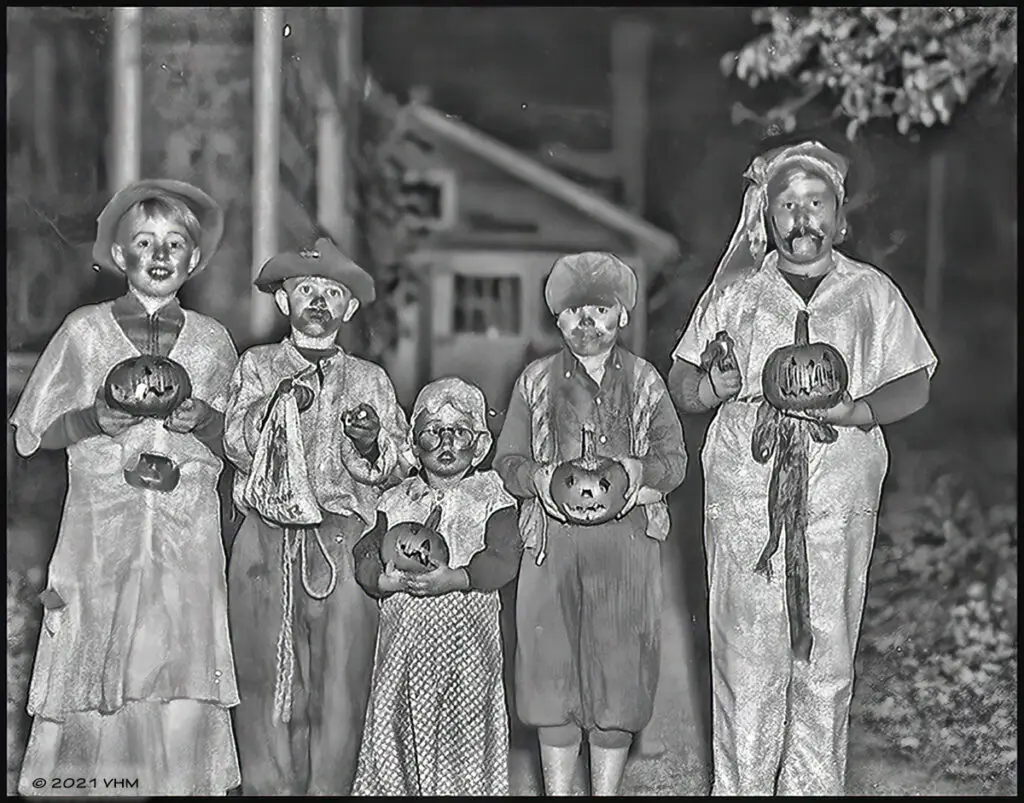
Approximately 200 million years ago (or when I was a kid) Halloween, aka. All Hallows’ Eve was strictly a one-day – or perhaps better said a one-night – affair. I really didn’t care about the etymology – the origins of the word nor the history of the event. What I cared about was how much candy I might be able accumulate in a large paper bag within a relatively short amount of time.
I never spent too much time inventing a costume for the event. And I don’t recall my friends doing much about it either. My two older sisters might have taken more time on the subject. But I was too distracted by the thought of having a big bagful of candy to pay much attention to their ramblings. For me, an old sheet with eyeholes or an old jacket and hat from my dad or one of my older brothers; and a little burnt cork rubbed over my face would suffice; and did the (excuse the pun) trick.
Most costumes in stores (to me) were cheaply made and however scary they were supposed to be – weren’t. At least, they weren’t until they had aged 20 or 30 years. But I did like some of the Halloween trappings / accessories available at the candy counters in the days preceding the occasion. There were, for instance, wax buck teeth or fangs and ruby red lips. You’d buy them, stick them in your mouth and look at your refection in a store window. You could I suppose, but should not, eat them. And after a few silly poses with your friends, the fun was over. Then, when you got home all that left to do was to take the drool-filled things out of your mouth and toss them in the trash. There were also packs of “hot” gum to give to your friends (and sisters). And though you knew it was hot you just had to try “one piece” to see what it was like. (It was, by the way, “hot”.) And then there was, of course, the candy corn. And even though as previously mentioned that for me “200 million years have passed” I remain a big fan.
At school (for me that was the South Street school in Vermilion) there was usually a Halloween type celebration. We drew pictures of witches and ghosts in grave yards. The teacher might read Washington Irving’s “The Legend of Sleepy Hollow” to the class. We’d all be (again excuse the pun) treated to a cookie decorated with a ghost or a pumpkin, or perhaps given a small candy. And finally, all the kids in the school would march down to the auditorium to watch cartoons. It was a pleasant, fun, and very unscary experience.
During those years Vermilion was still a village. It had, at best, a total population of 2000 souls. The reason I mention this is because there were very few strangers in our midst. The need to lock doors did not yet exist and trust among neighbors was an implicit part of living in our town. Ergo, the whole town (by that I mean from Jackson Street to West River Road) was fair game for “Trick or Treat”. So long as a home had a light on at the porch walking up the steps and knocking on the door and asking for “treats” was allowed. Moreover, it (hopefully) insured each homeowner there would be no “tricks”.
But despite the compliance of homeowners there was some mischief. The culprits were usually (but not always) too old for knocking on doors for treats. As I initially indicated Halloween was essentially a one-day affair. Most people looked at it that way and unlike the current custom of elaborately decorated homes few went to such extremes. The most one might see at any home might be a pumpkin (some carved, some not) on a doorstep. For whatever reason a few mischief-makers found some pleasure in stealing and smashing them in the street. It was, and remains, a bit difficult to understand how anyone found smashing a vegetable – especially one that some youngster had taken pride in carving – fun. But who knows?
To deter such mischief the Village Police Chief, Edgar “Ed” Benson, conscientiously patrolled the streets every All Hallows Eve. Mr. Benson was also a Vermilion School bus driver, so he knew every youngster in town. The odds of one of his temporary wards getting away with a crime major or minor were not good. The time allotted for kids to prowl the mean streets of the village was from about 6 to 9 p.m. And that was the law.
One Halloween night when I was about nine or ten, I found myself out after the allotted curfew a block from home when I saw the headlights of the Chief’s police car coming down the street. I was in a panic. I had to disappear before Mr. Benson saw me and tossed me in the clink. I was standing near the corner of Ohio and Decatur streets. Frantically, I looked about for a place to hide. They only thing I saw in the pale streetlight was a pile of leaves in someone’s yard. I leapt into them and covered myself and sweated it out as Chief Bensons’ car slowly passed and went on down the small hill on Ohio Street to his home. Disguised or not. And under a pile of leaves or not. I never doubted that he knew I was there. But he didn’t stop. Perhaps it was his intention – to “scare boo out of me”. He succeeded – and my Halloween was over. That is, it was over until the next year.
Vermilion resident Rich Tarrant is Curator of the Vermilion History Museum and a son and a grandson of the late proprietors of The Vermilion News (1897-1964). Readers may email him at: rnt@twc.com
© RNT October 24, 2021

A Melancholy Endeavor
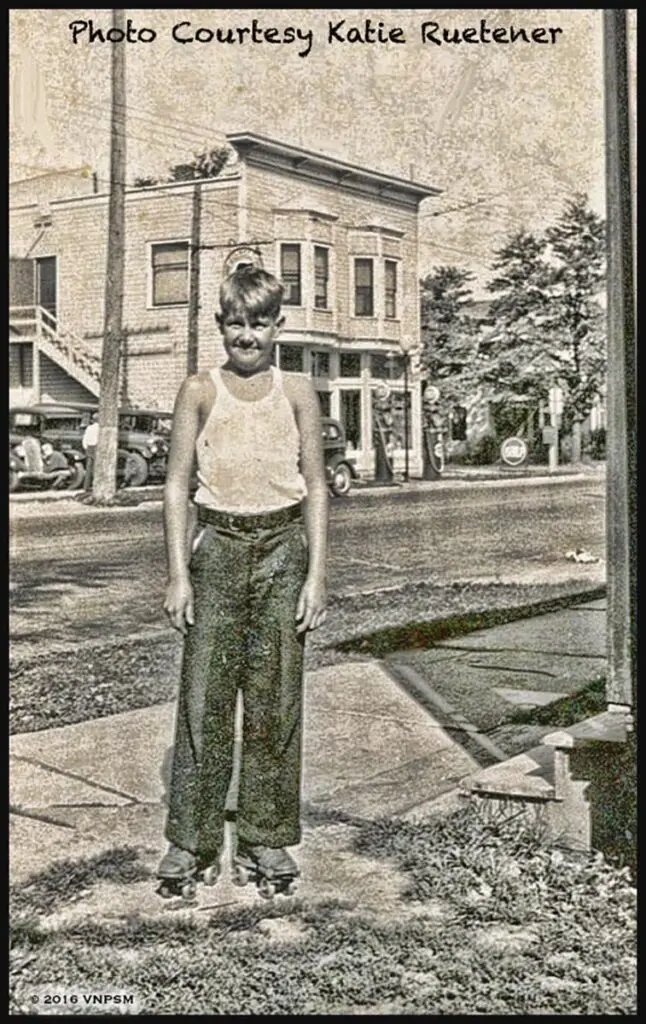
Looking at the accompanying photo I am nearly driven to tears. I suppose it’s because I remember days like those pictured – days when there were no limits to a young boy’s dreams. It is a snapshot of a young Vermilion lad named Billy Bond. He lived with his parents Frank “Bunny” and Elizabeth on West Liberty street in a home next (east of) to his dad’s café (Frank “Bunny” Bond’s Liberty Café – currently – 2019 – Rudy’s Place).
Bill was born in Vermilion on May 3, 1924. The snap was probably taken in 1936 or ‘37 when he was 12 or 13 years old. The building in the background is gone now replaced by Vermilion’s Friendship Park. At the time the ground floor of the building was likely the home of Frank Baker’s first Ford garage. The used car lot can be seen just to the left of the building Young Bill was apparently out sidewalk skating [remember that?] on a nice summer day. He looks very happy.
His niece, Katie Bake-Reutener, donated this snap along with numerous other articles to our local history museum a few years back. Among those things were many of the letters he and his family exchanged while he was in the U.S. Army in France during WW2. This is an example of one of them:
” Nov. 12, 1944 – Dear Mom & Pop – Seeing today was Sunday I thought I would drop you a few lines. I was going to church this morning, but I never got around to it. They got us living in an underground fortress that the Germans once had for a radio school. They said it was built in 1756, but I don’t know for sure. The only thing we have for heat is [a] bon fire that don’t keep the place very warm. It’s been pretty bad weather here for the last couple days and its pretty muddy here. When I finish with your letter I’m going to write to the girl in Springfield. I wish you would [send] her a picture of me. She wants picture of me so bad. Here’s her address. [Not included here.] … Well, must close and go to dinner. – Your Loving Son – Bill”
As is obvious, there was nothing really earth-shattering about any of the things in those communiques. They were just letters written by a young fella, with young man’s dreams in a war zone – writing home to his mother, father and sister. There was no sense of danger in his words. Discomfort – yes – but nothing ominous.
Some days later he wrote the following:” Nov. 23, 1944- Dear Mom & Pop – I just thought I would drop you a few lines to let you know I am ok. It’s been raining quite hard for the past couple of days and it’s quite muddy. I got a new pair of shoes the others and I got blisters on my heels from walking. Tell Mr. Horning that a [can’t make out the word] crane made in Lorain, Ohio was sitting right next door to us. I guess they[‘re] sent all over the world. Well, it’s almost time for dinner and we are going to have Roast Turkey, so you can say that the boys on the front lines are getting the best. Well, must close for now – and don’t worry. – Your Loving Son – Bill”
The Mr. Horning mentioned in this passage was probably Vermilionite Arthur Horning who lived at Axtel. He was an inspector at National Tube in Lorain and was likely very familiar with the Thew Shovel Company that was also in South Lorain. The company built the cranes used to build the Panama Canal and during both WWI and WWII assisted the troops in Europe in the construction of bridges, roads etc. Ergo the crane in question was very likely a Thew crane.
Bill generally wrote home about every two weeks. But there was no more news until the following telegram arrived at the Bond home on December 18th: “Mrs. Elizabeth Bond, 211 West Liberty St. VR. The Secretary of War wishes that I assure you of his deep sympathy in the loss of your son Private First-Class William F. Bond. Report received states he died Twenty-seven November in France as a result of wounds he received in action…” Just like that young Bill Bond was gone. Some years later the local Post of the Veterans of Foreign Wars honored him by naming the post after Bond and the Holland brothers. All lost their lives during WWII.
Among the letters was a communiqué from, a then, 19-year old Pvt. Milton Karchin who was serving in the Army at an Army Ordinance Depot in Atlanta, Georgia. Milt was one of Bill’s Vermilion pals. [Incidentally, Karchin’s brother, Jake, became a belated casualty of the war. Suffering from serious wounds received in France he committed suicide in 1947.] But hearing of his friends death he wrote to Mr. and Mrs. Bond:
“Friday Dec. 29, 1944 – Dear Mr. and Mrs. Bond, – I just received news about Bill. Although I know there is nothing I can say that could console you in your great loss I just had to write a few lines to you. I couldn’t help thinking of the good times Chuck [Thompson], Billy & me used to have together. I just can’t seem to realize that we’ll never again ride with Bill in the Hudson. I remember clearly the day, it was New Years Day 1943, that Bill & me were down at the Post-Office sorting mail when Bill spied a little yellow card telling him to report to Dr. Hennig [Heinig] for a draft board physical. Then Jim Hart came in the Post-Office & Bill told him about the card & Jim asked Bill if he was glad to go to the Army. What a question to ask!! Bill said he wasn’t really gay about it but he’d go allright [sic]. I never dreamed what a fateful day that was to be! The last time I saw Bill was on his first furlough in July, 1943. I never saw him since, nor have I seen Charles [since] the day he went off to the Army. I can’t understand why it had to [be] Bill & Charles who had to suffer. [Later Charles Thompson was wounded several times and was also, for a time, a prisoner of war.] Maybe before this is over with Charles or me could possibly avenge his death by taking a few Nazis’ lives. Well, I can’t think of anything more to say about it except that I lay awake last nite [sic] thinking of Bill, seeing his face before me as clear as anything. – Yours, Milton Karchin”
While it is certainly fun as well as a learning experience to pass along “memory lane” with all the pictures, letters and other materials made available to me it can also be a melancholy activity. Perhaps such things would be better if lost and forgotten. Perhaps…
Ref: Special Thanks to Katie Baker-Ruetener; © 2020 RNT
Vermilion resident Rich Tarrant has agreed to share many of the photos and stories he has acquired from the former Vermilion News and other local sources with the readers of the Photojournal. Rich is the youngest son and a grandson of the late proprietors of The Vermilion News (1897-1964). Readers may email him at: rnt@twc.com

My Grandmother the Outlaw Queen
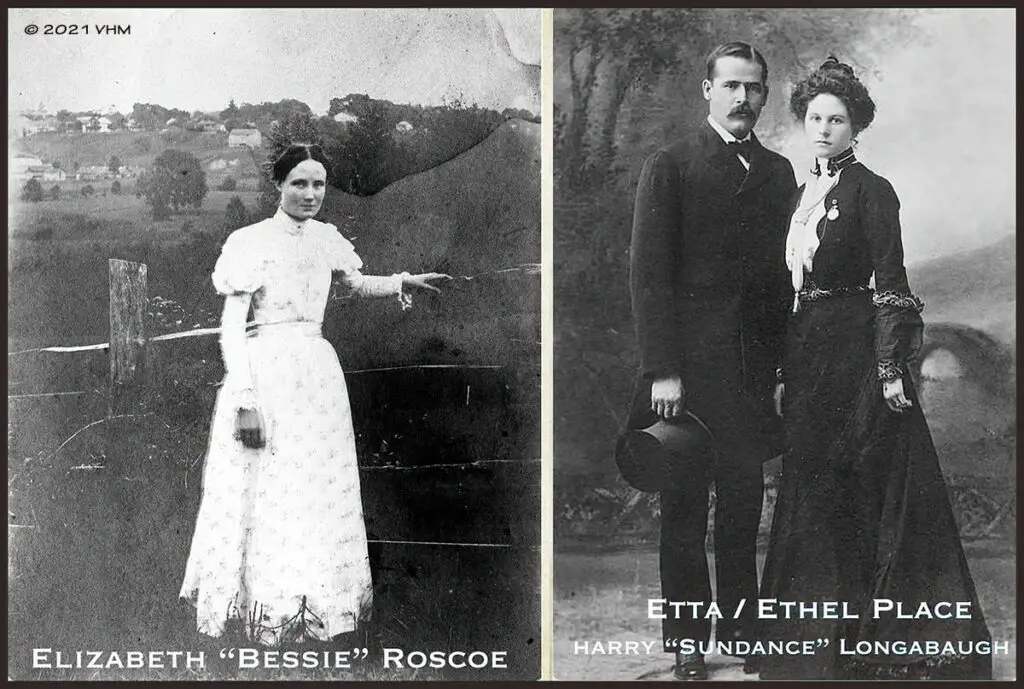
I should probably explain that while I have a cell phone, I don’t use it much. That’s because I don’t care for phones mobile or otherwise. I keep it mainly for emergencies. I seldom text or take pictures with it because I do all the work I need to do with a computer or digital cameras. Anyway, it all started about 2 weeks ago. (On October 1st) when I receive an unexpected text on my cell.
This person (he introduced himself as Chris from Aurora Colorado) texted me to say, in part, that he’d been researching an amazing woman named Bessie Roscoe who he thought might be my great-grandmother and wanted to discuss his “incredible findings” with me. I told him she was actually my grandmother and that I wasn’t really interested in what he might have found.
Nonetheless, he continued to tell me (although he said he didn’t want to embarrass me) that she, as well as both her parents, my great-grandparents, had assisted Harry Alonzo Longabugh (aka. The Sundance Kid) and Robert Leroy Parker (aka. Butch Cassidy) in the robbing of banks etc. while she taught school as a very young lady. He said grandma was Harry’s (Sundance’s) girlfriend and went by the name of Etta / Ethel Place. The three were said to be members of the outlaw gang known as Butch Cassidy’s “Wild Bunch”.
Searching for information regarding Ms. Place I discovered that the first thing some noticed when they met Place was that she was strikingly pretty, had a very nice smile, and that she was very cordial, articulate, and refined in speech and manners. They also say that she was an excellent shot with a rifle. She is said to have spoken in an educated manner, and indicated she was originally from the East Coast. However, no one could ever give an exact location.
In truth, very little is known about Ms. Place then or now. Some speculate that she was a schoolteacher. Some say she was a prostitute. Some say she was both. In 1906 The Pinkerton Detective Agency described her as having “classic good looks, 27 or 28 years old, 5’4″ to 5’5″ in height, weighing between 110 and 115 pounds, with a medium build and brown hair.”
Generally, that description does seem to describe my grandmother. And as she was born on the 19th day of February in 1879 – a date that jibes with that of Ms. Place who is said to have been born around 1878. But my grandmother was born in Minnesota Territory. She was not from the east but did move east to Milan Ohio with her family around 1897. Grandma was also a teacher. She had been a good student in her younger years and as a result began teaching primary school at the age of 15 in Minnesota and later in the Berlin-Milan rural schools. [NOTE: One should note that it was not unusual for a young person to teach youngsters that were not much youngerr than themselves. To be sure potential teachers were tested to qualify, but times were different, and some students used to pay attention in class.]
The basic mix-up may be because that Etta Place was almost certainly not Longabaugh’s girlfriend’s real name, but no one knows for sure what it might have been. Moreover, little to nothing is known about her early life prior to her meeting “Sundance”. And to make things foggier (or not) it seems that “Place” was Longabaugh’s mother’s maiden name.
What is known however is that in 1901, Ms. Place accompanied Longabaugh to New York where the accompanying portrait of the couple was made. They were thought to have been married around this time. In February, the couple is said to have traveled to Argentina with Butch Cassidy, where they bought a ranch. According to information from the Pinkerton Detective Agency, Place and Longabaugh returned to the US in 1902 and in 1904. They were, however, gone before the law caught up with them. Place is said to have returned to the US for good in 1906, and Longabaugh (along with Butch Cassidy) is, as those who have seen the movie know were thought to have died in a shootout in Bolivia in 1908. In 1909, a woman fitting Place’s description requested Longabaugh’s death certificate in Bolivia, but never received it. After that, the fate of Etta Place is completely unknown, although many have speculated about her later life under another name.
While all that was taking place my grandmother married my grandfather, Pearl Roscoe on the 27th day of June in 1900 in Erie County, Ohio. She was, and had been, working as a school teacher in a one-room school in the Berlin-Milan district for two years by that time. In 1901 the couple purchased The Vermilion News weekly paper and print shop. And in 1906 my mother was born there.
Researcher Larry Pointer, author of the 1977 book In Search of Butch Cassidy, wrote that Place’s identity and fate are “one of the most intriguing riddles in western history.” While I certainly don’t deny that to be the case; and I kinda wish that Grandma was in fact the “Outlaw Queen” Etta Place, I am sorry to report to Chris from Aurora Colorado and others that Elizabeth “Bessie” Bottomley-Roscoe wasn’t her. As an amateur historian I would advise ye that chasing shadows is an occupational hazard. Just ask my cat.
Vermilion resident Rich Tarrant is Curator of the Vermilion History Museum and a son and a grandson of the late proprietors of The Vermilion News (1897-1964). Readers may email him at: rnt@twc.com
© October 11, 2021 RNT
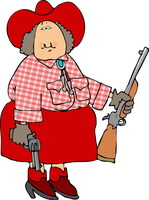
A Hot Time at the Old Town Hall
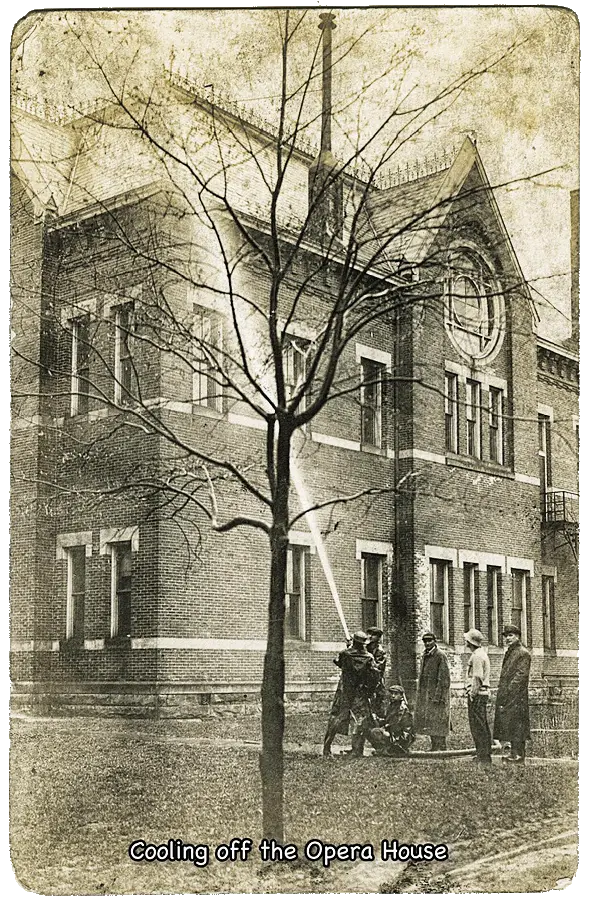
When I happened upon the following story, I envisioned one of those old Charlie Chaplin type movies where everyone appears to be running about as though their pants were filled with hot coals. In fact, the real event appears to have been so expeditious that it may very well be that only a few folks about Vermilion Village ever realized that it took place at all. It falls under the “Betcha Didn’t Know That” category in the annals of local history. And what you probably never knew is that once upon a time there was a fight in Vermilion’s Township Hall. And while was it most certainly hot, it had nothing to do with politics.
The event took place on the night of April 11th in the year 1905. It had rained all weekend and the weather that Tuesday evening was no different. It was dark, and dank; a perfect night for sitting by the home fire with a book. Or, if you were so inclined, it was also a great night to hop aboard one of the special cars provided by the Lake Shore Electric interurban railway and travel to Vermilion, O. to watch two adult men beat one another silly with their fists.
The event was not highly publicized before it took place – nor was it widely advertised afterward. Initially, it was planned to be held in Lorain, O. But authorities in that city would not permit it. Then, as if by magic, [Note: What else could it have been? Because no one seemed to know precisely how nor by whom] Vermilion’s Township Hall was secured for the contest. So, at 9 PM sharp on that rainy night in April a crowd of about 450 spectators gathered in Vermilion’s Opera House, and the fists did fly.
Both men were steel workers. Both weighed in at about 145 pounds. By current weight class standards, they’d both be considered welterweight athletes. George “Frazer” Fraser was a Lorain native. The other man, “Kid” Talbert was a native of New Castle, PA. who had been transplanted to Lorain. Though the contest had not been, as indicated, “highly publicized” local persons who were informed of it had been told that “the affair would only be a little sparring match”. That there was an attempt to keep this event on what folks are now inclined to call the “down-low” is altogether obvious; albeit 116 years after the fact. Certainly, someone noticed 450 people getting off the interurban on Liberty Avenue and walking up the street to the town hall. But again, as previously mentioned, the entire event may have been so expeditious that no one noticed. And there was no big reason to worry because John Delker, the town Marshal, was there to oversee things.
The “little sparring match” went 12 rounds. And though someone announced that it would be a fight to the finish, Marshal Delker apparently disagreed, stopping the fight in the 12th round, and ordering the hall to be cleared. Although there was no official decision as to the winner of the fight most spectators thought that Frazer had the best of it. Both men had, however, been severely punished. Eyes were blackened and noses had been broken. But no permanent injuries were noted.
Truth be told, the “little sparring match” at the Vermilion Opera House that had been magically arranged by unknown parties briefly raised a few eyebrows in the community in that yesteryear. For some reason to suggest that wizardry had played any part in the affair was an inadmissible defense for having allowed it. Nonetheless, it had been accomplished. A few days later few citizens cared; and several days after that nobody cared at all. The esteemed Russian author Leo Tolstoy once observed that “Historians are like deaf people who go on answering questions that no one has asked them.” I betcha didn’t know that either.
Ref: The Sandusky Star-Journal, 4/12/1905; Roscoe-Tarrant Family photo archive; VPJ 07/21/2011; Rev. 10/03/21.
Vermilion resident Rich Tarrant is Curator of the Vermilion History Museum and a son and a grandson of the late proprietors of The Vermilion News (1897-1964). Readers may email him at: rnt@twc.com

Big Ed Lampe - Lake Erie Legend
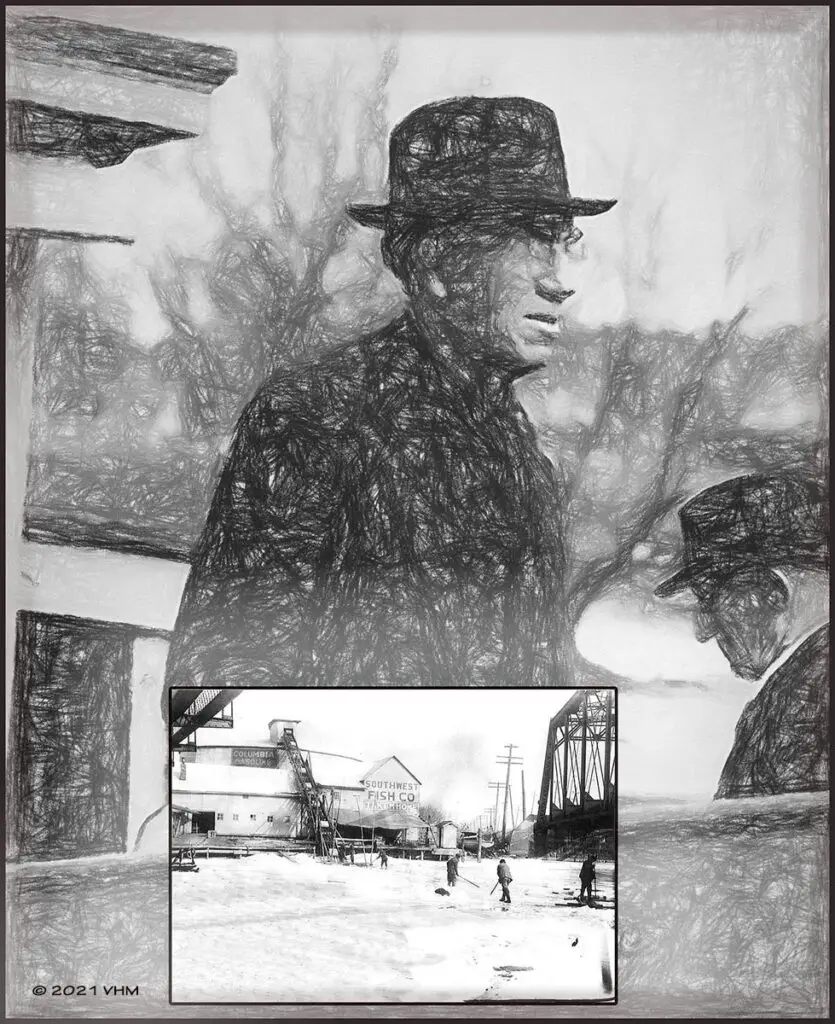
Forward: When I was a little boy I was always fascinated with the tales of Paul Bunyan and Babe his blue ox. Though I knew the tales were fantastic I nonetheless reveled in their beautiful exaggerations. Somewhere in those fantasies I concluded was some element of truth. Perhaps it was wistful, wishful thinking. But I could easily imagine that once upon a time in the logging camps of the great deciduous forests of North America men sat around a crackling fireplace in the evening and told tales of their days in the woodlands – each trying to better the other – and the legendary woodsman, Paul Bunyan, was born.
When first I heard of Captain Edward C. Lampe it was in a like context. Most of the descriptions of, and stories about, Lampe were second and third hand – handed down from men who lived and fished during a time Lake Erie historians refer to as “The Golden Age” of fishing on Lake Erie. As time wore on, I began to hear various versions of what could have only been the same story. It was then that I began to understand that Lampe wasn’t just a man – he was a legend. Moreover, he was a “real” legend. It is one thing to be admired and idolized. But it is quite another to become legend.
And so did I begin to look for further information about this man. Who was he? Where did he come from? What did he really do? And finally, what happened to him? This is what I found;
On Tuesday, September 23 1947 news of the death of Captain Edward “Big Ed” Lampe blew into the village of Vermilion, Ohio like an unexpected nor’easter. It cast its shadow across the fisheries lining the river where men of few words exchanged thoughtful glances before heading out for a day on the lake; each mutely recalling to themselves “a time when Big Ed…”. It then moved on to the Maud-Elton bar where early patrons on their way to work at American Ship and U.S. Steel in nearby Lorain were wiping sleep from their eyes and nursing Irish coffees; respectfully acknowledging the incredulous news ‘amongst their pals and anyone else who happened by. Together, both the fisherman and their blue collar brethren secretly wished it were Friday night instead of Tuesday morning so they could all raise a glass (or two, or three) for the man whose presence had always been, to them, larger than life. Somehow, he had always managed to make their humdrum lives just a little less dreary. Like the Sunday funnies tales of “Big Ed’s” exploits were always something they looked forward to – in fact depended on. No matter how bad things were the stories of what Big Ed once did, was doing, going to do, or what some thought he might have done managed to make their days just a little brighter. “It just couldn’t happen. It was impossible.” But, alas, it was true. The man whose life had been the stuff of which legend is made was, indeed, dead.
Lake Erie historians sometimes refer to it as (as has already been said) “The Golden Age” of fishing. It was a time when men with names like Gowitzka, Hallock, Hosko, Keller, Snell, Bodi, and Jackson braved all elements, both natural and man-made, on Erie’s western basin in pursuit of yellow perch, pike, bass, and sturgeon. No book taught them the business – the work. And no map nor true compass existed that would guide them across these waters in foul weather. The only college these men attended was the one my late father-in-law, George Diener, used to call “Hard Knocks”; and they had the bruises, scars, and scares to prove it. They were men of few words and strong backs whose lives were lived upon the most unpredictable inland sea in the world. They were men who could recall a day when one could drink straight from the lake when thirsty; when one could set forty nets and everyone would boil with a ton or two or three of perch; and when game wardens and politicians didn’t constantly meddle in their business. All these men (and more) were heroes in their own right. All are worthy of a book or two. But among them there was one with whom even they stood in awe. They called him ”Big Ed”
There is some question among those who knew him as to his origins. Probably due to his size and his rugged and weathered face (he was 6’ 6”; went about 230/40 lbs.) some thought he was from “the Land of Lincoln” – Illinois. But the truth of the matter is that he was born about 1871 on Ohio’s Catawba Peninsula. His parents were born in Denmark and had migrated to America. (This heritage may very well explain both his size and his life’s vocation).
As a child Lake Erie had been Ed’s playground. He built his first boat, a sailboat, at age 9. For the remainder of his life he built, bought, sold, and operated boats of all kinds. Several years before his death he would tell the editor of The Vermilion News that someone could take him out on Lake Erie blindfolded and given a sounding lead, he could tell what part of the lake he was on. While he wasn’t likely the only Erie sailor capable of such a feat his knowledge of the lake was, nonetheless, quite remarkable.
Like a handful of other men who have come to the village of Vermilion and have left an indelible mark on the world given their inventive, industrious, and honest natures Big Ed sailed into Vermilion’s harbor. On his way to Erie, PA from his childhood home in Ohio’s Catawba region during the winter of 1890 the tides of pure fortune married to the cold reality of lake ice forced him to tie up his gill-net schooner, White Slave, just north of what we know currently (2021) as the Fisherman’s Bend Condominiums. Right from the very beginning his presence was exceptionally auspicious. And throughout the remainder of his life, he delighted in telling of his first night in the village.
Debarking his boat and passing through the place we now call Exchange/Rubberneck Park in search of a warm meal he heard someone call out to him from a shanty perched near the top of the rise. Without giving it much thought he unlatched the door and let the man inside out into the night. The next morning, he discovered that his act of good will was that of allowing a prisoner in the town lockup his freedom. In later years other persons would embellish the story by saying that the prisoner in question was none other than Morris “Jib” Snyder a local fisherman known for his funny voice, need of a bath, and persistent love of the grape. Whether that was the case is a matter of pure speculation. But with or without that aggrandizement the story is well worth recounting.
What exactly kept Big Ed in Vermilion for the next 56 years is unknown. But he did stay. Initially he spent these early days as a fisherman. As we will soon understand he also entertained other ambitions. He and (for a brief time) another man named Harry Patton, operated the Southwest Fish Co. on the east side of the river where Romp’s Waterport is today (2021). During those years he was accredited with creations of the “ark” type tug design that became a standard for gill net tugs throughout the Great Lakes.
In the Pearl Roscoe photo (inset) accompanying this article ice is being harvested in front of Southwest Fish in the early part of the 20th century. To the right is the Lake Shore Electric (interurban) rail bridge. To the left is the old Vermilion River Bridge for auto, horse, and pedestrian traffic. Persons looking for more bucolic representations of Lake Erie’s fishing industry may be disappointed. The glamour of this industry was not, and is not, superficial. It ultimately lies in the blood, sweat, and tears of those who work it from dawn to dusk so long as the “lake of the long-tailed cat” will allow. When this picture was taken, Big Ed was just beginning pull in the big nets. His reputation would eventually grow as large as the shadow cast by his six-six frame, and later into legend among both his peers and and strangers alike
Vermilion resident Rich Tarrant is Curator of the Vermilion History Museum and a son and a grandson of the late proprietors of The Vermilion News (1897-1964). Readers may email him at: rnt@twc.com
© RNTMonday, September 27, 2021
The Light & Hope (aka. Gore) Orphanage
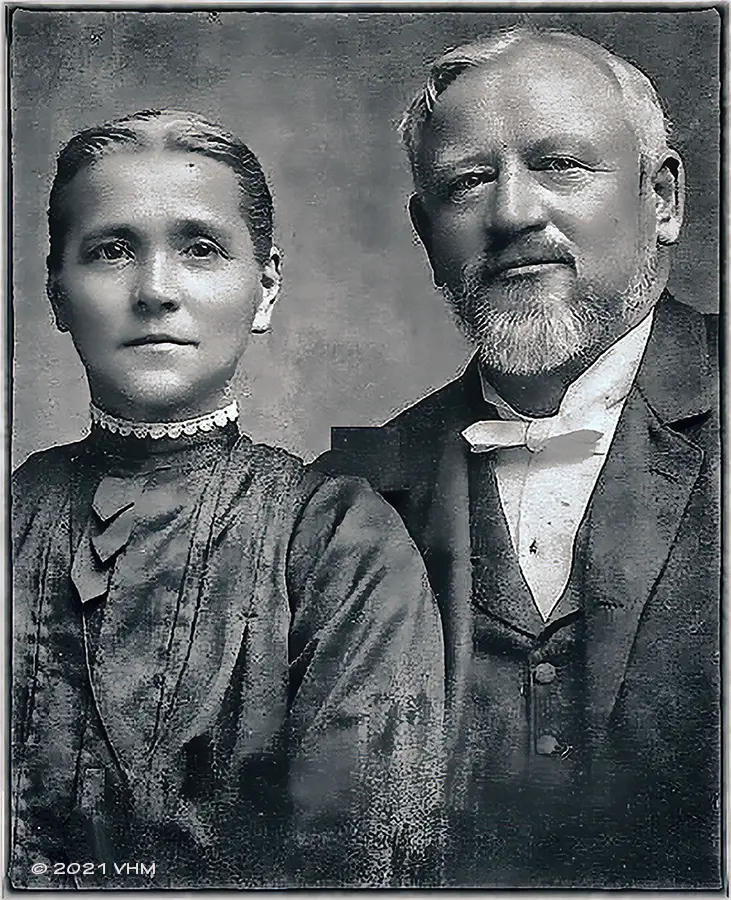
Every year about this time, when the wind turns a little brisk and the leaves begin to turn, various persons gather and in anxious whispers speak of a place that only exists in their collective, but obviously fertile, imaginations. That place, they call the “Gore Orphanage”. In truth an orphanage certainly did once exist along Gore Road near Birmingham, Ohio. But it’ s real name was the Light & Hope Orphanage. It was not a single structure – but several. They were part of a large farm (453 Acres) overlooking the beautiful Vermilion River Valley (Swift’s Hollow). There were both boy’s and girl’s dormitories on separate properties, a large barn, a small sawmill, an administrative building with a chapel as well as a print shop. And though the orphanage like any organization did experience some troubles over the years (e.g., once a young boy was killed while sledding, the print shop burned without insurance) the children were not mistreated or made to suffer during their stay.
Persons familiar with the urban legend regarding this orphanage may already be familiar with the names of Rev. Mr. and Mrs. Sprunger. They were responsible for the creation, management, and operation of the project they named the “Light and Hope Orphanage”. The children’s home had been established in Berne, Indiana in 1893.
Johann “John” Abraham Sprunger had been born in Berne, Switzerland on 12 August 1852. His wife, Katharina “Katie” Sprunger, was born in Adams County, Indiana on 3 September 1859. The couple married on 15 February 1880. They were (shockingly enough) first cousins). Together they had four children, one girl and three boys. A daughter, Hillemonda was born in December of 1880, but died at the age of six in July of 1887. The boys: Edmund, was born in Berne in February of 1884 and died at birth; another boy they named Salem, was born in Berne in April 1891. He only lived a bit over a year; and another infant boy was born in Bern, Switzerland in 1890. He lived less than one month.
In his younger days Mr. Sprunger was a very successful and wealthy Berne businessman and somewhat active in his church. But in 1888, after the death of their first child Hillemonda, he apparently felt a need to surrender himself fully to the work of God. So, in 1889, he started out on a mission. The couple left Berne going to Tennessee to visit an uncle. There, Sprunger, although not yet ordained, gave his first sermon. They then travelled to Europe and he was ordained in Switzerland. While in Europe they became aware of the Mennonite deaconess movement. [i.e., a non-ordained ministry for women who were trained to act as nurses and social workers.] The Sprungers felt it would be a good Christian service to carry back to Berne Indiana and surrounding states. Upon their return to Indiana their local Mennonite community rejected the idea. Consequently, they began to work on their own version of the movement assisted by some local women as well as several other women who had migrated to Berne with them from Switzerland.
After their training, the women, called “deaconesses” or “sisters”, went to work in Chicago. Sprunger’s mission, officially known as the “Light and Hope Missionary Society”, soon established homes in Evansville, Chicago, Detroit, and Cleveland. The deaconesses worked for room and board. The hospitals and homes, as Mr. Sprunger explained to members of the press, were “…strictly undenominational…and open to all except those with contagious diseases. We turn nobody away.” Moreover, treatment did not depend on one’s ability to pay. The “mother institution” based in Chicago was supposed to underwrite any financial shortcomings in mission expenses. They carried no insurance on their properties. Unfortunately, things did not always go well. The Cleveland home on Jennings Road was destroyed in a tragic fire on February 1, 1895. Four people lost their lives.
Interestingly enough the initial mission of the society was not that of operating an orphanage. It was simply a by-product of a larger (hospital) mission. But early on at the Chicago mission patrons began asking the society to care for their children. As a result, on April 1, 1893, the “Light and Hope Orphanage” was formally established in Berne. But in time the scope of the original mission proved to be too much for Rev. Sprunger, and one by one the hospitals closed. After the collapse of the hospitals the orphanage became the primary focus of Sprungers’ mission and the society.
By 1903 the numbers of orphans had substantially increased. The quarters used to house them were found to be wanting and there were few activities available for the children. Adding to these problems was another devastating fire at the Berne Girl’s home in April of 1899. It stole the lives of three young girls. In retrospect both the psychological and financial stress created by all these losses must have been terrific. Thus, in November of 1903 Rev. Sprunger moved the orphans onto a large farm he had purchased near Birmingham, Ohio.
The couple planned to remain with the orphanage on the farm for the rest of their days. They even had their daughter Hillemoda’s remains moved to a place near the orphanage. Some years later one of the residents, a fella named William Schultz, who lived to be 101, recalled that Mrs. Sprunger always kept flowers on her daughter’s grave. But in time, things did not go well. The property incurred a large debt. And things got worse following the financial panic of 1907. By that time the facilities had become, according to testimony of the children who lived there, in sore need of improvement. The health and educational needs of the youngsters were being neglected at times, and during all this Rev. Sprunger’s health began to decline. Following a series of strokes, he died there on 28 September 1911.
After his death, the Friends church of Cleveland assumed responsibility for the operation of the orphanage, and Mrs. Sprunger returned to Berne with several of her charges. Her daughter’s (Hillemoda’s) remains were also returned to Indiana and placed in the family plot near her father Rev. Sprunger. Katharina died of cancer on 4 April in 1934 and was placed to rest beside them.
To be candid the urban legend regarding the orphanage actually pales in comparison to the truth. It had been a substantial undertaking requiring substantial attention. Shortly before his death Rev. Sprunger wrote to a friend, “I have in my work troubled with unnecessary things, and…I left off from the way of faith…I went in self-work in place of trusting God…” The bogus orphanage story has indeed become legend, but the real story however disappointing and less dramatic it may be to many, is very much a human one: a genuine struggle for both Light and Hope.
Ref: Light and Hope: The Story of the Rev. John A. Sprunger and Katharina Sprunger and Their Heritage by Rev. Max Haines 2021.
Vermilion resident Rich Tarrant is Curator of the Vermilion History Museum and a son and a grandson of the late proprietors of The Vermilion News (1897-1964). Readers may email him at: rnt@twc.com
Huron Iron Company
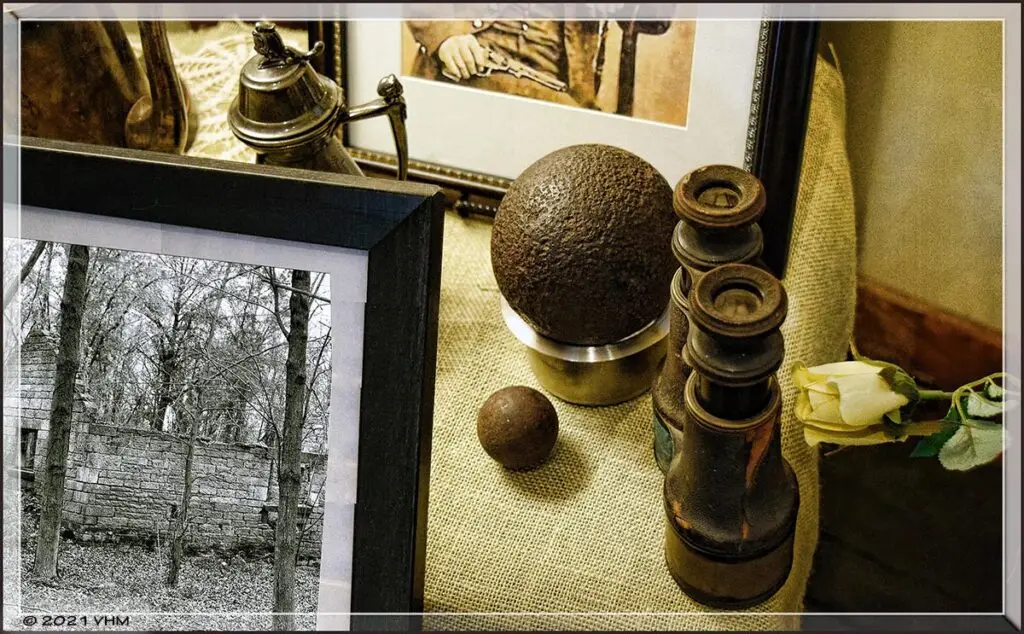
There’s a plaque near the northwest corner of Darrow and Vermilion¬-Savannah (a.k.a. State Route #60) Roads that, quite noticeably, goes unnoticed by most passers-by. In a nutshell it tells the story of a day when the community of Vermilion, 0., then part of Huron County, was an iron producing region. Although local residents have long referred to the spot as “Furnace Corners,” the root of the appellation – the reason for its being called “Furnace Corners” has become as nearly obscure as the ruins of the old plant itself. Now but a pile of hand hewn stone , its wooden bones long turned to dust, very little of the building remains as a passing curiosity to an occasional hiker and to the diverse and sundry denizens of the Ohio woodlands which surround it. What took place here in just a yesteryear is nearly as faint as smoke in the wind.
In the year 1834 three men – most notably Messrs. Ford, Sanford, and Tracy from the Geauga Iron Company formed the Huron Iron Company. They apparently chose the area just south of the soon to be incorporated Village of Vermilion because of its proximity to bog iron ore and other deposits found beneath the nearby the ancient lake ridge formations. Bog iron ore refers to impure iron deposits that develop in bogs or swamps by the chemical or biochemical oxidation of iron carried in the solutions. It was discovered during the Pre-Roman Iron Age, and most Viking era iron was smelted from bog ore. It was widely sought in colonial America, and during the American Revolution it was used by military forces to manufacture things like cannon balls. It was also used in the manufacture of various castings used in shipbuilding: wrought iron railings, cooking and heating stoves, plows, kettles and a plethora of miscellaneous household and farm implements. There was, therefore, not only a tremendous need for these items in colonial America, but also the post-Revolution America, which included the settlement and development of our community. Consequently, the proprietors of the Huron Iron Company constructed a blast furnace for the manufacture of such items south of what would become the Village of Vermillion. Lined with native sandstone it was 30 feet high and 9 feet in diameter. Bog ore came from what was then known as the Scott farm. Charcoal was obtained from the surrounding forest, and limestone came by barge from the Sandusky area. The limestone was, interestingly enough, unloaded at piers in the lake off what is currently Sherod Park, and then trucked by horse and oxen to the iron works at Furnace Corners. In 1835 Wilkeson & Co. purchased the operation and continued manufacturing items for the next two decades. But by 1855 improvements in shipping on the Great Lakes made obtaining a better grade of ore from the upper regions of the nation a less onerous task and the old furnace was abandoned.
At this time a Cleveland doctor by the name of Philo Tilden built a new furnace along the Vermilion River in the area just west of the current home of the Vermilion Boat Club. Tilden’s operation employed some 60 men. But it only lasted for ten years. And much like the operation at Furnace Corners, little to nothing is left of Tilden’s company.
That which took place at Furnace Corners was more the norm than the exception in 19th century America. If the market wasn’t saturated with the products produced by the ironworks, the local supplies of raw materials to make them eventually ran out, and the Ironmasters moved on to another locale. And somewhere in the woodland south of town is all that is left of the once thriving industry are the barely visible ruins of the old molding and pattern shop, the stump of a once great furnace, and a few piles of slag long ago overgrown with vines, weeds, and covered with the leaves from the forest grown wild and wonderful around it. And just a short distance south and east of these ruins on the northwest corner of Darrow and State Roads there is a historical marker that quite noticeably, goes unnoticed by most passers-by. It, much like the history it celebrates, has nearly been entirely forgotten. Lost in the detritus of the yesteryear.
Ref: Text of “Dedication of Historical Marker – Route 60 – Vermilion, June 14, 1969.; © 2021 RNT.
Precious Memories
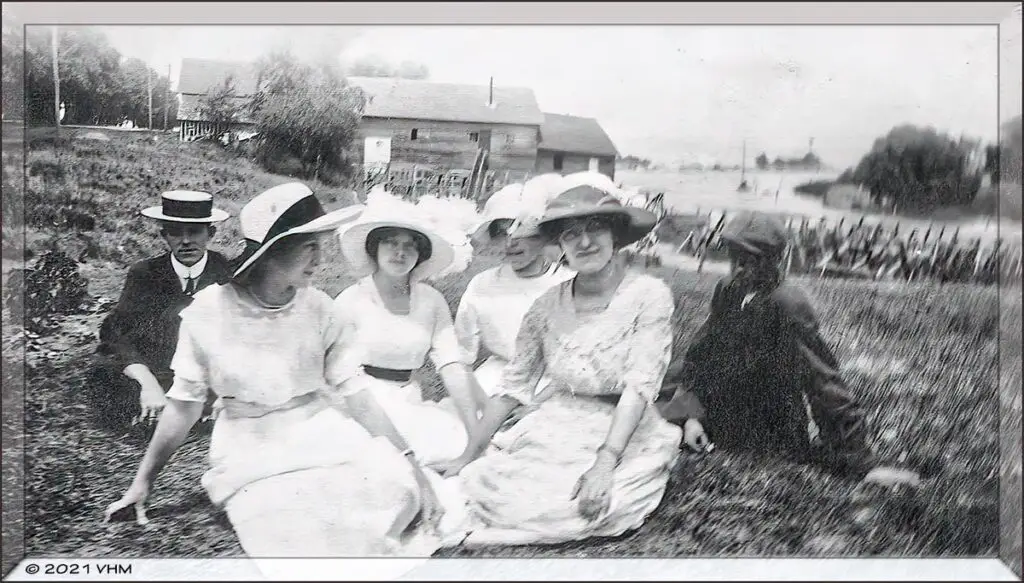
The photograph accompanying this essay could very well have been the subject of a painting by French artist Edouard Manet (1832-1883). As mentioned in this forum several times before there are, undoubtedly, thousands of photographs (and that is no exaggeration) like this squirrelled away in someone’s closet or attic that have long been forgotten. This photograph is a fine example of one of those long-forgotten photos. It was found among, perhaps, 1000 photos in a cardboard box given me by now retired Airforce Major – Jack Corsino some years ago. The box contained photographs and sundry other documents pertaining to his mother’s family – the Thompson – Nicholas families of Vermilion, Ohio.
Back near the dawn of our nation lived three brothers: Justus, Charles, and Henry Thompson. Charles was a clerk in the Continental Congress and signed the Articles of Confederation as a Connecticut representative. His brother Henry was a delegate to that body, and the third, Justus, was a Revolutionary War soldier.
Their entrance into the annals of local / Vermilion history was sometime around 1808 when Justus, along with his wife and four sons migrated to the area from Connecticut. They settled in an area along what later became known as the Edison Highway (i.e. Ohio State Route 113) several miles south of Vermilion. They lived just 2 miles west of Florence / Jessup at a place some knew as “Tater’s Corners”.
Horace, one of the four sons, married a local gal named Mary Nicholas whose family had also settled in the area during the early 19th century. The couple first lived along the lake shore on a portion of land that would later become known as Shattuck’s/Shadduck’s Grove – and later Crystal Beach Amusement Park. That area is now the site of the Crystal Shore Apartment complex. The couple later purchased another piece of land where they built a small home. It was on the site where the recently demolished F.W. Wakefield sat. Horace worked as a ship carpenter.
Two of Horace’s and Mary’s sons, Miles (born in 1820) and Henry (born in 1834) followed their father’s footsteps and worked as ship carpenters. They were also very active in the civic affairs of the fledgling village of Vermilion. Miles became town Marshall and curator of the town lockup (such as it was), and Henry became Vermilion Township and the village corporation clerk. Henry died of heart failure in 1890. Miles died in 1901.
Miles and his wife Julia had five children. Their oldest boy, Albern and his wife Anna had two boys – Howard and Hazen. And this (finally) is where I urge all to look at the accompanying photo. In this photograph their son Hazen (born in 1889) is the gent at the back left wearing a straw hat. Ah, he was a dandy-looking fella.
The photo was taken several years before the U.S. entered World War One (probably c.1911) wherein Mr. Thompson would serve our nation as a “Muleskinner” / Wagoner in France. He was, incidentally, wounded in action on the second day of November in 1918 during the Meuse-Argonne Defensive.
But just for a fleeting moment – in that yesteryear – Hazen appears to have enjoyed a few gentle moments on a beautiful afternoon in company of some young friends on the lawn in Exchange Park. Overlooking the Kishman Fishery and Vermilion’s lazy Harbor – those were precious moments in time that only a lucky few carry with them throughout their lives.
Returning from the war Hazen met and married a gal named Vera Nicholas. They had five children. Although all have now passed into eternity, all these memories lay forgotten in a big box of precious moments for us to discover, share and enjoy.
Ref: Ancestry.com; Ohio Military Men; the Chronicle Telegram, 7-16-1953; The Thompson Family, Rich Tarrant; Special Thanks to: Major Jack Corsino; VPJ 05/21/09; Rev. 08/29/30.
Vermilion resident Rich Tarrant has agreed to share many of the photos and stories he has acquired from the former Vermilion News and other local sources with the readers of the Photojournal. Rich is the youngest son and a grandson of the late proprietors of The Vermilion News (1897-1964). Readers may email him at: rnt@twc.com
© RNTSunday, August 29, 2021
Vermilion Football
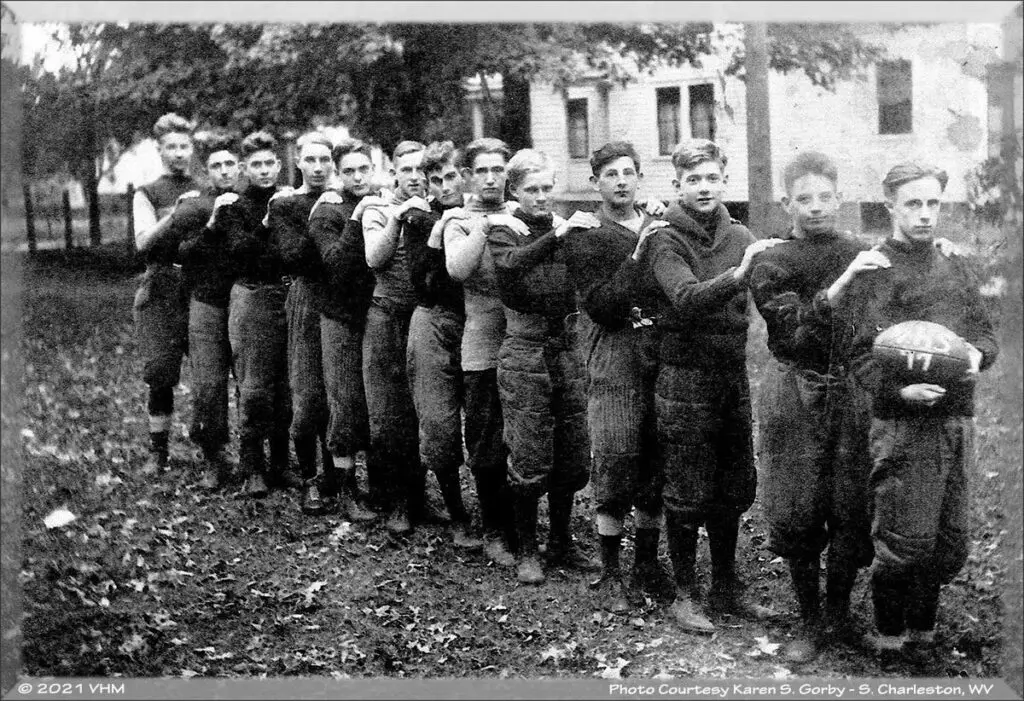
It’s unlikely that anyone (at least anyone I know) can say “precisely when” Vermilion youngsters began participating in organized football. We do know, however, that prep / high school football in our nation, dates to the late 19th century. By that time many collegiate football programs had been created and were rapidly gaining in popularity.
In October of 1890 the first high school game in the region took place in Cleveland between University (20) and Central (0) schools. But it appears that Vermilion’s high school footballers weren’t “officially” organized until about 1913-14. Although Vermilion youngsters were likely playing ball at that time, their games probably took place with friends in the schoolyard and/or any available empty lot around town.
Around 1912 a young minister from Sharon Pennsylvania came to town. His “official” mission, of course, was to serve God, the people of his church and the community. And that he went about doing. But whilst in the course of these endeavors it appears that he also subscribed to the philosophy that one way to pursue such work in our town was by educating young people by providing them with positive activities to fill their idle time. In short, “Idle hands make one poor, but diligent hands bring riches.”
In December 1912 the good minister organized Vermilion’s first Boy Scout Troop. In 1913 he also helped organize the first girls Campfire Troop. But the accomplishment that really caught my attention was this: In 1913 the young pastor organized and coached Vermilion High School’s first football team. He coached them for two seasons. One small article in the local paper regarding the team said that they enjoyed his initial tutelage “and are improving each season.” It went on to say that they had developed a “strong schedule and are booked to play some of the fastest high school teams in the state.”
While I would like to say that the VHS team he coached was a winner – it was not. I am amused by the following notice that appeared in the 22 December 1913 edition of the Elyria Chronicle-Telegram: “Amherst High Opens Grid Season by Trimming The Vermilion Eleven 18-0”. It seems that the Amherst team made two touchdowns in the first few minutes of play in a game that was played in a downpour.
It was obviously a route as well as a rather facetious report. But to be fair the team was new and the coach, however adequate a clergyman and community leader he may have been, likely knew very little about coaching football or any other sport. Methinks the sportswriter for the Chronicle viewed the pastor’s abilities with a good (and probably deserved) measure of skepticism, writing toward the end of the article, “Here’s hoping that the reverend, his coterie of rooteresses [sic] and his gallant (?) warriors will march to war better prepared when the next battle at Vermilion is staged.”
In any case, that appears to be the imprecise “official” date of the birth of organized football in Vermilion. And the reason any of this came to (my) mind at this time is partially due to the accompanying photograph. This is a rather extraordinary portrait of the VHS Football Team of 1917. It’s unique because the school did not have an Annual / Yearbook until 1919. Ergo, it is extremely unlikely that many persons beyond family and friends of the players ever saw or possessed a copy.
It’s also unique because some far-seeing soul included the names of all the team on the back along with the name of the photographer. Pictured from back to front are: Don Lawless, Chas. Kishman, Percy Cullen, Wm. Law, Wm. Moody, Thos. Banning, Percy Holl, John Poley, Russel Adams, Marcus Harris, Carl Englebry, Frank Harris and Kenneth Kishman. The photographer was J.R. Leiter of 37 W. College St. in Oberlin, Ohio.
By the time this photo was taken the good reverend whose works had put all these idle hands in motion had himself moved on to minister another flock in another place. But some persons (like myself) have come to understand that the hands of more than a few of those pictured went on to help build the community we know and love as Vermilion in Ohio.
Ref: Photo courtesy Karen S. Gorby of S. Charleston WV. She is the niece of Carl Englebry (pictured).
Vermilion resident Rich Tarrant is Curator of the Vermilion History Museum and a son and a grandson of the late proprietors of The Vermilion News (1897-1964). Readers may email him at: rnt@twc.com
© RNT Sunday, August 22, 2021
A Real Ohio Jewel
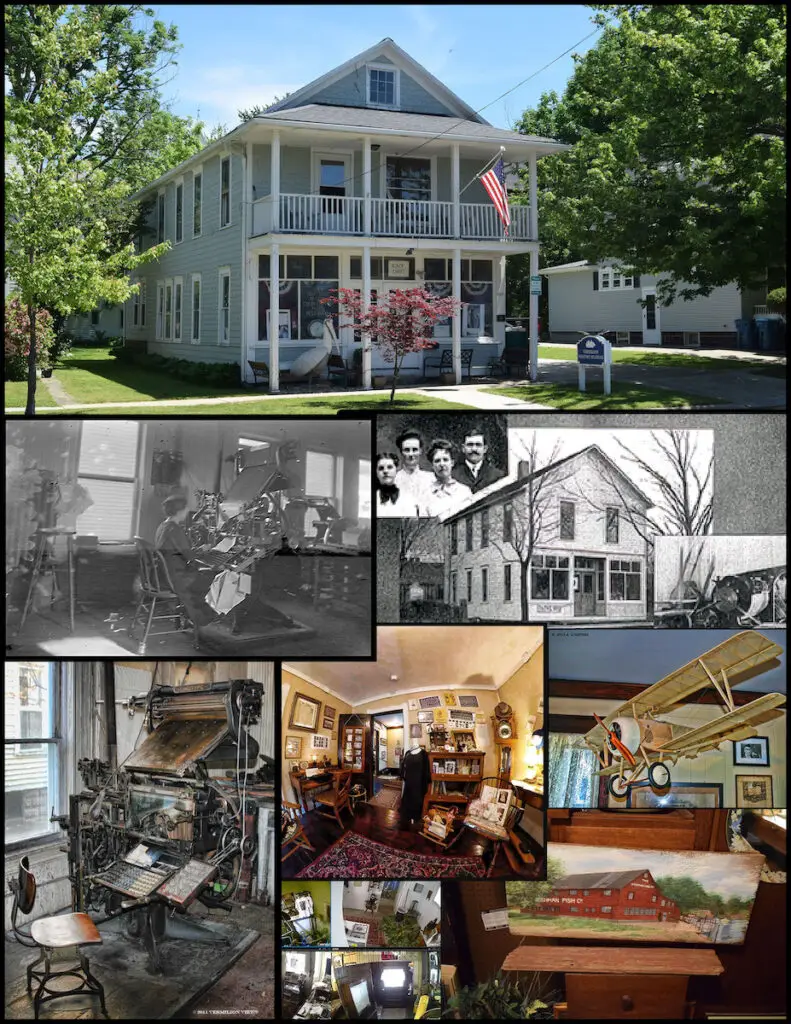
It is probably one of the biggest small museums in Ohio and few persons living in or outside Vermilion know about it. The building was constructed on a vacant lot on the east side of Grand Street way back in 1904. For the next 60 years it was the home of The Vermilion News weekly newspaper as well as the place where nearly all printed materials for the community; church bulletins, tickets, flyers, signs, business cards, posters, smaller newspapers, catalogs, and school annuals were printed. When the business abruptly closed in 1964 the lights were turned off, the plug was pulled on the clock at four minutes to 3 a.m. – and The Vermilion News print shop went to bed and slept for a half-century.
My grandparents Pearl and Bessie Roscoe purchased the business in 1901. The newspaper and printing business was established by George Whitmore in 1897 and was located in the old Wells building (now gone) on the north side of the railroad tracks on Grand Street. My great-grandfather who was a carpenter and millwright oversaw construction of the existing building just south of the rails on Grand that would house the printing business downstairs and provide my grandparents with a nice living quarters on the second floor.
After their deaths in 1946 my mother, Ella, and father Bill Tarrant continued to operate the business. Mom died in 1963, and the business closed the following year – the property remained in the family in the years that followed.
In 2011 my wife, Georgianne, and I purchased the property from my sister Nancy Alice Emery. For over a decade we had wanted to transform the property into a museum. Finally acquiring the wherewithal to buy the property we formed a nonprofit corporation, acquired a board of directors, and went to work.
It took the better part of a year to make the print shop part of the building presentable. While none of the equipment had been moved the area had morphed into a storage area for persons who had occupied the apartment over the years. Once those items were properly dispatched the equipment had to be carefully cleaned and oiled. In the meantime, a new roof was put on the building, the shop was wired to code, and a new low-pressure steam boiler heating system, replacing original coal-fired system, was installed.
Today the print shop is very presentable. It is basically as it was when it was in full operation – although none of the presses are currently functioning. In time we would like to have several of the presses working. But they pose some safety issues. The presses have hundreds of moving parts and operating them in close quarters with people – especially little ones – around is a concern.
We’d not intended to do anything to the apartment during the ensuing 10 or 15 years because my brother was living there. But he died rather unexpectedly in November of 2012, and as we had to clean it out, we decided to make further renovations to make it part of the museum experience.
Thus, we began renovating the museum apartment to provide people with some idea as to how many late 19th and early 20th century businesses once operated – with business downstairs and living quarters upstairs. (The daily commute for my grandparents had gone from 15 miles to just 15 steps.)
With the apartment available the museum became more than a print shop museum. We’re now capable of displaying more than just letter press machines and other related artifacts. Several local residents have contributed photographs, documents, and a number of physical artifacts that are on display in the apartment. We have also partnered with the Vermilion Area Archival Society to share information and sundry other things we have collected over the years. Our exhibits, and themes for exhibits will change as we move ahead. Though our main focus is Vermilion history there are some items, like furniture, that weren’t necessarily made in Vermilion, but might have been found in homes and offices during the early years of the 20th century.
We are forever a “work in progress”. It will probably take another decade or two to really get things the way they need to be – but the task is well worth the time. Despite the fact that we’re still putting everything together there is a great deal to see and experience in the museum. I grew up in this environment, and I’ve worked here virtually all-day everyday for the last decade. There’s hardly a day that goes by when I don’t learn something or come across something new. The history museum is like an uncut diamond; “A Real Ohio Jewel.”
Vermilion resident Rich Tarrant has agreed to share many of the photos and stories he has acquired from the former Vermilion News and other local sources with the readers of the Photojournal. Rich is the youngest son and a grandson of the late proprietors of The Vermilion News (1897-1964). Readers may email him at: rnt@twc.com
Familiar Faces (And Places)
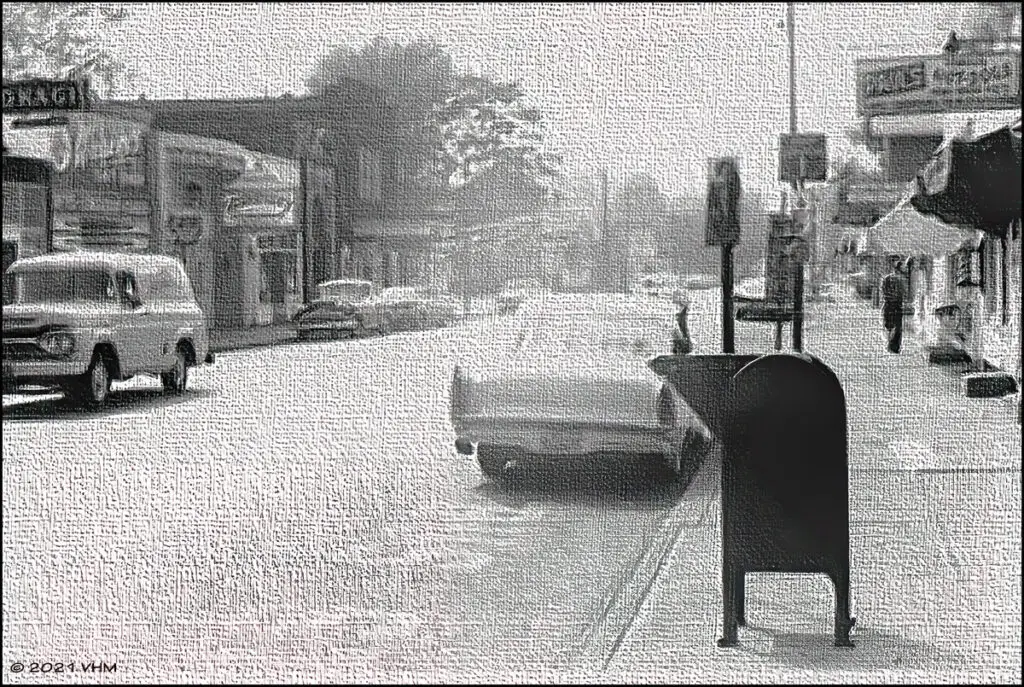
Before George Wakefield died, I was in the habit of sending him old photographs of Vermillion via the Internet requesting that he makes some comments about them. One time I sent them a photograph from the mid-1930s, and he wrote back to tell me that he wouldn’t comment on the picture because it wasn’t old enough. I never sent him (one he might consider to be) a new photo again. Thus, do I doubt that he would have even considered looking at the photograph accompanying this week’s column – let alone make a comment about it. It is a relatively recent picture. Yet much has changed since it was taken. Moreover, there are many, memories to be found in it.
This photo of Liberty Avenue looking west was taken by Fred Wetzler in 1961. This is the “downtown” Vermilion I remember quite vividly. My memory of those days is so vivid that I can even tell one the history of a big white spot that was on the sidewalk just a few steps past the mailbox on the right – which is hardly visible to the unschooled eye.
The spot is where my friend Bill Ream (former Vermilion teacher “Doc” Ream’s son) dropped a gallon of white paint after we had hitchhiked back from the Sears and Roebuck store on Broadway in Lorain where he had bought it. That stain was created some years earlier than this picture.
Now, look at the shops along the street. Starting on the right there’s Paul Snack Shop, featuring his “famous hot dogs and the best coffee in town”. I really loved Paul’s chili dogs. He and his wife, Emily, were from Greece. He used to have a card that described his place (as best I can recall) as being able to “seat 8000 people eight at a time”.
Next was Pete and Jud’s Barber shop. It may be that Paul, our last town barber, was there at the time of this snapshot. But before that, it was always Pete and Jud’s; the place where I received my first haircut. And where they right predicted that I’d someday be bald.
Then came George Rathbun’s store. In this picture you can just see the shelves he had in the outside of the store where he had set baskets of fresh produce during the summer growing season. Inside the shelves were stacked to the ceiling with all types of merchandise. On the counter to the right was always a great wheel of cheese. And at the back old George sat puffing on a pipe.
The White Inn restaurant sat just west of George’s store. This, and the Kountry Kitchen (once Isaly’s, then the Dairy Bar and now the Old Prague). They were workingmen diners featuring grilled burgers, steaks, chops, deep-fried chicken, and perch on a regular basis. Lake Road was the main thoroughfare between major cities in northern Ohio at the time, so business was always good for these eateries.
Adjoining the Kountry Kitchen on the west was Tony’s (Mroski’s) Shoe Store. Tony was a very amiable man who always chewed (as I remember) gum. And aside of selling very good domestic leather products he also partnered with, Joe Terza, who repaired shoes. As time passed shoe stores and shoe repair places like this disappeared from America’s small town business world.
Across the street and heading back toward Erie County Bank building (now the city office offices) is / was Glenn Fulper’s gas station and auto parts business, the Liberty Theater; a veritable legend to most folks who grew up in Vermillion; Tom Williams law office; a small pizza place (which eventually moved down the street to the Okagi building evolving into Pickle Pat’s; and then Leidheiser’s German restaurant. Both the Leidheiser and Okagi restaurants were more formal type restaurants than were their counterparts across the street. The Wagner Gift Shop, which separated these businesses was run by Eva Wagner (who also chewed a lot of gum – I recall that she always used to crack it while she talked). The shop sold great greeting cards and sundry knickknacks for all occasions. The store had been started by my grandmother, Bessie Roscoe, years before and was then known as The News Gift Shop.
As previously mentioned, I have numerous memories of people and especially the places in this photograph. It has been said that “a picture is worth 1000 words”. In this case have only expended about 763 of them. Maybe George was right; pictures like this just aren’t “old enough” to talk about.
Ref: Published in the VPJ 01/29/2004; Rev. 08/08/21 © RNT 2021.
The Color of August 1909
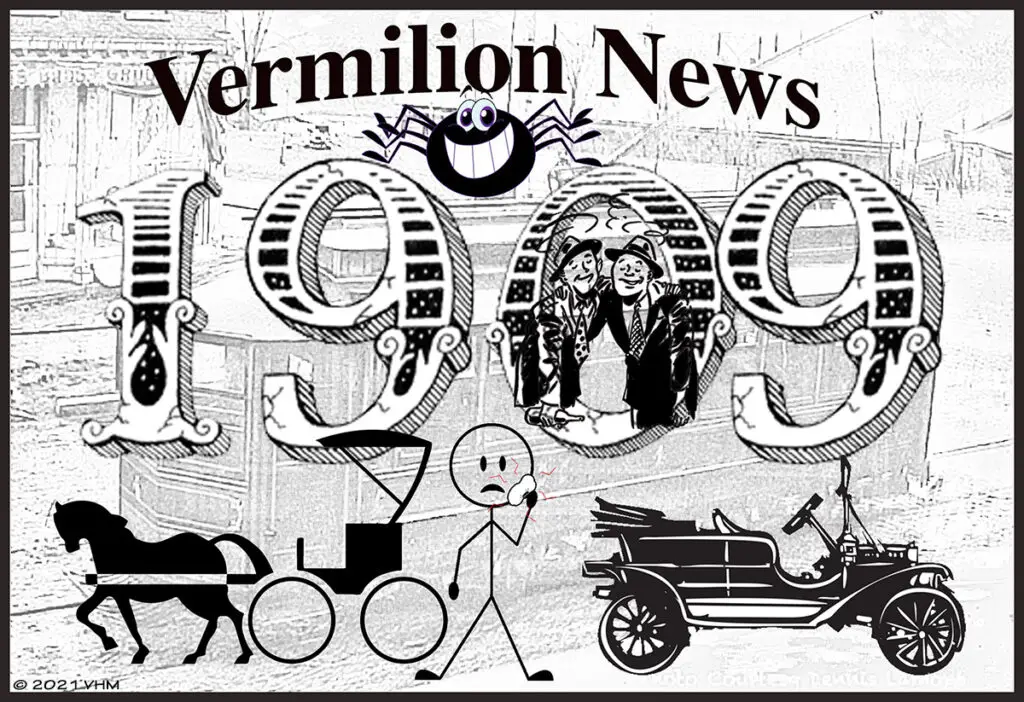
Prologue: It is likely that I have mentioned this in the past but will do it again in case someone missed it. Every week I spend a fair amount of time transcribing pertinent (or at least what I believe is interesting) information from past issues of the town’s former weekly “The Vermilion News” from microfilm to my computer. To facilitate the process, I use voice recognition software that is very accurate, but not infallible. The text requires some editing following every transcription.
Setting that “tech” stuff aside it is the information that’s important. And it’s also the information that is fun. Currently I’m wandering around August 1913 Vermilion. But just for this writing I’m going to take ye back a few years earlier, to August 19, 1909. What follows is one of the frontpage articles verbatim. The headline read: “Painless Dentistry”
“A man passed the NEWS office the other day with a stutter in his walk. The sidewalk was too narrow for him. He passed around to the town hall shed and we investigated. He was from Birmingham and having a tooth, which was rather cantankerous came to Vermilion for an operation. Not having faith in modern painless dentistry and having a fear for the ‘deadly forks’ as he called them, he proceeded to absorb liquid courage. Whether the tooth was removed or not enters not into the story, but he was perfectly aware of his condition and wanted to get home. He was sent on his way ‘rejoicing.’ I’d be willing to wager that when this fella woke the next day, he wished he had visited the dentist. Not only would his tooth still ache, but so would his head.
In other news it was reported that A.L. Irey, the former VHS Principal was to replace J.C. Seemann as Superintendent of our schools. Mr. Irey would in 1914 resign from the office after exhibiting some rather bazaar and scandalous behaviors that (unfortunately) caused him to be confined to a mental health facility where he spent remainder of his days on earth.
In nearby Amherst it was reported that, “A Tarantula measuring three inches and a half was captured at the Quarry Store Friday evening.” Also that a guy named Pat Crowe of South Amherst had been placed in jail Monday evening by Marshall Wilford on account of drunkenness, and that the R.C. Edward’s saloon had been broken into by thieves and ten dollars in cash had been taken along with a watch and several boxes of cigars.
Then, south of town, in the busy metropolis of Birmingham Mr. Ed Howe’s barn had been struck by lightning during a storm “and almost instantly was in flames all over. Mr. Howe’s team was in the barn, but he got them out safely, also a calf which was tied in the barn.” He had been breaking a colt that was in a box stall in the barn but only got the colt as far as the barn door when it was driven back by the intense smoke. Because the fire had already crossed the safety limit Mr. Howe could not go back and the horse perished. He did, however, save his buggies and a few other tools. The loss it said fell rather heavy on Mr. Howe because he carried no insurance.
Back in Vermilion the Baumhart family reunion was to be held at the Park and The Gorton Minstrels were providing entertainment at the Opera House to a well filled house. Fish tug Capt. L.J. “Laddie” Martinek had been called to Kincardine, Canada by the serious illness of his mother-in-law. Charles Heidloff was suffering from an attack of typhoid fever. And Master Frankie Baker was spending a few days in Lorain. [NOTE: Master Baker grew up to own and operate a very successful Ford Dealership in Vermilion. His grandson, Gene, currently runs Vermilion’s water filtration plant.]
There were also big doings downtown in Exchange Park where a crowd was entertained by a “Dog Show”. It was said that the animals were well-trained and well worth seeing.” A hat was passed for contributions.
It was also reported that the Lake Shore (electric) depot would be moved to a position nearly over the Toledo sewer. However, it went on to explain that “this rumor cannot be verified.”
Then to put some icing on this historical cake it was reported that Dr. R.P. Pelton had been arrested for “speeding” in his auto one evening under complaint of one Mr. Carey. The claim was made that he was going at a rate of 11 miles an hour. The case came up for hearing Friday but as the lawyer for the prosecution did not arrive the hearing was postponed and finally the charge was withdrawn.
Epilogue: This is a wonderful perspective piece adding some color to our yesteryear. In 1909 folks were still using horse and buggies, feet, and bicycles for most of their local transportation needs. I imagine that there were more than a few folks who didn’t care for automobiles. Had I been casting my shadow across the earth back then I must admit that I would’ve probably been one of those curmudgeons. Who needs progress? (No matter that I live and work in a digitized world.) As American Pulitzer Prize winning novelist Ellen Glasgow saw it, “All change is not growth, as all movement is not forward.” Sometimes we just move sideways.
Vermilion resident Rich Tarrant is Curator of the Vermilion History Museum and a son and a grandson of the late proprietors of The Vermilion News (1897-1964). Readers may email him at: rnt@twc.com
©RNT Sunday, August 1, 2021

John "Jack" Gray
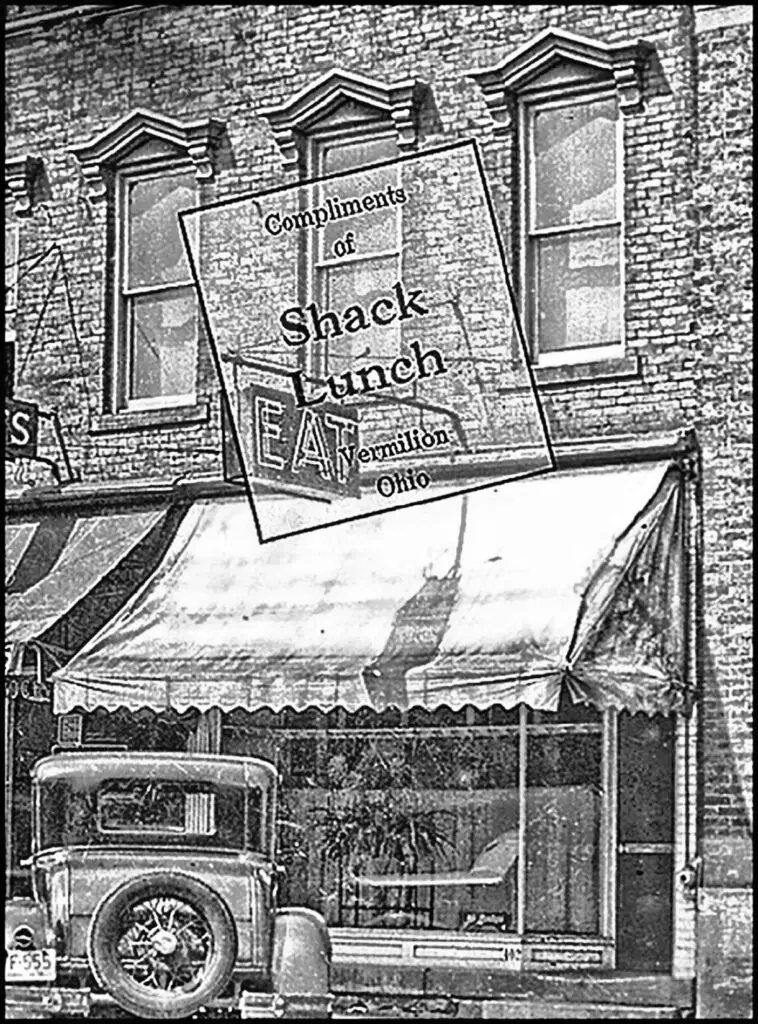
My Pa talked of him a good deal when I was young: Jack Gray. What memories I have of him flicker like the flames of a candle. They’re there one moment and gone the next. I seem to recall that he lived in a little cement-block house on the southeast corner of (901) Jefferson and Thompson (now Edson) streets, and that he drove an old red jeep. I’d say he had a dog, but I think I put the dog into my vision of him because he should’ve had one (if he didn’t). Anyway, my dad saw him as a character – a good one. He was born in Ireland and apparently had a brogue. But, again, I may be coloring the picture (so to speak) with my own crayons.
Prior to coming to Vermilion he had worked as a baker in Toledo. At that time, he was married to a lady named Francis. They had no children, and were later divorced. Upon his death his nearest relative, some found, was a nephew who then lived in Marysville, Ohio.
Jack had been born in 1883 so by the time the war came he was probably too old to serve as a soldier. Instead, he worked as a welder at American Shipbuilding in Lorain during, and for some time following, the war
Part of what I knew of Jack Gray was that he was a kinda’ rough-and-tumble no nonsense guy if the going got rough. During the 1930s, before WW2, he owned, and operated, a little diner on Division (now Main) Street he called the “Shack Lunch”. From what Dad used to say it was open all-night. And one of his specialties was a hamburger sandwich that was served between two slices of bread – not on a bun.
Those sandwiches always sounded good to me. And there have been times when I have made hamburger sandwiches the “Jack Gray” way (with “everything”). But kindly note it helps if the bread is toasted.
Through the years that Jack had his diner a few boneheads thought it would be a good idea to rob him. But they were mistaken. It was a terrible idea. That’s because Jack kept his own pistola handy. He was, according to Pa, the local champ of the Mexican Standoff.
I’ve been told that Jack (at one time) owned a good deal of the land west of Jefferson, and south of Thompson (now Edson) streets to the creek.
A Vermilion developer named Conrad “Coonie” Neiding purchased the property around 1961-62 for a subdivision he called Allendale. In fact, my wife and I once owned the first home built there. It’s in an area where I recall playing the role of an intrepid b-b gun hunter of innocent birds in my pre-teen years. (I should add that I couldn’t hit a barn door with a banjo much less a bird with a b-b gun.) But I digress.
Jack died on December 4, 1962, at the Hall Rest Home here in Vermilion. The Hall facility was located in the old Pelton house on the northeast corner of Liberty and Decatur streets across from the current Vermilion Police Station. He was interred at Maple Grove Cemetery.
John “Jack” Gray was one of those Vermilion characters I never had the privilege of knowing outside my Pa’s tales of Vermilion’s yesteryear. But, gosh-a-mighty I wish I’d known him better.
Vermilion resident Rich Tarrant is Curator of the Vermilion History Museum and a son and a grandson of the late proprietors of The Vermilion News (1897-1964). Readers may email him at: rnt@twc.com
RNT
Saturday, July 24, 2021

Not Really About the Shell Station
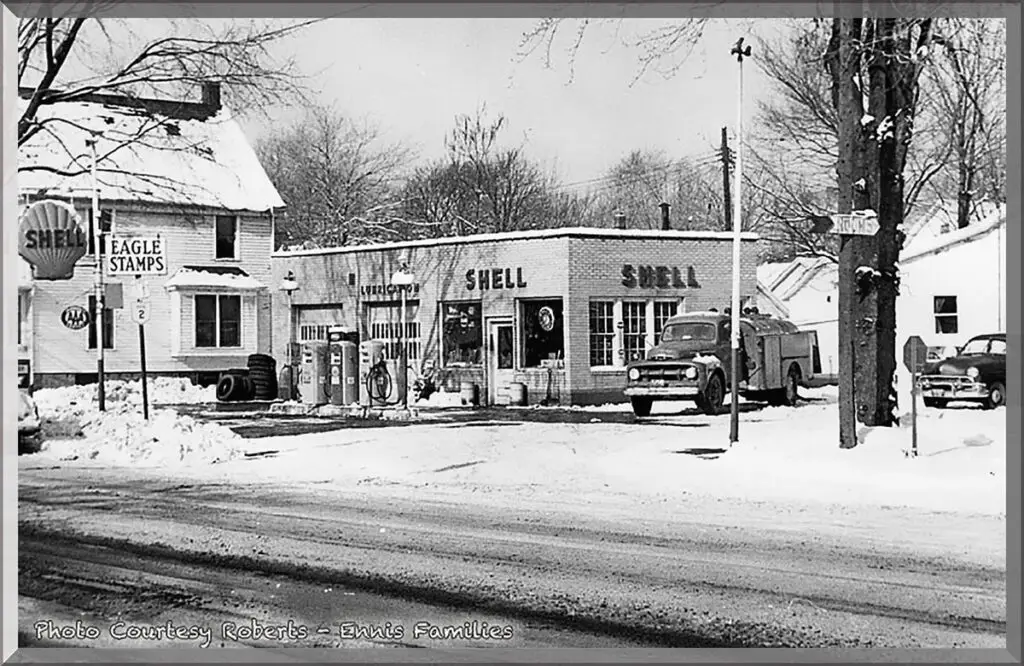
This essay isn’t really about George Roberts’ Shell station (pictured on the northwest corner of Liberty and Washington Streets). Nor is it about the years “Chic” Pettigrew owned it. Though as I think back both would make good stories. Chic, his dad, the Wellner boys (Wally and Paul), and Chic’s boys were all good workers, and fun to be around. And George Roberts was a man who – at least as I knew him – seemed always to be in good spirits; a man who actually whistled while he worked. But, as I’ve said, this isn’t really about the Shell station.
What this is really about is a response I received regarding a “Yesteryear” story from Vermilion expatriate John Dickason – who currently lives in the wilds of Maine. John’s father – Dr. Dickason – was a prominent Vermilion physician whose life and times in our community are near legend. Late Vermilion historian George Wakefield often wrote of him, and late Vermilion nonagenarian Hank Fischer is also inclined to include him in some of his great remembrances of Vermilion’s past. In any case, what follows is (by and large) John’s response to that story. Methinks many will find it both educational and entertaining:
“Your PhotoJournal article of May 20, 2010…featuring the old Boat House Inn, brought back a few memories, particularly as regards George Roberts (and he and my Dad’s various adventures). You might recall that sometime after George ran the Sinclair station pictured in that article, he owned and operated a Gulf station on the southeast corner of Liberty and Decatur (later the location of the Police department). My earliest memory is of the Captain Stone house (later Don Englebry’s) and that Gulf station operated by one “Pie” Durbin (sp?). I assume George took it over from him, but don’t know just when. I also don’t know what “Pie’s” real name was, but I can still picture him. The Gulf station was very small, maybe had only one pump. It was a white stucco (?) building that looked more like a kiosk than a gas station. It sat on the property so that it faced northwest, so cars from either Liberty or Decatur (then Route 1) could drive straight in. It was after this that George took on the Shell station [pictured] you mentioned at Washington Street; I don’t remember what year that was. What I do remember about the Gulf station (and the corner) would be from about 1941-1947. Most of those were War years, of course. For reference, I was 10 years old when it ended in 1945. I remember that, from our house, we would occasionally hear a lot of commotion out on Route 1 – and coming into town from the West would be numerous MP’s on motorcycles. After they had stationed themselves at each intersection through town, there would follow a long convoy of troop carriers transporting soldiers to…we always wondered where? Anyway, it was quite thrilling for us kids to stand there on the corner (across from the gas station) to watch the whole thing pass. Another thing I recall about that corner is that it was fairly common for a west bound tractor-trailer to “roll over” while making what was basically a right-angle turn – thus ending up on its side against the trees on Captain Stone’s property. When we heard one of these “crashes,” we would hurry over to the Gulf station because it was fun to listen as George would put in a call to the police (Ed Benson) and for a wrecker (maybe “Waddie” Stone?) I can still remember George (as he waited for the phone to answer) invariably asking the trucker “…your tractor?” The other place they rolled over (actually slammed into, as I recall you writing not long ago) were at the pumps in front of the Kyle garage (now a city building). But those were east bound trucks; the west bounders were more fun, I thought.
Then there was the Coke “machine.” In the summer, there was that red and white cooler right next to the gas station doorway. And a bottle of pop cost a dime. Doug [Francis] and I always complained to George that the cooler had way too much Coke and not enough of the great Sandusky Bottling Company flavors that we preferred. But George always patiently explained to us that the drivers coming in from a hot day on the road wanted…Coca Cola!
As you may know, George Roberts and my Dad were not only best friends, but “business associates” as well. Not to mention golfing buddies or – as I often describe them – golfing’s “partners in crime.” To go golfing with them should be a story in itself. Trust me on this. Anyway, I’ll bet that not many of your readers know that what is now the Buyer’s Fair Store started life as a…bowling alley. Yes! George and Dad bought the property along with the Arco station property [Now Wise & Son Auto Services] next door with the express purpose of building a bowling alley / rec room, etc. Alas for the town, wartime restrictions on the materials, permits, etc. that they would need for a bowling alley eventually turned their plans into a Kroger store – which some might recall it before it became Buyer’s Fair [Now Moes Marine Services]. – John Dickason.”
And time marches on. But thanks to men like George and “Doc” it moved ahead. And thanks to folks like John Dickason – who may live elsewhere – but whose hearts still abide in Vermilion – the people of our community, and their accomplishments of yesteryear, may be fondly remembered for years to come.
Ref: Special Thanks to: Leslie and Bud Ennis; and John Dickason: VPJ, 06/10/10; Rev. 07/18/21.
Vermilion resident Rich Tarrant is Curator of the Vermilion History Museum and a son and a grandson of the late proprietors of The Vermilion News (1897-1964). Readers may email him at: rnt@twc.com
©Sunday, July 18, 2021
For All Who Wonder About Vermilion’s Cannons…
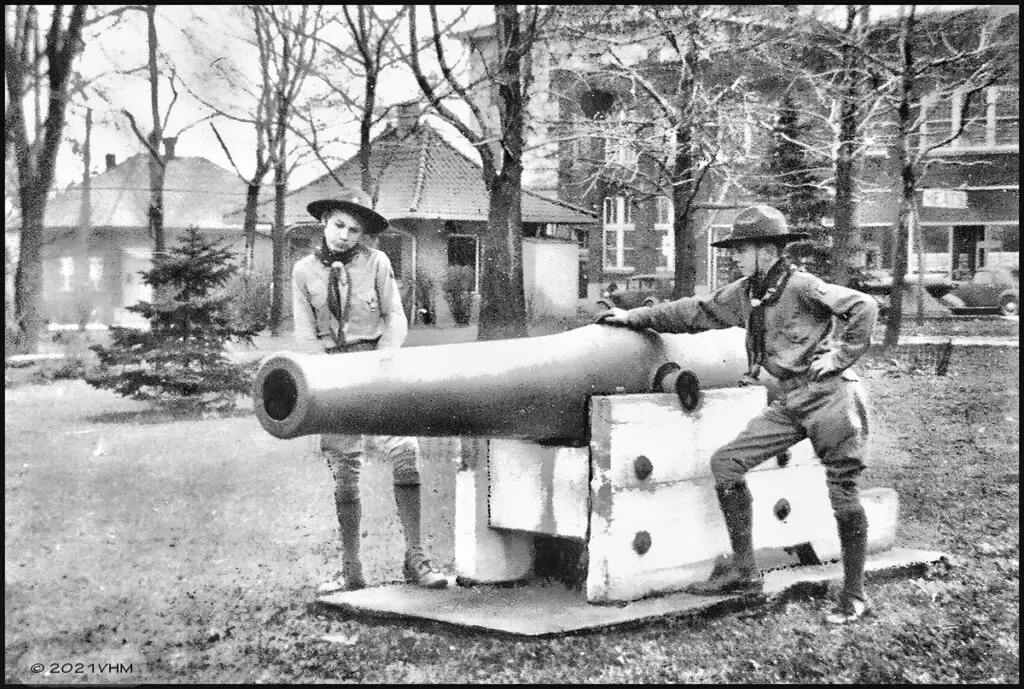
The photograph accompanying the essay this week was taken by a young man named John Bernard “Bernie” Gribble during the summer of 1941. Gribble was 16 years old at the time. Although I have no concrete evidence to prove it, the photo was very likely taken by the young man in an effort to earn a Scout merit badge in photography. It is of very good quality. In fact it was so good that it was published on the front page of The Vermilion News on 29 January in 1942. Given the fact that this was well before the time of Polaroid and digital cameras this was no mean feat on Gribble’s part. The only fault one might take with it has more to do with the newspaper staff than the photographer: the Scouts pictured were never identified.
On the other hand the photo was not really the subject of the headline over it, which read, “Cannons in the Park Fired Salutes”, or the article that followed it. Most of the information in that piece was provided by long time Village Mayor, H.R. “Squire” Williams. The reason Mr. Williams knew so much about the cannons that still sit in Exchange / Rubberneck Park was because he and a well-known Vermilion doctor, F.E. Englebry, were responsible for their acquisition back in the spring of 1898. At the time Dr. Englebry [VPJ 01/26/18] was the village mayor and Mr. Williams a young attorney.
The cannons are 32-pound (i.e. a gun firing 32 pounds of weight) Naval cannons. Mr. Williams noted that they were shipped here by train from Boston and hauled from the depot to the park by a local contractor named Dan Thompson; the local postmaster Edgar Kane furnished the lumber for the stanchions; and Harry Rose a local painter, painted them.
The first time they were fired in Vermilion was during a 4th of July celebration in 1898. A small charge – 1 and a half pounds – was loaded and fired by Mr. Williams. Those present during that “big bang” were G.A.R. members Albert Alonzo Blair, Tom Ball and Charles A. Mattison.
The last time the gun was fired was in 1921. By that time Williams was Mayor and had been several times. It was also a 4th of July celebration. At this time the newly formed Fiebirch Post of the American Legion was in charge of festivities. The Mayor offered to buy a keg of powder for the “boys” if they used the cannon, and two local veterans, Marty Strahle and John Leidheiser, attempted to secure the powder with no success. Finally they acquired a keg of coarse grain blasting powder.
The cannon they used was the one facing Lake Erie. During the cleaning of the gun it was found that a priming of black powder was required to ignite the main charge of blasting powder. They used old fishing nets as wadding. At sunrise on the Glorious 4th the first round was fired attracting every youngster in the village to the park like a magnet. Mr. Williams specifically noted that eleven-year-old Vermilionite John Trinter was the first to arrive. The gun was then fired at stated intervals throughout the day.
A grand finale of sorts was slated for a sunset service in the park. Unfortunately, it was discovered that there was no black powder left to prime the gun. While Bill Tarrant, the first legion post commander, was searching around for something to use, the gun crew filled the cannon with wet nets and mud. Mike Kishman who was clerking at Albert Hart’s drugstore while on vacation from medical school suggested that ether could do the job. And it most certainly did.
I am amused by Williams’s eyewitness description of the sunset ceremony that ensued: “The people collected. The flag flew high on the pole. Babe Thompson’s bugle sounded retreat. Tarrant stood by the canon with its charge primed with the ether. He lighted a safety match and placed it over the touchhole. Then things happened.”
“With a thunderous roar the canon leapt into the air, carriage and all; snapped off the steel cable with which it was anchored, the cannon came down much off the base; windows rattled; the bass drummer in the G. A. R. Band, Johnny Krapp, held both heads of the drum to save it from vibration; the mud in nets spewed from the Canon tore into the cement form that Phil Darley had just built for the Kishman Fish Company’s twine loft, and raked the river to beyond the lighthouse.”
“The band played the national anthem; the flag came down with the crowd standing at attention.”
Methinks, however, that the crowd was not really standing at attention. They were frozen in shock. In any case, if you ever wonder about the cannons in the park, that is the story. It’s also very likely the reason they’ve not been fired since 1921.
Ref: The Vermilion News 01/29/1942; VPJ 07/17/2018; Rev. 07/11/2021.© 2021 VHM
Vermilion resident Rich Tarrant has agreed to share many of the photos and stories he has acquired from the former Vermilion News and other local sources with the readers of the Photojournal. Rich is the youngest son and a grandson of the late proprietors of The Vermilion News (1897-1964). Readers may email him at: rnt@twc.com

Just A Coincidence
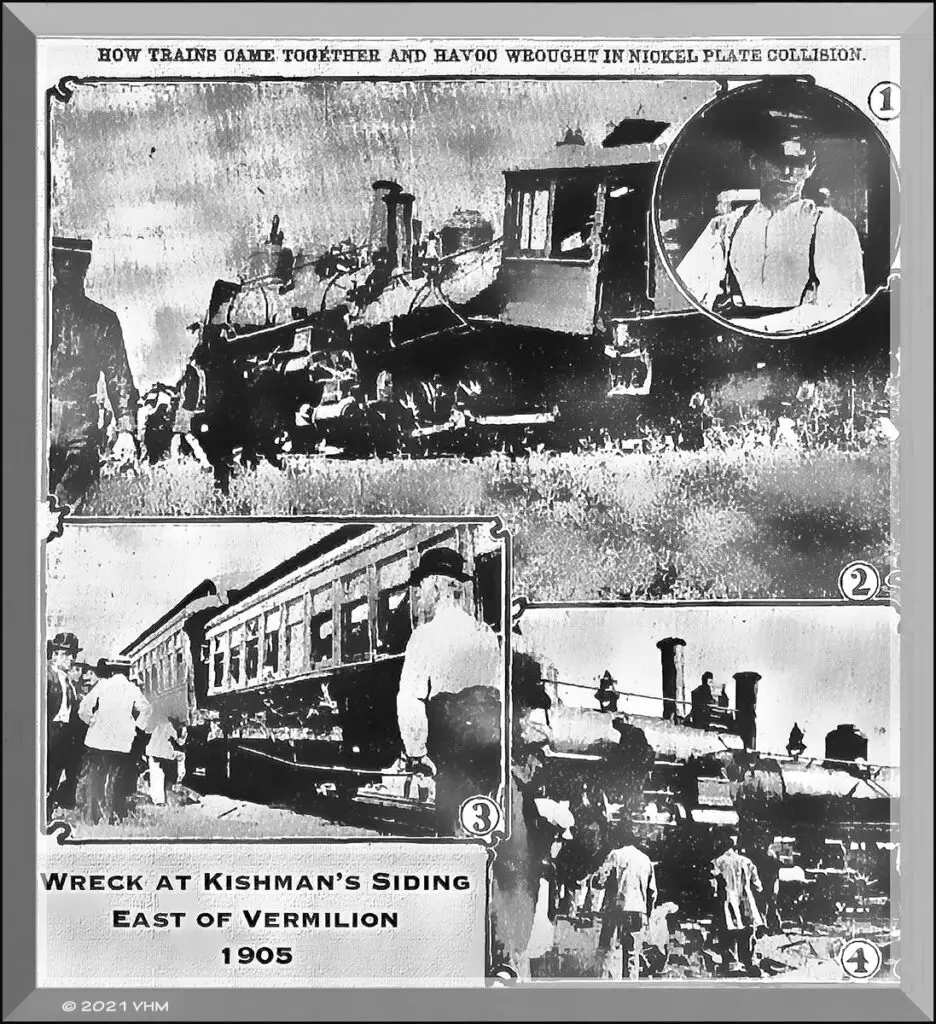
I supposed it was just a coincidence. Several years ago, while searching through some old newspaper archives for train wrecks that occurred in and around our town in the yesteryear my wife, Georgi, told me that Patty Kishman, from the library, had sent her an e-mail inquiry about a train wreck near town that took place on August 13, 1905. I assumed that a small part of what captured Patty’s interest was the fact that it took place on the Nickel Plate railroad at what many of the newspaper reports referred to as “Kishman”, Ohio.
Whether or not the place referred to as “Kishman and/or Kishman’s” was ever a formally incorporated municipality in Ohio is anyone’s guess. But the place known by railroaders as “Kishman’s siding” denotes a place – a siding – along the Nickel Plate rails several miles east of the Village of Vermilion where rail cars could be stored aside the mainline (rails) until needed. I now guess that it was located near the site where the former Ford Company parked and shipped cars along Lake Road just north of Baumhart Road. The siding was also used as a place where one train could enter to allow another train to pass on the mainline. At least that is what was supposed to happen in the early morning hours of August 13, 1905 – but it didn’t. What did happen was, perhaps, one of the worst disasters in the history of the Nickel Plate line.
The mid-August weekend had been a busy one for all the resorts along the southern coast of Lake Erie. The Sandusky Star-Register estimated that 14,000 people had been transported to their city on 14 trains from all the big cities in Ohio plus a few from Indiana. The electric lines had all they could handle. Cedar Point and Johnson’s Island were teeming with folks on midsummer holiday. The weather was perfect. Who could ask for more?
And so it was that toward the end this flawless weekend that a west bound freight train (No. 37) left Cleveland and steamed through Lorain toward Vermilion. It was sometime after midnight when the crew on the freight neared Kishman’s siding. Their orders were to move their train into the siding to let an eastbound passenger train pass.
When they arrived at the siding, they found several fully loaded freight cars stationed on the tracks. Apparently, they thought it would be impossible for them to fully clear the mainline by going forward into the siding, so they decided to back into it – forcing the loaded cars back down the steeply graded siding. This would also have made it easier for them to resume their journey once the passenger train had passed.
At precisely 1 a.m. a Lake Shore Electric car, piloted by motorman B.D. Marsac, was headed toward Vermilion and was passing the Baumhardt farm (VPJ 7-22-10) along Lake Road when he heard a terrible crash. The Westbound freight No. 37 had not yet made it into the siding and was sitting dead on the mainline rails when the eastbound passenger train going 50 MPH collided with it head-on. Realizing the seriousness of the collision, the LSE motorman didn’t even pause his train. He continued at full speed into Vermilion, returning as quickly as possible with all the medical help he could find.
The impact of the collision drove the passenger locomotive half way through the freight locomotive. The smoker on the passenger – filled with Italian laborers – was smashed into kindling. Twelve people, including the passenger Engineer, C.W. Poole of Conneaut, were killed, and over 30 were injured. Many aboard were Italian laborers who had been working for a large construction firm Kronebery & Co. of Buffalo who, having finished their seasonal work in Chicago, were headed to their homes in the East. The workers were identified by the numbered “K & Co.” brass tags in their possession.
Initially, the crew on the freight was blamed for the accident. But early the following September Lorain County Coroner French concluded that both Nickel Plate crews were negligent. While the freight crew most certainly demonstrated poor judgement in their backing rather than moving forward into the siding, the engineer on passenger train No. 4, French concluded, was not wholly without blame. This was because the collision occurred on straight track and the freight displayed a head light which was apparently ignored by Engineer Poole. This official ruling was in spite of the fact that Poole, one of the oldest in service on the Nickel Plate, stayed aboard his locomotive long enough to put on the air brakes and reverse his engine. For whatever reason the heroics which cost him his life were either completely dismissed or ignored.
To be sure it may have been a coincidence that Vermilionite Patty Kishman should ask about this place, and this accident, as I was beginning research on the subject. Perhaps…
PICTURE KEY: 1 – Express Messenger, George W. Bertsh: Escaped alive from amid disaster; 2 – Engines of Passenger And Freight Trains: Driven together by impact of collision; 3 – Cars Telescoped After Wreck: Showing how shock shattered heavy timbers; 4 – Closer View: Of the two batter dismantled locomotives locked in death grip.
Ref: The Elyria Reporter; 8-14-1905; 9-06-1905; The Sandusky Star-Journal 8-14-1905; Anaconda Standard – Montana 8-14-1905; The New York Times, 8-14-1905; Olympia Daily Record, Olympia, WA., 8-14-1905; Special Thanks to Patty Kishman; VPJ 9/10/10; Rev. 07/04/21.
Vermilion resident Rich Tarrant is Curator of the Vermilion History Museum and a son and a grandson of the late proprietors of The Vermilion News (1897-1964). Readers may email him at: rnt@twc.com
Sunday, July 4, 2021
A Nice Conversation with John Tuttle
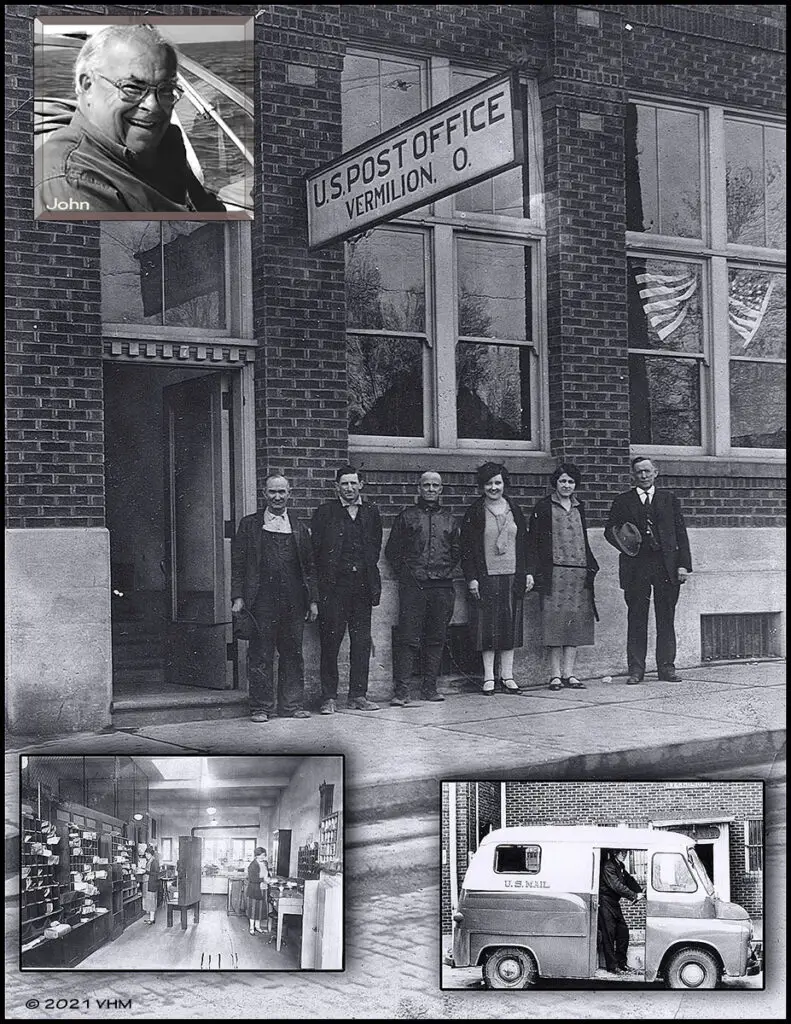
I don’t now recall the reason I was at the Vermilion History Museum on a Sunday (02/17/13). I normally take the day off. But I was probably searching for something I wanted to write about. I do remember that it was very cold and somewhat sunny because for some unknown reason I remember the sun shining brightly on the papers in front of me where I sat at the ancient news desk where I was sitting. And I also recollect being somewhat startled when the (land line) phone rang. After all, it was Sunday.
I might have ignored the call. But because phones now have what is commonly known as “caller id” I answered. The caller was Vermilionite John Tuttle. I had known John, as well as his father Paul, all my life. I also knew that he knew a good deal about the history of Vermilion (among many other things) that I did not. Consequently, I wanted to talk with him.
John had phoned to talk about a history (narrative) monograph I had recently written for the Vermilion Photojournal (VPJ 02/10/13) about the local post office. As it turns out he worked there part-time when he was in high school. It was, at that time, located on the far eastern part of the Fischer building on Liberty Ave where the “Brewed Awakening” coffee shop is today (2021).
John told me that after Charlie Trinter retired as postmaster his father and Vermilion attorney Tom Williams vied for the office. Tom, as many Vermilion homebodies know, got the job. And Paul went back to teaching school. [Note: Political representatives appointed postmasters until 1969 when the appointments were then mandated by law to be made on a “merit basis without the usual political clearance.”] Anyway, after Mr. Williams was made postmaster (1944-45) he hired young John to work at the office.
Because he’d delivered newspapers throughout town and, later worked for the local Western Union (telegraph) office John obviously knew everybody, as well as everybody’s aunts, uncles, sisters, brothers, and their dogs and cats in the village. Consequently, Tom had John delivering special letters and packages around the town on his bike whenever he was available. When school started John also opened the office in the mornings and took up sundry other duties until the regular crew arrived.
John also reminded me of all the persons who’d once worked in that particular office. Some of them were George Harris (Asst. Postmaster); a fellow named Fritz (whose last name neither he nor I could remember; Milton Karchin; one of the Hasenflue men; Ruby Tischer; Roy Kniesel; Gordon Sahr; Fred Harpley; Doris Hughes; and my brother Phil. At the time I had completely forgotten about George Harris for some reason. Milton, however, was and is a different story. Milt eventually went to work at the Cleveland Post Office. He was truly a “bonified character”. I have some very vivid memories of him standing in the News office animatedly espousing his political views on the state of the world to anyone and everyone in hearing distance. (I was only eight years old and couldn’t take my eyes off him.)
Milt was, in the years John was referring to, “THE” town postman. He delivered mail to everyone in the village proper. The businesses downtown (i.e., along Liberty and Division streets) got two mail deliveries a day. Today that (both John and I opined) would be impossible. And even then – it was a stretch. But that was “Old Vermilion” – which is another subject altogether. (About that we both agreed.)
[As an aside to the gist of our conversation John also made a point of telling me the name of the people who built the building where the current Vermilion Police station is located. I mistakenly thought that his father, Paul, built it for their insurance firm. But, in fact, a company owned by some men with the last name of Risom built it to house a Lawson store – which did (later) operate at that location for many years. He just thought that I should know. And I do appreciate knowing that fact.]
Anyway, it was the last time I would get to talk with him. A little over a year later he was gone. But, gosh darn! We had a nice conversation that day.
Vermilion resident Rich Tarrant is Curator of the Vermilion History Museum and a son and a grandson of the late proprietors of The Vermilion News (1897-1964).© 2021 RNT; Readers may email him at: rnt@twc.com;
The Rainbow
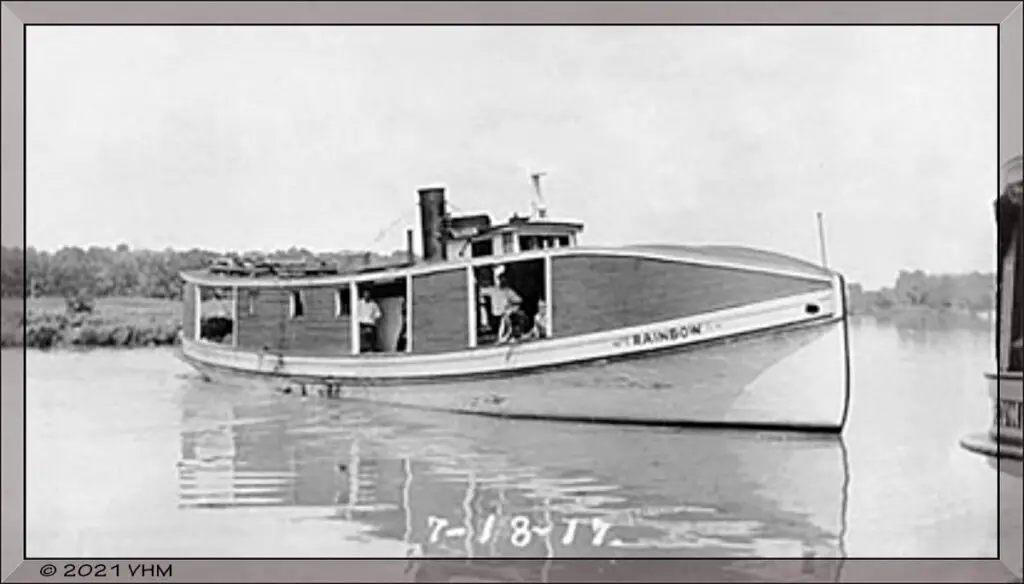
Many professional fishermen along the Great Lakes called it “The Golden Age of Commercial Fishing”. What it refers to was an idyllic period of time when Lake Erie waters ran so clear one could see a school of blue pike 10 feet beneath the surface; a time when it was so clean one could drink from a tin can dipped in the lake; a time when local trapnetters would set out 40 nets and upon their return everyone would boil with a ton or more of perch; and last, but hardly least, a time when there was very, very little government interference in their pursuits – their livelihoods.
Precisely when this era began, or when it ended, is unclear. Most of those who knew those times are now gone. The boats with which they worked the wave-capped fields and upon which they harvested the bounties they found beneath the great lake are also gone. So, by and large, all we can know of those days is confined to a very few history books (some out of print), and a few worn and faded snapshots squirrelled away in a trunk in someone’s attic waiting to be dusted off and found.
The accompanying snapshot of the “Rainbow” is one of those items. Seen here near the Kishman docks in the summer of 1917 the steam-powered gillnet tug is very likely basking in the blush of commercial fishing’s Hyblaean age.
At the time the Kishman Fishery gillnetter was captained by a gentleman named John P. Naegele. Naegele was a first generation American. Born in Vermilion in 1878 both parents had immigrated from Germany some years earlier. He and his wife, Carrie, lived in a tidy white frame house at, what was then, 201 Huron Street. They had no children. But they had a niece (Mrs. Harold Markman) who lived in San Raphael, California, and two nephews: Allen Hasenflue and Dr. Paul Naegele. All were well known Vermilionites.
In 1935 Naegele abruptly left fishing and moved to Erie Pennsylvania where he worked for the Erie Sand and Gravel Company, and then the Talon Zipper Company. The reason for this sudden change in occupation is unknown (to me). But the fate of the Rainbow is not.
Sometime later (possibly during the late 1930’s) the old gillnetter was abandoned and lay on her side near the dock at the Vermilion Yacht Club. According to late Vermilion historian, George Wakefield, Captain Clifford Parsons was then hired to dispose of her – and proceeded to do just that.
He dried her out and towed her with his tug Alma out into a deep part of the lake and sunk her. But no sooner had she gone beneath the surface than up she came again like a cork – much (it should be added) to the consternation of both Parsons and the Coast Guard. If they allowed the old tug to continue bobbing about the lake it would have become a very real navigational hazard. Capt. Parsons solved the problem. But as Wakefield politely put it, the authorities were “pretty rough on him after the fiasco at the end of the Rainbow.”
In 1958 John and Carrie Naegele retired to their home in Vermilion. In the spring of 1962 Carrie was scratched by a plant while working in her flower garden behind their home on Huron Street, and subsequently died when it became severely infected. In August of the same year John also sailed into eternity.
A bit over 100 years have passed since the July afternoon when an amateur photographer captured the “Rainbow” gliding into the dock at the Kishman Company with a smiling crew that included several youngsters. The old “focus challenged” snapshot afterward lay forgotten in someone’s collection of old memorabilia until, as if in tribute to the final days of the old steam tug, it bobbed to the surface of our lives along with a rainbow of ruminations of yet another yesteryear.
Ref: Lake Erie Fishermen, Work, Tradition, and Identity; Lloyd and Mullen, University of Illinois Press, 1990; Lure of the Lakes, A Taste of The Great Lakes; George Wakefield, 2001; U.S. Census 1910, 20, 30; Ohio Deaths 1908-2002; Special Thanks to Warren and late Anita Mehnert.
Vermilion resident Rich Tarrant is Curator of the Vermilion History Museum and a son and a grandson of the late proprietors of The Vermilion News (1897-1964). © 2021 RNT Readers may email him at: rnt@twc.com
Inside And Outside Rembrandt Studio
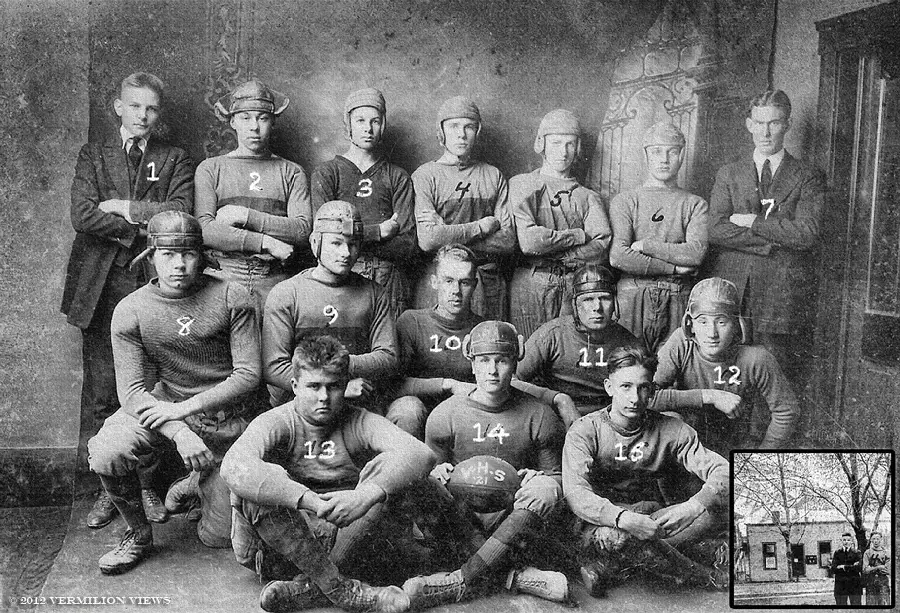
Back in the early years of the 20th century professional photographer Rudy Moc started out in a studio he called “Rembrandt Studio” on Grand Street in Vermilion O. That studio was located in a small clapboard building on the east side of the street just north of the railroad tracks. The studio can be seen in the background of the inset photo in the lower right corner of the larger photograph.
Eventually Mr. Moc’s photography business became so successful that he moved to a larger facility in nearby Lorain. Afterward, the building served as Vermilion’s very first permanent library. During the Great Depression it was torn down and a brick book depository was built on the site. It currently houses “The Jailhouse” bed and breakfast.
The larger portrait is that of the Vermilion High School football team of 1922. Though the photographs are from two different sources (i.e. two different photographers) they, as a matter of great coincidence, appear to be companion pieces. The larger photo was taken inside the studio, and the smaller picture was taken outside, and across the street from it, on what appears to be the same day. To understand the reason behind such a hypothesis let’s first take a look at the team portrait.
TOP ROW: 1. Dan Wilkinson (injured during season by broken collarbone) – End, 2. Myron Darley – Half Back, 3. William Harris – Sub End, 4. Grover Clauson – Left Guard, 5. Charles Mehnert – Right End, 6. Arthur Faulkner – Right Tackle, and 7. R.A. Herman – Coach.
MIDDLE ROW: 8. Early Fitzgerald – Half Back, 9. Vernon Moyer – Left Guard, 10. Donald Englebry – Right Guard, 11. Robert Kuehlman – Left Tackle, and 12. Ralph Law – Full Back.
BOTTOM ROW: 13. Paul Sanders – Center, 14. Lewis Moyer – Captain – Quarterback, and 15. Floyd Hays – Sub End
Dan Wilkinson and Floyd Hays appear in both photographs. And though it is probably difficult for most readers to see the detail in the smaller photo both young men are dressed in the same clothing they are wearing in the team portrait with Wilkinson posing as he did in the team portrait. Were the smaller photo captured at a different time it is unlikely that the boys would have been dressed in the same clothing. Moreover, Wilkinson’s suit and tie would not likely have been a part of his everyday wardrobe. One might assume, therefore, that the smaller photograph was taken just before or after the team portrait was taken in Moc’s Rembrandt Studio on Grand Street.
The great thing about either photograph from the yesteryear is that someone took the time to identify all the persons in them. As has been said, it is purely “coincidental” that they have been discovered to be “companion pieces”. That, of course, is not an earth-shattering revelation. But it certainly is interesting.
Ref: Special Thanks To: Al Clauson; Published in the VPJ 11/31/11; Rev. 06/14/21.© RNT 06/14/21.
Shadows of a Yesteryear
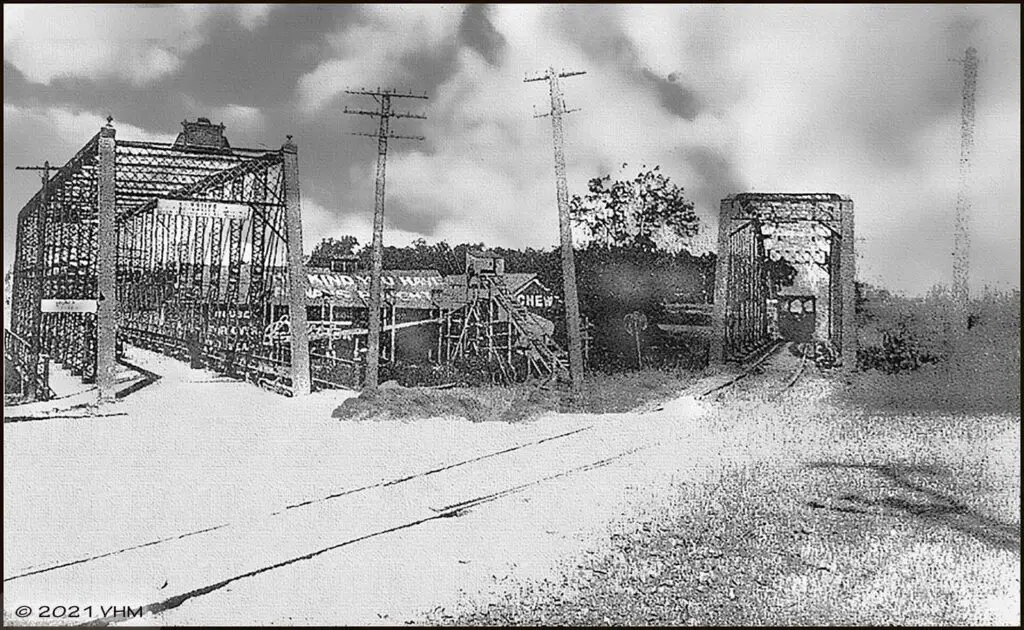
The photo attending this week’s essay was not / is not of very good quality. Nor is it – at least on the surface – a very remarkable photo. I have been familiar with it for several years. But I guess I never really looked further into it until I began tweaking it in Photoshop in an effort to make it more discernable.
For folks unfamiliar with the scene the photo was taken on the west bank of the Vermilion River looking east just a little north (in the street) of what is currently the site of Rotary Park (wherein Vermilion’s old water-tower is located). Neither bridge still exists. The building visible between the bridges was the H.H. Patton and Captain “Big Ed” Lampe’s Southwest Fish Company. The fishery, like the bridges, has also been relegated to history. And today Romp’s wonderful marina and recreation park occupies the site.
What I found interesting after my umpteenth look at the photograph was the extreme closeness of the bridge landings on the west side of the river. One may also note that there are vehicles on both bridges. The bridge on the right was the Lake Shore Electric interurban bridge with an electric car on it. And the bridge on the left was the old wagon / automobile bridge with an auto on it. The auto is heading west. I don’t know which way the electric is going. Nonetheless, it occurs to me that there must have been times when both types of vehicles heading west crossed their respective bridges at about the same time and touched the bank at about the same time. (Yikes!)
There appears to be enough room for an auto to turn before coming to the tracks; and I never came across any account of any collisions at that site, but it certainly seems to have been an uncomfortably close path for both vehicles to have to follow. As some may know, the L.S.E. / interurban tracks ran right down the middle of Liberty Avenue through what was for many years the primary business sector of town.
The wagon / auto bridge had a wood deck. Late resident-historian Hank Fischer recalled the “clacking” sound of the wooden blocks when vehicles crossed the old bridge. There were also walkways for pedestrians. [As an aside, Hank also told a story about the now legendary fishing Captain “Big Ed” Lampe, who while walking across the bridge one day, encountered a friend. Lampe was carrying two fully loaded fish boxes under his arms. Those boxes weren’t light when empty, and they certainly weren’t lighter when full. But no one watching the encounter would’ve known it. Because Big Ed stopped to talk to his friend for several minutes, and never broke a sweat before moving along.]
Around 1901 – before the electric bridge was constructed – a temporary track had been lain over the wagon bridge to allow a party of interurban officials an ability to take an inspection trip of the railway from Cleveland to Detroit. Then in 1902 while using the highway bridge to construct the electric bridge, it was severely damaged when the weight of a steam locomotive workers were using proved to be too much for it. Finally, in 1913 the L.S.E. completed the steel truss bridge (pictured) over the river. It remained in service until the railway ceased operations in 1938. When the bridge was being dismantled a year later interurban officials were seriously embarrassed when the crew accidentally dropped the bridge into the river blocking river traffic and irritating many Vermilion residents and others who used the river on a regular basis.
The old wagon bridge was dismantled and replaced by the existing river bridge in 1929. Abutments for both the old bridges are still visible on the west bank of the river. Only the wagon bridge abutment is visible on the other (east) bank between Vermilionite Jon Clark’s former residence and the store / office for Romp’s marina. Today both the (relatively) new river bridge and the (relatively) old water tower have become Vermilion icons. And the bridges in the picture are merely shadows of a yesteryear that very few persons now alive can still recall.
Ref: Special Thanks to: Hank Fischer; The Lake Shore Electric Story, Harwood, Korach; Indiana University Press, 2000; VNPSM photo archive; Published VPJ 04/08/2014: Rev. 06.06.21.
Vermilion resident Rich Tarrant is Curator of the Vermilion History Museum and a son and a grandson of the late proprietors of The Vermilion News (1897-1964). Readers may email him at: rnt@twc.com
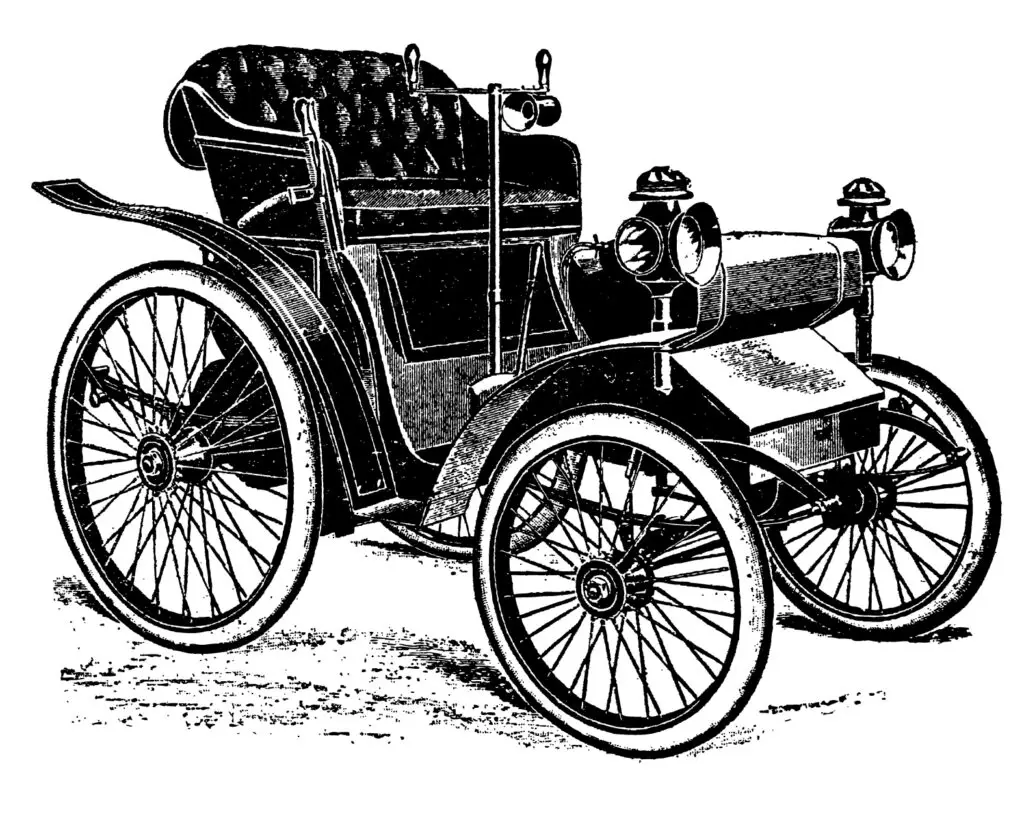
HOWDY-DOODY EVERYONE

My Dad was born in 1898. In his day the word “horsepower” had a very literal meaning. I always found it amazing that my father was born before the automobile became the primary form of transportation in our world. It was a time when locomotives and steamships were the major carriers of people and goods across our planet. I’ve always been in awe of the fact that my Pa was around during the days when the Wright Brothers took flight, and the list of things that transpired during those years goes on, ad infinitum.
I doubt Dad gave any of it much thought. No more than we have during a time when telephones transitioned from rather simple communication devices in homes and businesses into multi-functioning cameras and instantaneous messaging tools that we carry in our pockets. The changes have all been very subtle. And while I don’t think of myself as being very old, [I’m not quite an antique yet. Vintage maybe, but not antique.] I got to thinking the other day about the early days of television in our neighborhood.
I grew in up an era when radio was still the primary vehicle for “current” news and weather reports in America. Families spent a good deal of time “listening” to news reports and, of course, entertainment shows on the radio. In our house we had a nice wood cabinet radio with push buttons between the tuning dials to change stations. Inside the cabinet was a world of tubes, wiring and numerous other things that made it work. When a tube burned out, or something else went amiss, we were lucky, because our neighbor, Alva E. Boone, repaired such devices. He’d change a tube and we’d be back in business.
Sometime around 1950 we got our first television. Up until that time the kids in our neighborhood would occasionally be treated to a televised program on the only set in our neighborhood. It was owned by (who else?) Mr. Boone. Those persons who share my “vintage” may recall that the screens on the first television sets were rather small – probably about 10 inches. [They were actually tubes themselves – ergo, the expression “Boob Tube”.] Anyway, Mr. Boone had a big magnifier thing that he placed in front of the screen that made the picture large enough for everyone in our gang to see without blocking the screen. And, thus, were we were both mesmerized and happy to watch whatever programs were available.
Although the screen of the first set purchased by my parents was no bigger than Mr. Boone’s in our home I could and did sit closer to the set. This was despite my mother’s incessant warnings about ruining my eyesight (which I guess I did). Seldom did I miss an episode of Captain Video and the Video Rangers (which was, by the way, “the” first science fiction program on tv), Howdy Doody, Super Circus, I Love Lucy and later, American Bandstand and the Micky Mouse Club.
My parents and my oldest brother, Billy, were Arthur Godfrey fans. Godfrey had a morning variety show that was a carryover from radio that, for a time, was simulcast. Dad also enjoyed baseball games, a thing called Omnibus, Meet the Press and much later Perry Mason. Mom was a true-blue Lucille Ball fan and, oddly enough, she liked to watch professional wrestling on Saturday afternoons. (Who remembers “Gorgeous George”? He was one of her favorites). Sunday was Polka Variety and the Gene “Uncle Jake” Carrol Show time. There was a little something for everyone.
But I suppose I would be remiss if I didn’t add here that all those programs were in black and white. The only time anyone ever saw Roy Rodgers (the singing cowboy and his beautiful Palomino horse Trigger) in color was on the big screen at the Liberty Theatre. It’s very possible that only “vintagers” such as I would know that. So, throughout those early years of television I, along with legions of other kids, wished, hoped, and secretly prayed that television would suddenly be broadcast in color. The reason “Color by Technicolor” was not available for TV was baffling. But that’s another story for another time. Live long and prosper…
Vermilion resident Rich Tarrant is Curator of the Vermilion History Museum and a son and a grandson of the late proprietors of The Vermilion News (1897-1964). Readers may email him at: rnt@twc.com
RNT- Sunday, May 30, 2021
The Curiosity Shop
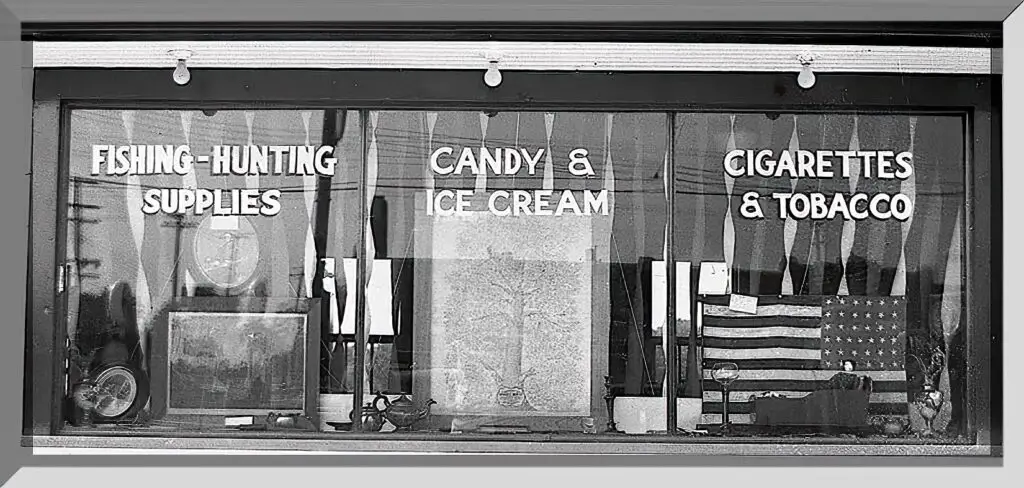
This photo was among several loaned to me by Bud and Leslie Roberts Ennis several (2010) years ago. It is (as you may have already surmised) but a portion of a larger photograph. I don’t believe that it was the main subject of the original. But setting all that aside I still find it to be an extremely fascinating composition.
This window was the front window of Leslie’s uncle, Warren “Smitty” Smith’s “convenient store” on the north side of Liberty Avenue near the river bridge. That building has been recently transformed into the very attractive office for Don Parsons Inc. Marina. I’m guessing, of course, but I believe the photo was most likely taken in 1937 when the Village of Vermilion, O. was celebrating its 100th birthday. That’s because all the items in the window are history related (i.e., the portraits, the tea set, the family tree; and the flag).
The flag is that which caught my eye when I initially looked closely at the photo. It’s old – 37 stars. 37 stars commemorate the entry of the state of Nebraska into the Union in 1867. I assume the flag is home-made because the arrangement of the stars is not a common arrangement on professionally manufactured flags of the times.
I also noted that the flag was not being properly displayed. Don’t get me wrong. I’m not nit-picking. But tis that which caught my attention when first I saw the photograph. For anyone interested the etiquette is:
When the flag is displayed in a manner other than by being flown from a staff, it should be displayed flat, whether indoors or out. When displayed either horizontally or vertically against a wall, the union should be uppermost and to the flag’s own right, that is, to the observer’s left. When displayed in a window it should be displayed in the same way, that is with the union or blue field to the left of the observer in the street. When festoons, rosettes of drapings are desired, bunting of blue, white and red should be used, but never the flag.
I have recently (2021) concluded that the flag in the window may have been hand painted on what appears to be a wooden board. And if that is the case it would have been impossible to turn it the other way without it being shown upside-down – which would have made it a distress signal.
But setting all that aside – it might interest some to know that Vermilion’s Smith Family goes back a long, long way in the annals of local history. And somewhere in that history the family is connected to the Tuttle family of Berlin Heights. I seem to vaguely recall that tidbit of information coming to me from late Vermilion expatriate, Bob Smith, some years ago. (I should have made a formal note of it.)
The Tuttle name pops up in local history books because it was (I believe) the maiden name of a Vermilion pioneer woman named Charlotte Sturgis-Austin. And it pops up again because it is from Berlin Heights natives Hudson and Emma Rood Tuttle (nationally renowned authors and lecturers) from whom we were given the story behind Old Woman Creek.
Thus, it also would have been interesting to know exactly what / who was on the family tree in the middle of the display. And I “wonders” what happened to that old flag as well. But no matter, it’s all very curious – indeed.
Vermilion resident Rich Tarrant is Curator of the Vermilion History Museum and a son and a grandson of the late proprietors of The Vermilion News (1897-1964). Readers may email him at: rnt@twc.com
Sunday, May 23, 2021
Jotham: Just Passing Through
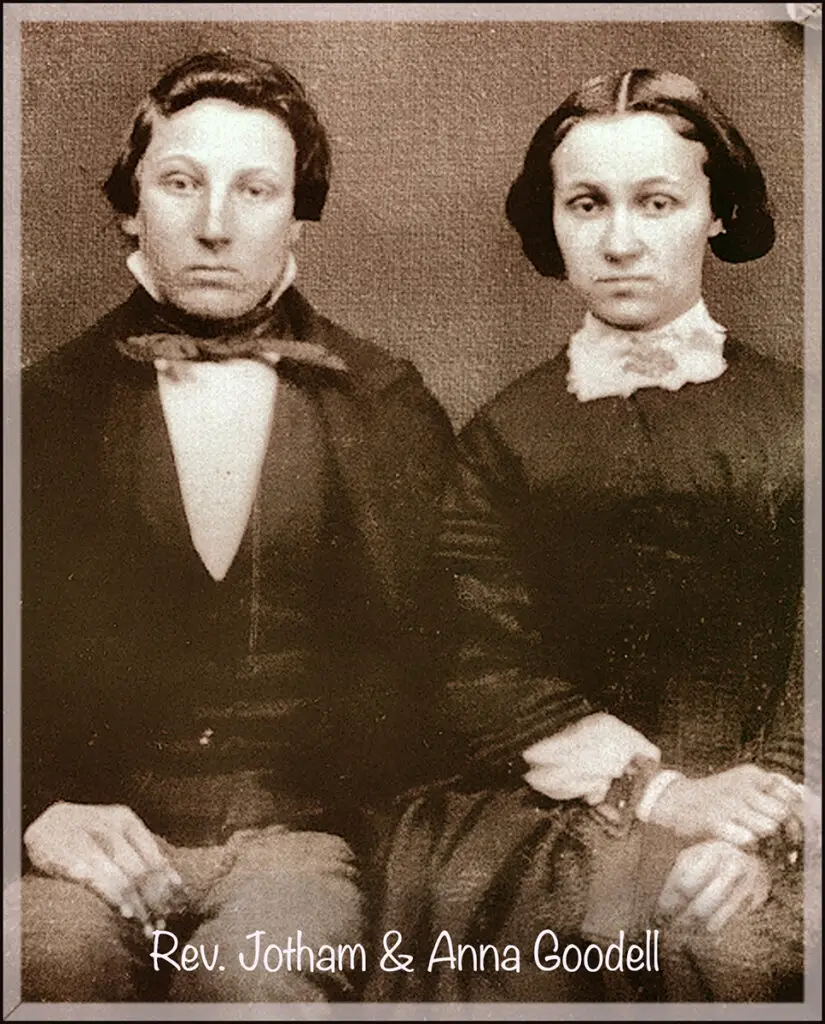
American poet / philosopher Ralph Waldo Emerson (1803-1882) believed that “It is not length of life [which matters], but ‘tis the depth.”
In November 1859 Sylvester and Eunice Pelton of Vermilion, Ohio received a letter from their daughter, Anna Maria Goodell, in Washington Territory. She wrote to tell them that her father-in-law, Jotham, had suffered a stroke, and had passed away.
Jotham Weeks Goodell entered this world on April 23, 1809. He was the youngest of eleven children born to William and Phebe Newton Goodell of Templeton, Massachusetts. They were direct descendants of Robert and Catherine “Goodall” who had arrived at Salem on the Pilgrim ship “Elizabeth” in 1634. Although details regarding his early education are unclear records of his life very clearly indicate that he was both a learned and articulate orator and writer.
At age 18 he entered the ministry and founded the Niagara Presbyterian Church of Canada in Ontario. There he met and married his wife, Anna Glenning Bacheler. It was also there that five of their eleven children were born.
While he was obviously an intensely religious person, he was also a passionate American patriot. He promoted the annexation of Ontario by the United States of America. Goodell Family lore has it that Jotham, Anna, and their children hurriedly migrated to the U.S. from Canada in a rowboat – crossing over Lake Erie to Ohio – after the audacious clergyman raised the flags with the American flag atop the British banner. For some reason this deed agitated Canadians so thoroughly that they were bent on lynching him. [Note: This was obviously a serious affront to the Canadian people.
Whatever the case, the family found themselves in Ohio’s Erie County by 1837 where Jotham became the second pastor to serve the First Congregational Church in Florence / Jussup Township. Six years later he was serving a Congregational Church in Medina County. While there he wrote and published a forty-seven-page pamphlet criticism of what was then a gospel movement in the U.S. known as “Campbellism”. [Note: The religious movement known as “Campbellism,” had its beginning primarily through the influence of two immigrants from Ireland – father and son, Thomas and Alexander Campbell – who rebelled against Presbyterianism ultimately creating the Campbellite movement.]
By December of 1843 the family had returned to Erie County in Vermilion where he began a new ministry delivering the dedication sermon at a newly constructed Presbyterian Church – the first church in Vermilion. [Note: Some years later (in 1868), the congregation of this church voted to change from the Presbytery to the Fellowship of the North Central Association of Congregational Churches. Today the church still exists and is known as the U.C.C. Congregational of Vermilion.]
In the late 1840’s a new frontier in the Oregon Territory to the west beckoned. The government was offering free land to willing settlers. And Jotham viewed it as an opportunity where one’s family might – by applying some reasonable measure(s) of “prudence, industry, and economy” – prosper. So, gathering seven of his children together they headed west. The year was 1850.
Arriving at the foot of the Blue Mountains in Utah late in the season Jotham’s party opted to winter there. [Note: Mormon residents called it the “State of Deseret (i.e., beehive)” which was a synonym for a theocratic “Kingdom of God”] Their stay was unpleasant, and like his Canadian experience, nearly lethal. The experience is well documented in a series of nine letters he wrote to “The Oregonian” newspaper in 1852.
Upon reaching Oregon the family first settled in the Willamette Valley in Polk County where it took nearly a year for Jotham to recoup the losses incurred by their Utah sojourn. But by 1853, when Washington became a territory of itself, he was able to move the family across the Columbia River to a claim he had on 640 acres of land south of Olympia at a spot still known as “Goodell’s Point” just east of Grand Mound. There he built a large cedar shake house which served as an inn for travelers’ which became well known throughout the territory. And there he delivered the territory’s first Independence Day oration.
In 1858 he was elected to the Washington Territorial Legislature. And in 1859 he assisted in the organization of the first Presbytery of Puget Sound, and became the postmaster at Grand Mound. Although his life was certainly not lengthy it did have a great deal of depth to it. And though he did not spend a great deal of time in Vermilion, that time was remarkably profound. Especially for a fellow who was just passing through.
Ref: A Winter With The Mormons – Jotham Goodell; edited by David L. Bigler; Special Thanks to my friends in Lynden, WA; VPJ 04/05/09; Rev. 05/16/21.
Vermilion resident Rich Tarrant is Curator of the Vermilion History Museum and a son and a grandson of the late proprietors of The Vermilion News (1897-1964). Readers may email him at: rnt@twc.com
Memories Not Yet Faded
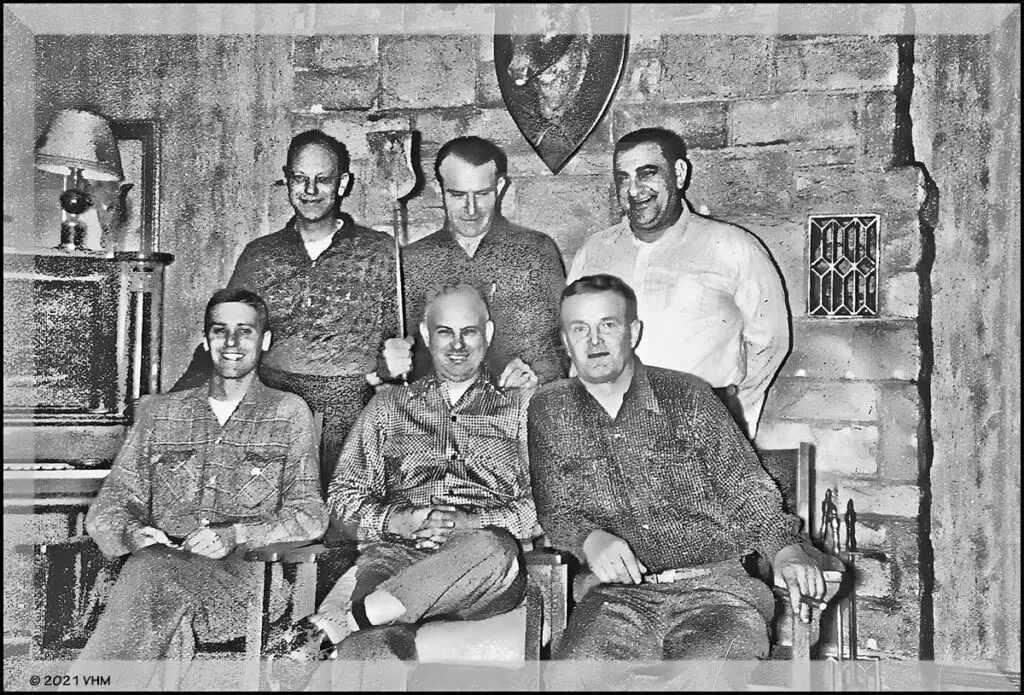
I like to kid friends and acquaintances by telling them I don’t look one day older than I did when I graduated from VHS in 1963. But I must confess that as the years have passed, I have become intimately acquainted with a thing called Macular Degeneration. Ergo, my eyesight is failing some. Perhaps that’s not a bad thing. (Out of sight out of mind.) However, while my eyesight is, indeed, beginning to fade my memories of the people, places and times in good ol’ Vermilion Ohio have not.
Last week I received an envelope in the mail containing the accompanying photograph along with a brief note. It was sent to me by a Vermilion expatriate named Donald L. Poyer who now makes his home in Tallmadge Ohio. Though I’ve never really met Don (that I know of) I am, and always have been, familiar with him. The Poyer family has deep roots in the history of our town. Dons note said that this photograph was taken about 1953 when the guys went on a hunting trip into the wilds of Pennsylvania.
The men standing at the back L-R are Dr. “Doc” White, Bill Litman and Frank Todi. Seated L-R are Don Poyer, Harold Neiding and Elmer Brushaber. All were well-known and well-liked Vermilion businessmen.
Don and his father L.D. Poyer owned and operated a trucking firm called the Vermilion Transportation Company during the 1940s and ‘50s. It was located on the west side of Douglas Street just a few doors south of the railroad tracks. He was an active member of the Vermilion Boat Club, the local Lions Club as well as the Fish & Game Association. His activities in these clubs may explain (at least in part) the reason he is pictured with this particular group of Vermilion men.
Dr. V.B. (Verdes Bryce) White (b.1903 – d.1984) was a popular Vermilion Osteopath and sportsman (not necessarily in that order). He and his wife Elizabeth (Osberg) lived in the tidy Montgomery-Ward (Wardway) red brick home on the northwest corner of Main and Ferry streets – across from the Vermilion water-treatment plant – kitty-corner to the French Restaurant.
Maurice “Bill” Litman (b.1911 – d.1983) who appears in this photo as about to strike Harold Neiding over the head with a fireplace shovel was co-owner of the local newsstand (where the Olive Scene is currently located) with his wife Dorothy. Dorothy was so prominently known in local politics that she often over-shadowed her husband. However, were it not for Bill’s support it is unlikely she would’ve have become so successful. He was smart, a hard worker and a great guy.
Frank Todi (VPJ 11/29/2015) was, very briefly, the Chief Law Enforcement Officer in the Village of Vermilion. When this photo was taken, he had recently left his job as Brownhelm Township Constable to become a Patrolmen here. He was appointed to the Chief position in 1957 replacing Joseph T. Ryan Sr. who had died unexpectedly in February of that same year. Unfortunately, he followed suit literally dying in the VPD office in early April of 1958. He was rather young when he passed, having been born in New York State in 1907.
Harold Neiding (b.1911 – d.1981) was a first-rate Vermilion entrepreneur, widely known and respected by young and old persons alike. For many years he fished; had his own fishery – where the Vermilion Boat Club is today – and was also a topnotch cook and restauranteur. Persons familiar with the old TV show “Happy Days” will recall that the characters often met at a Drive-In restaurant called “Arnold’s”. That program could very well have been filmed at Harold Neiding’s place next to the bowling alley, that was known as the “Lake Erie Drive-In”. But it was not just a hangout for high school kids. The food attracted “kids of all ages”. (Where else on earth could one get a Shrimp Sandwich?) And more than that, Harold could always be seen at all school and public functions. And always with a smile on his face.
Elmer Albert Brushaber (b.1904 – d.1982). was from Sandusky. He was a plumber by trade and owned and operated his own business. When he retired in 1966, he sold his company to another Vermilion fella named Bill Delematre. Mr. Delamatre continued in the business until he retired. Both Elmer and Bill were good men who knew their trade.
Well, it may very well be true that my eyesight has begun to fade some as time passes and, in truth, I don’t really resemble the high school kid I was way back when. But again, my memories of yesteryear in our pretty city have hardly dimmed – not at all.
Vermilion resident Rich Tarrant is Curator of the Vermilion History Museum and a son and a grandson of the late proprietors of The Vermilion News (1897-1964). Readers may email him at: rnt@twc.com
RNT
Sunday, May 9, 2021
THE HARDY INN AND STAYING TEACHABLE
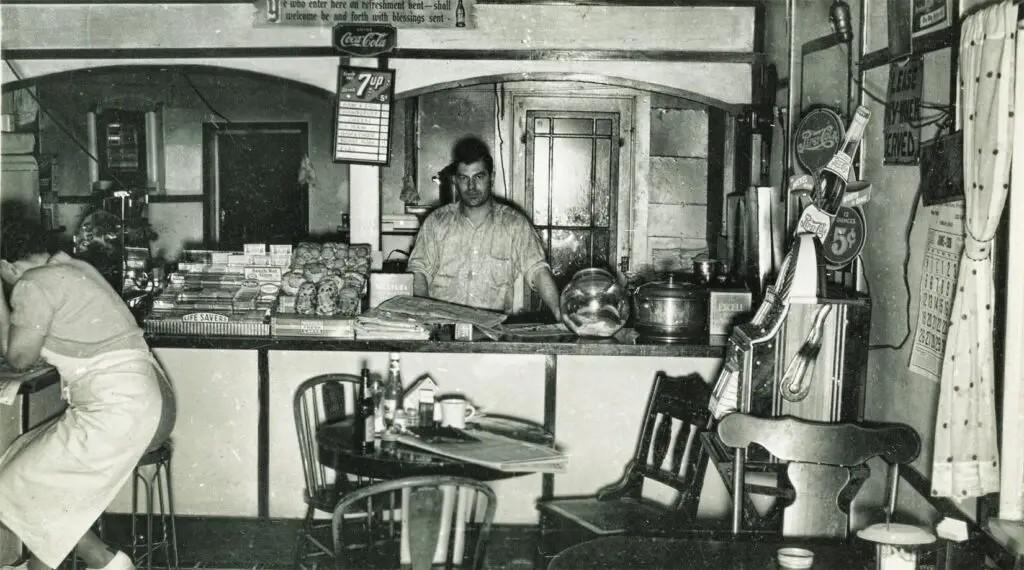
There’s a curious thing about the ageing experience. When I was young I knew “everything about everything”. But as I get older I find that I’ve somehow forgotten a great deal of it. I guess that’s what one calls a conundrum. Anyway – that’s my story and I’m sticking to it. Because prior to an e-mail I received from the Vermilion Chamber of Commerce several months ago (1/08/10) I’d never heard of the Hardy Inn.
Granted – the inn wasn’t a part of the landscape of Vermilion, O. for a long period of time – from about 1932 to perhaps 1940. And, granted, it preceded my existence on earth. But it was there. And thanks to a lady named Judy Price I now have the pictures to prove it.
The Hardy Inn was located on the south side of Liberty Avenue on the site currently occupied by the Weld-Master (window) Manufacturing company. Later the place would be sold and renamed the Riverside Inn (PJ 11/20/08). But before that it was owned and operated by a Cleveland couple; Archie and Ethel Hardy. And whilst I am guessing – I believe that Eddie Perrault, then manager of the inn, is the fellow in the accompanying photograph.
Though Judy sent me seven photos of the restaurant I opted to use the concomitant snapshot because it is – at least it is what “I “consider to be – a swell sampling of the interior of a small town diner during the era of the “Great Depression” (1929-1941). The detail in what is actually just an impromptu snap is particularly good. And if the calendar on the wall to the right is accurate it was taken in June of 1938.
The Coca-Cola sign above the counter reads, “Ye who enter here on refreshment bent – shall welcome be and forth with blessings sent.” The depression era menu prices below the sign are quite amusing. Hamburgers and a plain cheese sandwich could be had for a dime. Or, if you had a bit more money you could opt for a plain ham, roast pork, or a fish sandwich for fifteen cents. But if you were living high on the hog (no pun intended) you could get a ham and egg or a ham and cheese sandwich for twenty cents. To wash it down you could have a 12 ounce bottle of coke, 7up, or a Pepsi Cola (“Nickel drink Worth a Dime”). Or, prohibition having been over for a few years, beer was also available.
For dessert there was a selection of Ward’s Fresh Cakes on the counter. Or if you wanted something a little less filling there was also a nice selection of LIfe Savers candy available. To sweeten the breath there were several types of Beech-Nut Gum – Clove being most prominent. And then for folks willing to take a chance there was the “one-armed bandit” sitting near the front of the counter. [Note: At the time it was not unusual for businesses of this type, in Vermilion and elsewhere, to have at least one slot machine available for their customers.]
After an illness of several months Archie died. It was July 10, 1936. Their son, Herb, died two years later. Then, for a time, Mrs. Hardy had a fellow named Eddie Perrault (pictured) manage the restaurant. But by 1939 she had hired a Vermilion gal named Betty Harris to help her. And in early January of 1940 after Betty married a fellow named Worthy Kemmerer, Betty her husband took over the operation. Not long after the Hardy Inn became the Riverside Inn that I remember.
As stated at the beginning of this essay – once upon a time “I knew everything about everything”. In truth that knowledge was just sheer arrogance “sur l’afficage“. Today – while I don’t know much – I remain teachable. This rummaging through yesteryear does not, of course, prohibit ageing. But it keeps me on my toes.
Ref: Sandusky Star Journal, 7/14/38,1-06-40,; The Register, Sandusky, 8/08/38; The Chronicle 7/14/36; Special Thanks to Judy Price and the Vermilion Chamber of Commerce; Published in the Vermilion Photojournal 9/30/10; Written 9/26/12 @ 3:41 PM.
An Old Fogey's Scrapbook
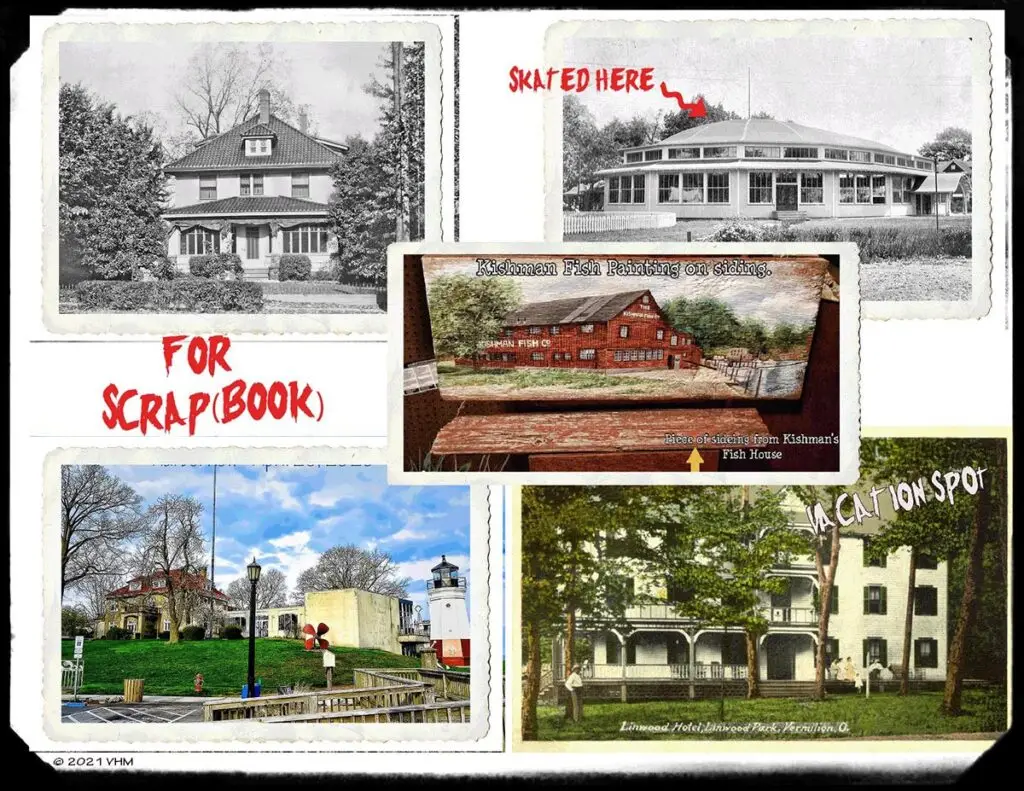
Well, I guess it’s now official: I am now a bonified “Old Fogey”. The old F.W. Wakefield home has, as some are inclined to say, “Bitten-the-Dust” and the Vermilion I once knew and loved is just about gone. All that’s left are two empty spaces by the lake, one by the river, one occupied by a condominium complex and another occupied by a non-descript bank building. But it really doesn’t matter. I have my scrapbook photographs of those places as well as a piece of siding from the old Kishman Fishery and a bushel and a peck of wonderful memories of all these places to keep me for the remainder of my days.
I suppose it would not surprise many persons to know that even up to the Covid pandemic I would frequently receive both telephone and in person inquiries about the Wakefield (GLHS) Museum at the Vermilion History Museum. And I have no doubt that that will continue for some time to come. It was a great museum and, contrary to what some might have thought, a beautiful home. It was a “bonified” (there’s that word again) Vermilion home from the ground up. Like the George Fischer home that once overlooked the swamp that became the Vermilion Lagoons subdivision, the Wakefield Harborview home will soon be forgotten.
George Fischer, for the benefit of those who’ve never heard of him, was a successful Vermilion attorney and lumber dealer. In 1903 he purchased the Lake House Hotel that once graced the southeast corner of Liberty and Division/ Main streets; moved it down the hill to the southwest corner of Liberty and Exchange streets; and built a large business brick building (i.e., the Fischer Building) on the site where the hotel once sat. But while all that was going on he built this great home along the river.
This house was, in my experience, one of the most pleasant sights in town. Because of this house I became forever partial to red-tile-roofed homes. When I was a guest near Saigon, Vietnam (back in the mid 1960’s) one of the things that always reminded me of Vermilion were the homes along the street between Ton Son Nhut Airport and beautiful downtown Saigon. Here the great villas with their sprawling yards with red tile topped roofs sat quietly (for a war) in the shade.
When I returned from my vacation in the orient the home was still there. But it was now what folks once called a “rest home”. The photo (upper left) of if does not really reflect the actual size of the place. It was huge. Moreover, it had a beautiful lawn and garden behind it with a wonderful walk leading to a tidy concrete dock on the river with steps that would allow one to get on and off a boat with ease. It was a wonderful place.
However, one place that I immediately noticed missing from the landscape upon returning home from the war back then was Crystal Gardens; the dance hall that once welcomed visitors to Vermilion’s own amusement park Crystal Beach. I found the idea of anyone having ripped the place down to be absolutely and unconditionally absurd – and still do. This was not just a matter of its historical significance nationally; or because of the thousands of persons who had danced, skated, and attended political rallies there that made its razing ridiculous. It was because of its potential as a positive resource for the community. Its demolition was a tragic but, apparently, a very profitable, mistake.
I later learned that Hotel Linwood had been taken down the same year as the dancehall. Due to the fact, that it was not readily visible to many persons outside the (Linwood) Park it was easier not to miss it. But the hotel, like the park itself, embodied a great deal of history for Vermilion and elsewhere. And the huge shadow it once cast over the great beach below it, I am sure, is still missed – as is the beach itself.
Would anyone believe that more than a few visitors to the Vermilion History Museum know nothing of Vermilion’s history as a fishing village not to mention Kishman Fish? There is a tongue-in-cheek story about one prominent Vermilionite who objected so much to razing those bucolic fish houses in a yesteryear that he suggested that it would be nice if someone shot a cannonball from one of the cannons in the park through the structures that replaced them. While that’s a bit “over-the-top” methinks there was a good deal of collective “head-nodding” among the citizenry when the statement was made.
Some years ago, a VHS exchange student chuckled at the idea that so many folks seem impressed by the fact that Vermilionites were so proud of the fact that there were century homes in our town. “We have”, she said about her town, “houses that are over 300 years old and older.” I could be wrong, but I doubt that they built homes any better in her town than they ever have here. Methinks, my “Old Fogey” brain tells me, that they probably have fewer scrapbooks and, of course, very different values.
Ref: © Rich Tarrant 2021; Readers may email him at: rnt@twc.com
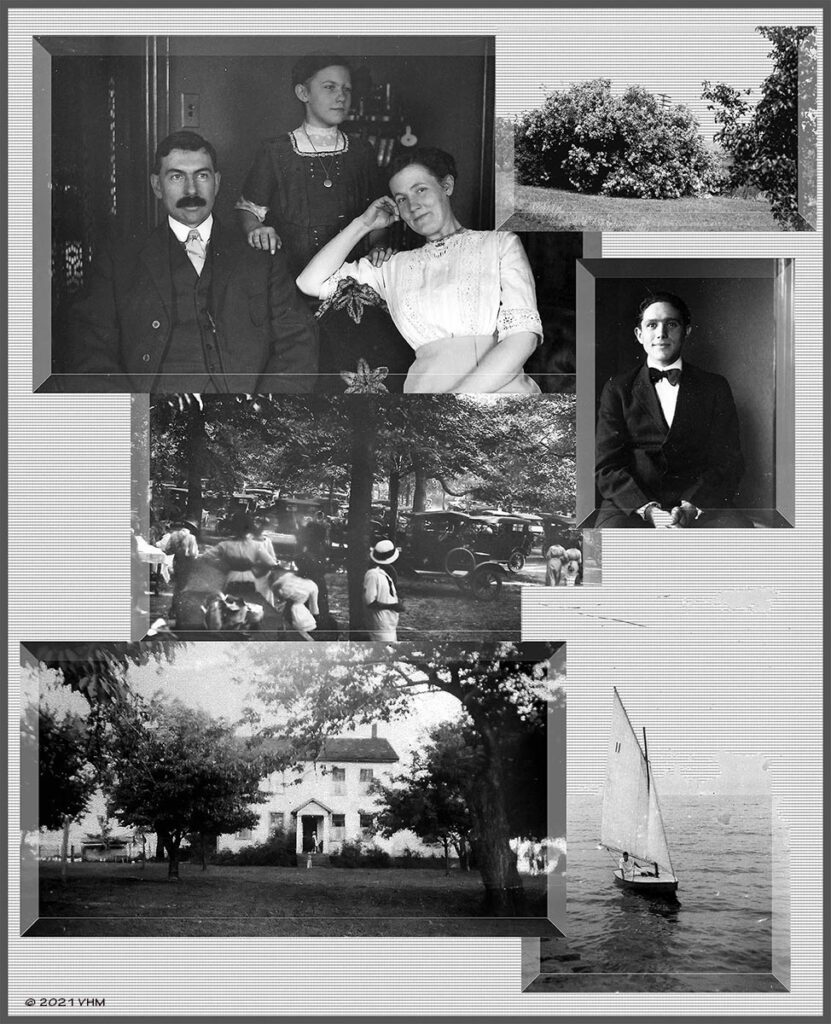
Souvenirs Sur Verre: It’s been some time since I waded into continuing the task of developing some of my grandfather’s glass negatives. I have, thus far, developed around 200 of them and there are many still to be done. Anyway, on Saturday last (04.17.21) I got back to it.
To briefly explain the process: I place a glass plate negative on a small light table and shoot a photograph of it with a camera mounted on a stand above it. I then take the photo of the negative to a software application on the computer, invert the negative, and adjust it for digital or print exhibition or publication. This digital procedure is not nearly as complex as the one that proceeded it that required the use of chemicals.
But no matter how you look at it that’s the easy part. The hard part is identifying the subject(s) of the prints. In this instance many of the photographs are over a hundred years old. And as far as I can tell they aren’t in any particular order. In addition to this, they’re stacked inside small (6”x8”x1.5”) cardboard boxes. The boxes are the original East-Kodak boxes (13 plates in each box) they came in when first purchased. It’s not the correct way to store and preserve them. Over time the negatives can become stuck to one another causing the image to peel and become brittle.
On Saturday I shot around 50 of the negatives, but fully developed only about half. Those accompanying this essay were a few I found somewhat interesting. I do happen to know the identities of the three persons in the portrait (upper left). The gent with the nice moustache is my great-uncle W.B. Houseman, great-aunt Ella Bottomley-Houseman and their daughter Clara. Houseman’s first name was Worlie (I used to refer to him as Uncle Whirley). At one time he was in charge of the grain mill in Birmingham and later Vermilion. In 1951 Ella was hit and killed by a truck in Cleveland. Some persons about town may still remember their daughter Clara. She was a nice little lady who lived quietly in her tidy home in Nokomis Park until her death in 1976.
Directly below the Houseman photo is one I like, but one I can’t identify with any factual detail. But it’s really an interesting photo. It shows what appears to be a rather large gathering of people and automobiles in the shade of a summer afternoon. By the looks of the cars and the clothes people are wearing I’d “guesstimate” that those shadows were captured sometime around 1919 at what appears to be a picnic outing. It’s an action photograph and it may have been taken at Linwood or Crystal Beach Park here in Vermilion. It makes one wish there was a way to enter the scene and walk around. Of the other photographs I can say little.
Below the picnic picture it is what I consider to be a terrible, but rather intriguing photograph of a house that is very similar to the Tom Beach home ( i.e., the birthplace of Vermilion inventor Lester Pelton) west of town. But whether it’s the same house is a matter of conjecture on my part. And just to the right of this portrait is just a nice sailboat photo. My grandfather took numerous photos of the sailboats and races on the lake. Few are as detailed or interesting as this.
The fellow above the boat is another unknown (to me) portrait. It’s rather a good photo of a young man – of studio quality. But in my experience with all of grandfather’s photo works he was not in the business of photo portraiture. But there it is, and unlike the photo just above it, it surprises me. Above the young man is, very simply stated, the photo of a big bush by the railroad tracks.
I would wager that the bush in question is actually a ginormous deciduous shrub we know as lilac. This, in my experience with my grandfather’s photographs, was something he could not and would not pass up documenting. The shame of it was for him (and us as well) is that at the time the photo was taken color film had yet to be invented. And although he did not succeed in preserving the entire beauty of the shrub for us to enjoy, he did succeed in providing us with numerous other memories of yesteryear on glass – Souvenirs Sur Verre.
REF: © Rich Tarrant – 04/18
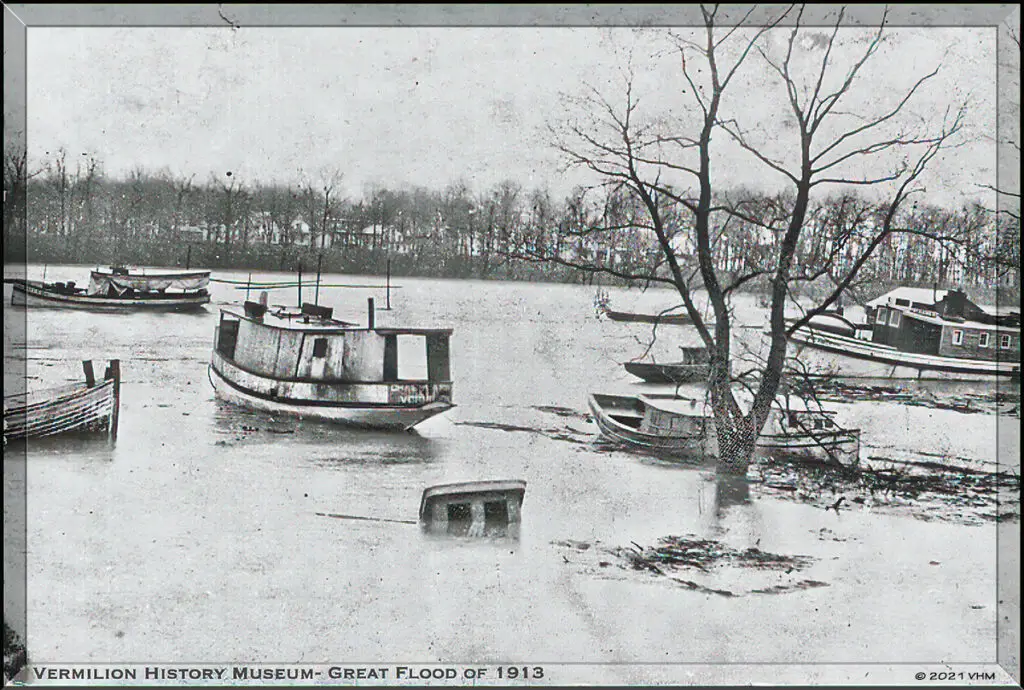
THE GREAT FLOOD OF 1913
04/03/21
It’s been mostly forgotten now. But it is understandable. After all, more than a century has passed since it happened. In the years that ensued there was the Great War (1914-1918), a Spanish Flu Pandemic (1918-1920), Prohibition (1920-1933), World War 2 (1939-1945), Korea (1950-1953), Vietnam (1955-1975), President Kennedy was assassinated (11/23/63) and the list goes on (and on). So, it’s really no big surprise that not many persons alive today know about the Great Flood of 1913. (Pictured here with Linwood Park on the high ground in the background)
It occurred between March 23 and March 26 in 1913, after major rivers in the central and eastern U.S. flooded following several days of heavy rains resulting in numerous deaths and catastrophic damages. More than a quarter million Americans were left homeless. In all, the casualties and property losses caused by the flood placed it second only to the Johnstown Pennsylvania Flood in 1889 as one of the deadliest floods in the history of the United States. In brief, The Great Flood of 1913, was perhaps Ohio’s greatest weather disaster. While there were no human casualties in what was then the Village of Vermilion other communities in Ohio, such as Dayton, were not so fortunate. And when all was said and done the lives of some 650 persons had been lost and $300,000,000 in property damages had taken place. (That would be around 7 billion dollars today.)
In Vermilion it began on Friday, March 22nd with, as The Vermilion News reported, “one of the most severe wind storms every experienced here… blowing out the front window of C.F. Decker’s office… several chimneys and outbuildings were blown over in A. H. Leimbach’s net factory and a small block building near the schoolhouse was partially demolished. Trees in town and country were also damaged.” The report continued, “Sunday, it rained, Monday it poured, Tuesday more rain. Then came the flood. The river commenced to raise. Higher and higher it came until Tuesday it reached a stage never before reached within the memory of the oldest residents.”
To some current Vermilionites some of this may sound eerily familiar. During the 4th of July Flood of 1969 in Ohio, it is estimated that ten to fourteen inches of rain fell in a matter of 18 hours. Although the 1913 storm dropped less moisture – nine to eleven inches of rain – it significantly added to the run-off from the thawing winter soils 90 percent of it running-off into already bursting rivers and streams. The result was, in a word, catastrophic.
Local fishermen attempted to secure their boats, nets and other property, but despite all their efforts, boat after boat broke loose and was carried into the lake. The stream fish tugs, however, were securely fastened preventing their been carried away. Nearly everything along the river which could be moved by the water was and had been swept out into the lake. The Sennhenn and Black fish houses on the east side of the river were torn from their foundations and partially demolished. The large gas tug “Mary A.” was swept into the marsh (now the Vermilion Lagoons) and started for the lake. But several men succeeded in getting on board and throwing the line ashore just as the boat was moving from the river and its progress stopped. Several smaller gas boats were sunk, and others carried out into the lake. During the height of the flood water broke through into the lake at the foot of the West pier and swept all before it. All the fish houses were flooded as were all the boat houses at the bridge. The George Fisher Lumber Company (in the area now occupied by the Vermilion Boat Club) was inundated and the garage and basement of his residence flooded.
Besides the damage along the river there were other problems. Several storm sewers proved inadequate, and streets filled with water. Water poured in streams over sidewalks. The waterworks pumping station was flooded for some time that Tuesday afternoon forcing the engineer to work in 6 to 8 inches of water. And that same night, the Leidheiser Bros. Fish Co’s. Icehouse collapsed.
The flooding was not only confined to the river flood plain, but low areas in the countryside filled with water resulting in considerable damage. It was reported that local dairyman George Maurer had come to town to get a boat to rescue some of his cows he found in water up to their bodies. The bodies of cattle and sheep had been seen floating in the river.
The Lake Shore (L.S.& M.S.) and Nickel Plate railroads were the only roads maintaining a regular schedule with Pennsylvania trains being run over the same rails, as well as the regular trains. The Lake Shore Electric interurban was nearly put out of commission. A serious washout between Vermillion and Lorain occurred at Kishman’s Crossing (near the Baumhart Road area) necessitating transferring passengers from the interurban to a steam passenger train.
Although the storm caused considerable damage throughout the state Vermillion escaped with less loss of property and, most importantly, no loss of life. Some other towns in the state, such a Dayton, were not as fortunate. As a result, this flood and later flooding along the Mississippi River eventually helped change the nation’s management of its waterways and increased federal support for comprehensive flood prevention and funding for flood control projects. In Ohio, the Ohio Conservancy Act, which was signed by the Ohio governor (the Hon. James M. Cox) in 1914, became a model for other states to follow. The act allowed for the establishment of conservancy districts with the authority to implement flood control projects. Now, if we could only legislate the weather things would be good. (Maybe.)
Ref: The Vermilion News 03/27/1913; Sandusky Register 03/28/1913; © RNT 03/28/2021
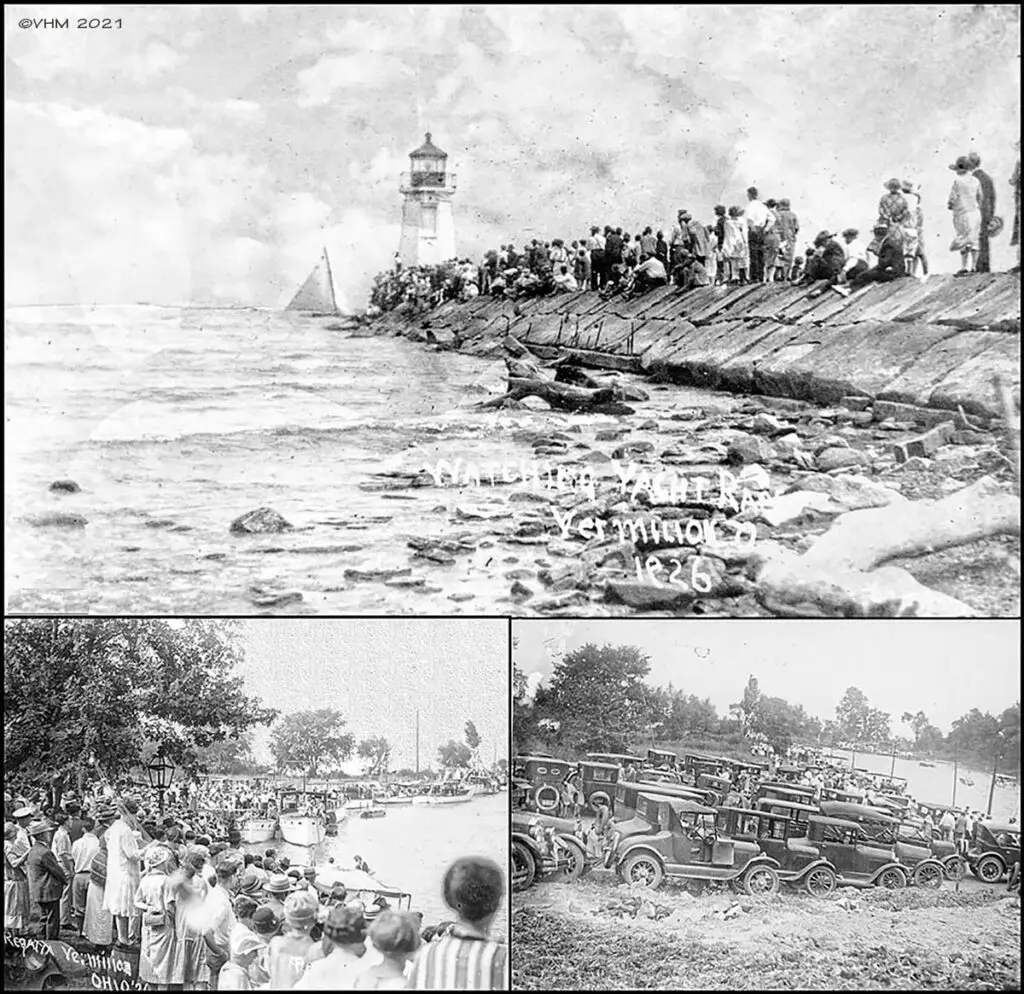
This Week's Story - Fleeting & Precious Days
Technically, every photograph is a “one shot thing”. But in this instance the photos that accompany this essay certainly are. It is highly doubtful that there will ever come a day when any crowd the size of that on the west breakwall or along the river will ever again gather there to watch a regatta celebration. And, obviously, the lighthouse at the end of the breakwall will never again watch over the harbor in that place either. These are impressive portraits of a Vermilion w.b.c. (well before covid).
Newspaper editor Roscoe captured these scenes and the others on glass during a Regatta in 1926. It’s a bit hard to see in the breakwall reproduction, but he etched that information on the glass photo plate. [Note: the 9 in the year 1926 is not backwards because he was dyslexic, but because he was writing backwards on the plate. It was a bit tricky.]
In the yesteryear, as is obvious by this photo; Regatta days in Vermilion were a big deal. Families came from ”far and wee” to participate in, and watch, the races on the lake – as well as numerous activities along the river in front of the waterworks. But it was not always so. In October of 1908 the following report appeared in The Vermilion News:
“At the last meeting of the Lakewood Yacht Club, expressions of pleasure and satisfaction were unanimous in regard to the club Regatta at Vermilion. The club has decided to make this visit an annual event with the cooperation and consent of [the] Vermilion committee.
The change in the time of the regatta has been suggested, also that they should have a squadron sail. This would be very desirable, as all the boats, both power and sail would take part in it, and would give the yachtsmen a chance to entertain their Vermilion friends. There would be 50 or more boats under power or sail at the same time, and would make a grand site off our port.
There is some talk of holding the Lakewood open regatta off our port. There would be four days of racing, both power and sailboats. This event takes place the latter part of July and, would be a fine drawing card for Vermilion.” They did – and it was.
Readers will herein note that initially it was known as the “Lakewood Open Regatta”. No small part of the reason the Lakewood club had opted to use Vermilion as their race site was because one of their members was a man named F.W. Wakefield. In 1905 he owned a successful lighting business then located at the “Old Arcade” in Cleveland. He was also an avid yachtsman. One day, as he sailed his Yacht “Unique” into Vermilion Harbor, it is said that he turned to his companions and remarked that “this place looked good [to him] for a factory.” By 1906 a local contractor was busy building his factory. By 1912 he was elected Mayor and soon thereafter the Lakewood Regatta had become the Vermilion Regatta.
By 1926 the Vermilion Regatta had become quite famous. They really did provide numerous families from miles around with several days of live entertainment in the sunshine by the water. By ’26 more and more people owned an automobile and were able to travel some distance to participate. After the lake races there were diving and swimming competitions on the riverfront along with canoe water fights. It was great fun for persons of all ages. And it was free.
On Saturday (sometimes Friday) evenings Division / Main street between Liberty and the railroad tracks was closed and local charities set-up games of chance. For the young children there was a “penny-pitch” game. For the adults there were games like roulette, etc. At the north end of the street ladies from some charitable organization sold sandwiches and soft drinks. And at the other end a band would take their place on a stage; corn meal would be spread out on the street and folks would dance into the night. All the businesses along the street were closed with the exception of (what else?) the beer joints. One of the songs that used to be played at those dances with some regularity was “There’ll Be A Hot Time In The Old Town Tonight”. And there certainly was.
Then, somewhere in time all those days faded away and have disappeared, replaced now by the Festival of the Fish and the Third Thursday activities. No crowds gather on the west breakwall to watch yacht races. Nor do crowds gather by the river to enjoy competitions and exhibitions upon the waters. Those days, some might say, are waters that have long ago passed under the proverbial bridge. Nonetheless, we have these photographs to remind us of just how fleeting and precious all our days are – in the yesteryear – and today.
Ref: Vermilion History Museum Photo Archive; Published in the Vermilion Photojournal 06/01/2017; Rev. 04/04/21 ©Rich Tarrant.
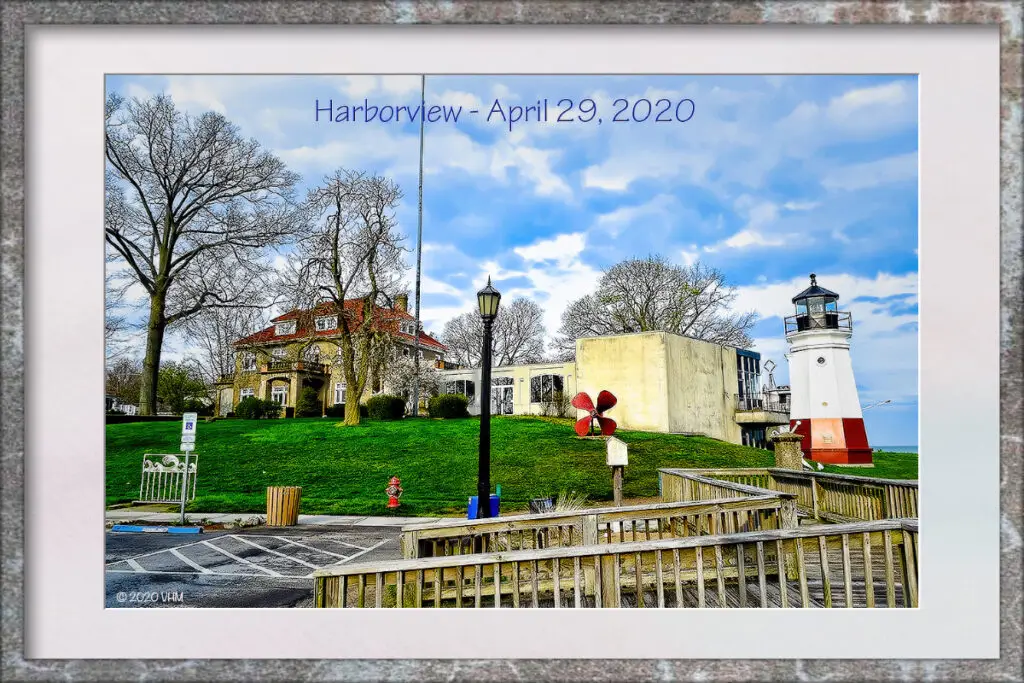
Memories of F.W Wakefield and “Harbor House”
by Mary Wakefield Buxton
Note: This account of my memories of F.W. Wakefield and life at his home in Vermilion, Ohio, a home that was built in the early part of the 20th century known as “Harbor House,” is in response to a request from Marilou Suszko, executive director of the Main Street Vermilion, Inc. in Vermilion, Ohio, in the hopes of preserving just a small history of the family and the house. I am penning these memories just as I am turning 80 years old this September. My apologies to members of my family should there be any dire (or even trivial errors) in my account. I have simply done the best I can do according to my own knowledge of the family and my memory. Also, in memory of F.W. Wakefield and his legacy to the town of Vermilion, Ohio, time was of the essence as I felt this account should be written as the historical home that was built over a century ago that we all loved so much and have so many memories of was being taken down by the town.
I never knew my grandfather F. W. (Frederick William) Wakefield as he died of cancer in 1933 at age 63 and I was not born until 1941. But I heard much about him as he was a family icon having arrived in America in 1872 on the “China” with his parents, William and Sarah Wright Wakefield. They settled in Cleveland, Ohio where Grandfather eventually built a business as a pioneer electrician (he wired John D.
Rockefeller’s mansion to which he was given a pair of lion’s rampant hand irons in appreciation for his big fireplace in the living room which eventually came to adorn my father’ fireplace in our home on West Lake Road and now reside at my sister Georgia’s home in Crozet, Virginia. They are a treasured keepsake.
F.W. later moved to Vermilion, Ohio, to buy land off West River Road and build a factory in order to manufacture brass products and electric lighting fixtures.
The family, at least in me and my parents’ generation, revered him as through his ingenious ideas (he had many electrical lighting inventions on which he received patents) and hard work, he not only raised his immediate family out of the poverty it had once known in England, but he also brought a number of his own siblings and cousins to this country like the Copelands, Pattersons and Poleys and ushered in a new life in America for them too.
Grandfather was the epitome of the American dream that all early colonists, settlers and later immigrants who left the old country and braved the perils of the new world had in hopes of more individual freedom, success, prosperity and escape from rigid class systems that had held them back in the old world. They believed, and rightly so, that in the new world, America, anything was possible.
F.W. was my personal symbol of Horatio Alger, the boy who rose from rags to riches through hard work and dedication to detail. He was everything to his devoted family that so depended on him while he was alive and even several generations after his death. More than anything he set the standards for the family; his belief in truth and honor as fundamental foundations for life and his direct connection to poverty in England leant him a great love for this country and the opportunities it gave his family and this sentiment passed down to his children, grandchildren and great grandchildren today. We were taught at a young age never to forget our modest roots and to always remember it was America’s free enterprise system which gave him and so many other immigrants great opportunities.
For me, his legacy also passed on a love for my hometown that has never faded and no matter where many of my cousins, sisters and I have ended living up today, I believe we all kept in our hearts the memory of Vermilion, Ohio. On a personal note, as a writer, I have written many stories about my hometown and my childhood growing up in Vermilion, some that have appeared in the books I have written, and the inspiration to write such memories never seems to wane.
The company known as F. W. Wakefield Brass Co. was formed by F.W. but without the dedication and hard work of many members of loyal Vermilion families, the company could never have succeeded. I have heard that Grandfather put in place a primitive profit-sharing system of some sort that provided reward to all his employees whenever the company had a profitable year. I’m not sure if this is myth or memory, but if this is the case, he was one of the first industrialists in the nation that included his team in a profit-sharing system.
Vermilion families that had helped him manufacture his first brass electrical lighting fixtures and early brass chandeliers installed the products in their own homes and they can still be seen hanging in hallways and dining rooms of area homes. I am always thrilled to see the early models and I have been told one can still buy an early Wakefield fixture on eBay even today.
Father told me the real source of Grandfather’s tremendous success in early electrical lighting fixtures that later evolved into a company that produced industrial ceiling lighting that competed with giant firms like GE, Sylvania and Westinghouse was a simple invention. When Thomas Edison, who was working in nearby Milan, developed his thrilling new lightbulb that changed the world almost overnight from gas lighting to electricity in the same way Bill Gates and others later revolutionized the world with computers, F.W. got a patent on a brass fixture that converted a gas lamp to accept the light bulb. It was this patent that Father said built the big house on the hill overlooking Lake Erie in the center of town that housed his family, sent the boys to college and later became the Great Lakes Museum. It was this initial patent that allowed Grandfather to expand his factory to offer employment for many years to Vermilion families. And even though F.W. had the ideas to become a national leader in electrical illuminating engineering, he never lost sense of the fact that it was his loyal and hardworking employees that in the end brought him success.
Nor did he ever lose connection to the man on his assembly line. A family portrait of him that I now have on a shelf in my living room bookcase shows him dressed in suit and tie but on his feet, he has on a simple pair of leather boots. That was so he could walk the plant each day, talk the men on the line, find out how they were doing and make sure that the quality of Wakefield products was always the best.
As they call such management style today, “managing by roaming around,” he always stayed near his production team rather than sitting in some fancy office far away from the action.
Father told me the family withstood some really bad fortune when the factory burned to the ground in 1925. The news came to F.W. by telegram as he and his two sons, Fred and my father, George, were in Florida on the family yacht “Tobermory.” Father said F.W. immediately left via train for Ohio where he surveyed the damage to his company before heading to the bank to secure loan to rebuild the plant. In those days there was no such thing as fire insurance so F.W. took the financial hit personally over the utter destruction of the factory. Father and Fred, just teenagers, brought the “Tobermory” back to Vermilion by themselves, as Father remembered an exciting trip chugging up through the Intercoastal and through the canals and lakes back to the port of Vermilion.
I loved hearing the stories about Grandfather over the years. Father told me he was bright, inquisitive and creative and he had many early patents on new inventions in the electrical lighting field, as Father did when he eventually took over the engineering department in the company. He, Harvey Vick, Lloyd Owens and Dick Gerber, all Vermilion people, came up with the ideas for most of the new products after Grandfather passed away and their products were so well made that the company “beat out the big boys” (as father called them) time and time again.
Each fixture had a red dot at the end of the ceiling lamp, and I remember looking up at the ceiling of Patrick Henry Airport in 1963 after landing in Newport News, Virginia to attend engagement party with my future husband, Chip Buxton of Newport News, and seeing that red dot. I was so proud, not only of my father and his team that had designed that fixture but all of Vermilion, Ohio and all the many employees responsible for creating those beautiful ceiling fixtures that were sold across the nation and eventually Canada and Europe.
F.W. was a handsome man with well chiseled features, very English looking, and his sons all had a bit of the same look although I thought of the 6 boys Fred Wakefield probably looked most like his father. He was a gentleman in every respect and kind to employee, friend and neighbor but he also could be a stern disciplinarian when necessary.
Father once told me when we were walking through the gigantic basement of the big house where F.W. had once had his tool workshop that one of the older boys had been given a BB gun for Christmas and had accidently shot Father in the forehead. When F.W. came home from the factory and heard about it, he said not a word, but picked up the gun and walked down the flight of stairs off the kitchen with all the boys in tow, put the gun in his vise in his workroom, and clamped the barrel shut.
As a child I looked at this same vise that was still there in 1950 and I could picture Grandfather standing there exactly where my father was standing in the dim basement light and turning the clamp to shut the barrel of the gun. I remembered the story and that Christmas when my sister Alice and I received our first BB gun, I was careful never to aim it at anyone.
F.W. was a hunter and all the boys, Albert, William, Fred, George, Theodore and Ernest, some of their wives and even my sister, Alice, followed in his path and loved to hunt. Father was creative just like his father, with the same inventive mind and had 29 patents for the firm in his own lifetime.
My father told me F.W. was extremely bright. He had gone to work at age 9 in a brass making company in Birmingham, England to help support his family long before there were any child labor laws that prevented children from working long hours each day. Father told me his father had been hand- picked by the owner of the business to make a morning walk throughout the brass factory to look for any imperfections he could find and point them out to the owner. Father mentioned that he had once spotted a crack in a pane of glass and pointed it out to the owner who had not noticed it. “You are my eyes,” the owner said to him and as a young lad F.W. became the owner’s special assistant and learned first- hand not only how to run a business but also the secret of making brass fixtures which he later took to America.
I spent much time at the big house. I have an early memory of being dropped off as a toddler at the back door and Mother, thinking Grandmother was there to take me inside, drove off in a rush to get to her engagement. She backed up the old Ford and bumped into me! Mother was hysterical. I was perfectly OK, but I do remember the trauma of the incident.
Grandmother did not approve of the way I was being raised. No one had taught me how to sew buttons on a shirt and she clucked disapproval with every visit. She would take my hand and lead me back to Grandfather’s old study where she kept her sewing materials and a big English plum pudding tin full of buttons. She would get me started by threading a needle and then turn over the task of sewing a button onto a piece of cloth to me. It was terribly difficult for my little girl hands to get the needle into the right holes and not mess up the thread and I was never very good at the task. To this day I don’t sew buttons on shirts, much to my husband’s despair.
When Father and Mother were married, Father built their first home right next to the big house in between it and the garage. (The house was later purchased by Nelson Parsons and moved to his property on West Lake Road but is no longer standing.) Grandmother came over every day and, according to Mother, entered her kitchen and went over to the stove to pick up the tea pot and shake it. It was always empty. Grandmother believed a good wife always kept water in the teapot. Maybe I don’t sew buttons on shirts, but I do keep my teapot filled with water.
Grandfather’s first wife was Carrie Miller and they had one child, a daughter, Clara. Carrie passed away soon after Clara’s birth, so Grandfather sent money to England to bring a young cousin over to America by the name of Mary Poley to help him care for the baby and keep his house. He soon married Mary and from this marriage came Albert, William, Robert, Ruth, Fred, Alice, George, Ted and Ernest. Robert died as an infant and Alice died at age 18 from too much anesthesia during early tonsil surgery in Cleveland.
Grandmother was quite a character passing on to me many “old wives tales” she must have learned in England in hopes of improving me. Apparently, I scowled a lot when I was growing up (probably related to having to sew a button on a shirt every time I went to the big house) and one day she sat me down to warn me that a scowl could become permanent. “I once knew a little girl who scowled all day long,” she said, “and guess what happened? One day she scowled a bit too many times and the scowl never went away!”
I also had a bad habit when young of picking off soft fuzz from a favorite blanket and holding it my nose to sniff it. Father called this strange behavior “sucking fuddy.” Grandmother was horrified when she heard that Mays was sucking fuddy. She sat me down and explained that she once knew a little girl back in England who sucked fuddy for years and years and one day she got a stomachache and had to go to the hospital to have an operation and when they opened up her stomach, guess what they found? A wad of fluff as big as a grapefruit!”
I loved to go to the big house after school to visit Grandmother. Once, as she aged, she had she had a stern caretaker by the name of Annie Tims, One day I skipped up the steps to her house after school, I must have been a first grader, and knocked at the big front door. Miss Tims answered the door and frowned when she saw me. “I am here to ask Grandmother for some money, please,” I said, noticing Miss Annie’s immediate scowl.
What a spoiled little girl you are!” Miss Tims spat as she began to close the door on me. But suddenly Grandmother appeared and was so happy to see me. “May I please have some money, Grandmother, to buy a Coke at Hart’s Drug Store?” I asked.
“What a spoiled child you are!” Annie Tims repeated quite aghast at my unmitigated and unremorseful nerve. But Grandmother ignored her caretaker and beckoned me into the house, led me to the old sideboard in the dining room and took out a black leather pocketbook to pull out a dime. “There you are, my dear,” she said plunking it into my outstretched hand. Then she gave her caretaker a victorious look, walked me back to the door, gave me one last hug, and bid me farewell.
I well survived my childhood. The Wakefield family loved children and my aunts and uncles adored and doted on we three sisters, Alice, Georgia and me. We were known as “the George’s,” (in contrast to “the Teds’s, the Fred’s” etc. etc.) Whether all this love and attention was good for us or not, as we all grew up thinking how wonderful we were, I am not at all sure because once we left our tender cocoon of Vermilion, we found out quickly that we weren’t so wonderful, loved and adored after all. Still, it was nice while it lasted and this euphoric feeling that I most certainly had as a result of my upbringing certainly helped prepare me for the good and bad times that awaited me in later life.
A story I heard oft repeated by many members of the family over the years is when F.W. was mayor of Vermilion circa 1912 he offered the land he owned along the lakefront and fronting the Vermilion River, a huge parcel that at one time was part of his estate, for $1.00. And, according to the family account, the town refused the deal. This story, although repeated many times to our generation with a great deal of laughter, may have been more of myth than fact. I do not know. But the land that might have gone to the town was eventually divided up amongst all the boys and Ruth, each getting a plot for his or her own home. And I am glad the town did eventually gain control over the land that once had the house of Ted Wakefield and his family on it right at the foot of the lake by the pier. I understand it is now a park area for those using the beach and pier.
One last special memory that came to me from cousin, Nancy Stutz Butler. When she and her sister Marian were just tykes, I had not been born as yet, her mother was Ruth Wakefield Stutz who had married a local attorney and lived nearby, she said they went up to the big house on Christmas morning. The boys were home from college and still in their PJs sitting in rows on the steps in the front hall leading upstairs. They were still sleepy probably having just been dragged out of bed by Grandmother who insisted that they come downstairs to greet their little cousins.
Nancy said she and Marion adored their young, handsome uncles…Al, Bill, Fred, George, Ted and Ernest and they would run from the massive glass and wood framed front door to the staircase hurling themselves into their arms. Not once but again and again, with Grandfather and Grandmother and the boys laughing and happy and enjoying every minute of it.
A writer has great imagination. I can sit here today in my home in Virginia almost 85 years after that Christmas morning at the “Harbor House” overlooking Lake Erie and still hear that laughter, still see F.W., that handsome Englishman turned American and Grandmother, my father and uncles and aunt, and my adorable blonde toddler cousins… and it seems to me that no matter if the big house tearfully comes down this week… the vibrant memories of the past will always abound and the early Wakefield family that I so loved will always be a part of my family and my hometown, Vermilion, Ohio.
Friends in Vermilion c.1959
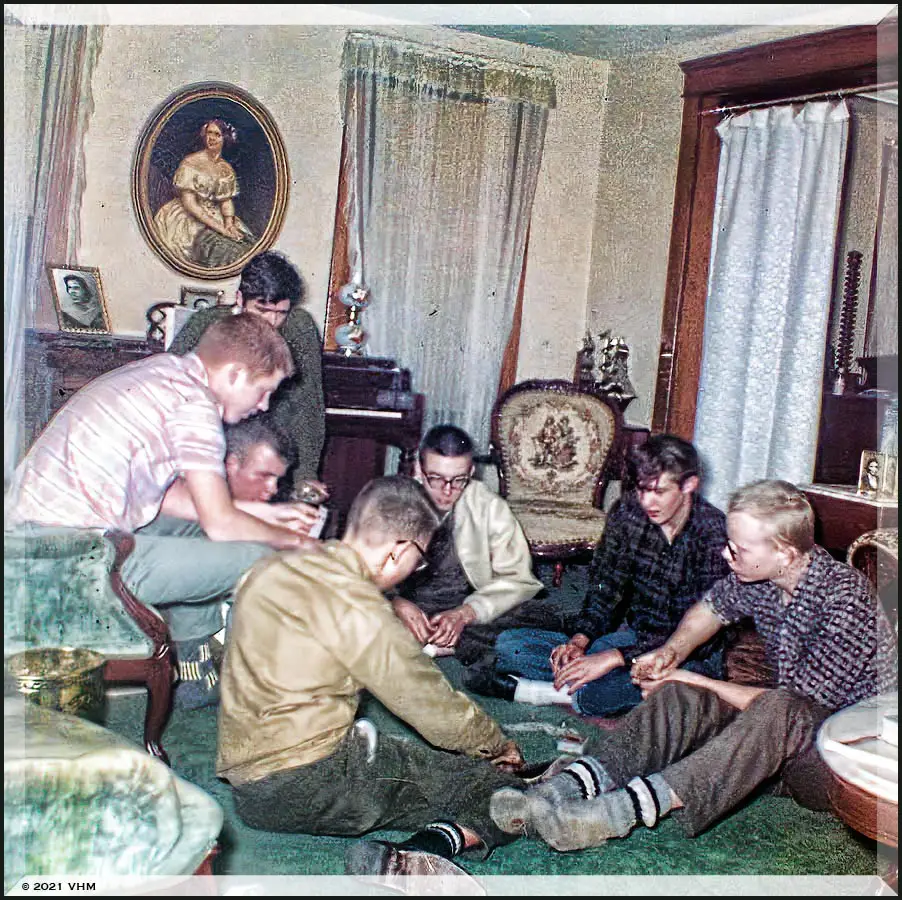
I’d almost forgotten those days. After all it was over a half century ago. But they came rushing back to me a few months ago when I received an envelope (sans a return address) containing the snapshot that accompanies this essay. Violating my personal rule (Rich’s Rule #2 – VPJ 1/20/11) that all photographs should include names of the subjects of, or in, a photo – there were no notations on it or with it. Nor was there any indication of who sent it. However; because of my keen observational skills honed from hours of reading detective / spy novels on our couch I studied the envelope and detected that it had been sent from Memphis, Tenn. Armed with that information and, of course, the snapshot I said, “Aha!” to myself (like a seasoned investigator) and promptly concluded that one of the guys in the picture had sent it to me. His name is Jimmy Coleman.
During the “Great Migration” that took place in the late 1950s that lasted well into the mid 1960s families – notably those from Massachusetts, New York, and Tennessee came to Vermilion, O. to work at the newly built Lorain Ford Assembly plant. Jimmy’s family was among them. His father, Haywood, died shortly after the family set up housekeeping in a home where this picture was taken just north of the Evangelical church on Grand Street. His mother, Martha, who was probably one of the kindest persons I’ve ever known, taught 3rd grade at Vermilion’s Lake Elementary school. Jimmy’s older sister, Maryanne, was the epitome of the term “southern belle”. She was pretty, flirtatious, and a great deal of fun. She had graduated from high school before the family moved north, and at the time she snapped this picture she was engaged to (and eventually married) a young and handsome Ford worker named Bill Lamar.
Though I don’t recall the specific instance of this photo. Jimmy is the (red-haired in the color snap) guy seated in the armchair on the left side of the photo To his right – moving counter clockwise – are John Paul “Stuart” White with his back to the camera; (Me) Rich Tarrant with a hole in his sock, and a stem missing from his glasses; Jacob “Jake” Boone with the Elvis hair-do; Donald “Don” Fischer the only guy in the group who owned a car; Thomas “Tommy” Rodgers who lived just a few doors away on Ohio Street; and Alan, my pal”Al”, Crozier, who is seated on a piano bench overlooking the game. This was our gang c. 1959.
Jimmy was the only southerner in the group. He was easy to like. It was hard not to. All these years later I still recall one of the first questions he asked of us. It was, in a single soft southern drawl, “Howhidahihurdles?” which in north-speak is “How high are the high hurdles?” He always maintained that he wasn’t the one with an accent. It was us – the people who, when asked where we’re from, say “O-hi-ya”.
Jim’s mom passed away unexpectedly in the spring of 1964 and he moved back to his hometown of Huntingdon near Memphis. I’d not seen nor heard from him in all those years until I received this anonymous mailing last December. A few weeks later he called me on my cell, and there was no mistaking who was calling. He asked me about all the guys in the picture, and several who aren’t. We’ve all gone our separate ways, but we all remain steadfast friends even if some of us have not communicated nor been together for half a century.
In an old picture frame at the top of the stairway in our home on Perry Street where I was raised there was a little poem called “A Friend” which read: “A friend is not a fellow / Who is taken in by sham. / A Friend is one who knows your faults / and doesn’t give a damn.” The rime was writ in a yesteryear by a person named Anon. Perhaps it was a person with a soft southern drawl, whose memories of childhood friendships, like Jimmy’s, never wavered.
Ref: Published in the Vermilion Photojournal 2/16/12; Written 2/12/12 @ 12:50 PM